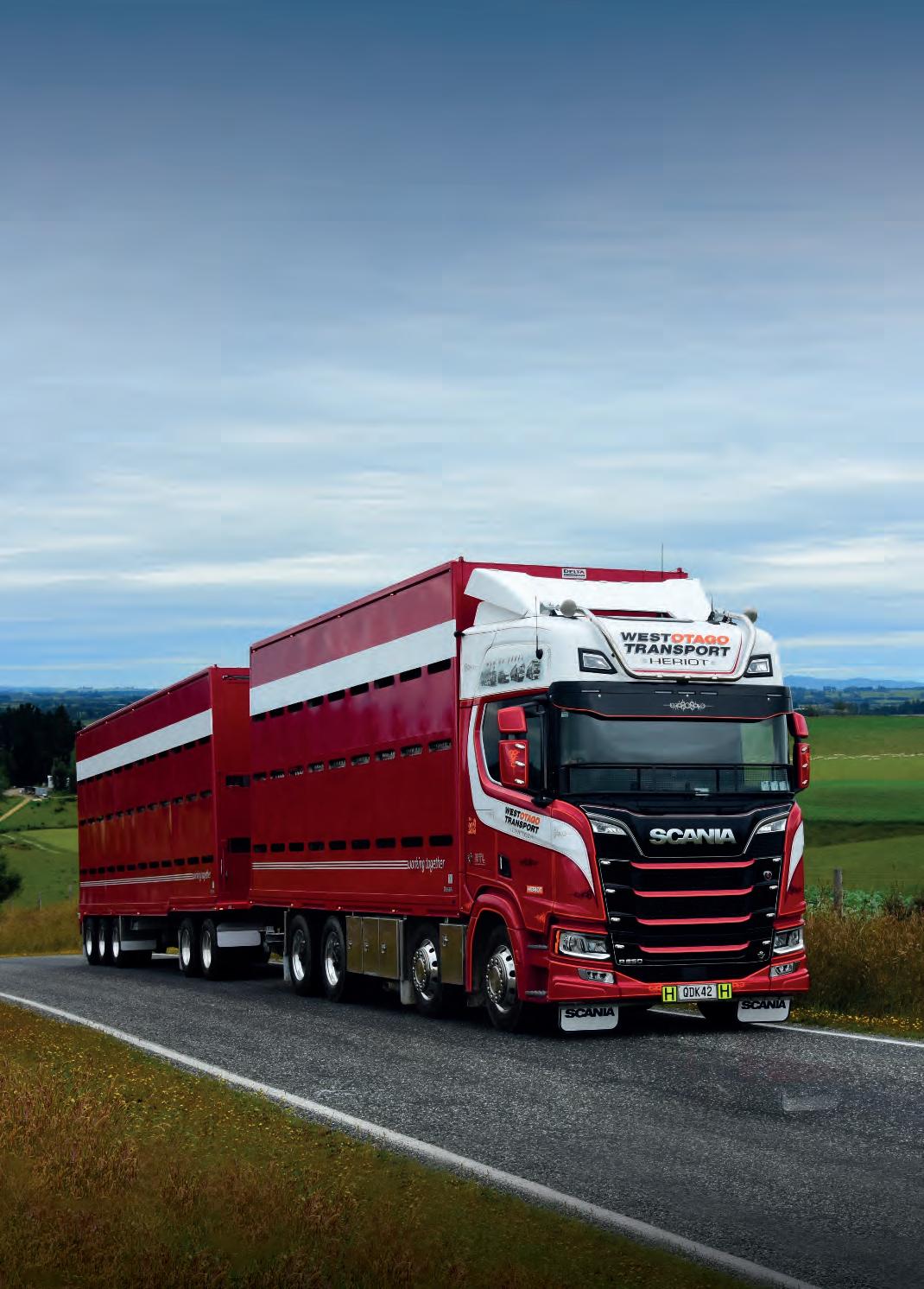
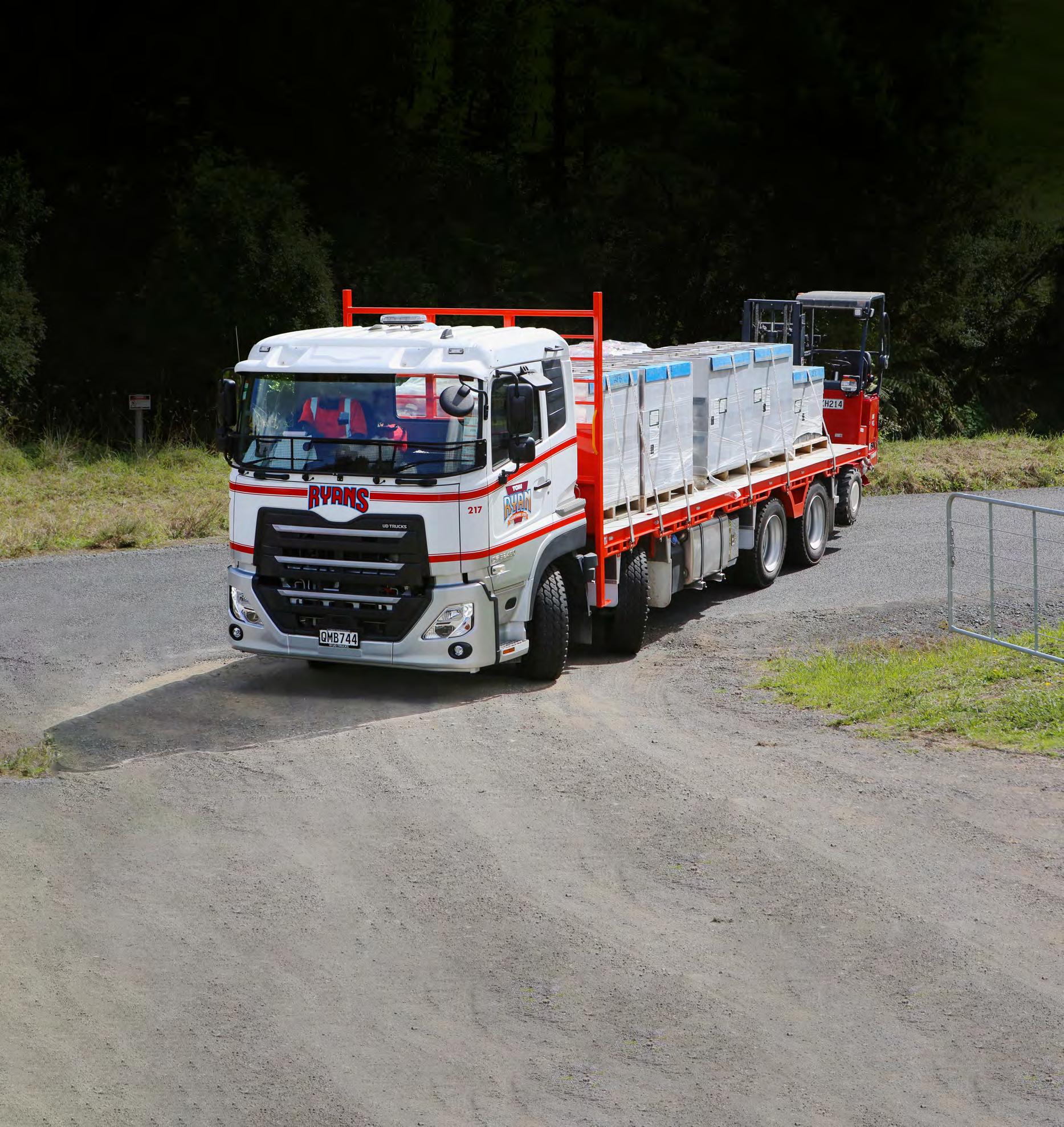



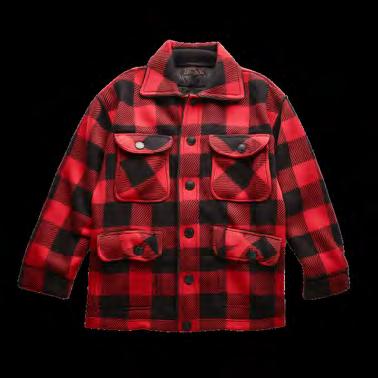


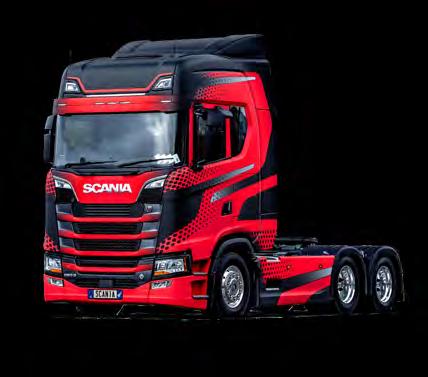










For the second year running the results are in and we couldn’t be happier. Scania has once again been voted the number one* truck brand in the country by the people whose opinion we value the most - New Zealand truckies.
We’re chuffed to have rated highest on all measures, including most preferred, comfort, safety, sustainability, performance, efficiency, service and parts. Thanks again New Zealand. It means a lot.

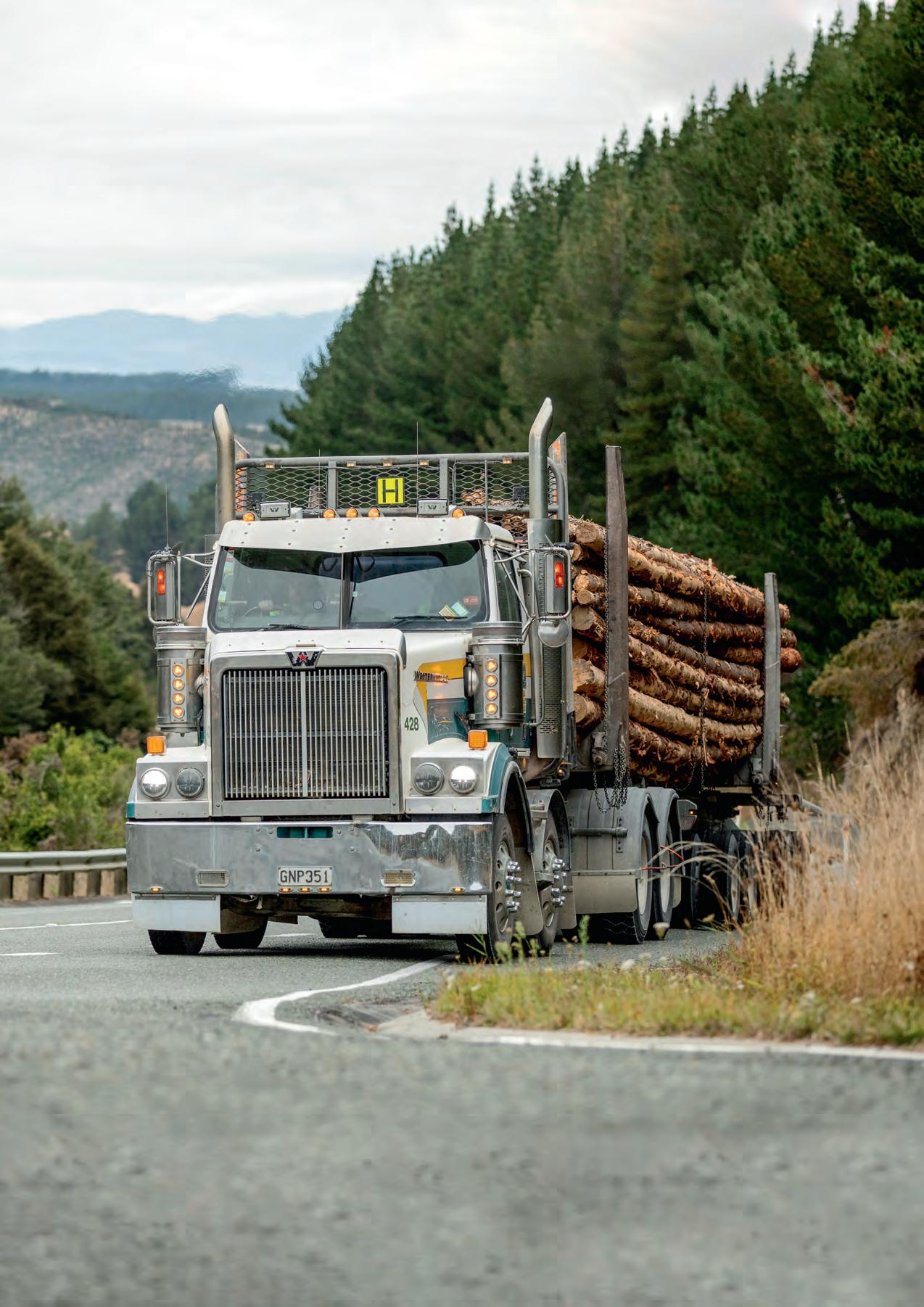 A Waimea Contract Carriers Western Star 4884, with a load of long-pole wood, climbs to the summit of the Spooners Saddle just south of Wakefield in the Tasman region. Photo: Dave McCoid.
A Waimea Contract Carriers Western Star 4884, with a load of long-pole wood, climbs to the summit of the Spooners Saddle just south of Wakefield in the Tasman region. Photo: Dave McCoid.
EDITORIAL DIRECTOR
Dave McCoid
Ph: 027 492 5601
Email: dave@nztrucking.com
EDITOR
Gavin Myers
Ph: 027 660 6608
Email: gavin@nztrucking.com
For all advertising enquiries:
ADVERTISING MANAGER
Pav Warren
Ph: 027 201 4001
Email: pav@nztrucking.co.nz
Mike Devon
Ph: 027 332 4127
Email: mike.devon@nztrucking.co.nz
Maddy McCoid
Ph: 027 336 6811
Email: maddy@nztrucking.co.nz
SUB EDITORS
Tracey Strange, Faye Lougher EDITORIAL
Craig
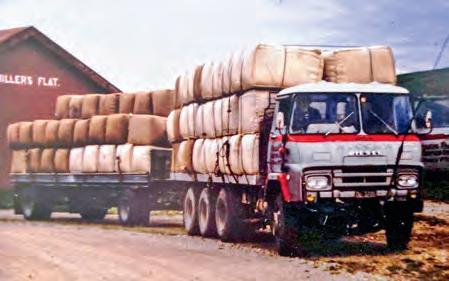
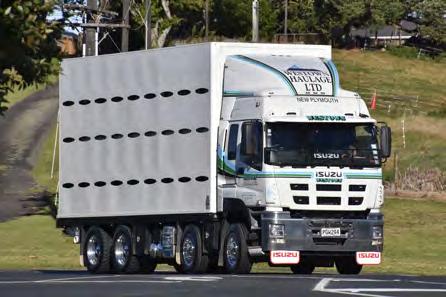

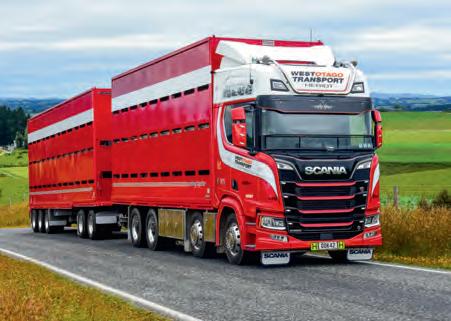
Council Complaint” in the subject line. If unsatisfied, the complaint may be referred to the Press Council, PO Box 10 879, The Terrace, Wellington 6143 or by email at info@ presscouncil.org.nz
Further details and online complaints at www.presscouncil.org.nz
6 months
(6 issues) $59.50
One year (11 issues) $109
Two years (22 issues) $218
1 Year Australia (11 issues) $250
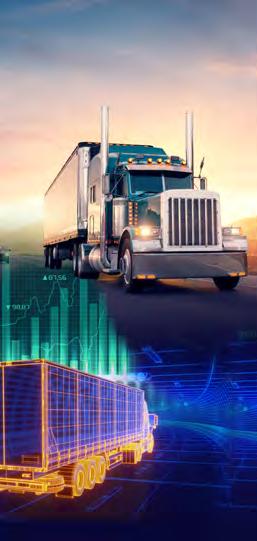
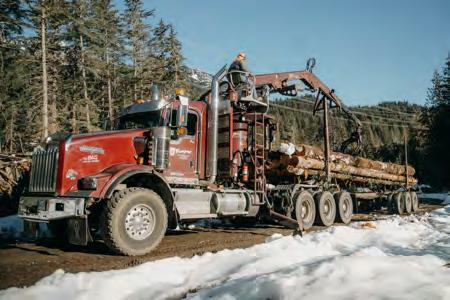

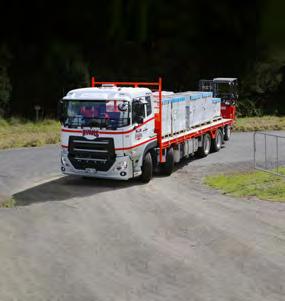

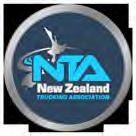
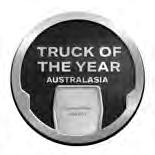
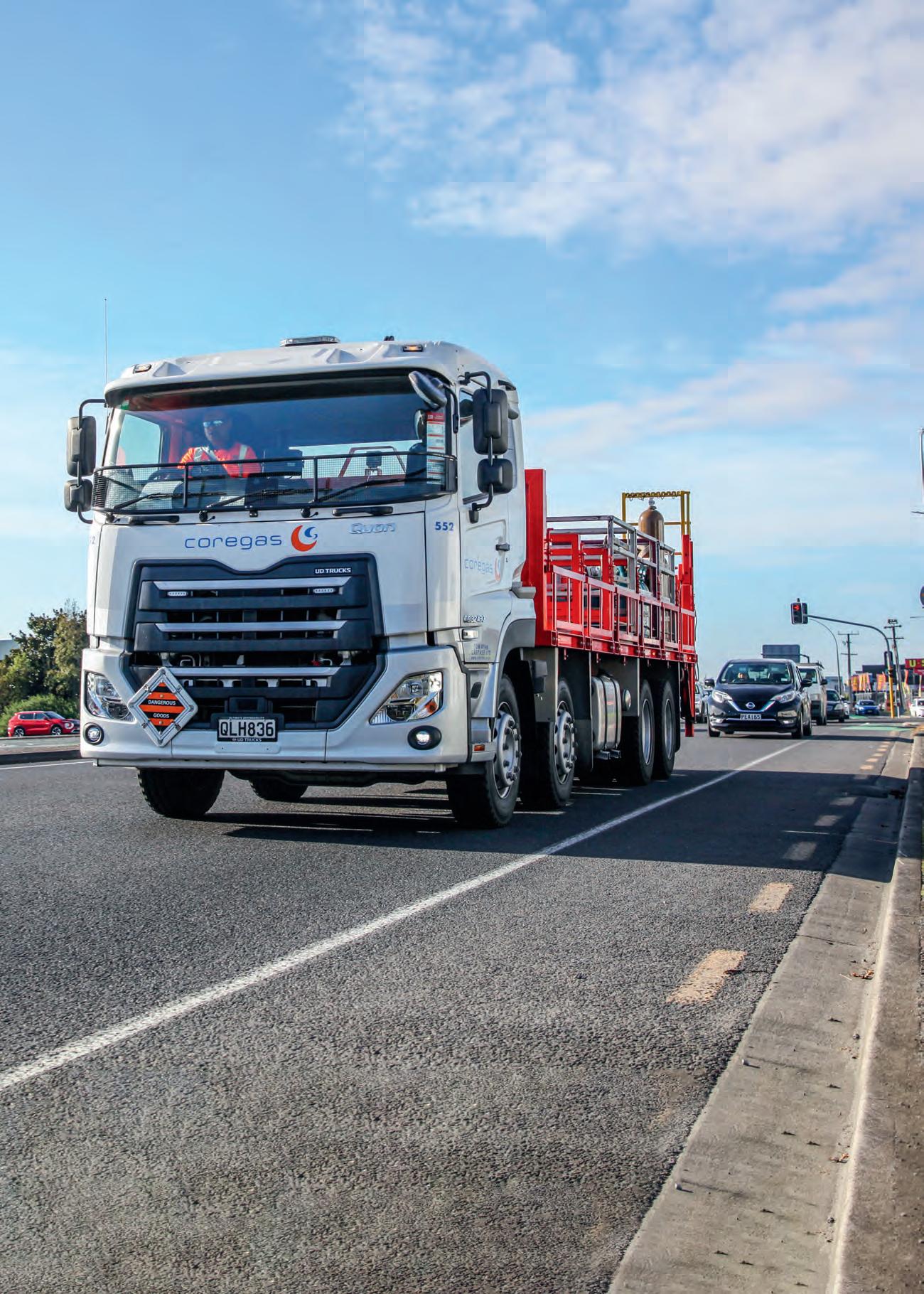





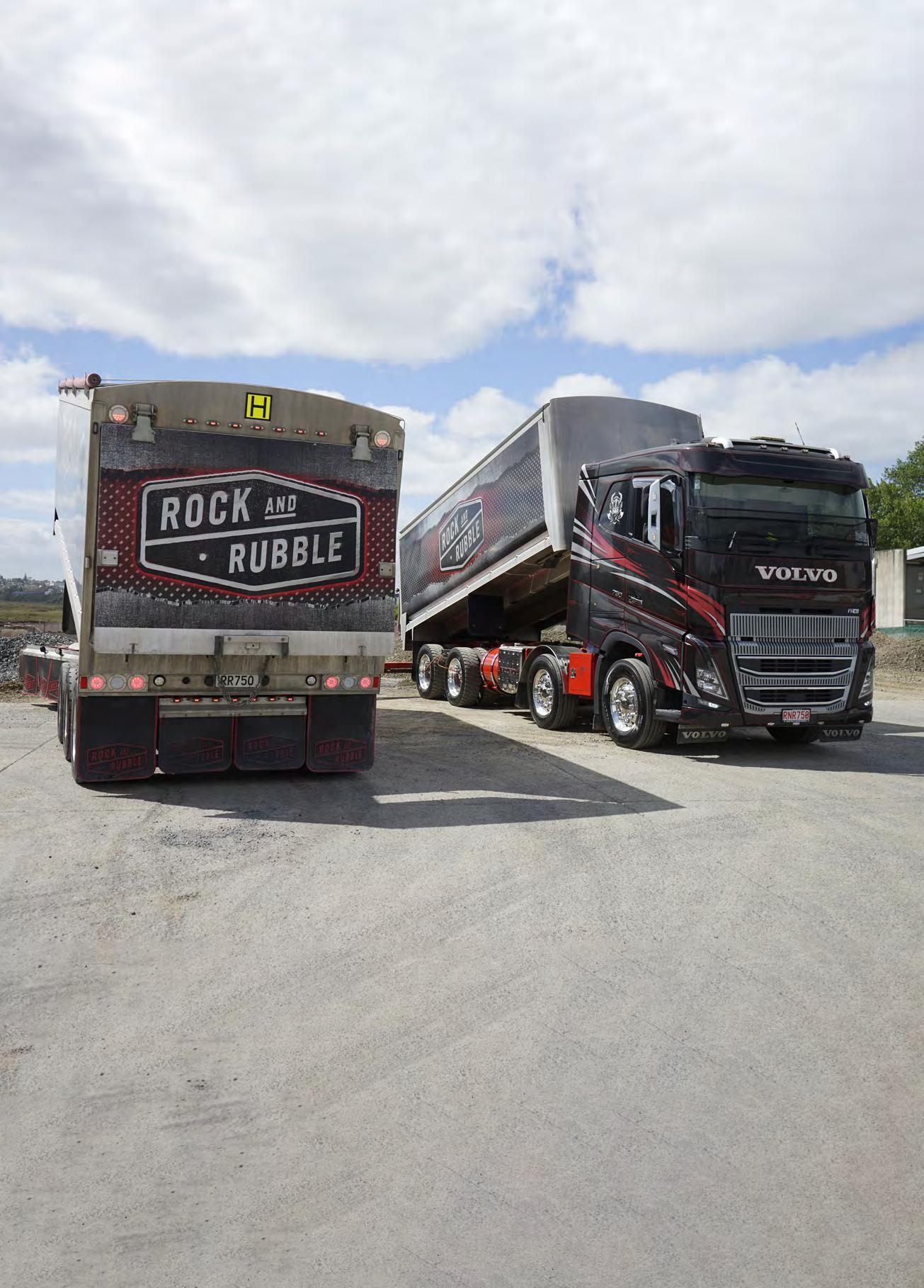
Crowd amasses pre-opening.
The Fairfield Freight Hub (FFH), just north of Ashburton, opened by Transport Minister Simeon Brown on Friday 19 April, is a hands-down winner for the town, the region and the local companies behind it.
Wholly owned by the Wareing Group, the hub demonstrates what can be achieved when public and private collaborations are focused on an end goal.
“In 2019, picture a freight train rolling past half empty, while myself and Murray Young [today NZ Express, then GM KiwiRail] are watching in dismay, knowing there was room for substantial improvement,” said Wareing Group CEO Mark Wareing to
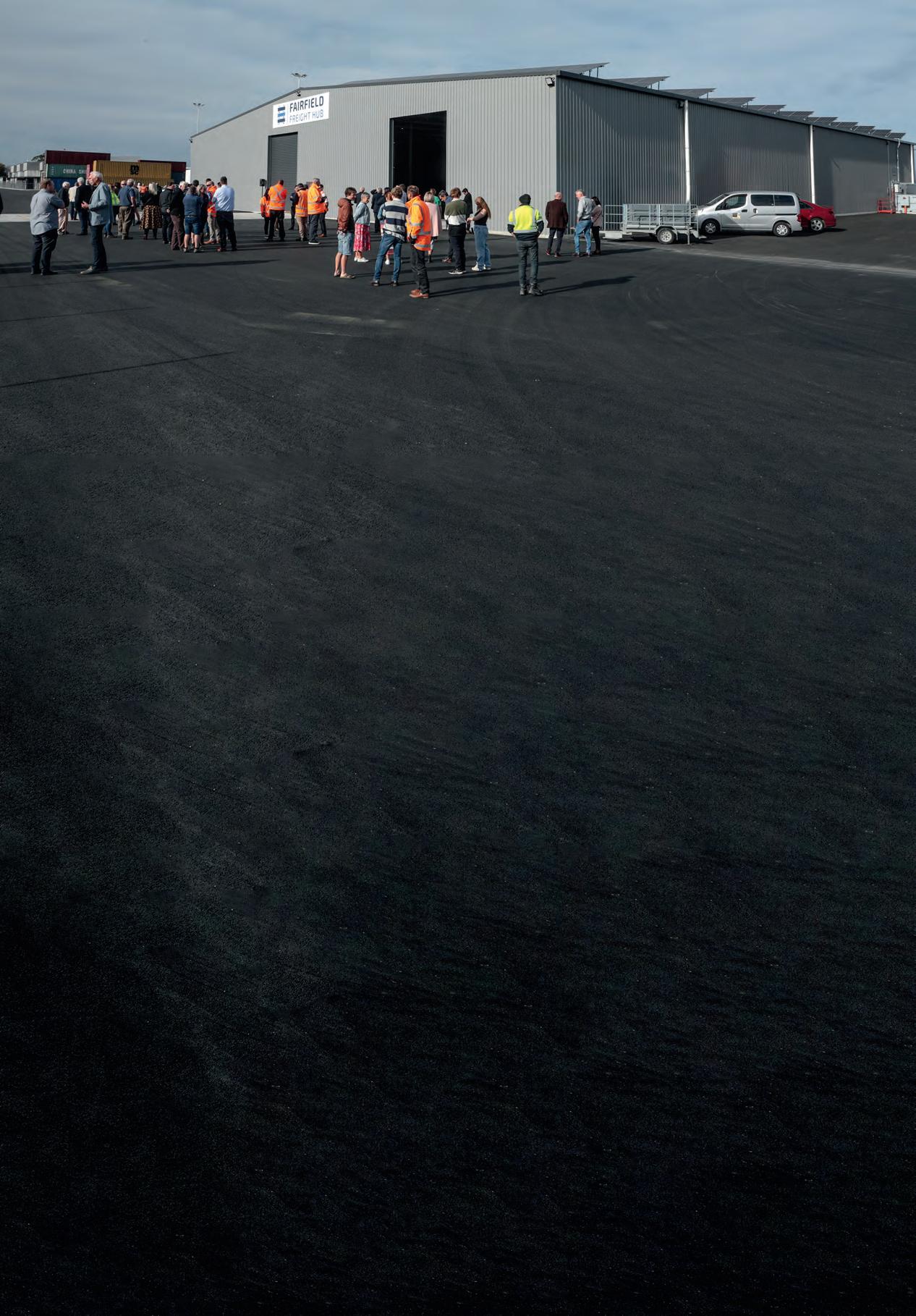
guests at the opening.
Wareing emphasised the team effort in getting the hub from idea to reality, acknowledging the assistance of the Ashburton District Council, local MPs, Talley’s, KiwiRail and MSC Line, among others.
Centred in the midCanterbury food bowl, the FFH transforms the region’s daily flow of inputs and outputs. Central to that is the hub’s role as an empty container release point for MSC Line, and discussions are also underway with other shippers.
“Our exporters don’t have a very long time to get their product to port, and by having empty containers here, we can take out one leg of that journey
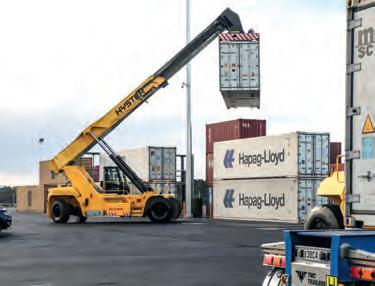
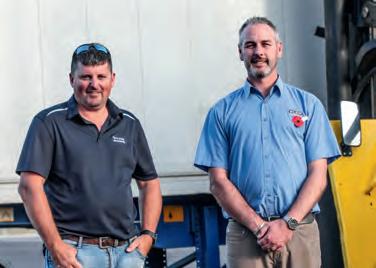
for them,” said Mark.
FFH also moves rail transfer operations from an old site in the middle of Ashburton to the Fairfield industrial park.
The efficiency gains for road transport are significant. Congestion currently plagues container traffic moving to the Port at Lyttelton, and hubbing at Fairfield will reduce that by up to 40,000 truck movements per year. There are also significant environmental gains as the facility draws on solar energy for a part of its operations.
Put to the real test early, the hub has been operational since the Rangitata rail bridge outage, and site manager Mat Bruce and operations manager Heath Little
said it had come through with flying colours.
Fairfield Freight Hub – fast facts
• 40,000m2 facility
• Dr y store 2000m2
• 800 TEU
• 120 reefer plugs
• Bulk commodity silos
• 60 containers railed a day from two rail placements
• 200kW power consumption offset.
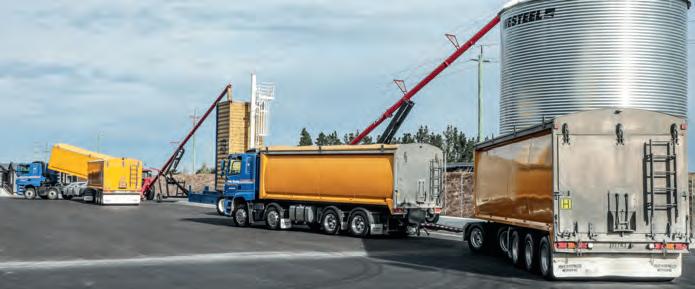
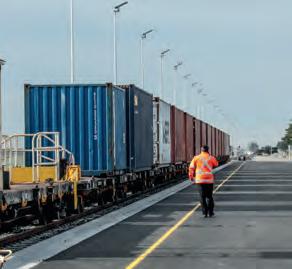
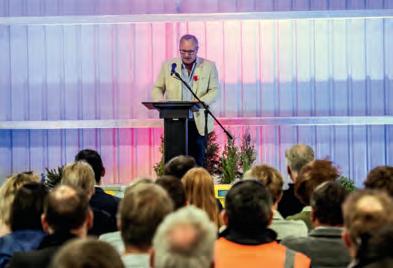 Wareing Group CEO Mark Wareing addresses guests at the opening.
Two key men ensure smooth daily operations –Heath Little (left), onsite operations manager, and Mat Bruce, site manager.
The facility will handle two rail placements per day.
Multi-modal, multi-product with room for expansion.
Heavy container handling.
Wareing Group CEO Mark Wareing addresses guests at the opening.
Two key men ensure smooth daily operations –Heath Little (left), onsite operations manager, and Mat Bruce, site manager.
The facility will handle two rail placements per day.
Multi-modal, multi-product with room for expansion.
Heavy container handling.
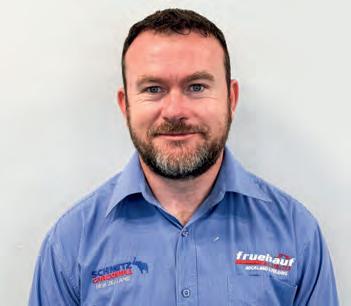
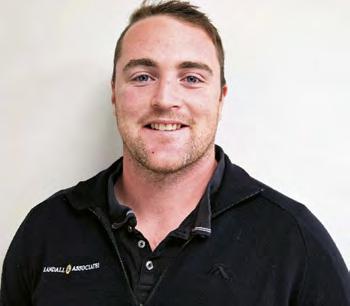

Three lucky transport engineers are off to the United States to participate in a dedicated transport course after receiving scholarships from the Institute of Road Transport Engineers of New Zealand.
The institute’s scholarship fund provides financial assistance to members to help further their knowledge and technical expertise in road transport.
This year, IRTENZ offered scholarships to attend a threeday course at the University of Michigan on the dynamics of heavy-duty trucks.
IRTENZ president Chris Carr said the high calibre of applicants for this year’s prize saw the organisation award three scholarships for the course.
“We were pleasantly pleased with the quality of the applicants and we found it was difficult to choose a winner,” Carr said.
The full 2024 scholarship award was given to Rory O’Sullivan, who has been involved in the heavy vehicle industry since 2011 in multiple roles and is currently the general manager, manufacturing, for Fruehauf NZ.
Financial assistance was also provided to Tim Stone from mechanical engineering consulting firm Randall & Associates, and Alan Kirk,
a heavy vehicle certifier at bodybuilder and trailer manufacturer Gary Douglas Engineers.
The University of Michigan course focuses on the special dynamic behaviour of truck systems, merging the fundamentals of vehicle dynamics with the details of truck components and properties.
“The University of Michigan is a long-standing transport research institute and is one of the leaders in the field,” Carr said.
“The course provides a solid background in vehicle dynamics and operations.”
Carr said New Zealand’s transport industry was unlike any other, and having people learn as much as possible would only benefit the sector.
“We’ve got a really strange country that we live in when it comes to our transport design. Our vehicles are not really like anyone else’s around us – we’re quite different to Australia, to Asia, to the US ... [and] very different to Europe except for some bits in Scandinavia.
“What we do is unique. And our topography is pretty unusual because everything’s sort of up and down and round and round. So we always need to be looking for the next thing that will improve our industry, and supporting the people who are going to come up with those things. We think that our
scholarship winners will be able to contribute greatly to industry knowledge with what they gain from this course.”
Carr said the scholarship represented a big step by IRTENZ to help the future transport industry.
“Like drivers, the engineers in our industry are getting
older, and we are losing IP as they retire.
“We need to do what we can to help provide education and training for the people that are in the industry, and hopefully provide some interest for people coming into it,” he said.
“This is IRTENZ investing in the future of heavy transport.”
Rory O’Sullivan, Tim Stone and Alan Kirk will all head over to the University of Michigan.The Commerce Commission has granted clearance for NZ Post to acquire PBT’s courier customer contracts.
PBT provides freight, courier and logistics services throughout Aotearoa, offering intercity courier services primarily to business customers in urban areas.
In reaching its decision, the commission focused on the potential impact of the proposed acquisition on competition in the supply of intercity economy courier services.
It had expressed initial concerns that the proposed acquisition would remove
a disruptive competitor for intercity economy courier services. However, after further investigation, chair Dr John Small said the commission was satisfied the acquisition was unlikely to lessen competition in any New Zealand market substantially.
Central to the commission’s decision was its assessment of the competitiveness of PBT absent the proposed acquisition.
“Our investigation indicated that absent the proposed acquisition, it is unlikely that PBT would likely provide a significant disruptive influence on the supply of intercity economy courier services,” Small said.
“Post-acquisition, customers

requiring intercity economy courier services would have options for courier providers such as Freightways, Aramex and Team Global Express, in
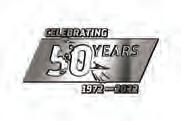
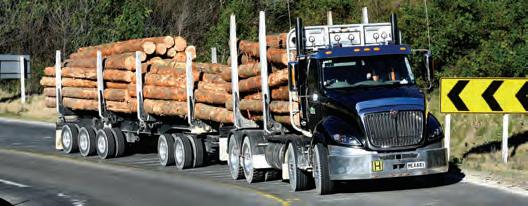
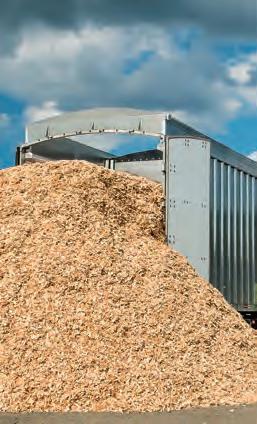
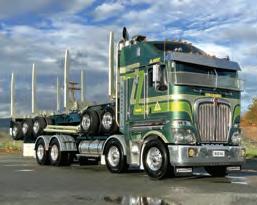
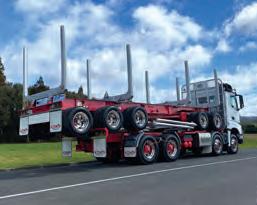

addition to NZ Post, and the loss of PBT is unlikely to have a material impact on the price and/or the quality of intercity economy courier services.”

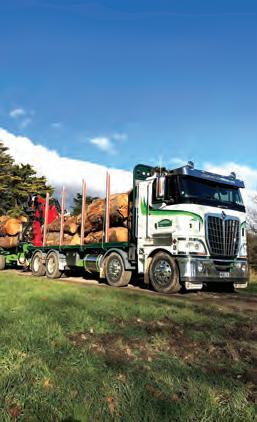
Teletrac Navman has launched a new podcast
– Mobilising The Future of Fleets – as an educational
from the transport industry. The podcast covers the energy options for a mixedenergy fleet and the reasons
of behavioural change on the success of a mixed-energy future, and answers to questions submitted by fleet operators will
European sales manager at ANGI Energy Systems, a specialist in alternative energy solutions and also part of Vontier.
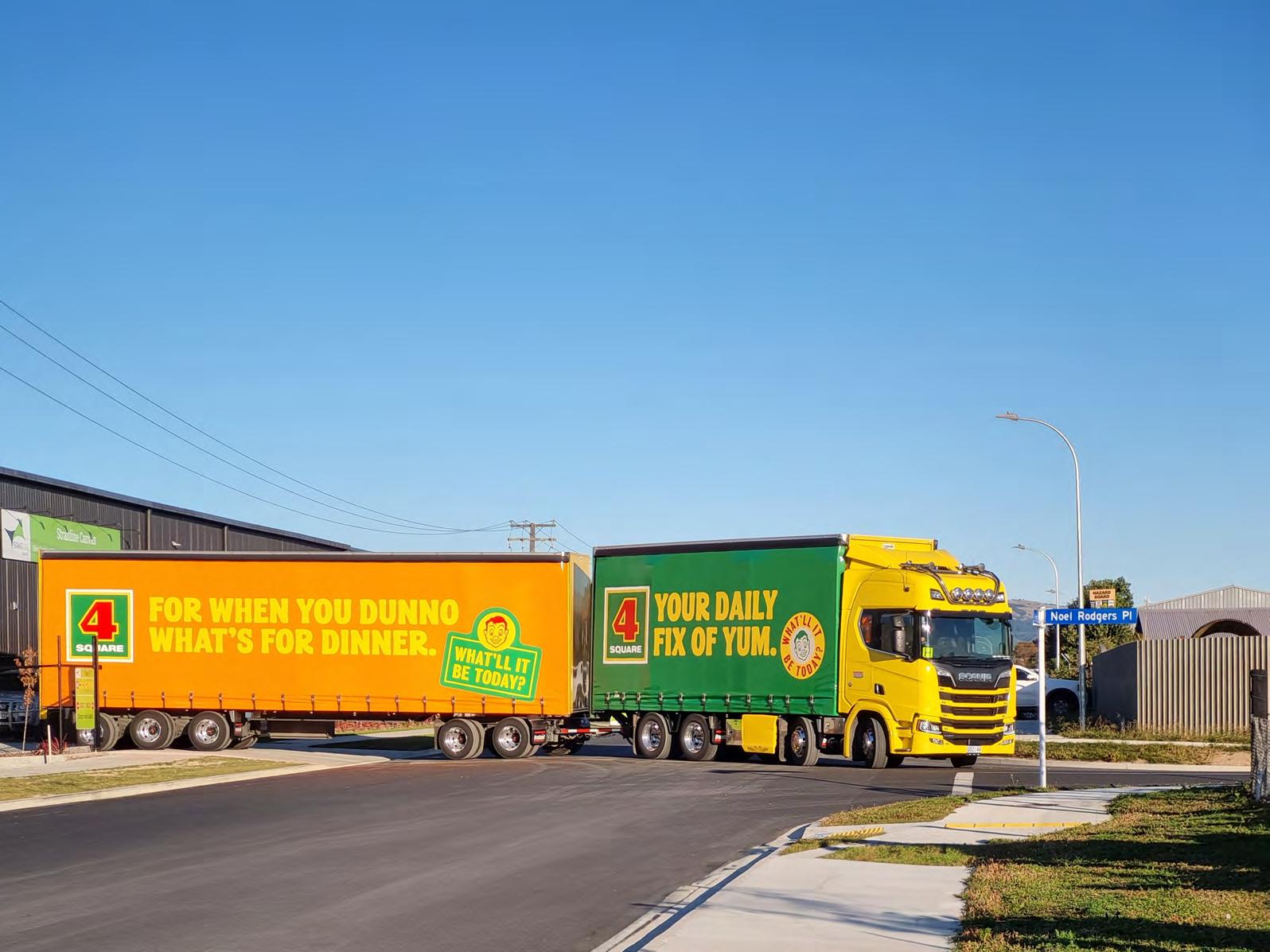




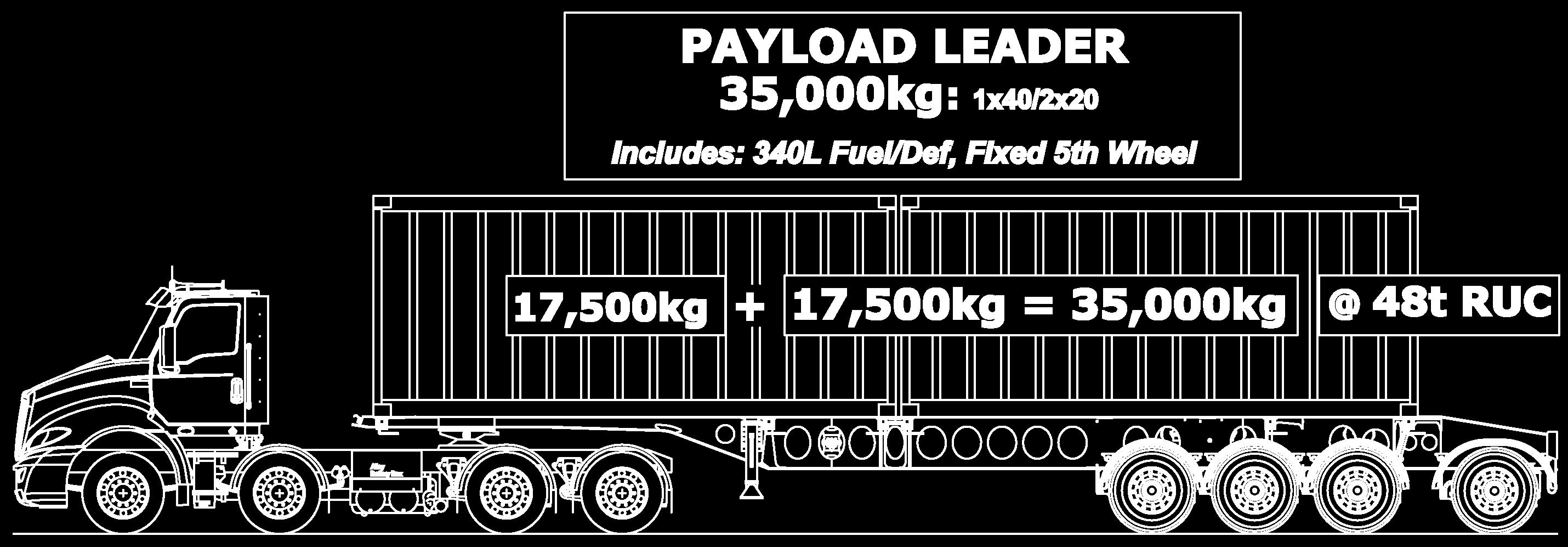



Alcohol detections in the workplace have risen significantly, according to new research from The Drug Detection Agency.
TDDA saw the detection rate nearly double during the 2022 and 2023 holiday periods. Traditionally, positive detections reduce after December and January, but initial testing results show the increase yet to subside, holding steady with a 13.8% increase over the past two years.
The data comes from Imperans, TDDA’s digital reporting system, the country’s largest private database of drug and alcohol testing information.
“TDDA has seen higher detection levels surpass the holiday season. There’s a longer tail on the issue, and it’s
becoming a regular trend. We’re flagging the increased alcohol use with our clients as well as the wider business community, so everyone is aware of the increased workplace risk,” said Glenn Dobson, CEO, TDD.
While data shows a marked increase in positive detections, anecdotal evidence indicates a range of issues causing the substance to extend from home to work. Stress at home, mental health issues and financial and inflationary pressures have been cited as triggers for use. Given the upward trend, companies are encouraged to review their current substance policies, also known as a drug and alcohol policies, to ensure it remains current, fit for purpose and legally robust.
“While it’s hard to draw
causal lines between workers’ behaviour and alcohol issues, anecdotally, TDDA is hearing that traditional dependence issues are being inflamed by factors like mental health issues as well as financial pressures,” said Dobson.
Understanding alcohol issues, establishing a cohesive drug and alcohol policy and training and education are essential for maintaining a safe and productive workforce as well as compliance with the Health and Safety at Work Act 2015 (HSWA). Employers are encouraged to regularly evaluate their drug and alcohol policies and address the ever-changing and unique challenges posed by substance use.
TDDA recommends the following testing methods for
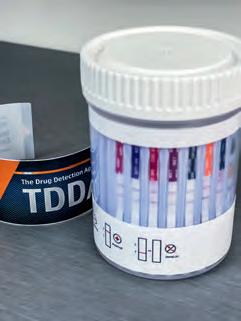
alcohol detection:
• Breathalyser: the same technology used by roadside police to demonstrate presence. Primarily used in mobile testing clinics for on-site screenings and spot testing.
• Alcohol hair testing: a hair sample collection that is used to demonstrate lifestyle alcohol use. Primarily used for court-ordered testing or pre-employment screening of professional job applicants.




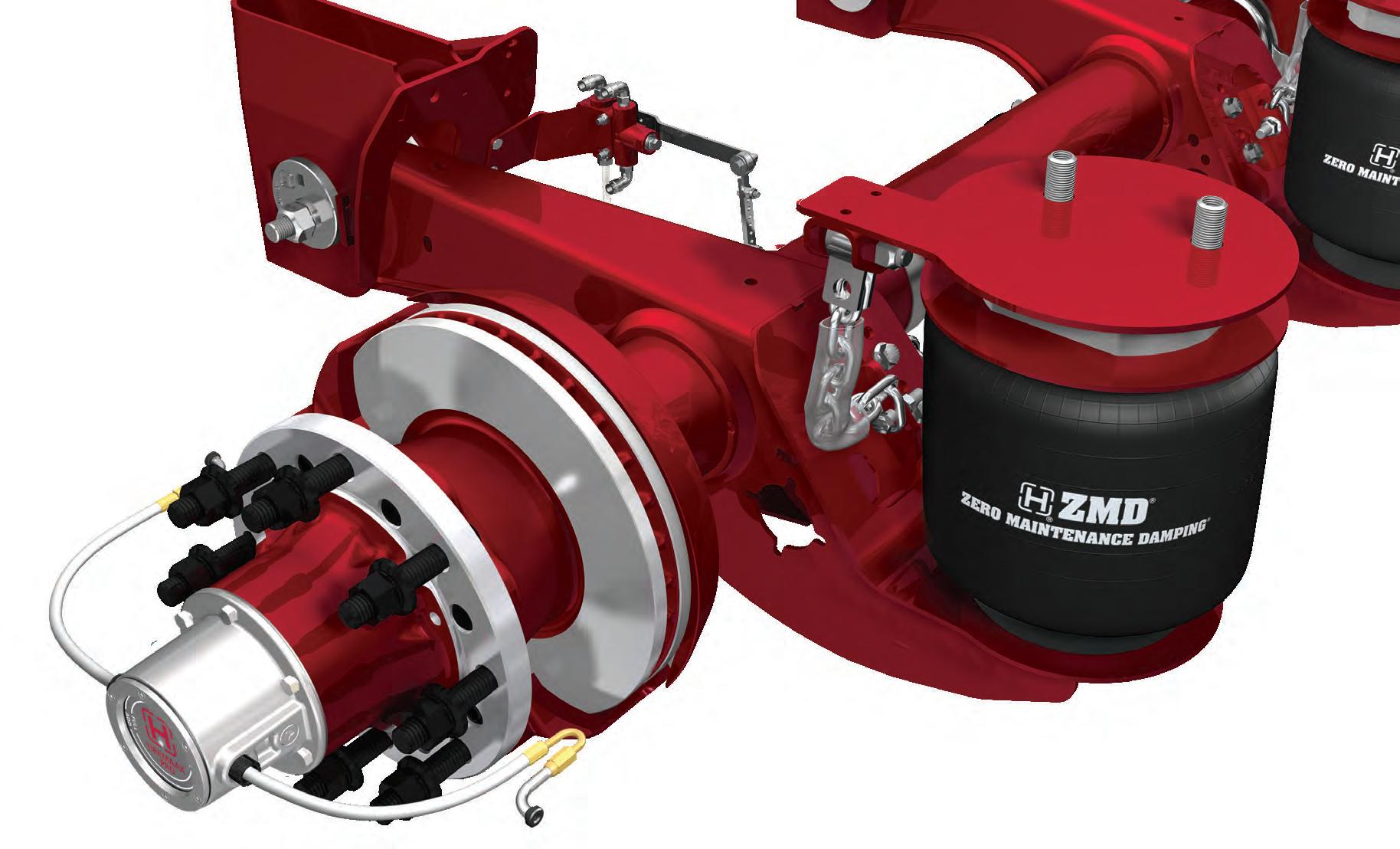



tonnes of green hydrogen per
year. Since opening the plant, Tūaropaki Trust and Obayashi
refuellers needed to be located
routes as possible, hence the refueller’s location in Manukau.
The refueller can be relocated as customers’ needs change.
Halcyon’s model of hydrogen hubs, including the Mōkai
supplied from one source,
providing economies of scale.
“Reliable, local hydrogen supply gives our customers the confidence to invest and innovate,” said Dave Binnie, general manager energy at
Further to being the site location for the refueller,
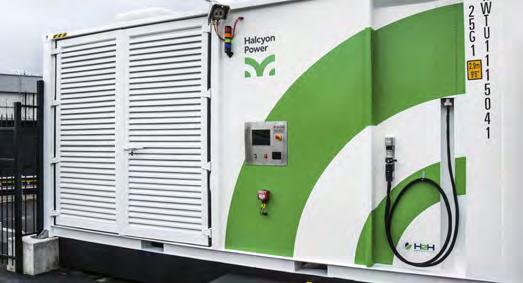
Coregas’ manufacturing and supply experience was critical to the project’s technical and compliance requirements.
“Taking charge of Halcyon’s express refueller enables us to provide our expertise in managing H2 distribution while supporting the transport evolution for New Zealand,” said Peter Neate, general manager at Coregas NZ.
“The transport and trucking
sector in New Zealand remains a largely untapped opportunity for hydrogen-fuelled heavy vehicles, which deliver a lighter, longer-distance solution combined with fast refuelling and high payload capability.”
In the same week as Halcyon’s launch, Hiringa and Waitomo launched New Zealand’s first hydrogen refuelling network. Turn to page 100 to read about that.

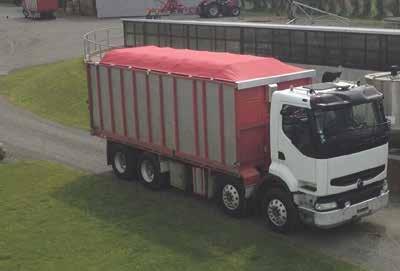



We specialise in
suit
We specialise in high quality, mesh and PVC covers to suit trucks, trailers and farm bunkers. All of our covers can be easily operated from the ground using a silky smooth cable system, eliminating health and safety risks.
We specialise in high quality, mesh and PVC covers to suit trucks, trailers and farm bunkers. All of our covers can be easily operated from the ground using a silky smooth cable system, eliminating health and safety risks.
All of our covers can be
We specialise in high quality, mesh and PVC covers to suit trucks, trailers and farm bunkers. All of our covers can be easily operated from the ground using a silky smooth cable system, eliminating health and safety risks.



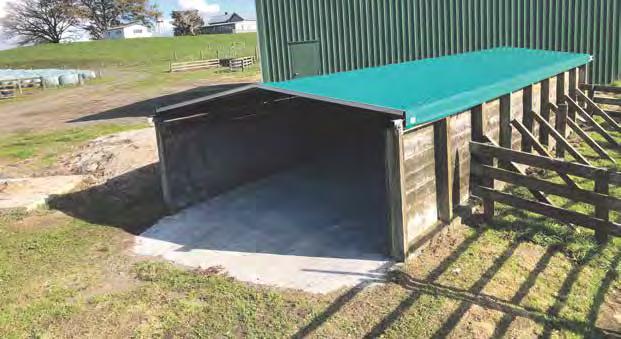


Aglobal survey of 1800 supply chain leaders shows average response time is five days, hindering progress on resiliency and risk mitigation.
New research has found slow progress in making supply chains more flexible and resilient.
The IDC research, sponsored by Kinaxis, also highlighted response time.
The survey of 1800 supply chain decision-makers worldwide found most struggle to keep their operations agile and adaptable amid an onslaught of disruptions from geopolitical conflicts, natural disasters and other volatility.
“It’s more common than ever on quarterly earnings calls to hear that supply chains
address these compounding trends and make chief supply chain officers the heroes instead of the scapegoats the next time trouble appears on the horizon.”
Although respondents in all regions are overwhelmingly not “very satisfied” with their business’ ability to withstand and respond to supply chain shocks, they remain optimistic about technology’s potential to
• 42% of consumer product respondents rate their supply chain orchestration as mature, the highest among all verticals.
• 25% of respondents plan to move to new technologies in the next year to improve resilience.
• 33% want supply chain orchestration platforms that offer AI/genAI capabilities. 63% view their supply chain
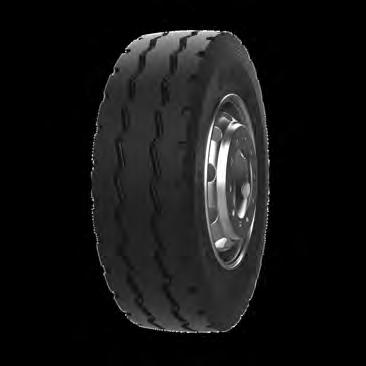
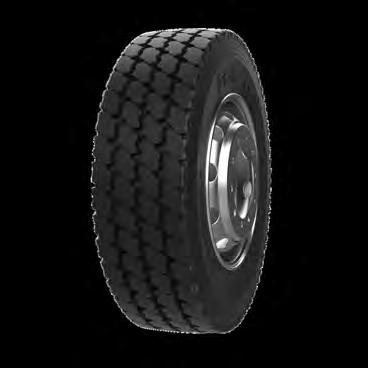




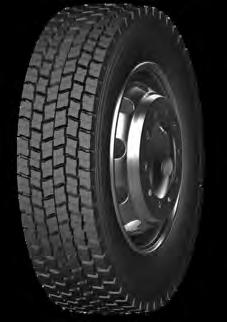

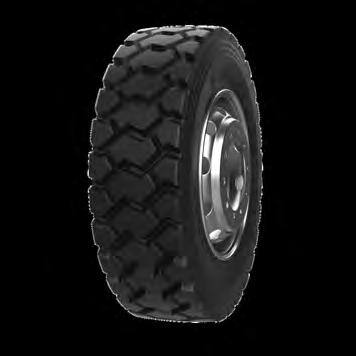
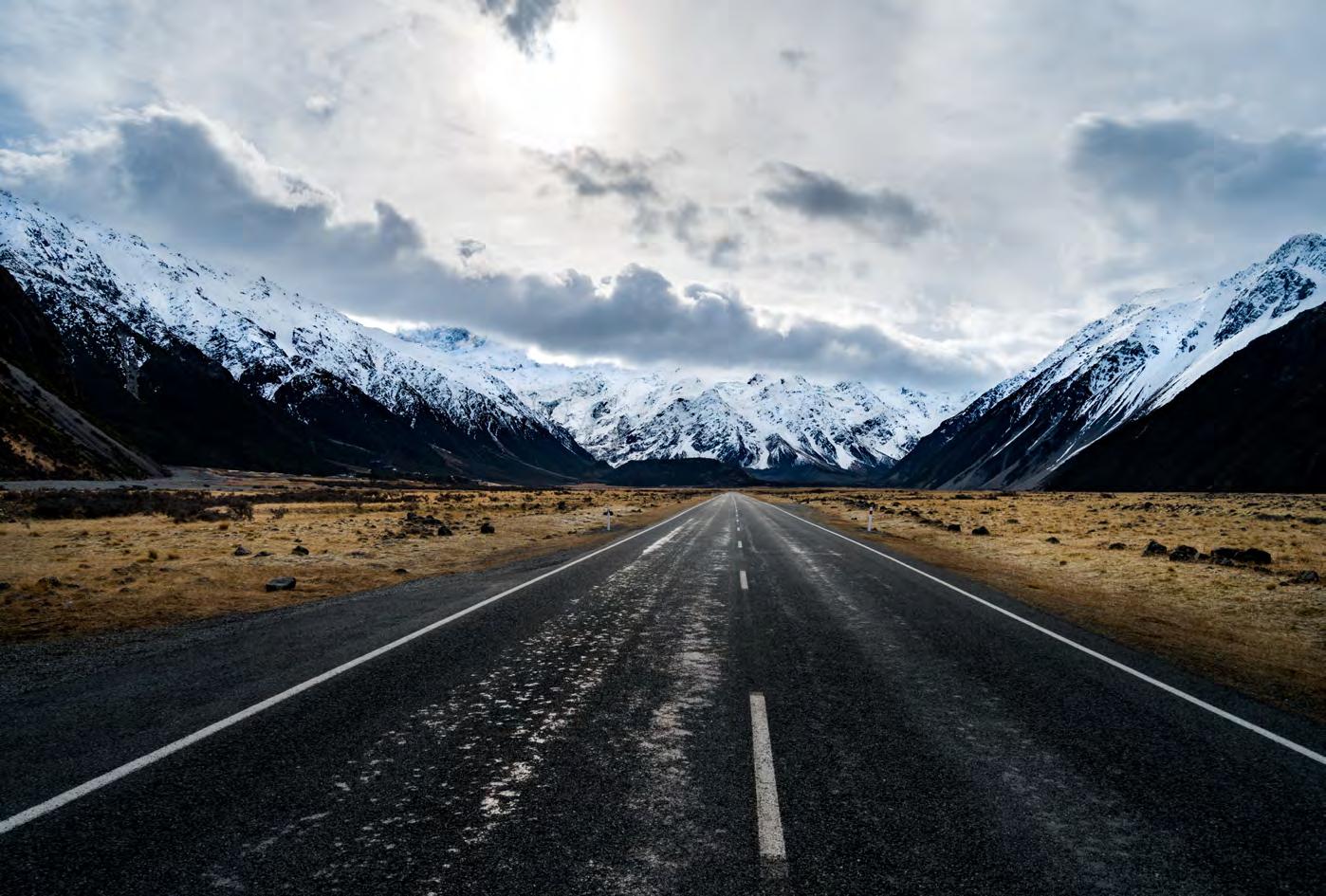

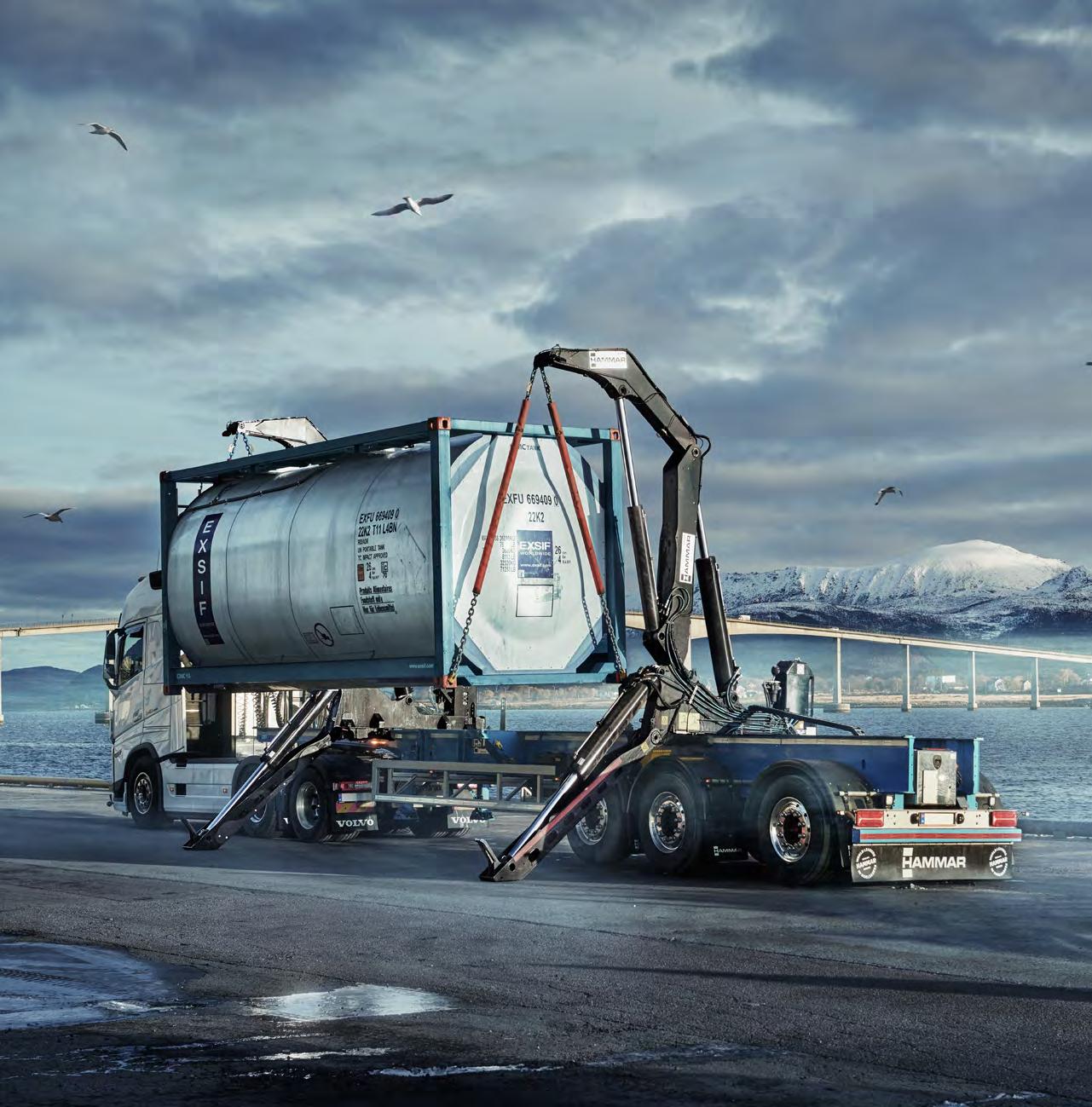


Hammar is the world leading manufacturer of Sideloaders, self-loading vehicles for containers and more. A competetive quality solution for container logistics, special transports and terminal handling.
+ Made in Sweden since 1974, delivered to more than 122 countries world-wide
+ Lift, transport and transfer up to 50 tonnes
+ Increase safety and efficiency with grounded containers
+ One vehicle, one driver, anywhere, anytime
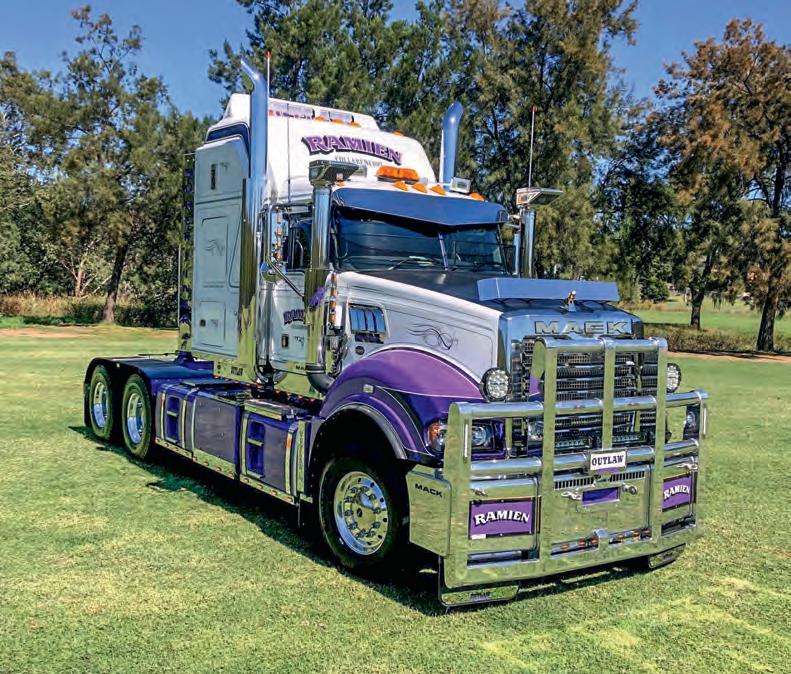
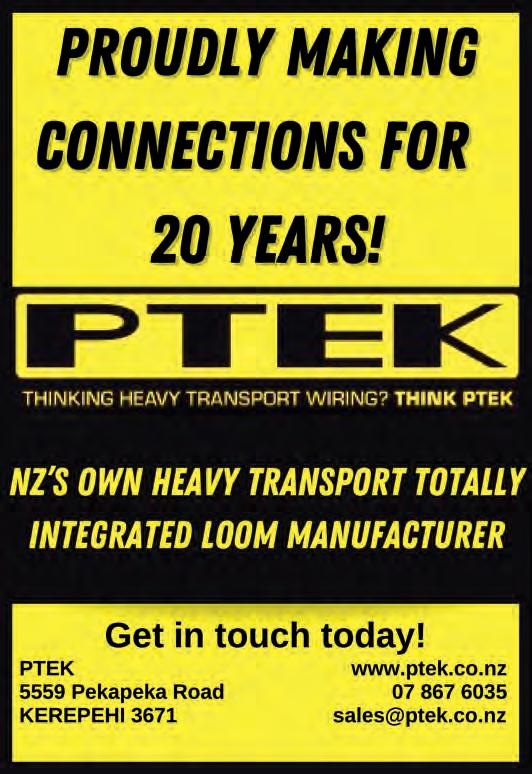
First, there was red. Then black, blue, green and maroon. Now, in May 2024, purple joined the fray as JT Fossey Trucks in Tamworth, New South Wales, released the latest custom Mack Super-Liner in its Outlaw series.
Outlaw 6 entered build in November 2023 and has now taken to the road with its new owners, the Ramien family of Collarenebri in western New South Wales.
“Outlaw 6 is a great example of the continuation of this amazing series, showcasing what Mack Trucks can offer to their new and loyal customers. The Outlaw series Mack SuperLiner gives the driver every possible option to make their driving experience the best and most enjoyable it can be,” said John Saint, dealer principal of JT Fossey Trucks.
“Like the first five trucks in the series, Outlaw 6 features unique colour coding, scrolls, graphics, a bulbar, and other polished stainless adornments.”
Like the first five trucks in the series, Outlaw 6 features unique colour coding, scrolls, graphics, a bulbar, and other polished stainless adornments, with the interior theme matched to the truck’s exterior.
“Congratulations to Julia, Allan and Jasen. We truly appreciate your support and new business relationship. A massive thank you to all the businesses and associated people who have spent hours getting this truck built and presented to our customers,” Saint concluded.
The Outlaw series will eventually comprise 10 unique Super-Liners. To find out more, check out our feature Outlaws Roam, in the July 2023 issue of New Zealand Trucking.

 Outlaw 6 in all its custom, purple glory.
Outlaw 6 in all its custom, purple glory.

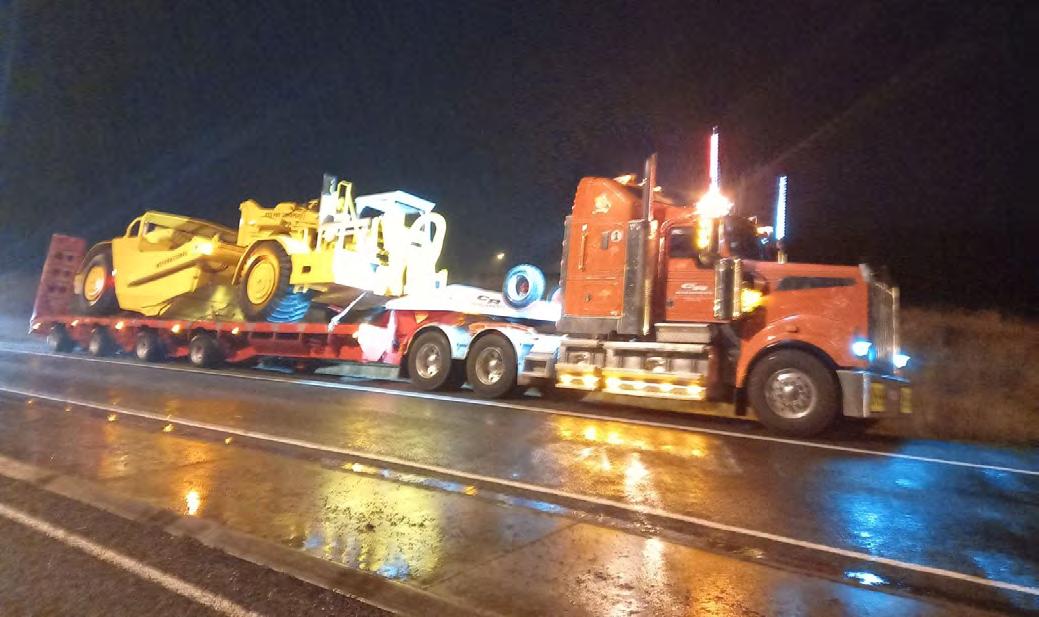
Our winner this month is Murray Peake from C&R Developments near Cambridge. Murray captured this shot of his T908 Kenworth, loaded with an International 433 scraper, while stopped for a chain check just south of Taupo in amongst some solid rain. Well done Mate, your prize is on it’s way to you. Now get your entries in for the July competition...
ENTER NOW TO BE IN TO WIN A PAIR OF PETERSON’S SUN GLASSES
Send your best night bling photo as well as contact details into nightmoves@nztrucking.co.nz to enter
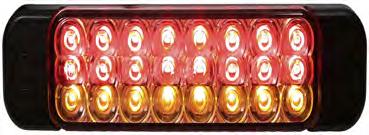

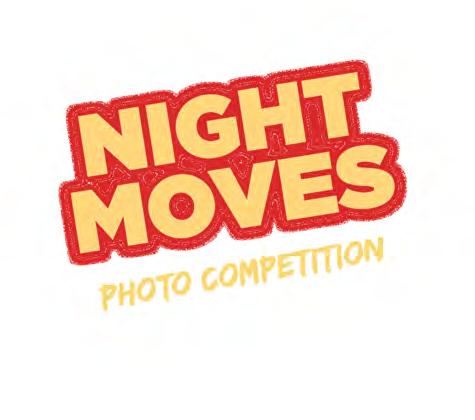





Two long-standing names in trucks and trucking have come together, proving how the right gear in the right environment can have a positive impact company-wide.
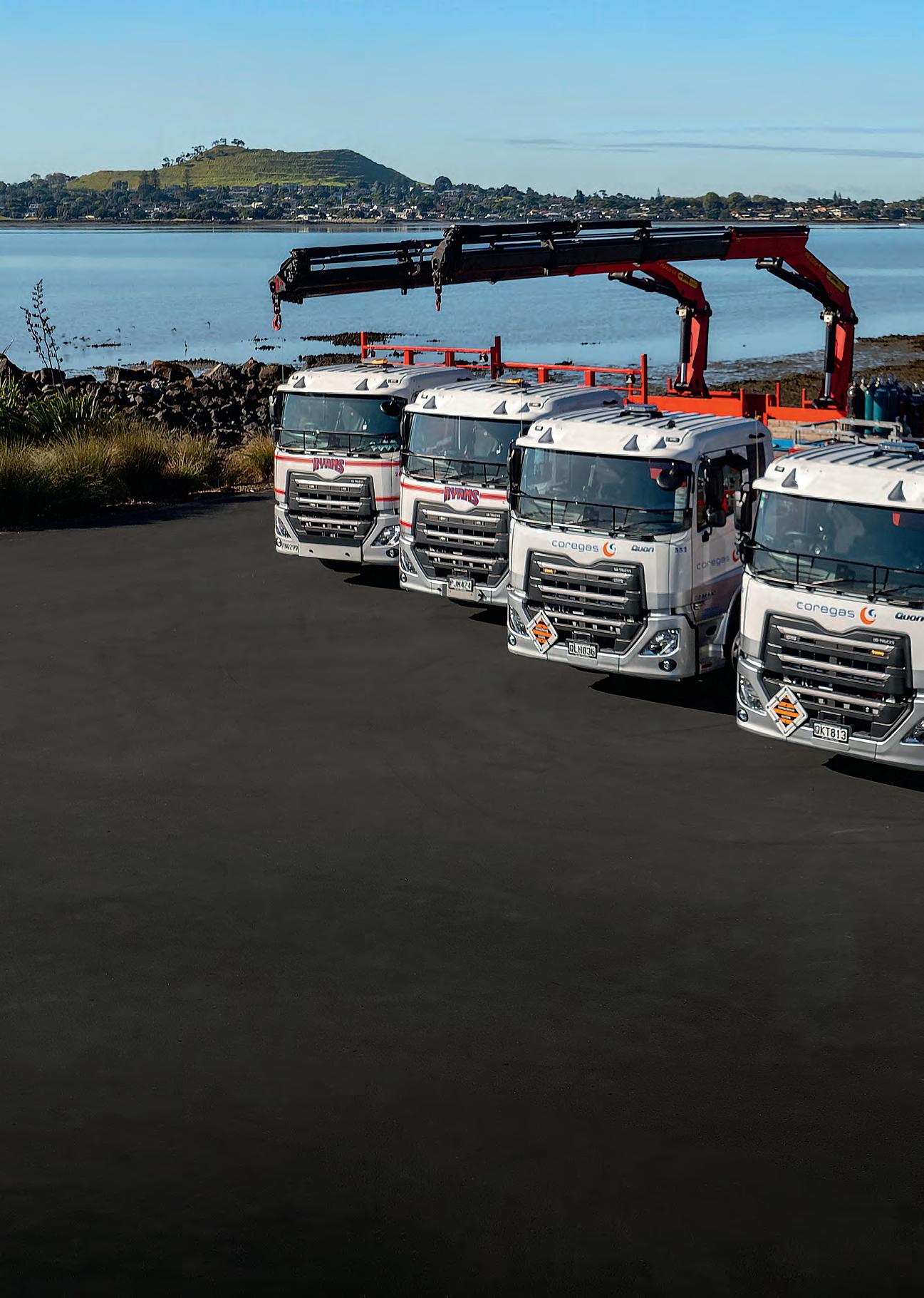 Earl Edwards and Gavin Myers
Earl Edwards and Gavin Myers
We speak about it often in the pages of New Zealand Trucking magazine: Company culture and all it encompasses within successful businesses … Enabling your people to do and be the best they can, giving your clients the highest level of service possible, and implementing the right tools and
processes to do the job as efficiently and safely as possible. Every company will have a different definition and different ways of making it happen but, if done right, the results are longevity, loyalty, respect, pride and success.
So often when it comes to trucking, culture is built over decades and stems from the hard work and
Photos and video bydedication put in by the company’s pioneers right from the beginning.
Auckland’s Tom Ryan Cartage is one such company, started by Tom in 1979 and incorporated as Tom Ryan Cartage in 1985.
After 45 years in the game, Tom is still active in the business, though general manager Alan Spilhaus now coordinates day-to-day running.
“Tom comes in three or four times a week and provides valuable stewardship and guidance. Being honest, he loves the trucks, loves his workshop. He’s a truckie through and through,” says Alan. “I’m more of a bean counter – finance and money,” he adds with a laugh.
The company’s story leaves little doubt as to how its culture was
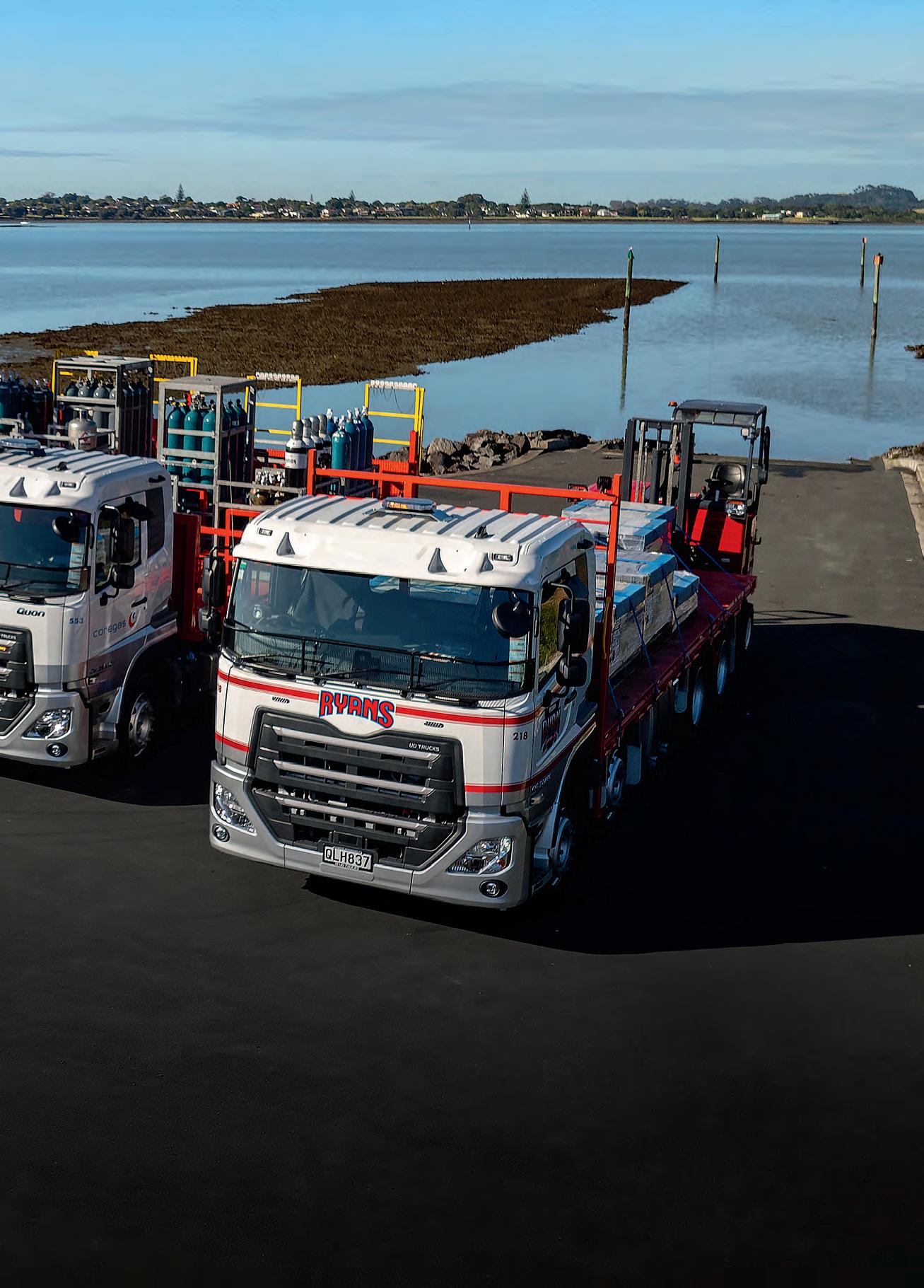
formed. “It starts in 1979, with Tom and a little Bedford,” Alan explains. “Tom had worked for his dad’s meat haulage business and effectively woke up one morning with the desire to buy a truck. That was the Bedford, and he got straight into it. Within three years, he was looking after Dysart ITM. That grew in the 1980s to running more than
Photo: UD Trucks.10 trucks predominantly due to his level of service, still servicing Dysart ITM and Manukau Timber, which later became Placemakers Frame and Truss.”
The 1990s was a period of significant growth for the company via acquisition.
“We diversified into truck-mounted cranes, containers, a bit of air and sea freight, warehousing and shipping and barges along the way,” continues Alan. By 2004, Tom Ryan Cartage also had a presence in the South Island.
“The height would’ve been around the 2008 GFC, with 267 staff, four ferries and 180 trucks. But a real period of rationalisation followed that, a realignment in terms of how we balanced service and never saying no, with sensible business decisions: ‘Yes, we can do that, but under these terms and conditions,’” Alan explains.
And so the container division was divested to L.W. Bonney & Sons, the South Island operation to Northern Southland (which subsequently sold it to Toll), and the ferries were taken over by Sealink.
“It’s been a pretty good time since,” says Alan. Today, the company is home to 110 staff, with a truck fleet of just over 100, split between its two Onehunga premises

in Alfred Street and Galway Street. “Galway Street is currently the workshop, serviced by a team of nine mechanics who do a lot of our R&M. It was Tom’s original premises. We moved into Alfred Street in 2002. It’s the old McIvers yard. We added the Approved Transitional Facility (ATF) for container packing, unpacking and warehousing.”
In addition to warehousing, Tom Ryan Cartage today has a general freight division, an air and sea freight-transfer division and a truck-mounted crane division. By far the biggest area of the business, the fleet of 65 truckmounted cranes mostly serves the city’s construction industry. While these are “the bread and butter”, comprising 65% to 70% of the business, they are also supported by a range of flatdecks, trombones and tipper units.
Palfinger is the crane of choice. “They consistently hit the mark, have excellent aftersales and have always been on the money with parts, crew and turnaround. They continue to perform, and we’ve always been pretty happy with them,” Alan says. The cranes are supplemented by
two rigid units fitted with Moffett truckmounted forklifts and four articulated lowloader units that carry Ausa forklifts. Why the rigid/Moffett, low-loader/ Ausa combinations? “The Ausas have a 2.5-tonne lifting capacity but weigh 4.5 tonne. As a traditional forklift, they’re more terrain-able and can efficiently and quickly unload 19 tonne of palleted product onto sites where cranes aren’t the right solution. But it’s a bloody artic unit running around Auckland … we get sent to places like Parnell with these things, and it’s ridiculous,” Alan explains.
“As rigids, the Moffett units are much smaller and more agile. We can get up so many more streets with these trucks. Yes, the artics give us more payload but can be a headache on the site. So, even if the Moffetts themselves are a little less capable on undulating terrain than the four-wheel Ausas, that mix is about right for now.”
By all accounts, Alan takes a no-bullshit approach to his role as GM, so when he makes a statement about plant, staff, industry or operation, you can believe he’s calling it like it is. He elaborates on the need for these different units coming down to having the right tool for the job
No.552, a new 430hp Quon, is one of 10 Coregas-branded units.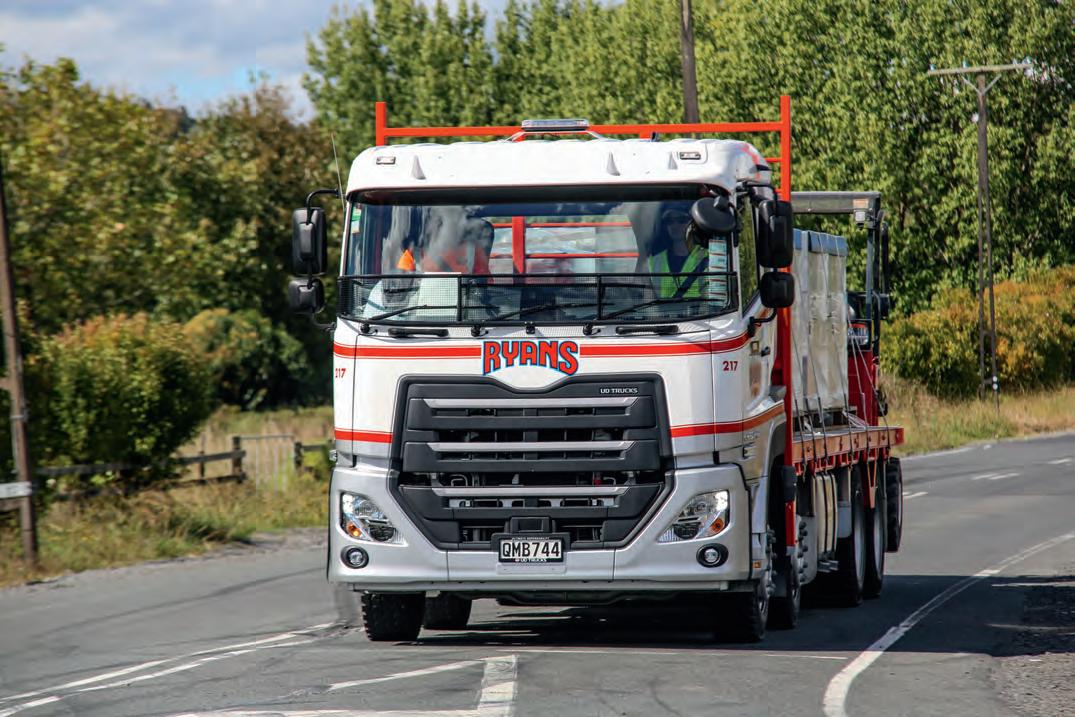
in an increasingly complicated operational environment.
“If we could run everything as a truck and trailer, life would be simpler and more efficient. But we’re addressing the challenges presented by building sites in the city, and finding solutions has become harder over time, with development of the city … in-fill housing, brownfields developments have made it more difficult.
“There’s also been a lack of, or loss of, knowledge – the merchant sales force who used to go out and do a site inspection on these new sites and might have been a builder or in transport or had some operational relationship … that’s faded away.
“The other problem is every site is different every day, so your hazards and challenges change throughout the build, and in that sense, we rely on builders who know what’s going on – some are very engaged and aware and give great facilitation, they invest in positive outcomes for their sites. But there are still those who sub out everything, and the subbies don’t care how it all happens. So, we then take on this duty of care in how we operate with the likes of traffic management, when really, it’s a site issue.
“We’re always operating in that grey area of managing the situation around what’s operationally feasible without jeopardising safety. All too often it comes down to getting a more suited truck, and that’s where having those options comes in. In places like Herne Bay, our guys can be onsite mucking around for three hours at a time.”
But Alan adds that there has been a lot of progress from all role players. “Twenty years ago, sites didn’t want to know, but many of the builders have come along. Worksafe’s engagements with sites have improved their understanding of compliance and safety. Auckland Transport and consents from council and the changes to the building code did change the way we engage.
“Overall, I think safety is managed well across the industry. As an occupation, you’re about 13 times more likely to die per day trucking. Construction is the same … Our guys are on a truck, and then on a building site – you don’t get much more dangerous for an operator out there on their own. Yes, we’re introducing risk to a site, but at the same time, we’re attending sites that are full of risk. So it really is about that shared responsibility.”
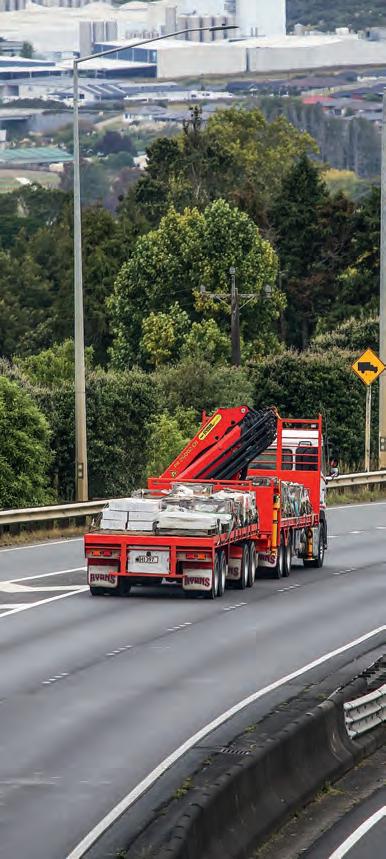 Truck No.217, a new 460hp unit, is one of two new Moffett-equipped UDs to join the fleet.
Truck No.217, a new 460hp unit, is one of two new Moffett-equipped UDs to join the fleet.
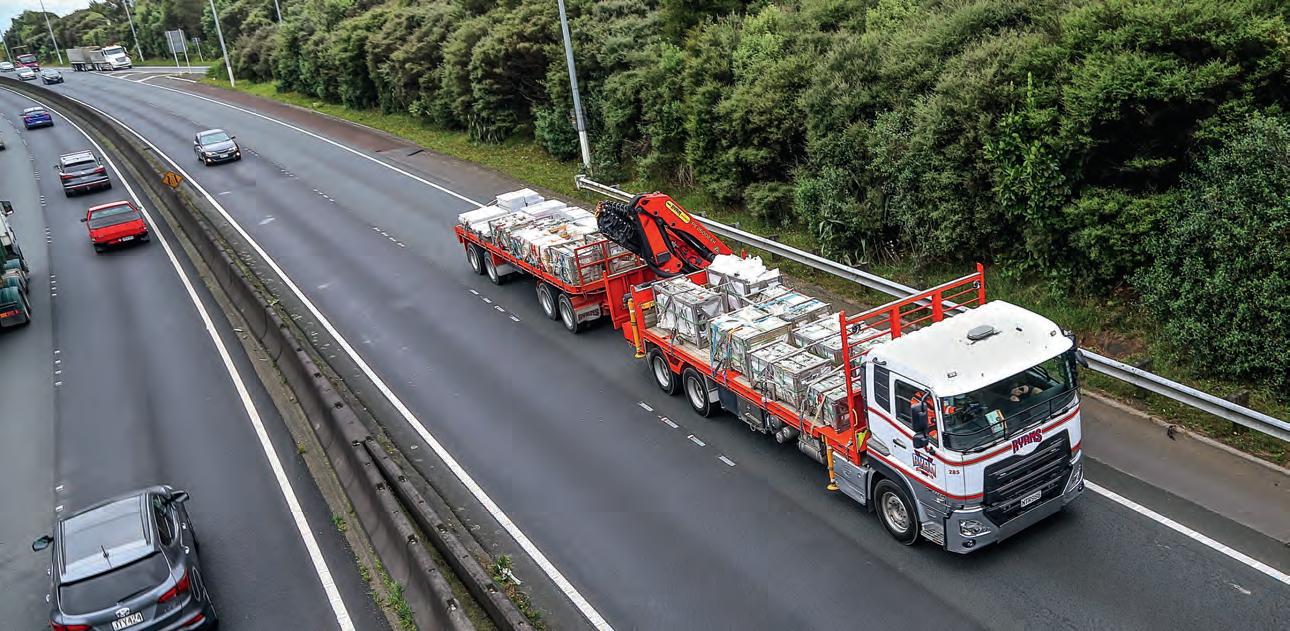
As one would expect of a metrobased haulier operating at city speeds and lighter weights, Tom Ryan Cartage has long had an association with Japanese trucks – historically Hino and, in more recent times, Isuzu.
“We had a good relationship with Hino and operated about 50 of them over the years. In time, we shifted to Isuzu. Their price points were similar for a long time but then Isuzu really came in aggressively. Their trucks were good for us. With the long decks
on the crane trucks, we could get a bit more on. But having run about 30 Isuzus over the years, we found some persistent issues that became a problem in our operation. It wasn’t solely down to those issues, but they were among the pushers for us to consider other options,” says Alan.
Given the laws of natural progression, one would assume that meant a step into a UD showroom, and today Tom Ryan runs 16 Quon units from the brand.
“The relationship with Marvin
Fynn [UD Trucks key account manager] has been good – and the others were good, too. But it’s just natural progression. At the moment, as those come up for replacement, the UDs are joining the fleet. Their price point was only a little higher, and they have performed very well out of the box, though we’re still relatively new in the relationship. While I focus on price and reliability, they offer a fair technological jump as well. For the drivers, it feels like a new adventure. The only gripe we’ve had moving to the UDs so far is
the lower clearance on approach angles, especially with the hiabs at construction sites. And that’s a small thing,” Alan says.
The oldest of the current UDs is a 2018 model that has covered 120,000km. “We have 20 years’ useful life from our trucks. If we see 1,000,000km on a truck after its 20-year life with us, it’s a big thing,” Alan says.
“We don’t do big Ks. On average, our trucks do 150km a day. Unlike most truckies who get paid for putting Ks on the clock, we get paid when not moving. We make our profit on
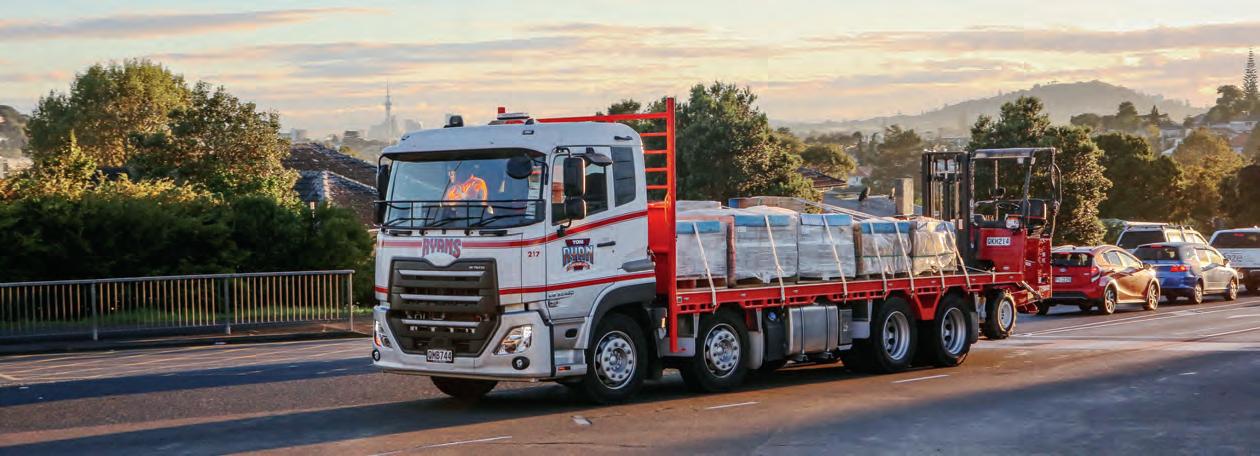

site loading and unloading. So, again, that’s why we shop in the band of the market we do. We’d love to buy all Volvos or Mercs, but they’re 50% more. Our capital investment isn’t in the trucks – I’m happy to put a $400,000 crane on a $150,000 truck, for example … If someone were paying me to, I’d spend $300,000 on a truck, sure, but fundamentally, we get paid for lifting capacity.”
The newest of the 16 UDs in the fleet are five of the latest Quon models enhanced for the 2024 model year. The big
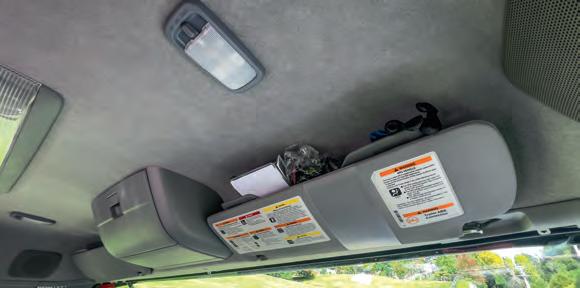
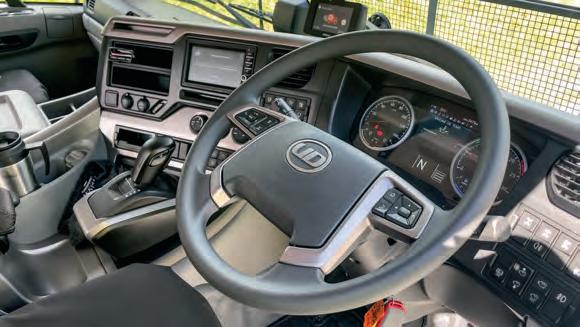


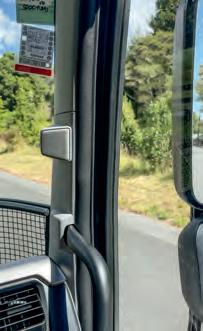
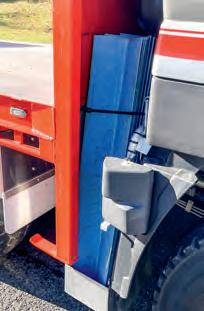
1) Overhead storage is just about adequate. 2) Overall, the cabin remains unchanged, but the modernised instrument cluster brings enhanced information to the driver. 3) We’ve commented on the Quon’s sea of cubbies dominating the centre of the cab before … Like it or loath it, there’s plenty to please those who abide by ‘a place for everything, and everything in its place’, including a cool box and heated/cooled cupholder. 4 & 5) Warning lights for the Smart Blind Spot Information System and Smart Lane Change Support are located discreetly on the A-pillars. 6) Radar units mounted to the front wheel guard. Seems a bit vulnerable …
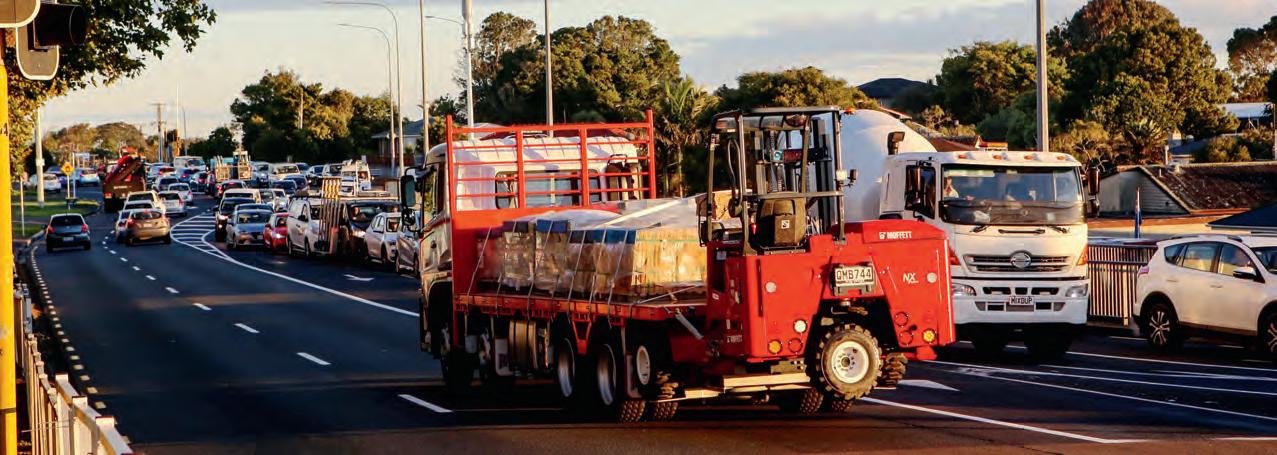
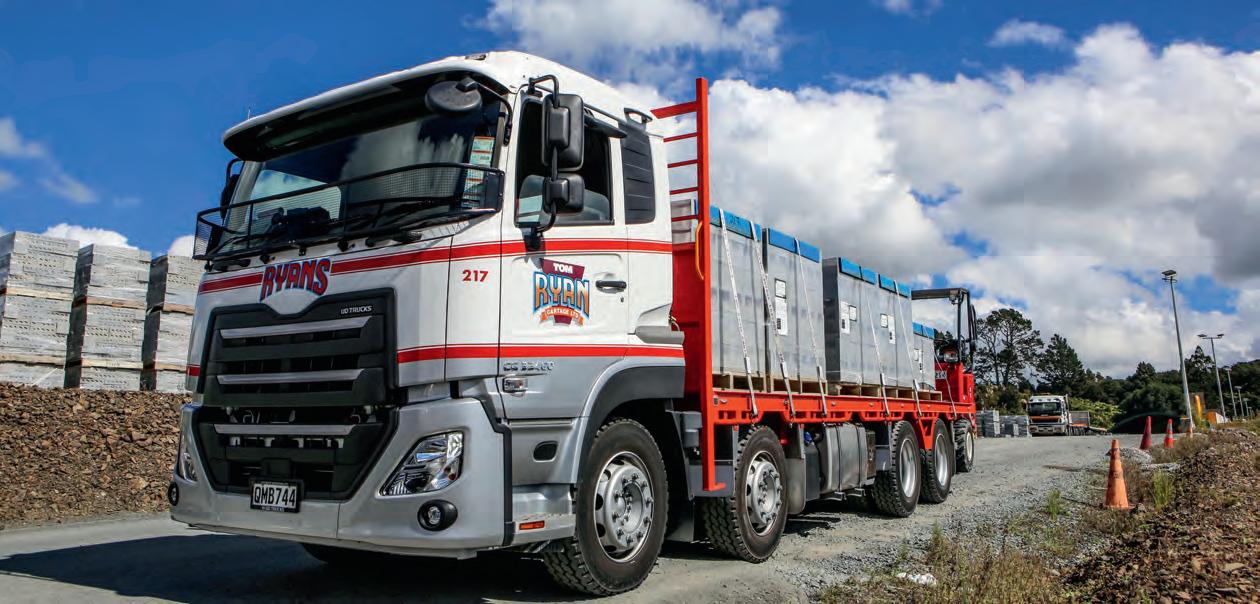
talking points are greater safety spec, better fuel efficiency from the GH11/ESCOT-VI powertrain, and a bump in outputs across the board. Given the unique opportunity to get up close to a range of these new models with the same operator, we lined up the new Quon CG 32 460 and CG 32 430, each in a different business area, to see what’s what.
Truck No.217 is one of the two new 8x4 flatdeck Moffett units. Almost as fresh out of the box as can be, it had only been on the road for three weeks and covered just 2400km when we jumped aboard with driver Shashi Singh and took to the wilderness of West Auckland.
We first meet Shashi at 8am on a cool autumn morning outside a domestic building site in Avondale, the first of his four deliveries for the morning. The truck’s carrying 10.5 tonnes of blocks, bricks, pavers and tiles to be distributed to building sites in Avondale and Massey, with a drop-off at Bunnings New Lynn in between. With the three-tonne Moffett M8 NX on its rear, Shashi’s UD is good for a 15-tonne payload, or about 12 pallets.
As we’d find in the course of meeting Shashi, and fellow drivers Ritesh Chand and Jin Chung, the company’s culture is clearly one that resonates with its staff. A consistent theme in the way the drivers describe their jobs is that they’re empowered
with the trust and autonomy to get on with it and get the job done properly. There’s a real sense of ownership. It’s clear in how Shashi operates, too.
His managers know that he’s good on the job, treats the gear as his own, and has an engaging manner with the customers, which comes as no surprise after more than a decade on the job – Shashi has been with Tom Ryan for 11 years and a master of the Moffett for 10, and boasts a 30-year driving career in total.
“Tom Ryan is only the second company I’ve worked for in New Zealand since I came here from Fiji in 2007. I don’t chop and change. Tom is a good lad, a good boss. We don’t get to see him much, but he knows every one of us,” he comments.

Shashi is pedantic about his work environment, coning-off the truck at all sides before lowering the Moffett, especially considering he’s forced to park on the other side of the road at this first drop. It’s a quick drop – only three pallets – but that doesn’t mean shortcuts are taken.
“Safety is a big thing. We’re out here doing this job on our own, on the road. Cars don’t stop for us and that makes it risky. We have to be very careful,” he comments.
The consistent variance in building sites also requires a different set of skills on the Moffett, compared to hiab or traditional forklift operators. “You need to know the technique for driving them,” Shashi comments.
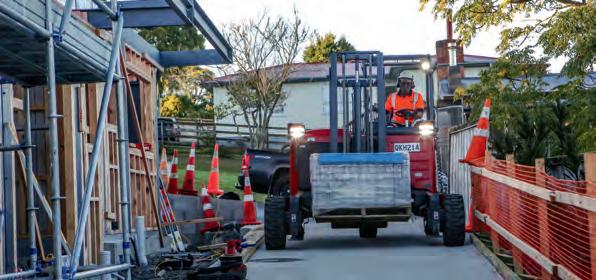 Loaded up and ready to head out at Firth Hunua Quarry.
Loaded up and ready to head out at Firth Hunua Quarry.
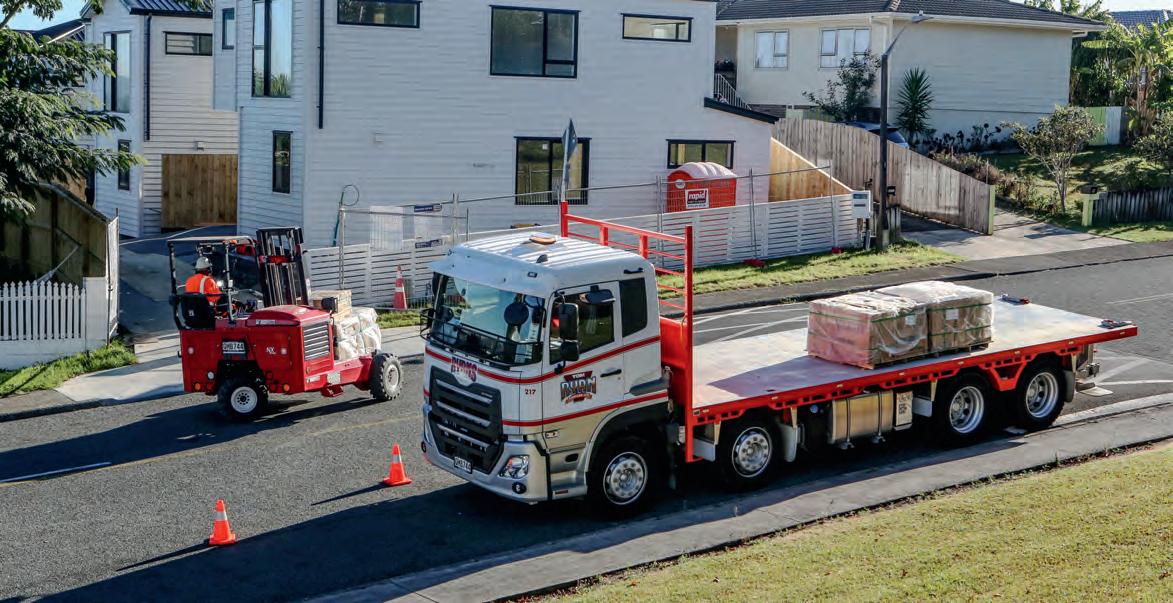
“They can be tricky in the wet, on mud and loose metal if you’re inexperienced. We need a forkhoist licence, but some companies require you to have additional certification to drive the Moffett. We do refreshers every few years.”
By the time Shashi makes his last drop for the morning in Massey, his next job comes through from despatch, and we head south to Firth’s Hunua Quarry to collect a full load of blocks and pavers. The drive down Auckland’s western motorways in an unladen truck is nothing to talk about, but it allows us to explore the Quon’s enhanced active safety features. These are all intended to detect and mitigate potential road hazards. As standard, the
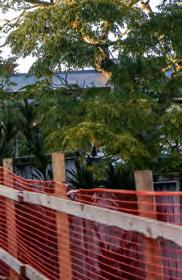
enhanced Quon features UD’s Smart Traffic Eye Brake, Smart Blind Spot Information System (BSIS) and Smart Lane Change Support (LCS) on both sides of the truck, Smart Traffic Eye Cruise, and, optional, the Driver Alert System that monitors for driver fatigue.
“It’s a nice and easy drive,” Shashi says as he talks me through the features. “The cruise control with distance control maintains the pace to the car ahead, great on the highway. But to be safe when I’m not using it, I’ve set a speed-limit warning on the GPS too,” he adds. “Overall, the safety systems are really helpful.”
Having become familiar with the truck’s sensitivities, Shashi creeps up a little closer to the car
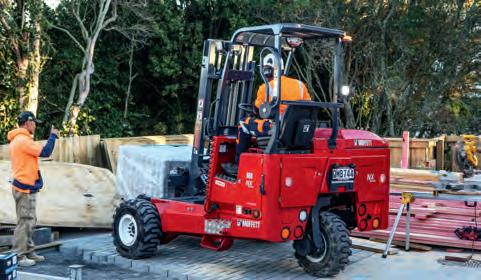

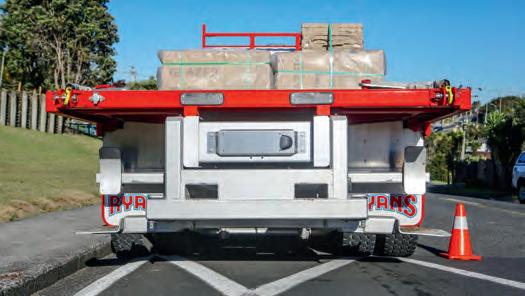
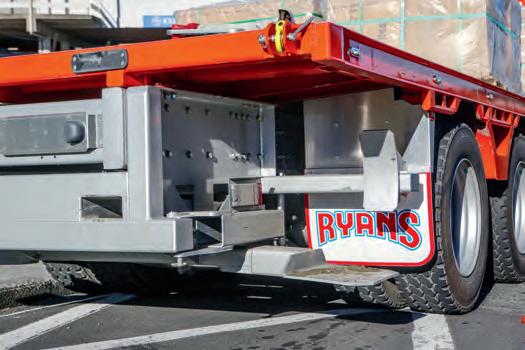
ahead to demonstrate the UD’s Smart Traffic Eye Brake system. A loud, rapid acoustic warning fills the cab, and a warning is flashed on the driver’s display. If Shashi had kept the accelerator pinned, the UD would’ve applied the brakes to avoid a collision.
He comments that the BSIS and LCS systems are incredibly helpful, especially when it comes to pedestrians and cyclists around the truck. If a vehicle alongside the truck activates the feature, the truck issues a double beep and the indicator light in the A-pillar flashes. Again, a warning is issued in the instrument cluster.
About an hour later, we’re pulling out of Firth onto Hunua Road, with Shashi bound for a drop in Whitford. The roads heading north up the eastern fringes of Auckland offer a good amount of variance to see how the revised GH11 at 338kW (460hp) performs. While the power of this top model remains unchanged, torque output has gone up by 50Nm to 2250Nm (1659lb/ft), and it also comes in 100rpm sooner, at an even 1000rpm, and is maintained to 1250rpm. It’s still coupled to the ESCOT-VI 12-speed AMT, but there’s a new high-strength clutch and flywheel now making the connection.
Accelerating from a junction, the CG 32 460 pulls off in fourth and skips to sixth, eighth and 10th at 1500rpm, shy of the 1700rpm power peak. Acceleration and shifts are smooth, and soon we’re up to open road speed, and the ESCOTVI selects 12th. Truck-only, at these weights, it’s easy going. Getting into the hills, it drops one ratio to maintain the pace.
“I like that the engine doesn’t race,” comments Shashi. “The previous truck was a 400hp Isuzu, and it had an 18-speed Roadranger, which I’ve only ever driven. This gets along perfectly on its own. I enjoy the higher power and I leave the gearbox to do its thing.”
Managing the pace is a fourstage engine brake, which is more than strong enough at

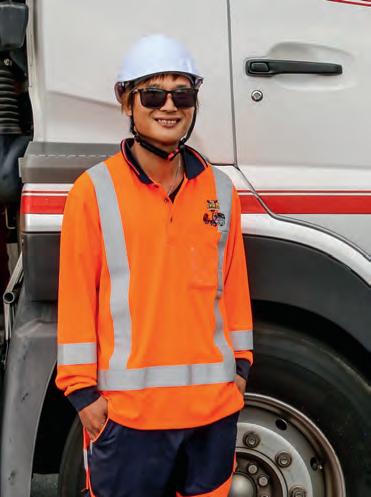
Trucks you can buy and sell, but the operators are the tricky ones. We have an ageing driver force but a pool of really good, seasoned drivers who come from an era where they were in the cab at five and trucking was well in their blood by 12. By 18, they were licenced and actively working and knew where to stand or how to throw a chain,” says general manager Alan Spilhaus as we discuss the industry’s current challenges.
“It’s a generational shift, let alone trucking’s lost a lot of its sex appeal. So much of the solution is getting good guys and hanging onto them. We’re a family business, and that’s always been part of our ethos … Tom Ryan started the business as one-man one-truck in 1979, and it still is Tom Ryan – just with a few more trucks! It is about being part of a family. Guys leave to chase the dollars, and they come back five or six years later, and I just say, ‘Knock on the door’.”
Like many larger operators, Tom Ryan Cartage has looked to the immigration market to
get men behind the wheel.
“Over the past 15 years or so, we’ve worked a lot with the accredited employer immigration scheme and had many good drivers come to us. We’ve had a lot of success with drivers out of Fiji, who come engaged in the type of work we do.”
That much was patently obvious in our time with Shashi, Ritesh and Jin. For his part, 53-year-old Shashi Singh got his start in the forests of Fiji, as a bulldozer and digger operator on logging sites.
“We had to go into the bush, cut the logs and bring them down to the sawmill. One day, my boss said, ‘You can drive trucks, so why not start taking the machinery into the forests?’ So that got me into transporting machinery and loading logs to bring out. I did all that for about 10 years, until one day in 2007, I saw a job vacancy in the Fiji Times newspaper for an Auckland roading contractor looking for a transporter driver. It was a good move. I came here alone, and the company helped me
bring the family over.”
With his time as a transporter operator, Shashi boasted all the tickets that would make him a perfect fit at Tom Ryan – bridge engineering, self-supervision, piloting, WTRC …
“I started with Tom Ryan as a hiab operator with some training and later got on a lowloader with an Ausa. They were looking for a good machinery driver to replace someone coming off one of the old Moffett units, so I trained with him, and I’ve been on it since.
“If the company looks after me, I look after them,” he comments.
Alan would add: “It’s difficult … We can offer the drivers being home every night, and in good times, there’s a regularity to the work. One-guy onetruck gives them a level of ownership and comfort.”
Also from Fiji, 41-year-old Ritesh Chand started driving on his family’s sugar cane farm. “My uncle used to drive tractors and I started learning how to drive them at age six or seven. Then I moved onto cars
Ritesh Chand, Jin Chung and Shashi Singh – two decades from youngest to oldest, almost two decades of loyal service to Tom Ryan Cartage.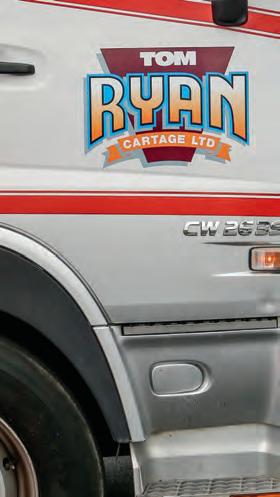
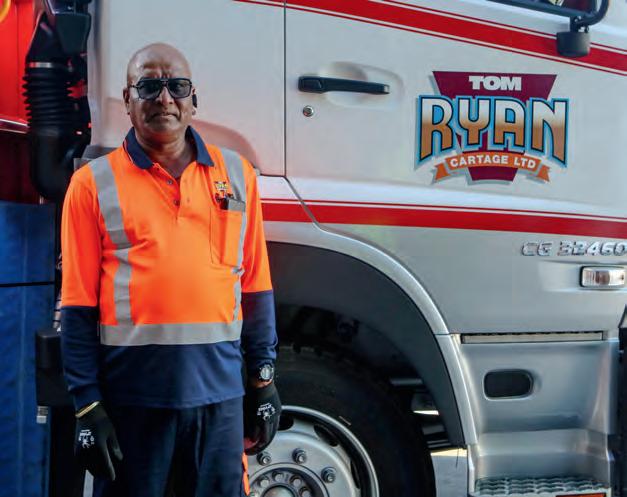
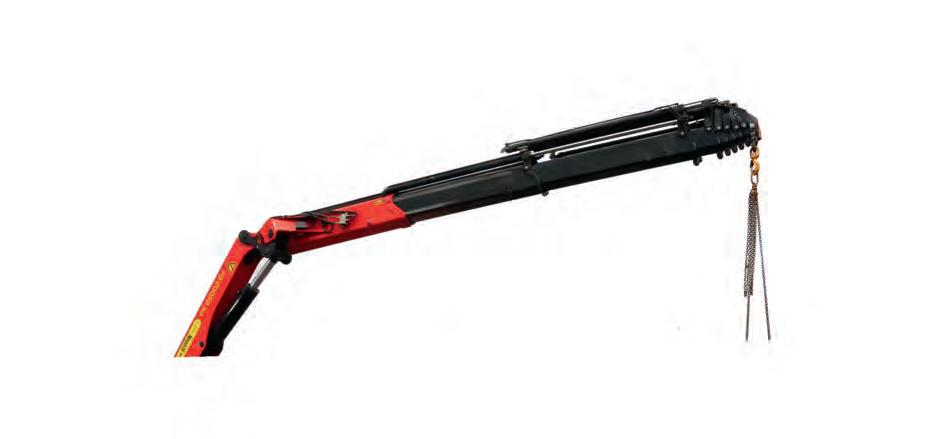
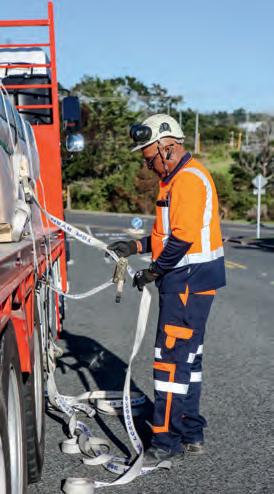
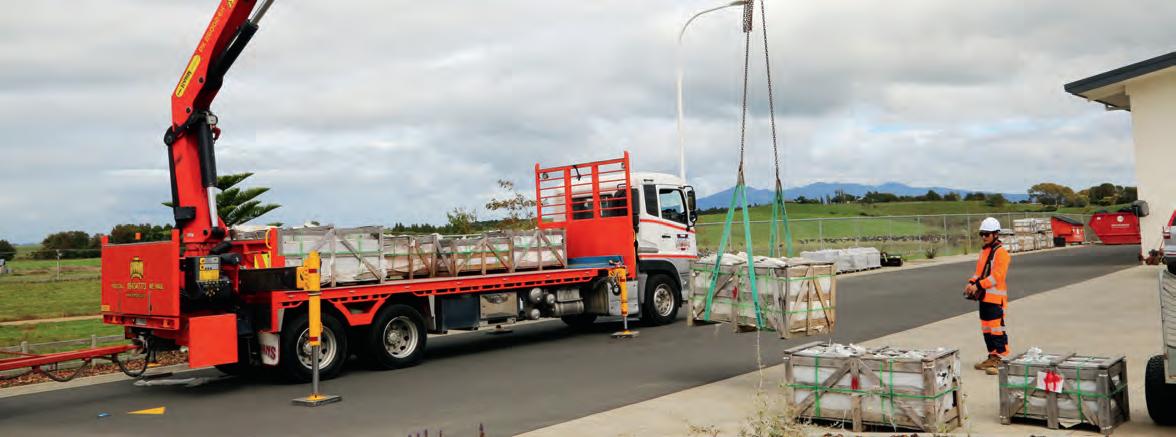
and trucks in the field, learning how to manoeuvre them and drive along slowly as the trucks were loaded in the fields. I got my licence and started driving my own sugar cane trucks. After school, I started driving a local bus, which I did for seven or eight years.”
Ritesh’s move to New Zealand came in 2009 when he first drove a tipper truck for a civil engineering company. In 2014, he dipped his toe into metro work with a move to Mainfreight, though it wasn’t quite his thing, and so the move to Tom Ryan in 2018.
Back to Alan: “We’ve looked at cadetship programmes and know of firms that have done it successfully … but it costs. Probably the biggest differences we’ve found is those who fall into trucking from a
different path have a different relationship with the job than those who land up in it via natural progression.
“Take crane operation; a lot of it is natural aptitude. You can learn it with a good teacher, but again, that’s part of the problem. There’s not much motivation for firms to invest in training when trucking has such low margins.”
To get a taste of this side of the business, we spent a morning with Jin Chung in his pre-enhancement Quon CW 26 390 6x4 with a Palfinger PK 26002 crane. At 32 years old, Jin is one of the youngest drivers in the team and also one of the newest, having joined Tom Ryan less than six months ago.
“I generally have been one of the youngest drivers wherever I’ve worked. I don’t know any others my age who drive; my
friends aren’t interested. One of my main goals is to be able to jump into any vehicle and be able to drive it.”
Born in Vietnam and having lived in New Zealand since age nine, Jin studied IT but realised it wasn’t for him after two years. So, 10 years ago, he went driving. “Trucking wasn’t a thing for me as a kid. I wanted to do programming. I got into trucking and loved it. I’ve been on hiabs for five years now.”
Jin is smooth and methodical with his crane operation. “The hiab thing … it was a skill that came up unexpectedly. Forty hours training to get my ticket and almost eight months to be good and do it by feel … Yes, I had a little mentoring. I listened to good advice when it was given to me, and quickly worked out what works. Tom
Ryan gave me my truck within two days and let me get on with it. The other drivers have been good too. It’s hard to find a good company.”
Alan concludes: “We’ve had some good, solid guys come to us from challenging backgrounds. And a decade later, you look back at the hard work they’ve put in to change their lives overall. I think they’re partly a solution to solving the driver shortage – income and a sense of purpose solves many problems.
“We [the industry] should continue to work on these sorts of things to solve our own problems. The crunch on skills is a serious problem, especially if Aussie can afford to pay more. We have to find ways to compete.”
Shashi frees the load for delivery.
these weights, even on the descents that require the most care.
Having experienced the construction-service side of the business (read more in Right People, Right Company, page 28), we used the opportunity to dip into the general freight side of Tom Ryan Cartage and experience one of the new CG 32 430 units on gas-bottle duty. The company has had a longstanding 12-year relationship with Coregas and operates 10 Coregasbranded trucks.
Ritesh Chand is the driver of No.552, which has just passed the 11,000km mark,

covering Hamilton, Cambridge, Morrinsville, Te Awamutu and Te Kuiti, with the odd transfer to Tauranga. Ritesh is another seasoned employee, having celebrated seven years with the company, all that time on a Coregas Isuzu in which he covered 300,000km.
Like Shashi, Ritesh fully buys into the Tom Ryan culture. “I started at Tom Ryan and straight away went for a week’s training. Management trusts us and looks after us – they don’t bother us but sort out things on the spot if there are problems. Alan is good. He understands and has feeling for his drivers. But he doesn’t do bullshit; he needs us to be honest.
“I love this job. It can be physical, but I don’t mind. On a busy day, I can do 16 deliveries between 5am and 7pm.
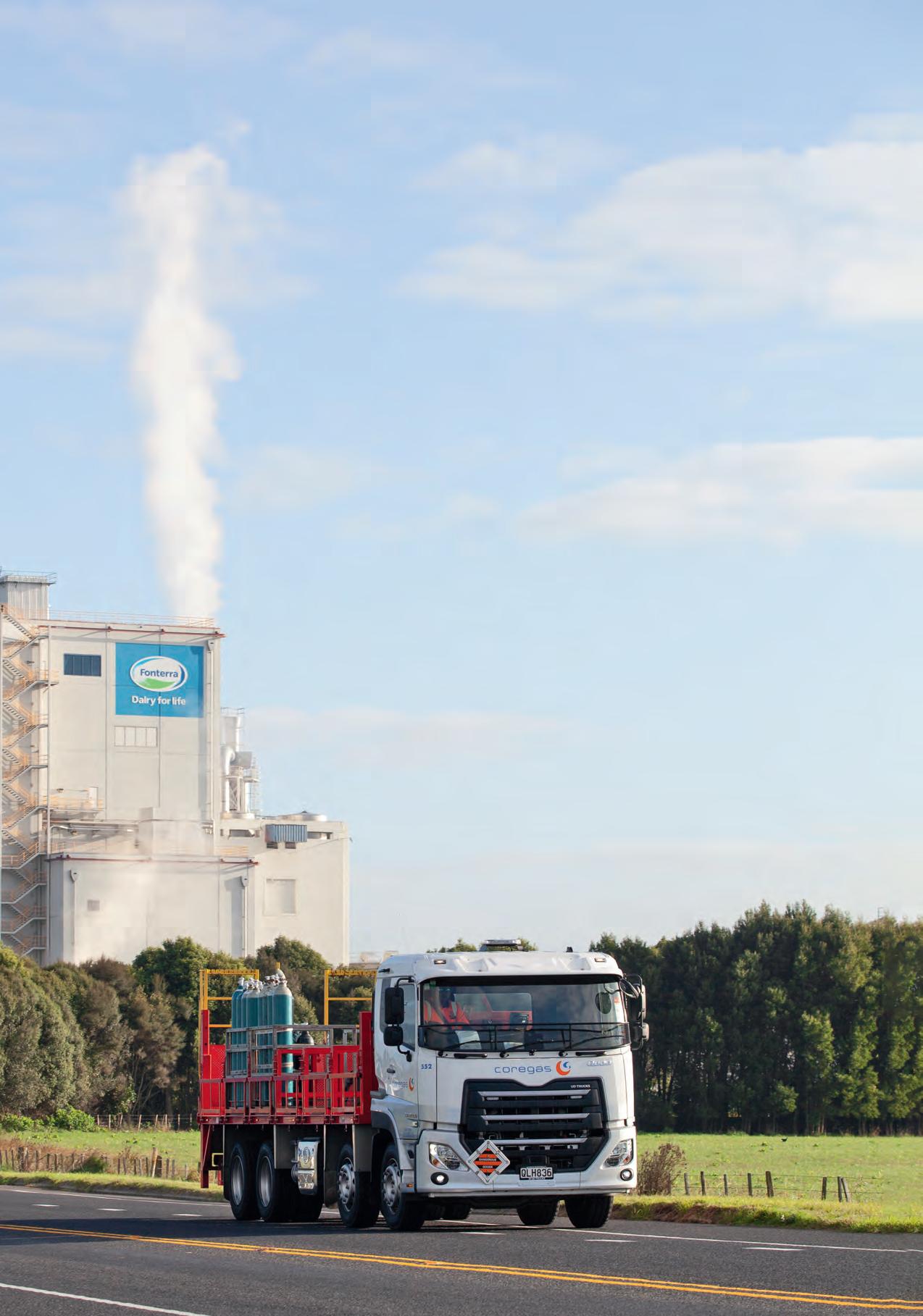
That’s more than 170 bottles, depending on size. A full load of bottles is around 13.5 tonnes,” he says.
Gas bottle trucks are simple but nifty units. The custom deck by Hamilton-based Dreambooster Engineering (new to the scene but good at what they do, says Alan) offers 10 locations for steel pallets, which are locked in place when the drop-down sides are raised. An elevated walkway down the centre of the deck keeps everything level and allows Ritesh to access the bottles he needs easily. An electric Dhollandia DH-VO 15 tail lift provides smooth, silent, easy lifting of the bottles during deliveries.
“I’m happy to load my truck, so I can know the weight and balance. The boys at Coregas
Row above: Bottles on, bottles off. The gas-bottle trucks are simple but nifty. Dhollandia electric tail lift and raised walkway between the steel pallets makes moving them easy.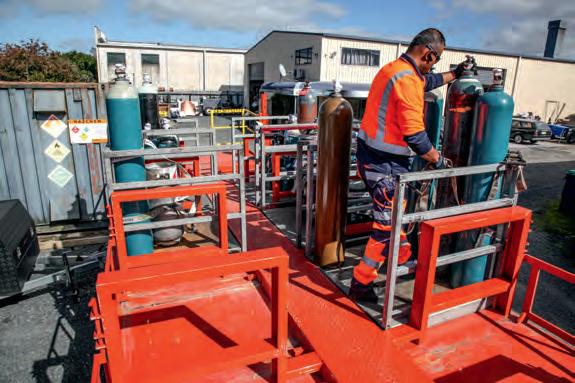

strap the bottles to the steel pallets, and I forklift them on,” Ritesh comments. At site, the truck’s mobile scanner allows him to easily log each bottle as he moves from job to job. “I always do my best to finish a run so nothing hangs over to the next day. But some jobs can take up to 45 minutes if I have to do pressure testing.”
It’s much easier going today; we only have 68 bottles. When we meet up with Ritesh, he has already made his first drop at Fonterra’s Te Rapa facility. After a couple more drops in the area, it’s time to head for Morrinsville.
“Alan asked me if I wanted the UD or another Isuzu. I said I’ll try the UD,” Ritesh explains as we make for the Hamilton Bypass. “I like it. It’s only 430hp, but it’s comfortable and fine on the highway with a full load.”
In the enhanced Quon range, the GH11 in 430hp guise offers up 7kW (10hp) more power than its 420hp predecessor, as well as an additional 100Nm torque. Peak outputs are now 316kW (430hp) at 1600rpm and 2000Nm (1475lb/ft) from 950 to 1450rpm.
In achieving higher outputs from the GH11, UD has redesigned and improved the cylinder block, cylinder head, injection system, pistons, crankshaft, connecting rods, lubrication system and auxiliary drive. The results are not only improved outputs, but a claimed 2.5% improvement in fuel efficiency. Indeed, Ritesh’s CG 32 430 is returning 2.8kpl, slightly better than Shashi’s fresh-outthe-box CG 32 460 at 2.5kpl.
Unfortunately, as Ritesh is running very light, the opportunity isn’t quite there to
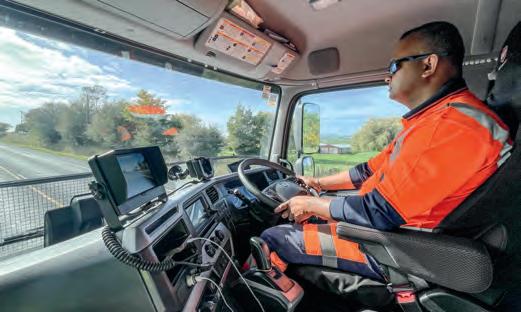
assess the 430’s performance. Regardless, there’s no doubting the engine and gearbox combo is as competent as it is in the 460, and the exhaust brake is well overqualified for the Coregas life. “I only use it up to stage three; the full braking force is too strong in this application,” says Ritesh.
In an application such as a gas-bottle truck, one can never have too much safety. Ritesh is as
complimentary as Shashi about the enhanced Quon’s active safety systems. “It’s good to have all the new tech and safety … that these trucks are at the same level as modern cars. I find it all quite handy. People complain about these types of systems being too sensitive, but it all depends on how you drive,” he comments.
Both the lane departure warning and Smart Traffic Eye
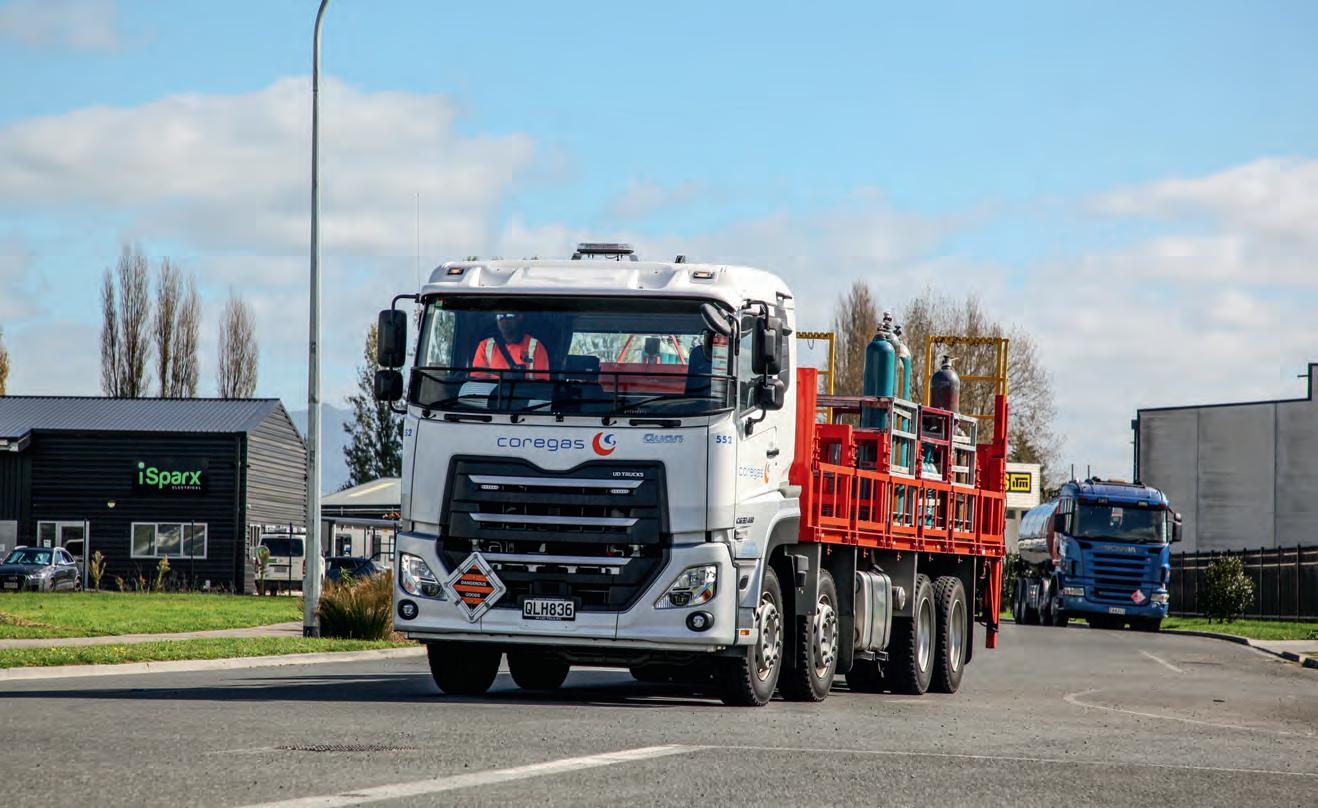 Ritesh crosses the bright and sunny Waikato.
Ritesh crosses the bright and sunny Waikato.
can be disengaged (the latter only temporarily), and as we traverse rural Waikato’s narrower roads, the lane departure rarely issues its soft rapid beep warning.
Just last month, UD celebrated 20 years and two generations of the Quon. The second generation, all-new Quon, launched in 2017 and so has been with us for a while. With this latest enhancement to the range, UD has improved the Quon in the areas it matters most …
There’s little changed in the interior. Just about the only noticeable difference is the new five-inch colour LCD driver information display. Build quality is top drawer, with more than enough space and storage. Comfort and ride quality remain very good, and refinement levels are in the Euro-truck neighbourhood – both the 430 and 460 returned an average
69dB interior noise reading.
Importantly, though, UD is continuing to deliver where it matters most – on the job.
“So far, UD is hitting the mark and knows when to say a truck is or isn’t suited to a particular application. We put a lot of trust in them … we’re specialists in moving freight, not truck specialists. We want trucks that go from A to B consistently and reliably, with driver comfort and safety,” Alan comments.
The last time we featured a Quon on the cover was March 2022, a pre-enhancement CG 32 460 belonging to Mt Maunganuibased McLeod Hiabs, a company also big on cultivating a positive culture. After a few days in the company of the team at Tom Ryan Cartage, we can’t help but think the Quon is the type of truck that easily finds a home among companies that value good culture.
That’s not to take away anything from other brands or operators, but can it be just coincidence?
Tare: 430 – 11,580kg / 460 – 14,230kg (load certs.)
GVM: 32,000kg
GCM: 430 – 55,000kg / 460 – 60,000kg
Wheelbase: 5885mm
Engine: 430 – UD GH11TC / 460 – UD GH11TD
Capacity: 10.8L
Power: 316kW (430hp) at 1600rpm / 338kW (460hp) at 1700rpm
Torque: 2000Nm (1475lb/ft) at 950–1450rpm / 2250Nm (1659lb/ft) at 1000–1200rpm
Emissions: pPNLT/Japan2016 – Euro-6 equivalent
Transmission: UD ESCOT-VI AT02612F AMT
Chassis: High-tensile carbon steel. 300mm x 90mm x 8mm
Front axle: Reverse Elliot I-Beam
Front-axle rating: 14,200kg
Front suspension: Parabolic leaf spring with shock absorbers
Rear axle: Single reduction, hypoid gear, cross locks. 4.13:1
Rear-axle rating: 20,000kg
Rear suspension: Eight-bag electronic controlled air suspension
Brakes: Disk. ABS with EBS
Auxiliary braking: Four-stage exhaust plus engine compression brake
Additional safety: Passive – Side door beams, front underrun protection system (FUPS), SRS driver airbag. Driver’s side seat belt with pre-tensioner. Steering wheel and column with impact absorption. Active – Smart Traffic Eye Brake System, Traffic Eye Cruise Control with auto stop and Driver Initiate Go, lane departure warning system, electronic stability control, automatic hill start assist, lane change support, blind spot information system
Productivity: ECO mode, ESCOT roll, acceleration limiter, soft cruise control, Nenpi coach, idle shutdown
Fuel / DEF: 400L / 50L
Thanks to Alan Spilhaus and the team at Tom Ryan Cartage for being so accommodating and going out of your way to get us into three trucks for this feature, and for sharing your insights into your operation and just what it takes to cultivate a good culture.
Thanks to Shashi Singh, Ritesh Chand and Jin Chung for having us along, telling us your stories and showing us what you do.
Thanks to Marvin Fynn for providing us the details on the enhanced Quon range and to the team at Sime Darby Motors for your ongoing support of our publication.
Wheels / Tyres: 8.25in x 22.5in / 275/70 R22.5
Electrical: 24V
Cab exterior: Four-bag air-suspended cab with four dual-acting shock absorbers and dual automatic height-control valves. Heated and electrically operated main mirrors. LED low-beam headlamps, LED daytime running lights
Cab interior: Air-suspended driver seat. Remote central locking with immobiliser. Five-inch colour driver information display. Fully automatic climate control. 6.5in touchscreen infotainment with Bluetooth and USB input, wifi-enabled, built-in gyro, GPS, four camera inputs, hardwire reverse camera input with CAN interface
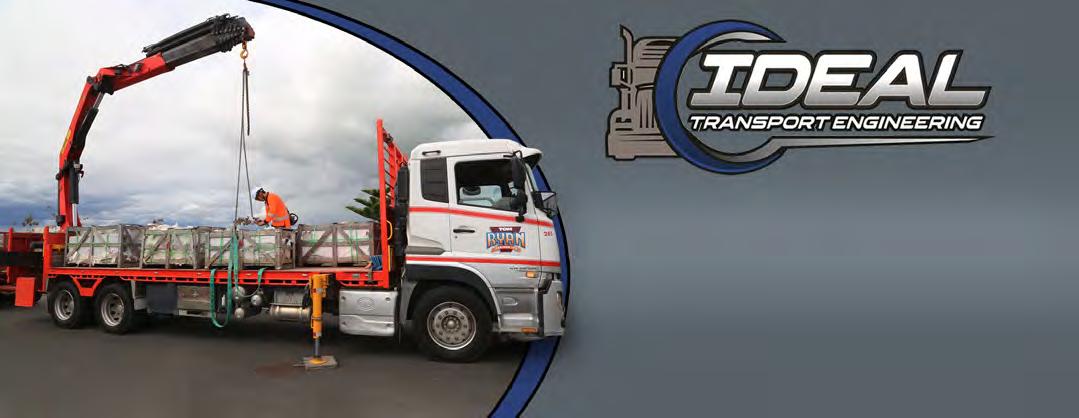
Proudly supporting Tom Ryan Cartage Ltd and New Zealand Trucking Media. 10 Nelson Street, Pukekohe, New Zealand P: 022 658 6194 | info@idealservices.co.nz
Scan below
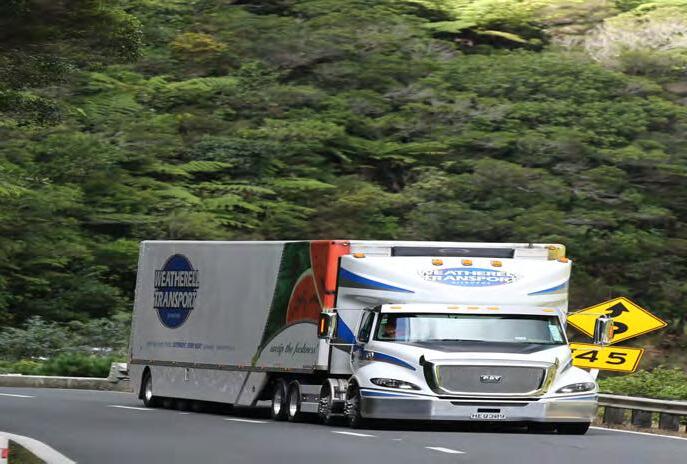
Every cover truck holds a special place in the history of New Zealand Trucking magazine. We love to see where their road has taken them.
HEQ309 was one of two Weatherells CT630s written off in accidents. Steve Weatherell reckons the vehicle had covered about 900,000km running produce from Gisborne to Auckland.
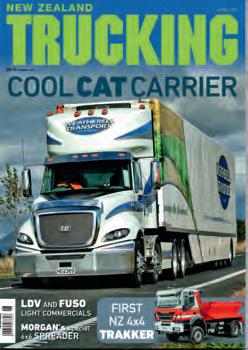
and it’s been hard to get replacements with the change of ownership at Fairfax. But they have been bloody brilliant over 10 years. Most still have the original fridge units.”
HEQ309 was paired with an innovative Fairfax quad-fridge unit, vacuum-formed in one piece using a patented process that bonded high-strength structural foam insulation to the inner and outer skins. The 15.65m, 22-tonne trailer also caught attention with its side air skirts exposing only the rear-steer axle.
“We didn’t get the fuel efficiency we were hoping for with the C15s. We were hoping to do the same or better as the T404s at the time because of their shape and the work that went into the aero of the trailer. They ended up averaging 2kpl,” says Steve.
HEQ309’s innovative Fairfax semi is still going strong, says Steve. “We built 10 of them. Bit by bit, the fairings have fallen apart,
• Basic original spec: Cat ACERT C15 at 410kW (550hp), Eaton RTLO-20918B 18-speed Roadranger, Meritor RT46-160 at 3.9:1.
• What we said in 2014: “The tractor’s low-set sleek appearance is somewhat deceptive for what is every inch a heavy-duty highway unit.”
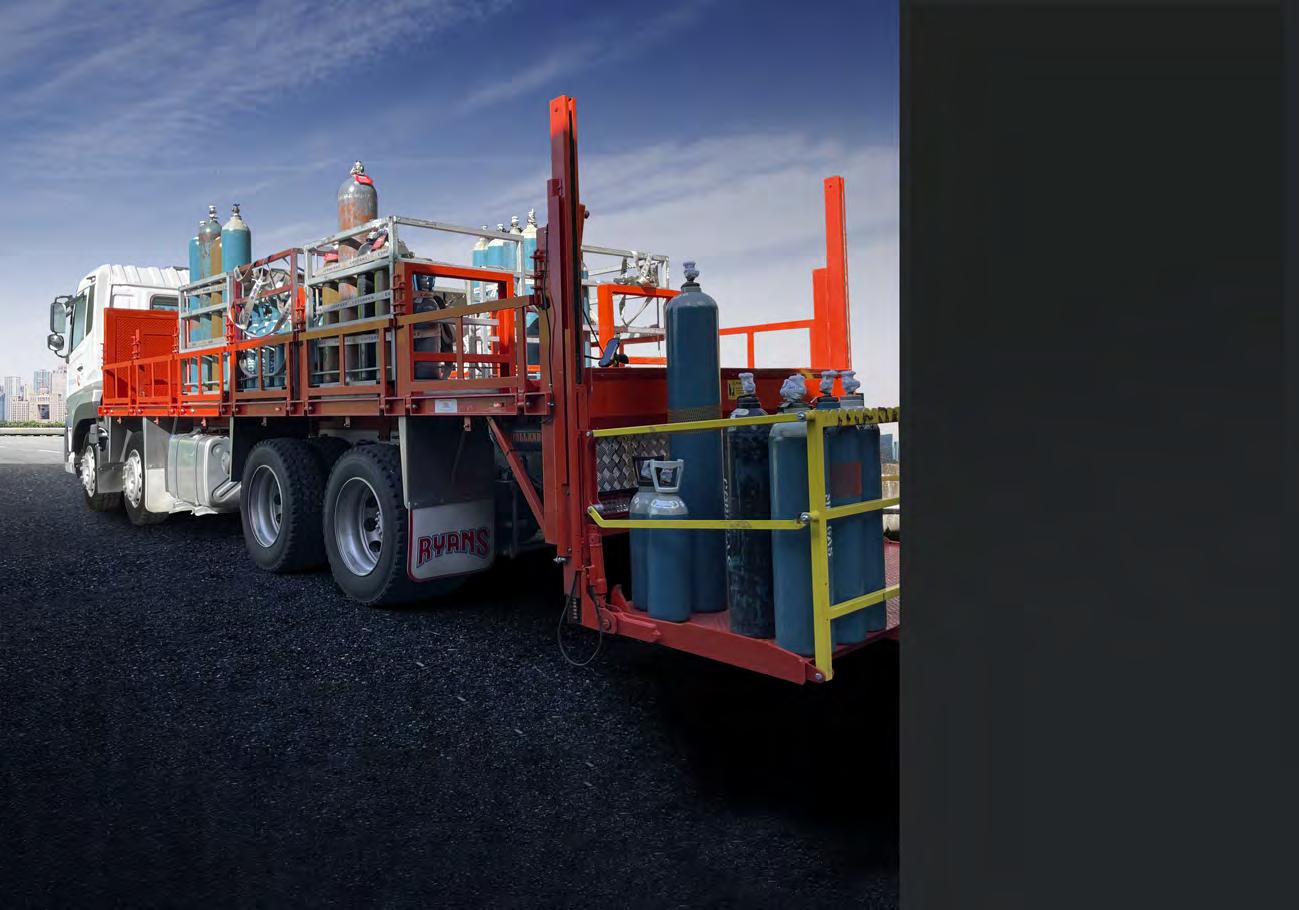
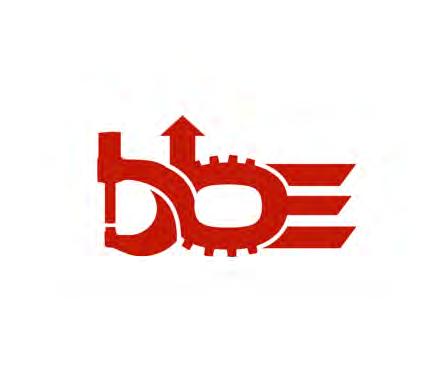
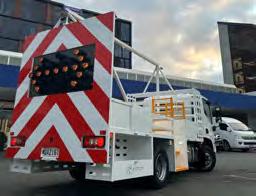

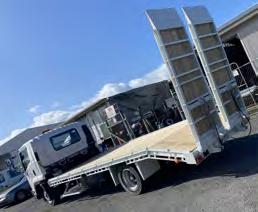
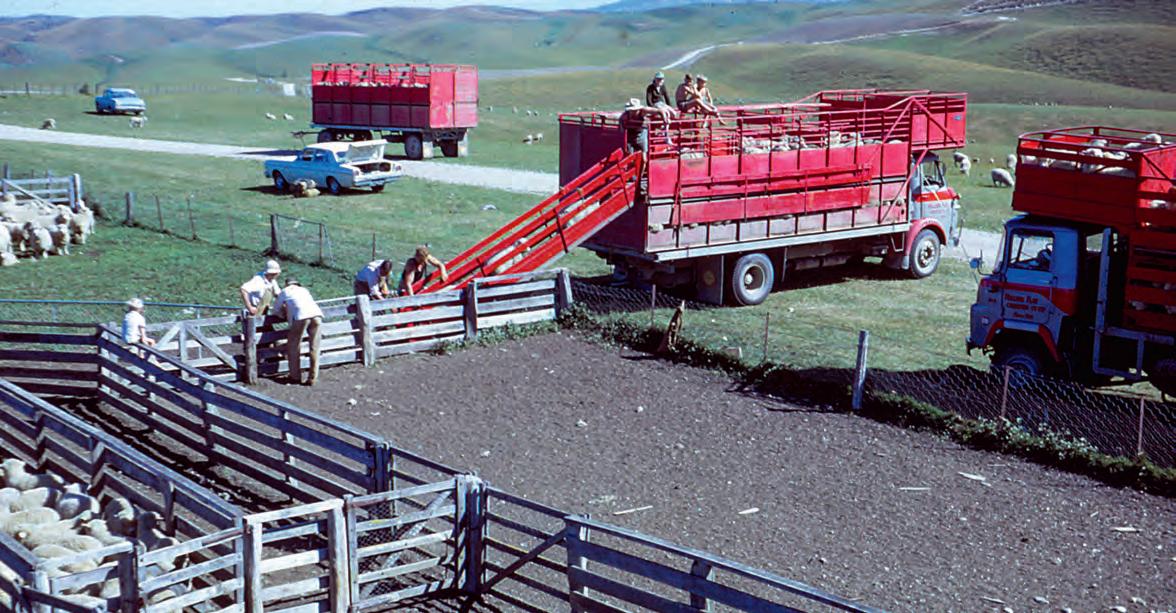
The Millers Flat Carrying Company was a legendary Central Otago trucking institution. We chronicle the company’s 31-year history.
Millers Flat is the first town in Central Otago as you leave coastal Otago on SH8. Entering the town, you are greeted by a familiar brick pub, and as hard as it is to go past it, you have to turn right to get into the heart of the town itself. In the process, you cross one of the country’s best bridges, one that Millers Flat Carrying Co trucks crossed many times during the ownership of Roy Tosh and Forbes Knight from 1954 to 1985. Forbes and Roy were working at Clutha Carrying when their

aspirations to own their trucks started gathering steam. Forbes had done time in the army as a driver and worked on farms and Roy had also come off farms, so neither was a stranger to hard work. Forbes recalls unloading bagged super at nearby Carterhope when at Clutha Carrying: “Two hundred tons of it, and 12 bags to the ton,” he says. That is about 84kg per bag, so no wonder he ranted somewhat. But they got on with it – as you did.
The men became aware of a three-truck business coming up for sale over in Millers Flat.
They gathered finance through family and, in 1954, bought L Brady Carrier. Forbes was 22 years old and Roy somewhat older. The business consisted of the depot and three Ford V8s, with work consistent with most rural carriers of the day: livestock, fertiliser, coal and whatever else could fit on the back of a relatively small four-wheel truck.
The trucks weren’t great. In fact, they were “hopeless”, according to Forbes. They constantly blew diffs and overheated regularly. It is a hilly area, though, and the trucks were likely pushing their limitations every time they drove out the gate.
New diffs weren’t cheap but Syd Brenssell, a transport operator over at Edievale, suggested Fordson tractor diffs
as a cheaper replacement, and that worked.
The company came with a licence to cover all of Tuapeka County through to Burnside in Dunedin, which was handy as there was livestock processing in Burnside. Some of the work was gravelling roads for the county, giving them quite a range.
But, like all small towns, the railway line running through it led to the restriction of transport against rail; a measly 30 miles (48km) but later increased to 40 miles (64km). From Millers Flat, it was the Hercules Line, which ran from Clarkesville to Hercules Flat just shy of nearby Roxburgh. It would eventually close in 1968.
There wasn’t much in the way of
Photos: Millers Flat collection and as credited

1) A young Roy Tosh with Commer No.5. Photo: Tosh family collection. 2) The three original, troublesome Ford V8s still to have signwriting applied. Photo: Roy Tosh. 3) A Commer driven by Roy Tosh with a healthy load of wool. His son Ewan stands on top. Photo: Roy Tosh. 4) Roy loading apples at Fiveash’s orchard. Photo: Fiveash family collection. 5) Donald Gilmour in front of his Fuso with Fiona Tosh (Roy’s daughter) and Donald’s two sons. Photo Roy Tosh.
livestock back in the 1950s. Most of the land was grazed by rabbits and farms were still being broken in. Two of the Fords would spend time carting sand for the Roxburgh hydro project under contract for Fulton Hogan. Due to their constant issues, the Fords were all replaced with Commers and one of the first jobs for the new trucks was to cart away the working men’s huts from the Roxburgh hydro. The Commers were better, but like the Fords, they did more than they were designed to do. Gardner Motors in Dunedin supplied the first models and VTR Motors in Invercargill, the later ones. Roy and Forbes both drove, and Roy would oversee most of the company’s daily operations. The work was mostly manual and very hard. Take a look at old photos of truck drivers back in the 1950s, 1960s and 1970s, and you can tell it was physical work. The Commers were doing well and would become the company’s backbone through the 1960s and into the



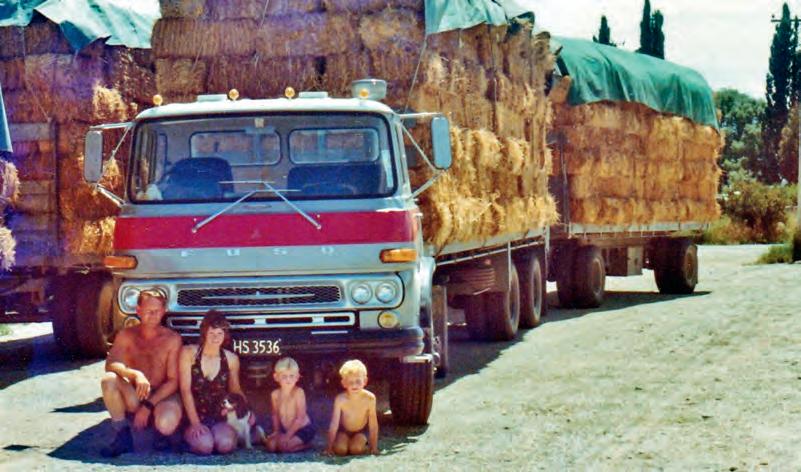

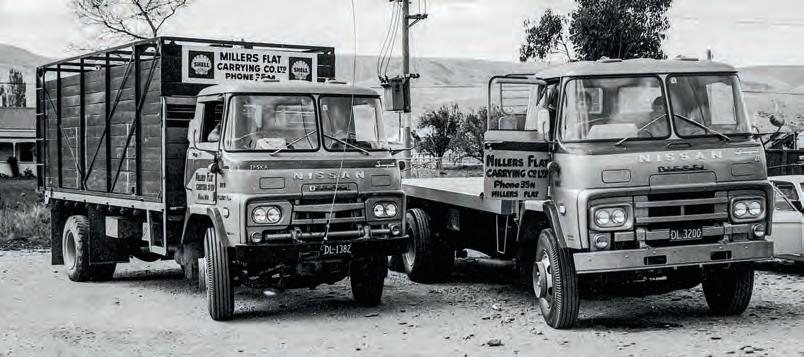
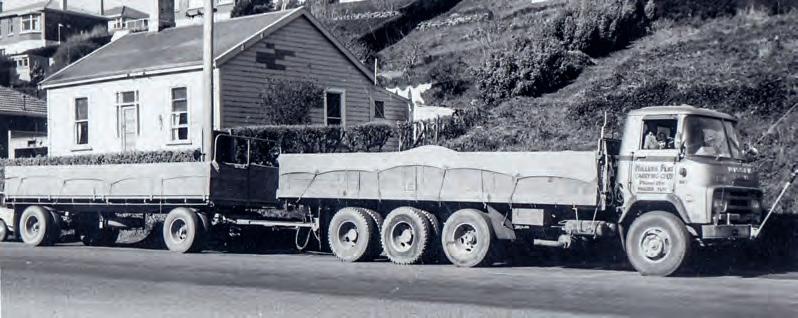
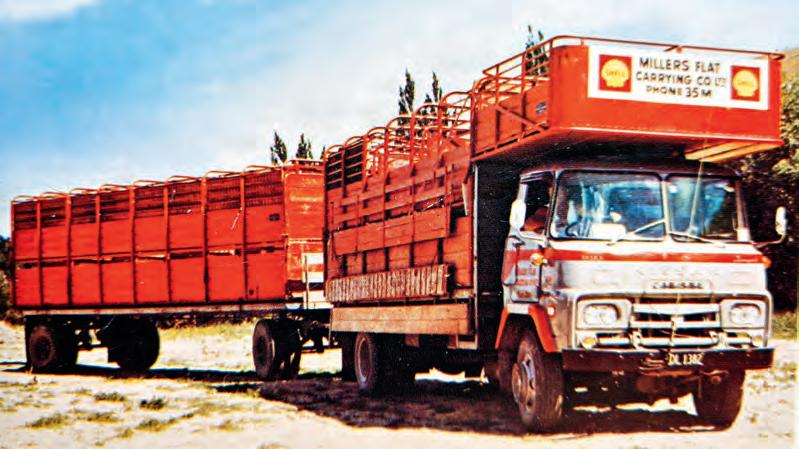
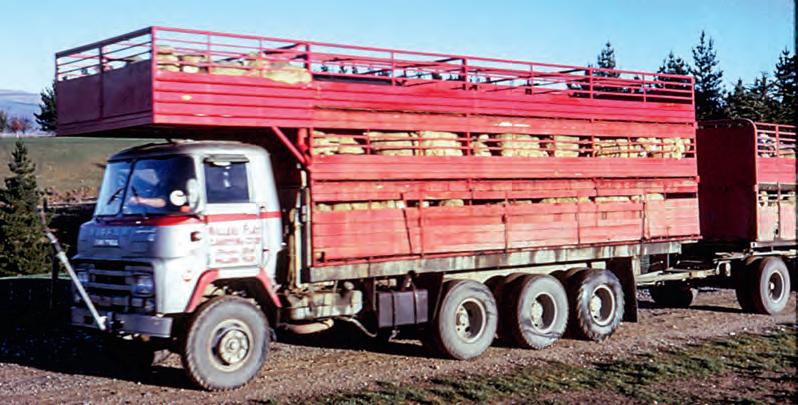
1) The new Rhino beside its older little brother. Photo: Melhop collection. 2) The Nissan Rhino parked in Caversham, Dunedin. Photo: Unknown. 3) A pic taken from a Nissan Diesel ad, the Taska kitted up with period cabover pen livestock crates and two-axle trailer. 4) The Rhino carting lambs away after weaning at Avenel Station. Photo: Jack Garden.
mid-1970s. Most of them would eventually pull a trailer.
Donald Gilmour was to become one of the senior drivers for Millers Flat Carrying. He was also the company mechanic, but his forté was engineering. He built some lovely cattle boxes for the company. Donald was working at the Millers Flat lucerne company, driving a GMC. It would cart raw lucerne into the factory for processing into powder and pellets. When the factory closed down, the machinery was trucked on the back of Millers Flat Commers to a new home in Hinds, where it is still in use today. Donald went to the Carrying Company and onto one of the Commers. He would go onto a petrol-powered tractor unit pulling a semi with another single-axle trailer behind that. This Commer would later be replaced with a diesel version. Donald was said to be the ultimate driver and could back an A-train combination effortlessly without a locking pin. Plenty of drivers would come and go over the years, but Forbes believed in employing local drivers when possible.
Colin South, George Beel, Ray Kerse, Merv Hume and Jimmy Adams from Tulloch Transport fame also did time at Millers Flat Carrying.
An unemployed Lenny Davis rocked up on a post bus and slept on the bench outside the local shop before going down to inquire about a job – probably after finishing at Hydro Haulage after the completion of the dam project. Plenty of casual work was available during the summertime, especially when there was hay to be made.
5) Commer No.14 with the company’s first tipping trailer.
Photo: Charlie Skevington.
6) Commer TS3 No.4 with its two trailers. Photo: Jack Garden.
7) No.1 Commer TS3 sower.
Originally a tractor unit, it was replaced by No.4, which also became a sower when it was replaced by the Fuso. Photo: Rusty Wright.
Along with the rural sector work, carting fruit was also an income stream. Central Otago is well known for its orchards, which start about Millers Flat and continue through to Cromwell. The good climate and irrigation from the nearby Clutha River make conditions ideal for growing. Most fruit was trucked to Ettrick, where the NZ Apple and Pear Board had its cool stores, and also to a cooperative pack house next door. From there, it would be loaded onto a train and taken to Dunedin. In 1968, the Apple and Pear Board wanted to truck fruit directly from the cool stores in Ettrick to Dunedin. Forbes and Roy had trucks carting locally into the cool stores, giving them a chance to get into this venture. They decided to trial a new truck and trailer for this work. The big issue was the 40-mile restriction against the rail. They couldn’t cart the fruit when the train was already there. Forbes requested that the Apple and Pear Board sort this or there would be no point in the trial taking place. With that, they contacted the minister for transport, who happened to be Peter (JB) Gordon, and asked if it was possible to lift the restriction. It coincided with government plans to shut the Hercules Flat line, so everything fell into place. This work saw a departure from the Commer brand. Forbes and Roy took a punt with a new 4x2 Nissan Diesel Taska, boasting 170hp (127kW), and trailer to trial the fruit cartage. It was the first of its type assembled in New Zealand and had done the rounds as a demonstrator. The work literally proved fruitless
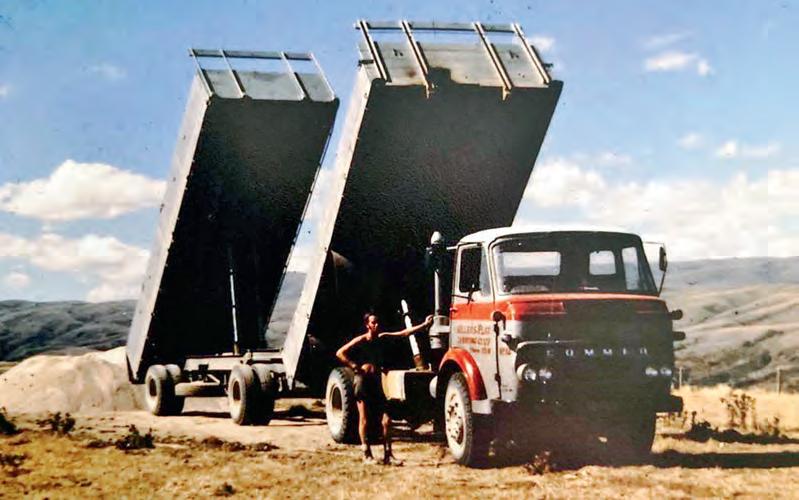
as Dick Holgate, who was also going for the work, won the contract. The rest you could say on that front was history – the pink Volvos of Holgate and Anderson would become synonymous with carting fruit for the next three decades.
On a side note, Dick Holgate was also working at Clutha Carrying and left around the same time as Roy and Forbes. Dick bought Lauder Transport in Ōmakau.
The fruit cartage was an opportunity lost for Millers Flat Carrying, but the Nissan was to remain in the fleet. UD shouted Forbes a trip to Japan to have a look at another Nissan – this time, its big brother, a 6x4 Rhino. Forbes and Roy bought that as well.
Forbes’ thoughts on the Taska can’t really be expressed in a G-rated magazine. It would overheat often and crack heads traversing all the hills around this neck of the woods. The new boy on the block wasn’t cutting it with its British stablemates, so the boffins at Nissan Japan sent engineers over to evaluate and troubleshoot its woes. As it was the first in New Zealand, it was good to be seen to be backing their product. However, they were somewhat taken aback when they saw what the truck was doing and what landscapes it had to contend with. In Japan, they put tunnels through their
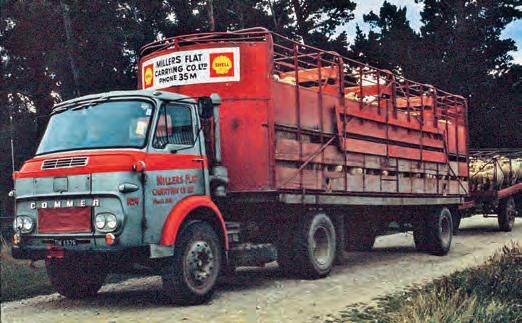
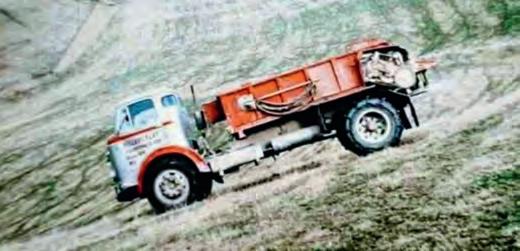
hills, keeping things flat … but not here, where we wind our way around and over. The Japanese didn’t put a trailer behind their trucks either and ran their permitted weight … not here, though. ‘Load ‘em up and make them work, and then put a trailer on behind.’
The evaluation was the truck doing what it wasn’t designed to do. The Rhino went well but was noted to crack its head at least once. It was a big beast, though. An extra axle was added in front of the tandems to help get the weight balance right. It made for an impressive truck and

Forbes was its main driver. It was a tipper and had its own crates, pulling a two-axle trailer most of the time.
Charlie Skevington drove it later and had an unfortunate incident travelling home one night after taking lambs to the Fairton freezing works. With his girlfriend Fiona, later to be his wife, they hit a horse at full noise on the Hilderthorpe Straights just north of Ōamaru. The horse’s head hit the windscreen but didn’t go all the way through, and the cab was pretty much broken off the chassis and the trailer crate came off and hit the
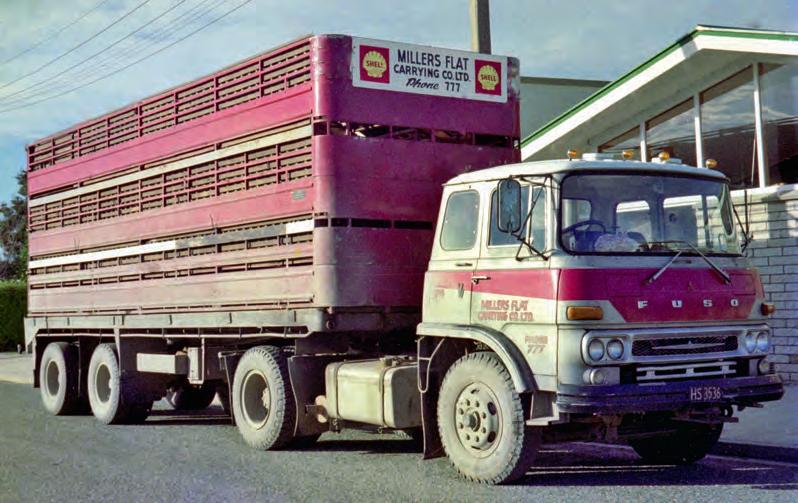



back of the truck. It was repaired and lived to fight another day.
When the rail was open, the train would bring in Southland Phosphate Company fertiliser and coal and would be unloaded. However, when it closed in 1968, the carrying company had to go over to West Otago Transport at Heriot to get its Southland Phosphate fertiliser – some farmers preferred that product. Heriot still had its rail coming into town and would retain that until 1978, when the big floods made it uneconomical to repair the line. The product was loaded into the trucks with Fordson clamshell loaders, which were popular then. If it were a busy day, Millers Flat would take its own loader over or use the ones owned by West Otago Transport. Many companies had them for this purpose, and for unloading from trucks and trailers that didn’t have a hoist. As tipping decks became standard and the rail slowly disappeared, the clamshell loaders fell the same way.

1) A lovely snap from an unknown photographer of the T81 Fuso parked on the main street of Millers Flat. 2) Commer No.14 on the easy way out of Ravensdown … via the Burnside freezing works unloading ramps.
Photo: Charlie Skevington.
3) John Rae with his Fuso outside the office and workshops. Photo: Roy Tosh. 4) John in his 330 V8 Fuso, the highest horsepower truck the fleet ever had. Photo: Roy Tosh.
In winter, Donald Gilmour would take his Commer into Burnside for fertiliser, but would wait until three in the afternoon to leave, giving the Manuka Gorge time to thaw out fully. The single-drive Commer struggled to gain traction on some corners when it was icy, but at certain times of the year, Manuka Gorge never thaws out. The Kempthorne Prosser and Dominion Fertiliser works at Burnside had a steep entry point, which was also the exit point. Some trucks couldn’t get back out fully loaded, especially the single drives like the Millers Flat Carrying Commers. Charlie Skevington, who drove Commer No.7, a 1968 model, and then a new Commer, No.12, found it easier to exit via the freezing works by going over a bridge and through a tunnel where the livestock trucks unloaded.
The loathed Taska was shown the door in about 1972 after being written off in an accident when its brakes failed at Shingle Creek. It ended up down a hill
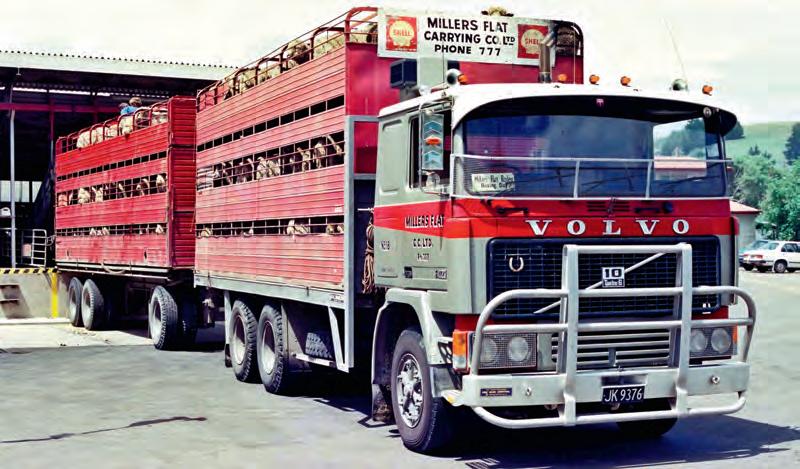
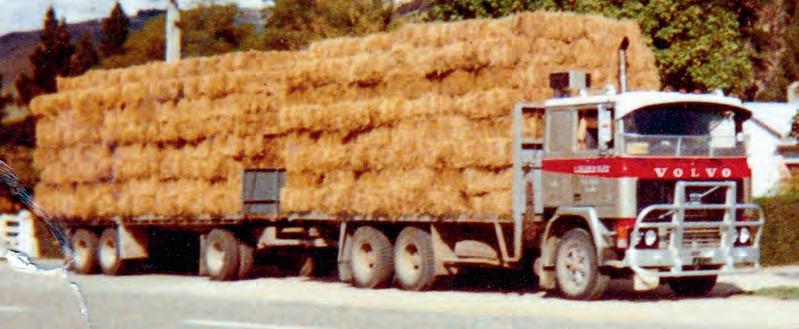
and in a bank. A K-Series Dodge with a Perkins 510 V8 was bought as its replacement, and another new Commer arrived at the same time. Ian Pringle, who was on the Taska, was put onto the Dodge, which had a front-ofbody hoist. The Commers were all twin-ram under-body types. The Dodge had a two-deck cabover pen stock crate and pulled a two-axle trailer.
John Rae joined the company in 1973 and went onto Commer No.7. Tony Omand was also with the company, on Commer No.9. He had arrived in the late 1960s from Gardner Motors in Dunedin, where he was a mechanic and he was also a mechanic at Millers Flat Carrying. Donald Gilmour was still on his No.4 Commer but received a new T81 Fuso in 1974; another four-wheeler tractor unit pulling two trailers and again supplied by VTR Motors. His original TS3 Commer would become a spreader, as would its Commer replacement (No.4).

Junction and Edievale on SH90, in particular. It was frustrating as the alarms are loud, so John installed a cut-off switch to eliminate the problem and relied on the temperature gauge to keep matters in hand. The Fuso also spent three months off the road when a car pulled out in front of John going through Waihola. It was only six months old when that happened.
The Nissan Rhino was next to be pensioned off. In 1976, Forbes and Roy purchased a new six-wheeler G88 Volvo with a three-axle trailer. The G88 had a new Sutton three-pen crate, but the trailer had a new Toko Engineering one. Toko was in its infancy as a company, and it was not a popular sheep crate. Forbes would drive the G88 most of the time and would often flog John’s Sutton-crated trailer and use that, as it was more userfriendly. While Forbes was driving the G88, Roy was driving a TK Bedford, which replaced his No.5 petrol-powered Commer.
Spreading wasn’t a big thing for Millers Flat Carrying. As mentioned, the area is covered in hills and a single-drive Commer, even with chains on the back, wouldn’t really cut the mustard – so it was left for the aeroplanes to do most of the work. It was the job of the carrying company to get the fertiliser up to the airstrip, though. Commer No.4 was evidence of that when it rolled and needed a new cab.
Ewan Tosh remembers going along for ride when he was a young fella. “A convoy of Millers Flat Carrying trucks headed into Beaumont Station, all overloaded to hell with superphosphate, and I had to open 30-odd gates all the way through.”
The poor bloke at the end of the convoy had to close them all again. Overloading wasn’t uncommon in such a scenario, as the convoy opted for back roads. One would imagine that they would have taken the main road
back afterwards when empty…
The T81 Fuso went well, so it prompted the purchase of a second one in 1975. It was a 6x4 rigid with the new-style cab and was the first in the fleet to get a three-axle trailer with three-deck Sutton crates, which, back in 1975, were a load in themselves. It did have an aluminium deck all the same…
This T81 was a 330hp (246kW) V8 model, so it sounded good. John Rae was its driver, and the Fuso was a big step up from anything else in the fleet, but it would turn out not to be the most reliable truck. An undersized radiator caused most of the grief, and the clutch wasn’t that great, either. Again, like the early Ford V8s and the Nissan Taska, it was prone to overheating and cracked a head occasionally. The Kysor temperature warning alarm would sound often, usually when a hill would come into sight … the Devil’s Elbow between Raes
The Volvo was a big step up again and the reason for its purchase was its light tare weight and the fact that quite a few were now proving themselves as good, reliable, comfortable trucks on the roads of Central Otago. Teviot Transport, Cromwell Transport, Upper Clutha Transport, Radford’s, Turners … and let’s not forget those iconic pink Holgate and Anderson Haulage ones. They were popular trucks.
The Volvo theme repeated in 1980 when Tony Omand received a new F10. As the replacement in New Zealand for the G88, it was also a popular truck. This one received Nationwide livestock crates.
The last purchase was another Volvo: an N1025 bought set up as a spreader with a twistlock body, so it could also be a tipper. It was purchased from Dalhoff and King, which had bought it off McDougalls, which had depots in Invercargill and Winton. Originally a tractor unit, Millers Flat had it stretched for the fert spreading bin.
John had a stint on it and recalls his first load: “The first
load I sowed was a mixture of super and oats. I drove to the paddock, set the computer, walked around to make sure everything was right and hopped in and set off. I looked in the bin after the first round and it was all

gone! Turns out I had turned the power switch the wrong way and put the bin in stationary unload. What an expensive mistake … Not long after that, Ian Beel took over and was a dab hand at sowing!”
Winter periods were a chance to get on top of maintenance, painting sheep crates and getting staff away on holidays. There was a lot of coal to be

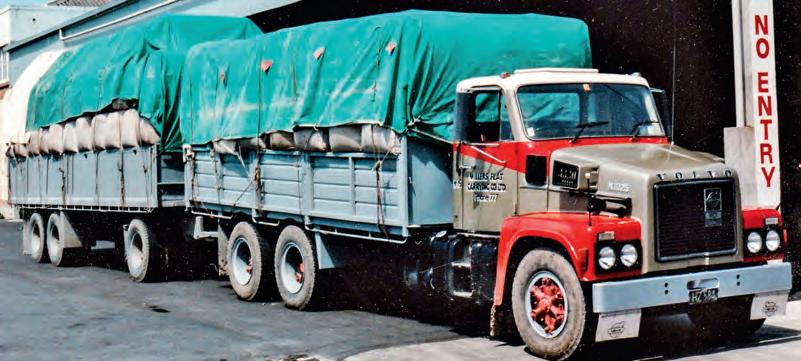
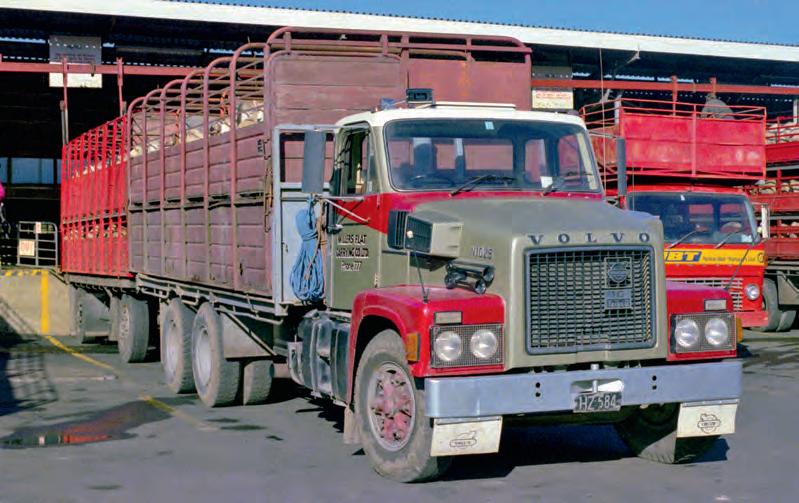
delivered as everyone had an open coal-burning fire back then. There was always a coal shed to be filled with a hand shovel.
Frost fighting was a huge thing during the autumn and winter. Shell would supply the diesel to three tanks in the depot, and Millers Flat Carrying had a couple of tankers to deliver diesel to frost pots throughout the many orchards in the area. There was one rigid tanker and one semi-trailer tanker carried around by the Commers. Charlie Skevington and Donald Gilmour would do this and would be up all night getting on top of it.
“Winters were so much harder back then, not a good time to hang your washing out with all the frost pots burning,” says Charlie. John Rae adds: “You would get up in the morning and go outside and the sky was black with smoke.”
The burning of pots would usually happen during the blossom period and could go into November if unlucky.
Pre-lamb shearing would kick off around August, so there was also wool to cart. Early lamb drafts would start in about November after the weaning. Lambs would be the morning loads and then the crates would come off for hay cartage into the night. Doing hay was a massive, labour-intensive job back then, with mostly small bales. Friday and Saturday were big hay days and Sunday a big day for carting livestock. Sheep and bales of hay equated to the same – one small bale was the same as one sheep when loading.
It was the time before log books, so big days were the norm during the busy season. Livestock would be carted through to May and then there was the fruit to do.
John Rae recalls a 42-hour day! “Millers Flat to Burnside and back to Millers Flat, and then
1) The N10 when it arrived as a sower. Ian Beel was its driver for most of the time. Unknown photographer. 2) The N10 loaded with wool in Dunedin. 3) The N10 at Burnside, Dunedin. Photos 2 & 3: Big Rig Fotos. 1 2 3


4) Five of the Commers all loaded up with lambs. What a sight.
Photo: Tosh family collection. 5) A Summertime staple – doing hay the hard way. Commer No.12 driven by Charlie Skevington. 6) John Rae hooking up his trailer under Ray’s watchful eye, with all of three ropes on the load of that truck… Photos 5 & 6: Charlie Skevington collection.
7) Roy’s TK Bedford sitting at the Apple and Pear Board in Ettrick.
Photo: Roy Tosh. 8) Another load of newly weaned lambs heading away from Avenel Station. Photo: Jack Garden.
up to Smithfield in Tīmaru, then back to Raes Junction just shy of Millers Flat for calves to go back up to Orari in Mid Canterbury … admittedly, I squeezed in two hours’ sleep at Raes,” he says. This was back in 1974 and in the K Series Dodge pulling a two-axle trailer. There were three trucks from the company doing that work that day. They all stayed in Makikihi on the way home.
Charlie Skevington recalls something similar about the long days. “Roy’s wife would prepare food for us, so we always ate well, and we were given an overnight or away allowance. This would somewhat backfire as we would stop at places like Dunsandel, Makikihi, St Andrews or Palmerston, and then spend our allowance on alcohol and have to sleep in the cabs of our trucks,” he laughs. “And Roy would always have his bedroom light on until he knew you had made it safely home, no matter what time of the night it was.”
In 1985, Forbes and Roy decided to sell up. After 31 years in business, Roy was ready to retire. Ultimately, the fleet consisted of three Volvos, two Fusos, two Commers and the TK Bedford. That there were Commers to the end showed they were great trucks and reliable as the tide. Yes, every now and then, one would fail – such as John seizing one at Crookston with a full load of lambs bound for Mataura. Tony Omand always had a spare engine in the workshop, ready
to be fitted when needed. It was usually about the 90,000-mile (144,000km) mark when another motor was required.
Roy passed away in 1985 after the company was sold, so sadly, retirement was short-lived. He was a very communityorientated man. He started up the fire brigade in town with a car and a pump trailer, obviously making a statement that having some sort of fire response in the town was very important. He was also very handy when it came to fixing valve radios and televisions. Often, in the evening, he would be out with his bag of replacement valves fixing the locals’ TVs and radios. Hewsons in Tapanui trained him up to do this.
Forbes still lives in Millers Flat and is now in his 90s, and has spent his life supporting horse racing clubs and sports in general.
The company was sold to Mount Benger Timber which had sawmills in Ettrick, Palmerston and Ranfurly. It wanted its own trucks to cart logs into the sawmills as well as running the rural side as usual. Within two years, that company went under and took what was left of the carrying company with it.
“Work was hard, but you made things work for you to make things slightly easier. It was hard, but a great place to learn,” says John Rae.
Charlie Skevington echoes John’s words: “It was a great grounding and a great place to work.”
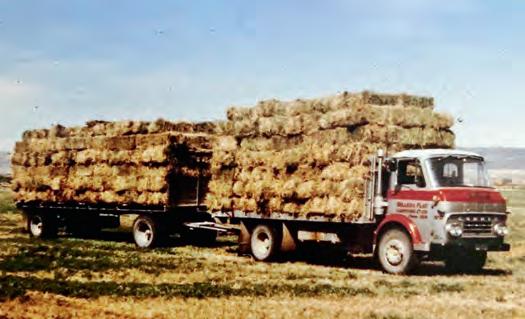
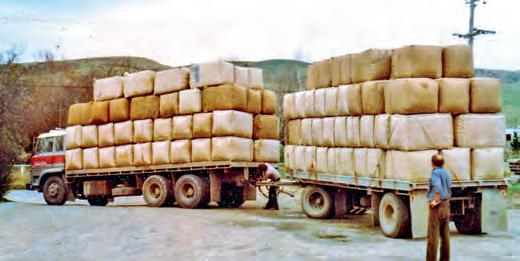
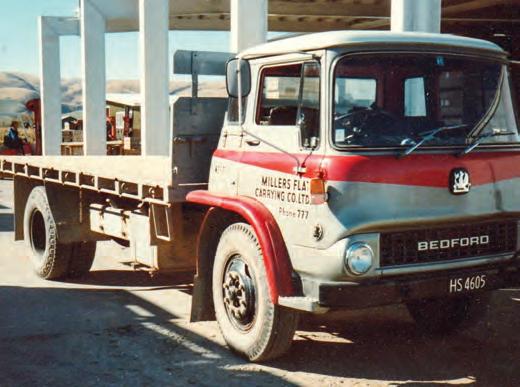

We are nice people at New Zealand Trucking Media, and if we put you through the wringer one month, we’ll be less gnarly the next. This one shouldn’t trouble you, really – it’s on a substantial corridor in our nation, one that has featured before in the competition.

To enter, flick us an email at editor@nztrucking.co.nz
Subject line: Where’s that road? June 2024
Tell us your answer, and let us know your postal address.
Note: Please include the subject line above, or your entry might get lost in the pile. We’ll randomly pick a winner from the correct entries and see what’s in the prize basket. The competition closes at midnight on 30 June 2024.
Our 100 year history proves that when you do everything with heart, nothing is too heavy.
Mitsubishi from Centra, moving New Zealand forward.
You can hire a Mitsubishi Forklift on a fixed term hire contract, maintenance included on terms from day to day right up-to 7 years
• New or Used, ex fleet forklifts available
• Huge range to choose from
• Delivery within 24hours

Auckland - 32 Hastie Avenue, Māngere Bridge, Ph: 09 634 8500
Hamilton - 38a Maui Street, Ph: 07 849 5128
Tauranga - 12/45 Kaweroa Drive, Tauriko, Ph: (07) 282 9910
Palmerston North - 25 Bisley Street, Ph: 06 355 9033
Christchurch - 38a Parkhouse Road, Ph: 03 343 6814
Yep! You got it. It doesn’t matter where we go; someone knows exactly where our bit of mystery road is. Having said that, there were only three correct entries this month, so we did have you pacing the room and scratching your heads a wee bit.
Our winner this month is Dick Emi from the Whanganui region, so maybe he knows the Hapokopoko Stream Bridge, Mathews Road junction on SH4 well! Well done, Dick. You’re in an exclusive club this month!
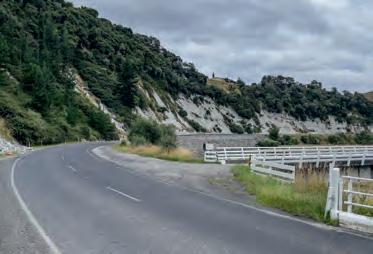
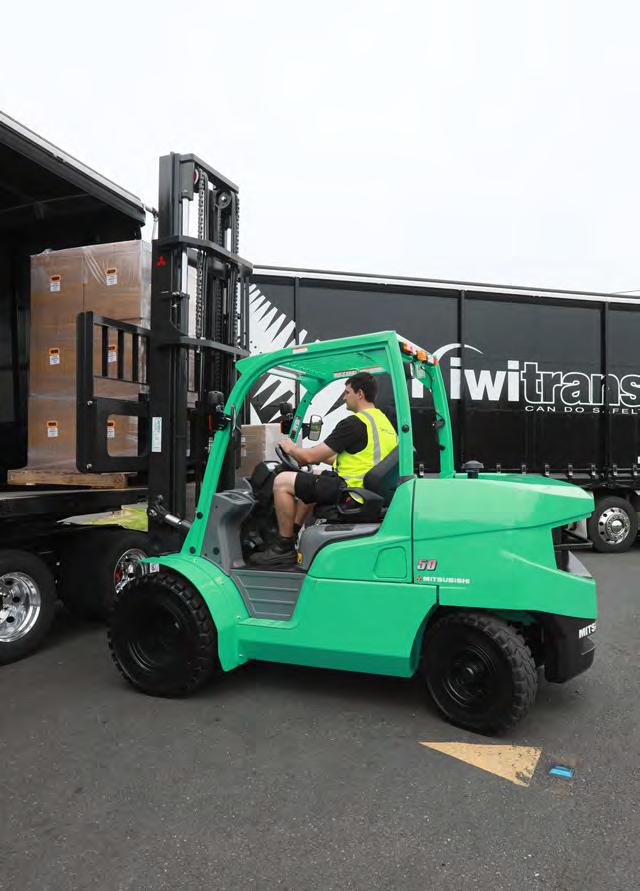
 SH4 Hapokopoko Stream Bridge, Kakatahi.
SH4 Hapokopoko Stream Bridge, Kakatahi.
Designed for New Zealand. Ready for your business.
The D16 engine with 650HP, provides a full 3150 Nm of torque, making this Volvo FH16 tractor unit hard to beat. Combined with Volvo’s leading I-Shift technology, smart features, advanced safety, and three year drivetrain warranty, this is the optimal choice for your operation.
Stock is limited. Contact us for specifications or to request a quote.
Volvo Trucks. Driving Progress.



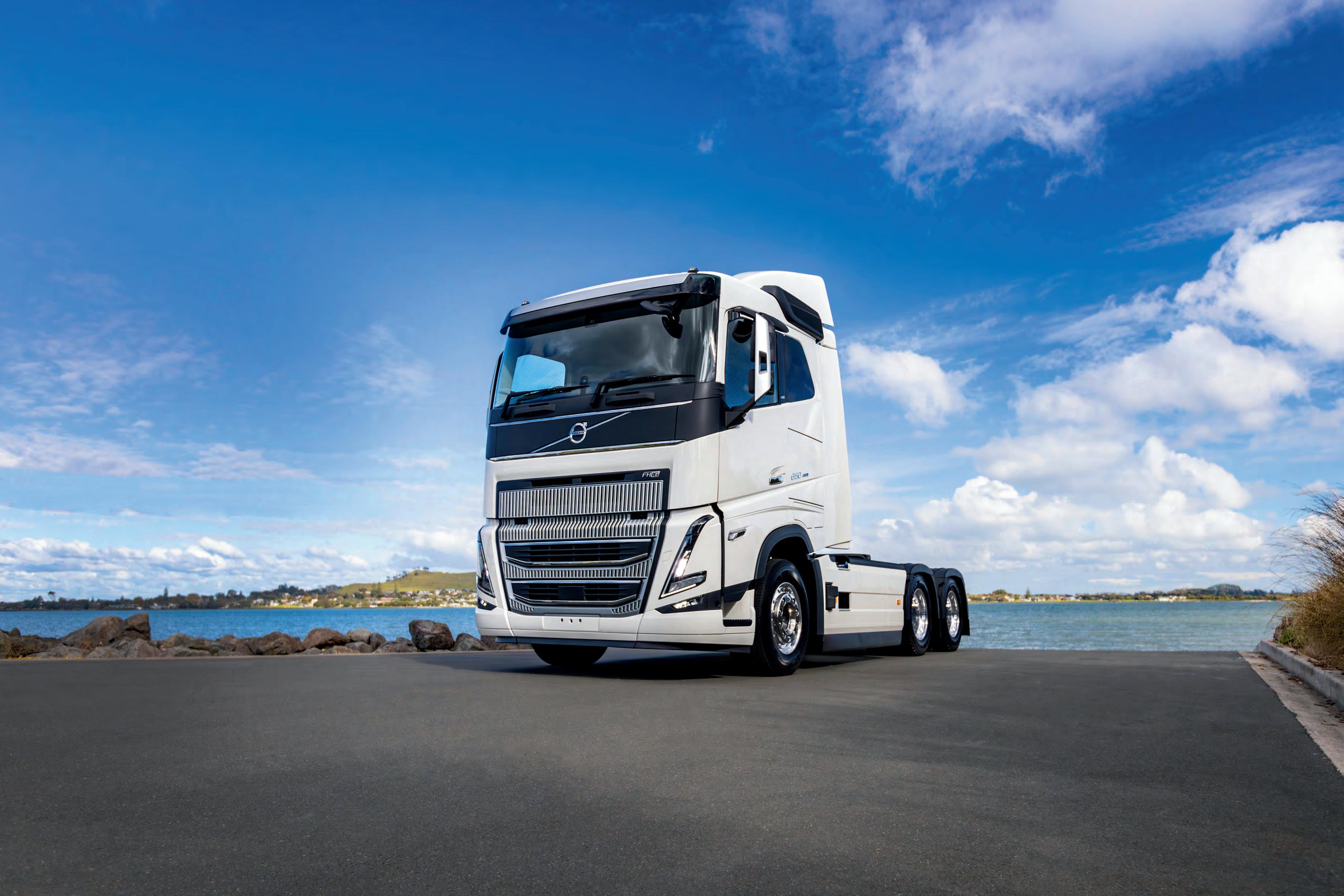



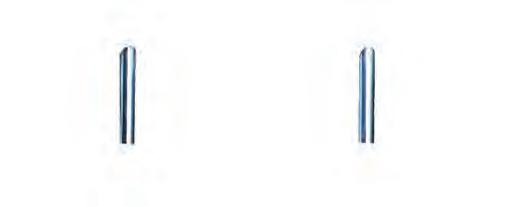

Last held in 2021, the Taranaki Truck Show returned over Easter Weekend 2024. The biggest event yet, it had clearly been missed.
The 2024 Taranaki Truck Show kicked off at 9am on Sunday 31 March with an impressive convoy from Centennial Drive at Port Taranaki in New Plymouth to the show’s traditional venue, Hickford Park, Bell Block.
A Trade Me auction was held
to determine the lead vehicle, which was won by JD Hickman.
It was a beautiful Easter Weekend, sunny with a cool breeze – and great views of the mountain.
According to the Taranaki Truckers Group Committee, the 2024 show presented the largest
turnout of trucks yet, with an estimated 180 attending. The show attracted local enthusiasts and families alike, with several having picnics alongside their trucks. There were food stalls aplenty and activities to keep future little truckers entertained.
The local fire department
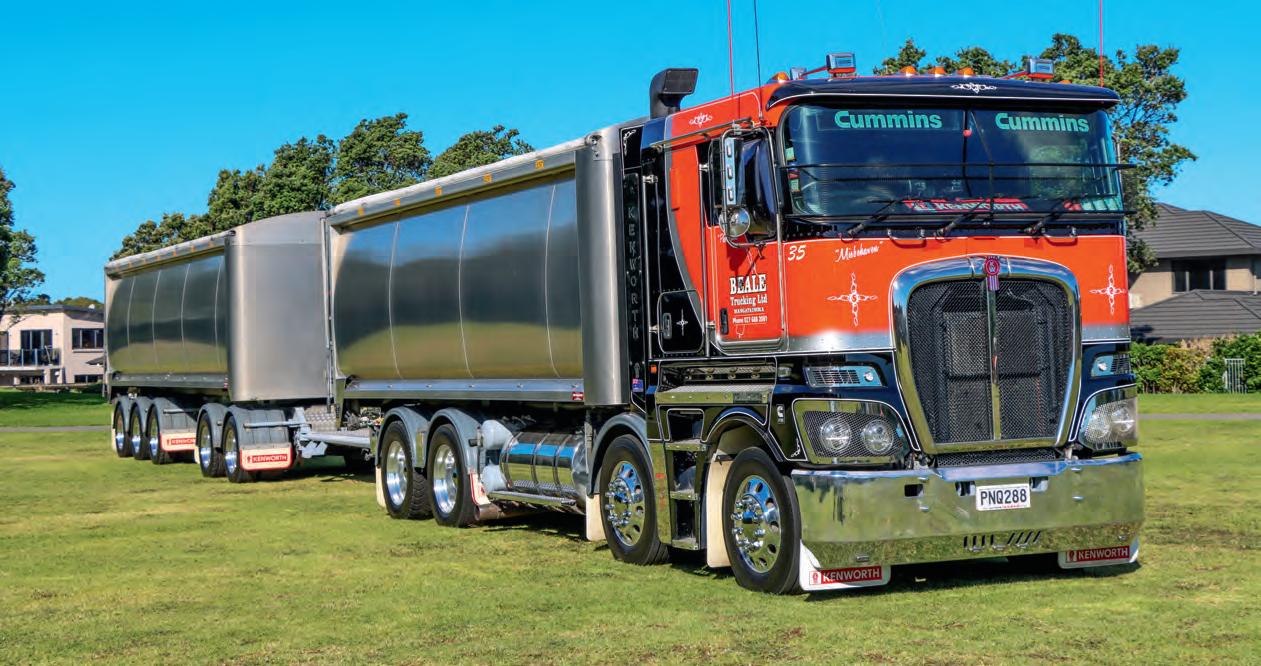 Story and photos by Michael Beesley
Uhlenberg Haulage was a deserved Best Fleet winner.
Story and photos by Michael Beesley
Uhlenberg Haulage was a deserved Best Fleet winner.
John Langlands from MC Fale Transport took out Best Mercedes-Benz with his Arocs, a truck familiar to readers of the September 2022 issue.

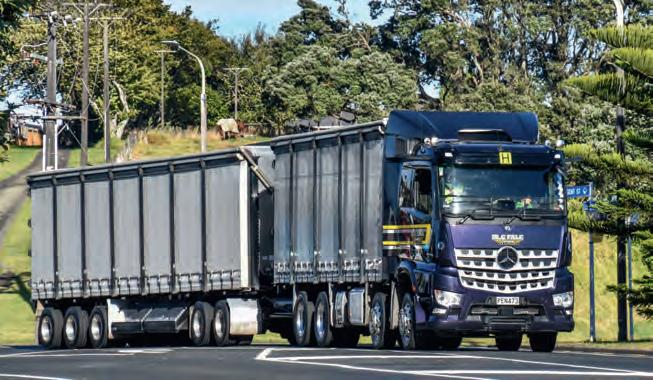
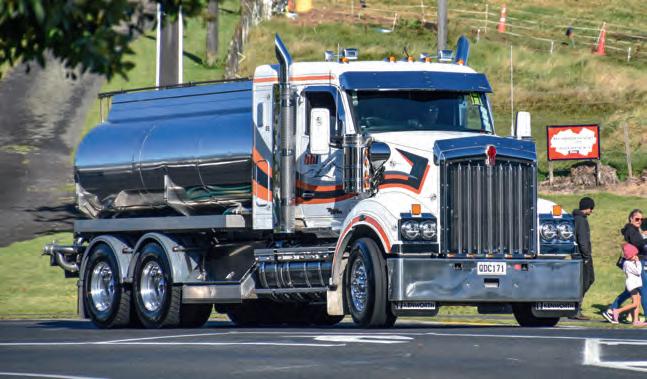
Shannon Bulk Haulage’s exquisite Kenworth
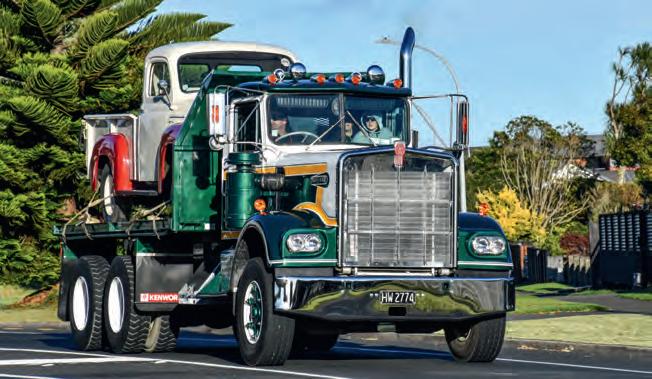


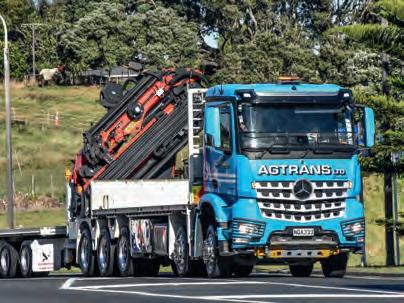
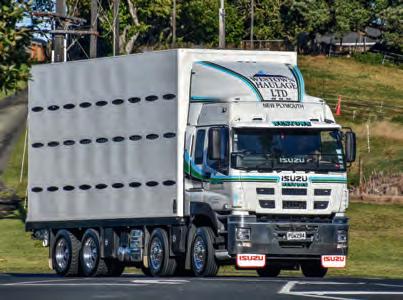
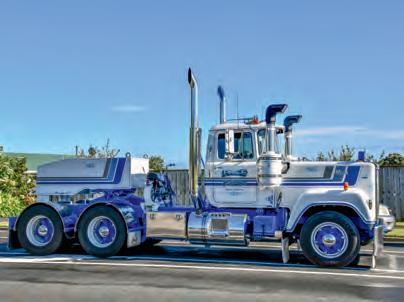
 Best Tanker went to Tyson Mascull in the BHL Feeds Kenworth T610 SAR.
W923R.
The Reliable Distributors Freightliner Argosy of Stewart Rolls took out the Best Freightliner and Best Flat Deck awards.
Best Tanker went to Tyson Mascull in the BHL Feeds Kenworth T610 SAR.
W923R.
The Reliable Distributors Freightliner Argosy of Stewart Rolls took out the Best Freightliner and Best Flat Deck awards.

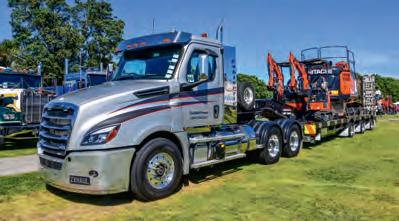
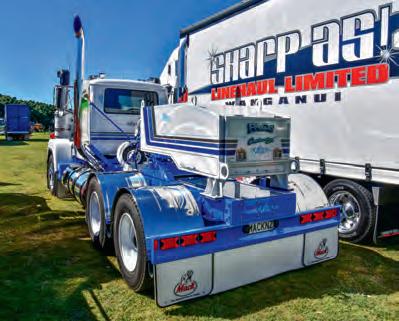

put on a great demonstration, alongside Hato Hone St John in attendance.
After the last show, Michielsens Transport was the reigning champion of the Uhlenberg Haulage tug-owar challenge, but this year, the Taranaki Truckers Group Committee won out.
A total of $17,719 was raised for the Taranaki Retreat and Waimanako, a suicide prevention initiative.
The Taranaki Truckers Group Committee would like to thank each of the 40 show sponsors and the volunteers who helped on the day, as well as all the drivers who came along to support the show, with a special thanks to the Taranaki community.
Here’s looking forward to the next show in 2026.
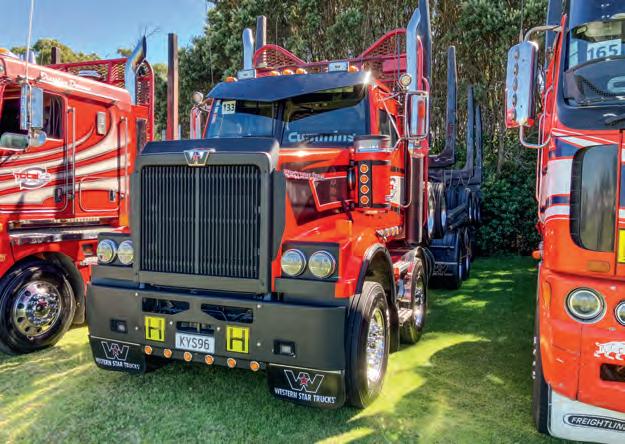
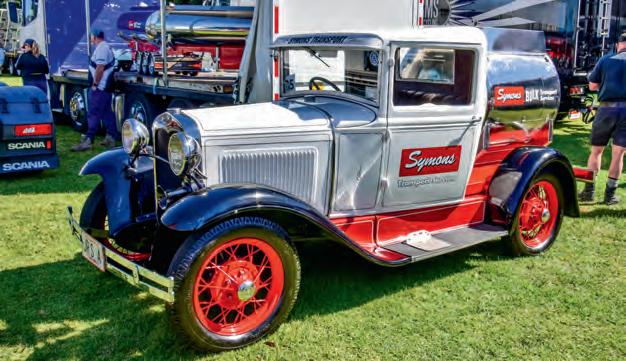
Best Mack Ryan Gadsby Gadsby Haulage – Mainfreight Super-Liner
Best Kenworth Jon Murray Beale Trucking K200
Best Volvo Mark Mackle
Mark Mackle Contractors FH12
Best Isuzu Jayden Baird Michielsens Transport CYJ530
Best Hino Rick Payne Roebucks 700
Best Freightliner Stewart Rolls Reliable Distributors Argosy
Best DAF Richard Kotlowski
Best Mercedes-Benz Mike Fale
GMC haulage – Mainfreight XF105
MC Fale Transport Arocs
Best Western Star Chris Garrett Log Haul Taranaki 4884FXC
Best Iveco Tori Van Klink Agtrans Stralis
Best MAN Les Lyford Move Logistics TGX 35.540
Best Fuso Michelle Wilmshurst NP Towing Fighter
Best UD/Nissan Will Bishop Hynds CW 26 390
Best Scania Brendan Rowlands Rowlands Transport S620
Best International Brendon Clegg Bunn Earthmoving 9200i
Best Other Ethan Boyce Titan Cranes Liebherr LTM 1060-3.1
Best Fleet Uhlenberg Haulage
Best Logger Darryn Warren McCarthy Transport Kenworth T659
Best Tanker Tyson Mascull BHL Feeds Kenworth T610 SAR
Best Curtainsider Shaun Dickie Duo Transport Kenworth T909
Best Flat Deck Stewart Rolls Reliable Distributors Freightliner Argosy
Best Bulk Unit Ross Larking Michielsens Transport Volvo FM 500
Best Stock Unit Colin Liddall Sandford Livestock Iveco Stralis
Best Special Purpose Murray Russell Bosco Contracting Mack Super-Liner
Best Tractor Unit Shane Tito Tito Transport Scania S660
Best Rigid Justin Tito Uhlenberg Haulage Kenworth W923 S2
Best Classic Charlie Ruakere JD Hickman Kenworth K100E
Best Vintage Symons Transport Model A Ford Truck of the Show Jon Murray Beale Trucking Kenworth K200
Tug-O-War Taranaki Truckers Group Committee










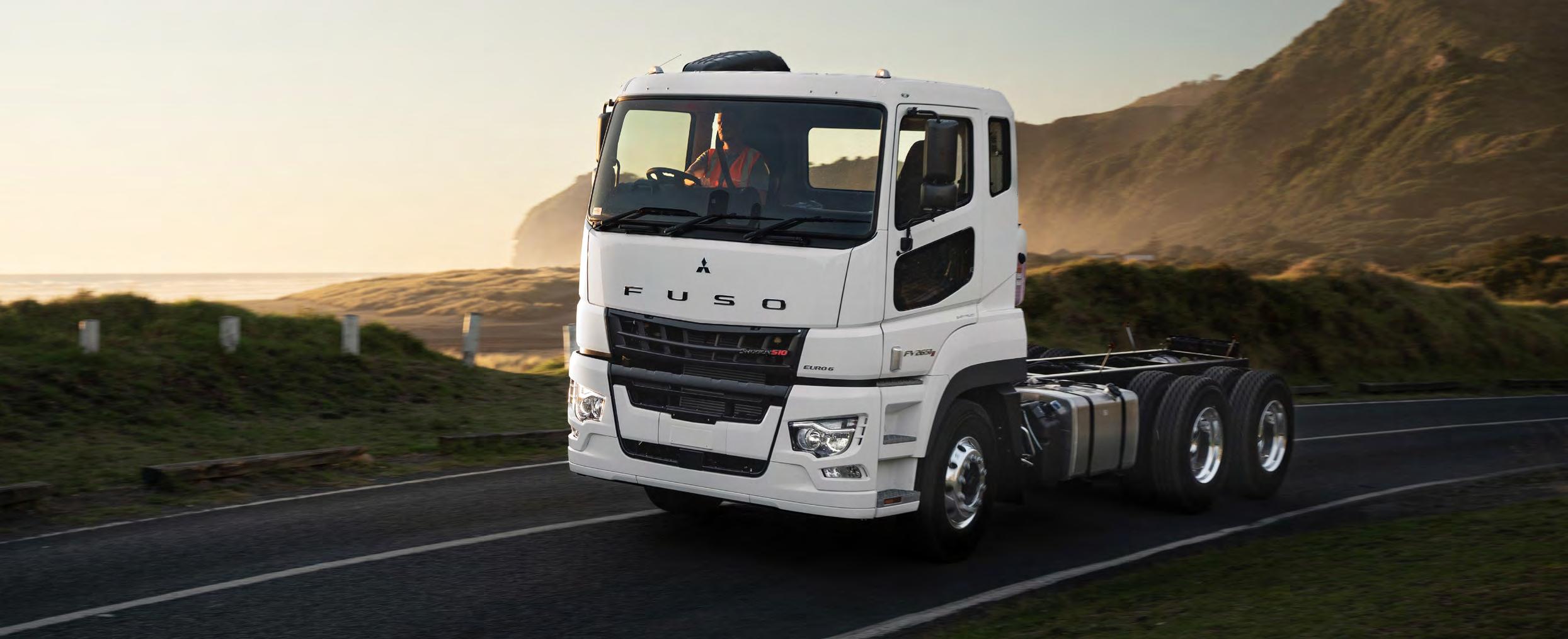
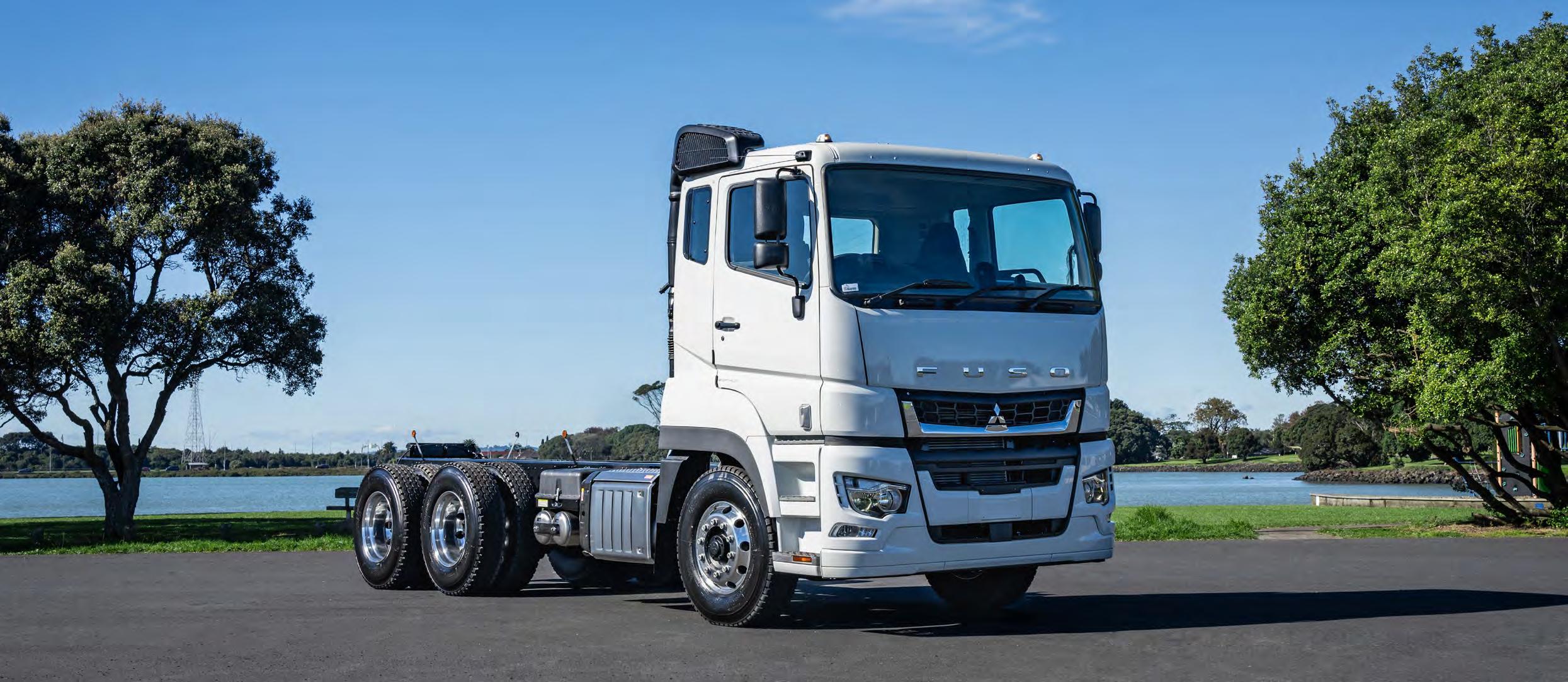



 Chris Garrett’s 4884FCX won best Western Star.
Flying the vintage flag, Symons Transport’s Model A Ford took out Best Vintage.
Chris Garrett’s 4884FCX won best Western Star.
Flying the vintage flag, Symons Transport’s Model A Ford took out Best Vintage.
6x4 TIPPER / TRACTOR SPEC
• JAPAN’S MOST POWERFUL TRUCK
• 510HP | 2,500NM
• 5 YEAR / 500,000KM WARRANTY
• 60,000KM SERVICE INTERVALS

















$199,900*

$251,000 SAVE $50K FIRST SERVED! FIRST COME
6x4 TIPPER / TRACTOR SPEC





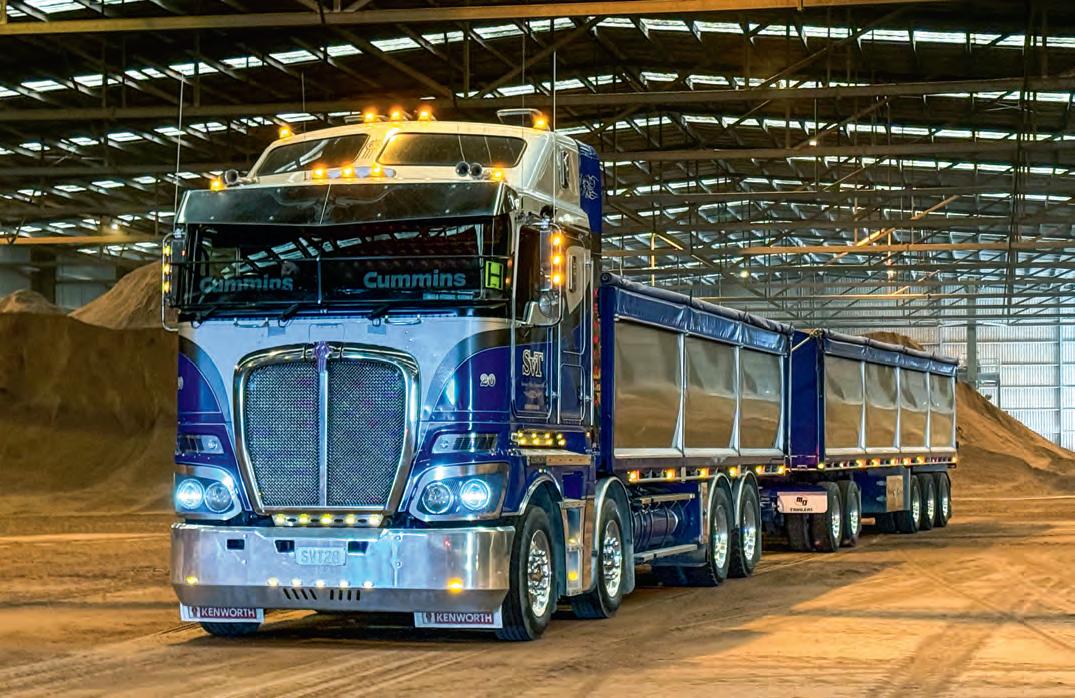
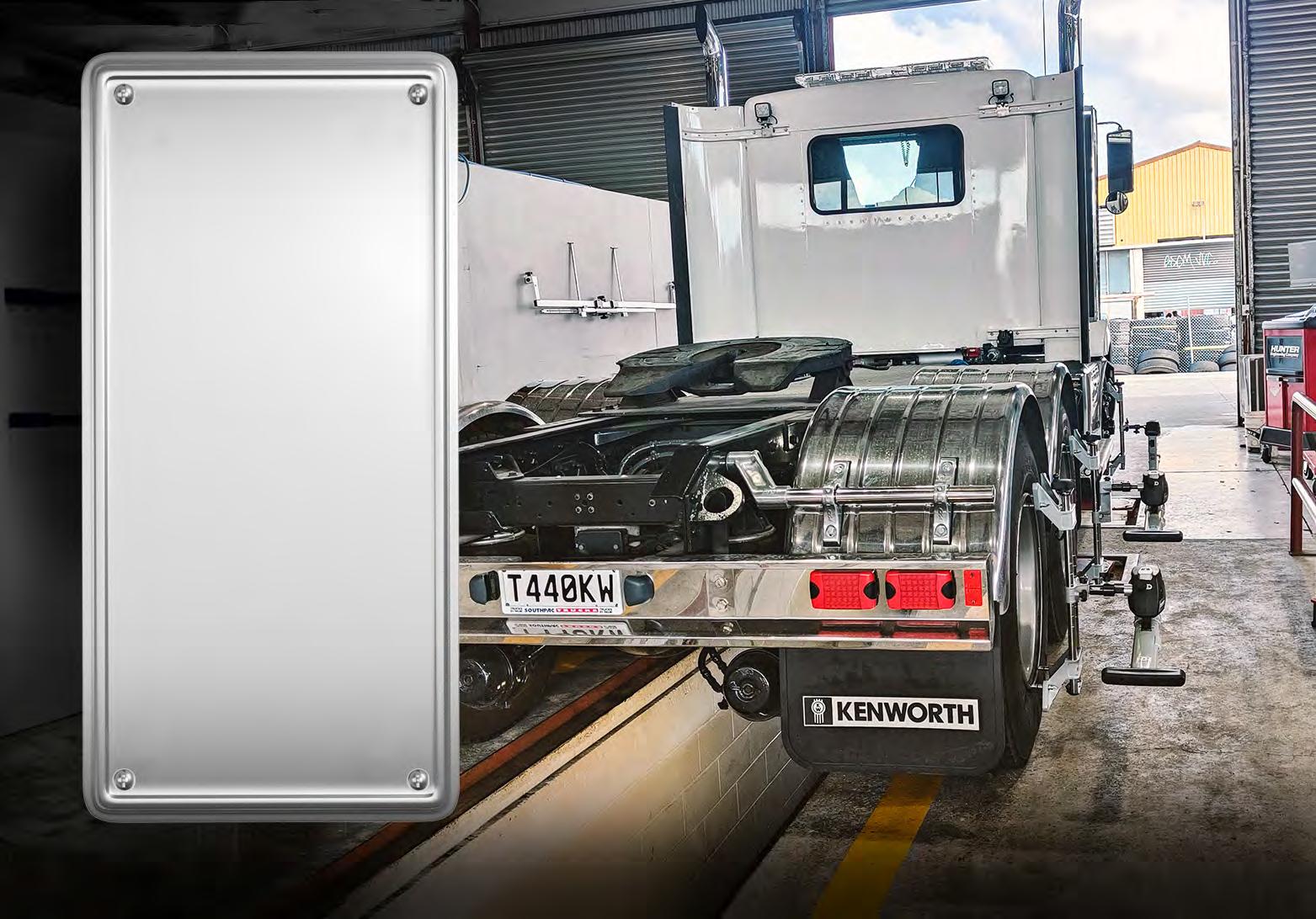
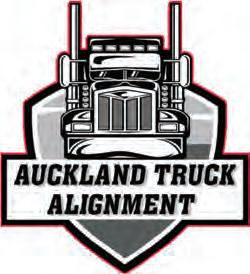
TRUCK & TRAILER WHEEL ALIGNMENTS SPECIALISTS
• Truck & Trailer Wheel Alignments
• Long wheel base vans / heavy vans and motorhome wheel alignments
• Tyre sales and fitting
• Induction heating and straightening of bent trailer axles and diff housings
• On & off truck wheel balancing
• Axle Camber Corrections
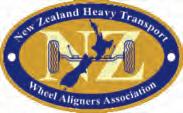
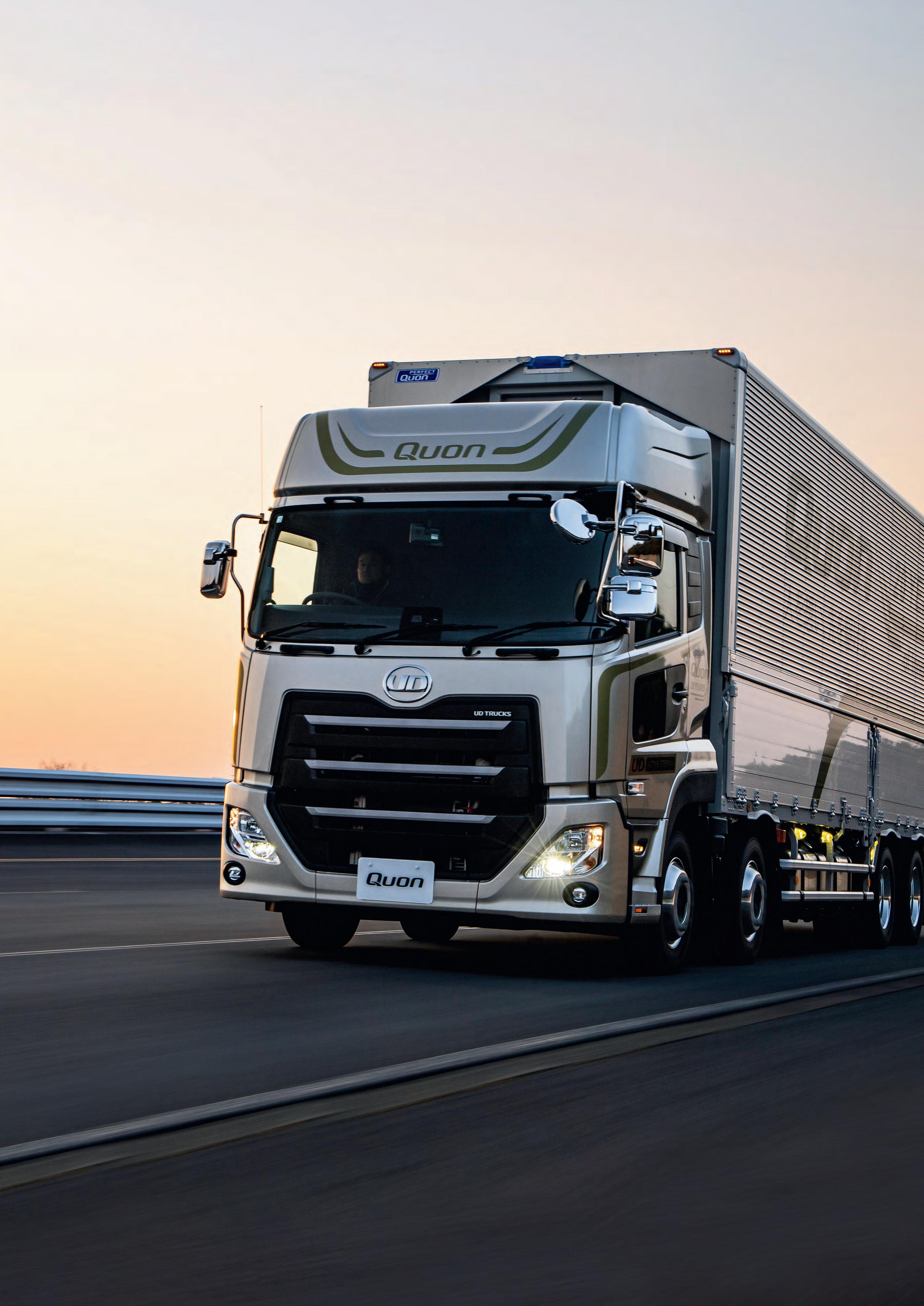

Celebrate with us!


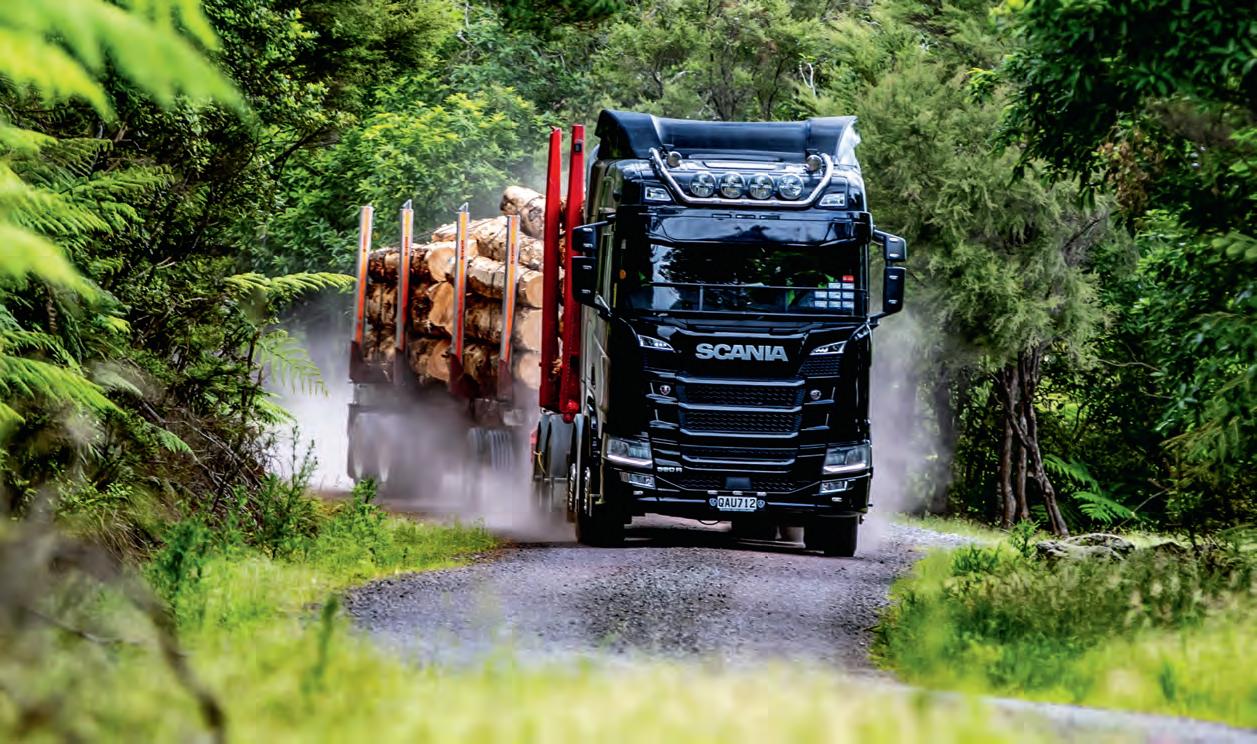
Scania knows Kiwi truckies are a discerning bunch, which is why the overwhelmingly positive results from a recent online survey asking drivers and owners about their preferred truck brands means truckloads to the Scania NZ team.
The survey generated more than 1000 respondents. Spoiler alert: Scania came out tops – by a long way.
Scania NZ managing director Victor Carvalho says there is nothing better for a brand and a team than to see the results of its focus and efforts strongly validated by its most important critics – its customers and industry peers.
“The Scania NZ team works tirelessly to make its customers’ needs its top priority. So, to come out as No.1 across so many categories, from safety to comfort and performance to sustainability, is incredibly motivating as we always continue to look to improve,” he adds.
Carvalho says one of the survey’s most gratifying results for his team’s hard work and focus is the noticeable increase in the number of truckies who already drive a Scania compared with those who would prefer to drive one if they had the choice.
He is also very proud that this stakeholder success has not come about by chance.
Scania NZ has an ongoing programme of strategic investments across its national and regional networks to ensure its customer service levels maintain pace with the brand’s ever-expanding presence in the country.
Encouragingly, they are investments that speak directly to many categories canvassed in the survey, such as after-sales servicing and parts, performance, training and sustainability.
Scania has developed new service centres and workshops in Invercargill and Hastings this year and invested more than $40 million in spare parts stock and the recruitment and upskilling of more than 400 technicians across the wider Scania network.
“A big player in this is our National Training Development Centre in Christchurch, which is about developing our new Scania
technicians and ensuring best practice, productivity, efficiency and that the latest technology is maximised when servicing vehicles. It is all about ensuring the best capacity to service our customer base,” says Carvalho.
Improving the benefits for customer experience is always top of mind.
“Every services-related investment we make is done to achieve better outcomes for our customers. The more expansive our service centre network is, the more highly trained technicians we have and the more right parts that are available at their fingertips all adds up to faster servicing of customer vehicles and less down time off the road. Every dollar we invest in this area has a direct benefit to our clients’ bottom lines in their businesses,” says Carvalho.
“We aim to be the industry’s preferred solution provider, delivering premium products and services in a sustainable way with a strong dealer network. That is our commitment to customers and the ongoing focus of our fantastic team.
“So, we want to say thank you very much again to both our current and soon-to-be customers from the survey for being such an important part of our journey so far.”
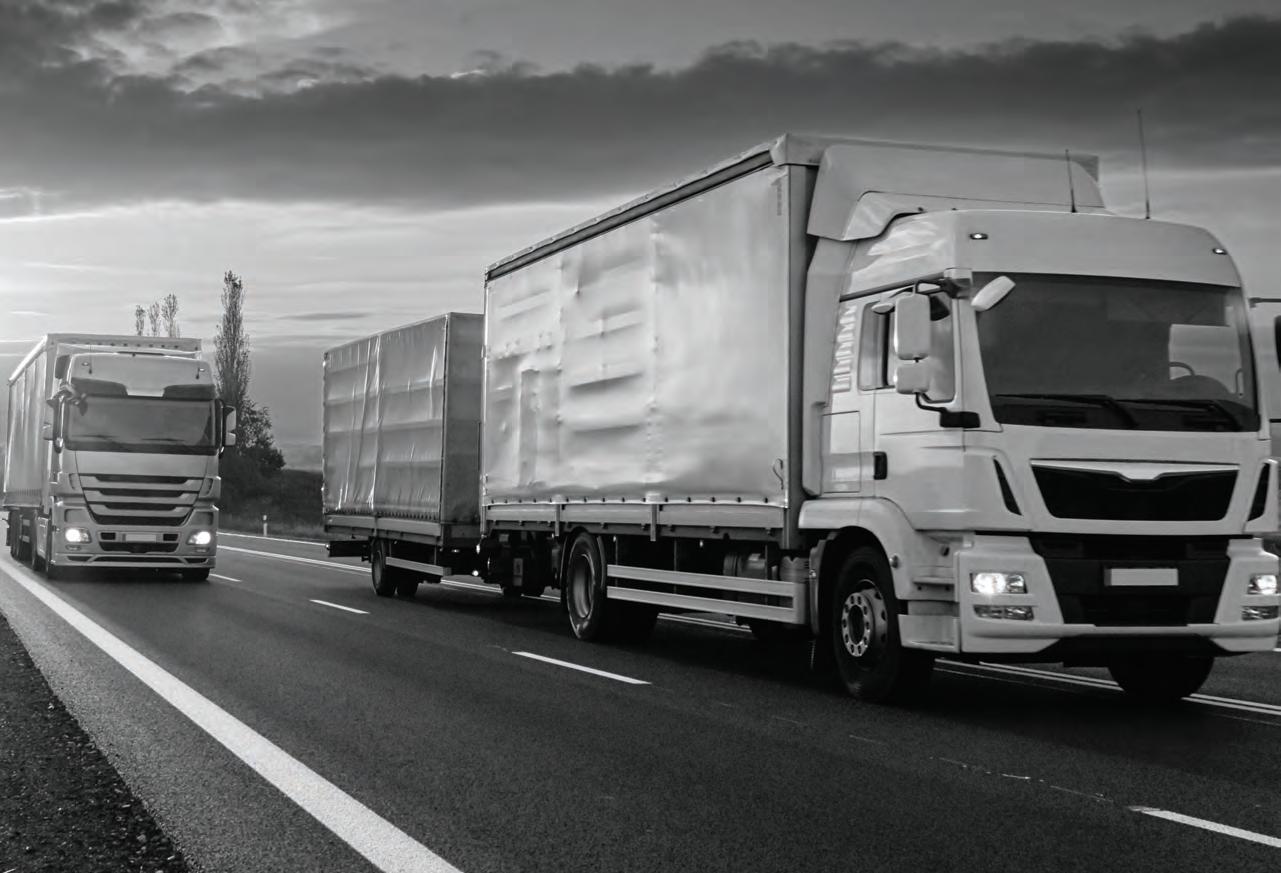
A breakdown of each category’s results based on the percentage of respondents who ranked these brands as their No.1.
Comfort – the brand most considered to be ‘driver-focused and a great place to spend time’.
- Scania at 39%
- Volvo at 20%
- Kenworth at 10%
Safety – the brand that best offers all the latest safety features and technology.
- Scania at 35%
- Volvo at 25%
- Kenworth at 9%
Sustainability – the brand most seen as ‘doing their bit for people and the planet’.
- Scania at 32%
- Volvo at 24%
- Kenworth at 11%
Performance – the brand most considered to ‘deliver all you need, from torque to tonnage’.
- Scania at 34%
- Volvo at 15%
- Kenworth at 20%

Efficiency – the brand most seen as having the ‘lowest running costs’.
- Scania at 30%
- Volvo at 20%
- Kenworth at 10%
Service and parts – the brand that best offers locations and availability.
- Scania at 29%
- Volvo at 14%
- Kenworth at 21%
Overall value for money – the brand most considered as having ‘the full package’.
- Scania at 30%
- Volvo at 14%
- Kenworth at 17%



Cost can be a significant barrier for transport operators when considering implementing formal training into their business.
Neil Collier, an assessor and industry mentor for MITO, says formal training can make a big difference not only for drivers, but for business operations, and affordable options are out there.
“With all the new technology in trucks and new regulations and guidelines, there’s a lot to learn. Not just for the new guys coming out of school, but for experienced drivers who need to learn how to operate new systems and ensure they are practising correct driving behaviour,” Neil says.
Neil has been in the transport game for more than 30 years, and as well as being a driver, he has been a manager and trainer – developing quality drivers from scratch. He began working with MITO about five years ago.
“In the mentoring capacity, I help drivers with paperwork, assessments, everything they need when they are completing MITO’s micro-credential programme. If they have any issues, I can point them in the right direction.
“For assessments, I go with the learners in the truck while they do the practical side of the assessments,” Neil says.
Neil says that with younger drivers, he sees that they are
keen to learn but often don’t have the confidence to ask questions.
“I tell them no question is a dumb question. They need a bit of encouragement to put their hand up. But when they do, they listen. The biggest thing with young people is giving them an outcome – showing them what could happen if they do this or do that, whether it is a positive or negative outcome,” he says.
“With experienced drivers, sometimes they can say, ‘Oh, I’ve been doing this for 25 years’, and you have to show them why learning these things and completing these assessments is worth their while.”
Neil says that while cost can be a barrier for some transport operators, the benefits of training outweigh the amount spent. MITO’s Drivers Safety, Introduction to Commercial Road Transport or Heavy Combination Vehicle Loading Fundamentals micro-credential programmes are quick and easy to complete and supply the basic knowledge and skills required.
“MITO is an affordable option for training. It is quality training that gets drivers thinking, and with young drivers, if they do something incorrectly, they work hard to get it right the next time,” he says.
“MITO is a good outlet to get people in the game, and we need players.”
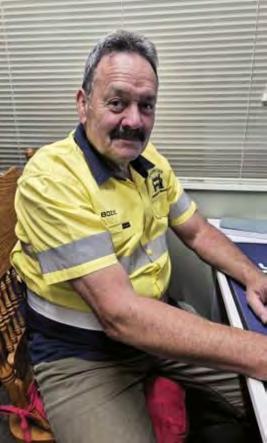
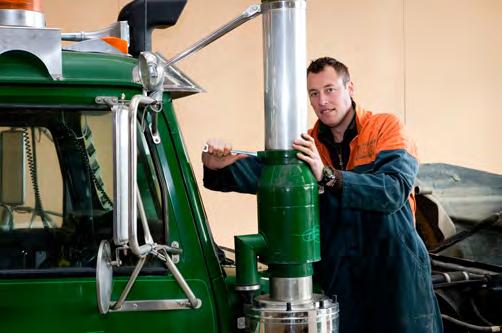

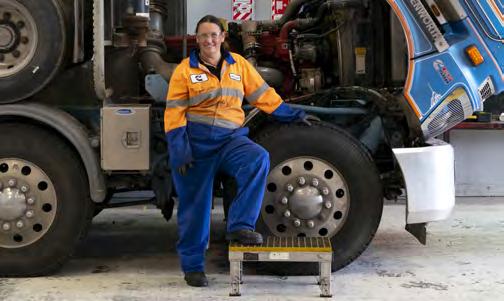
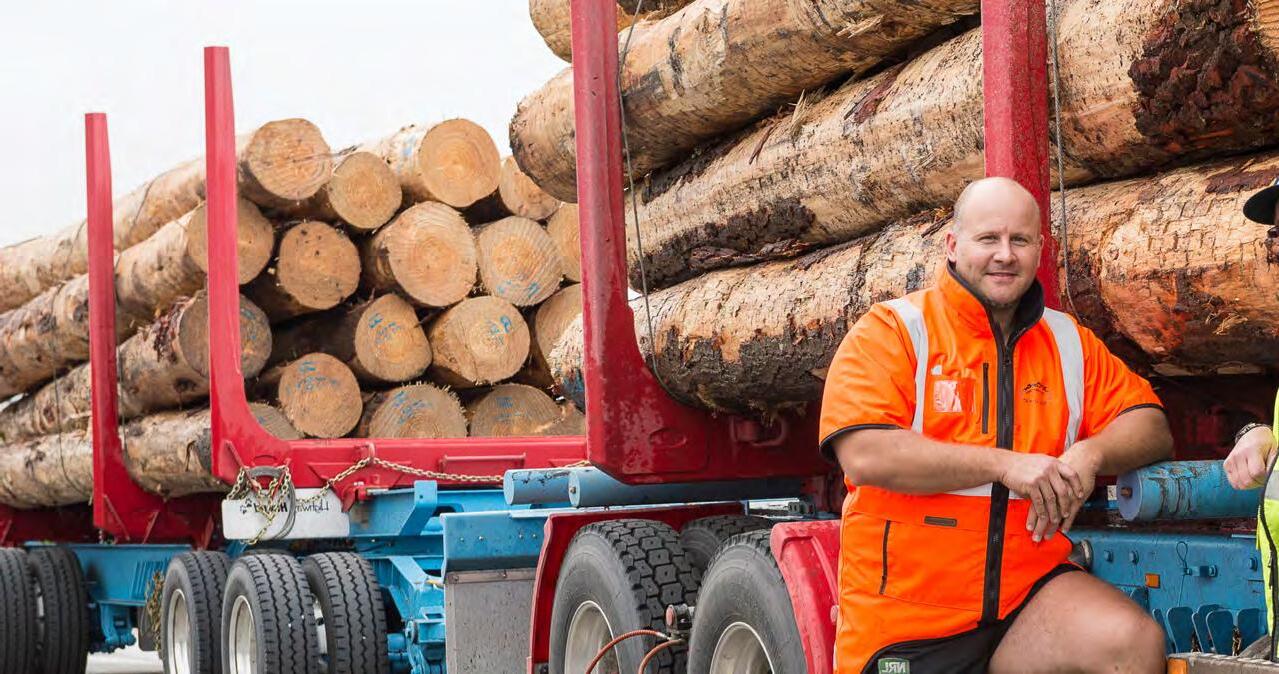
New Zealand Certificate in Commercial Road Transport (Heavy Vehicle Operator) (Level 3)
This programme will provide you with the skills and knowledge to safely and competently operate heavy rigid vehicles or heavy combination vehicles. This programme goes beyond vehicle licence requirements to enable improved job performance and enhanced employment opportunities – whether you’re new to the commercial road transport industry or an existing heavy vehicle driver.
Enrol at mito.nz/hvo
New Zealand Certificate in Commercial Road Transport (Specialist Driver) – Transportation of Logs (Level 4)
This programme provides heavy vehicle drivers with the skills and knowledge required to safely and competently operate heavy combination vehicles, to ensure the efficient transportation of logs.
Enrol at mito.nz/logtransport

MITO is a business division of Te Pūkenga – New Zealand Institute of Skills and Technology. We support on-job learning and career development for the automotive, transport, logistics and extractive industries.
Photographer Jaymin McGuire spotted an eye-catching beauty on a Saturday morning in Whangārei: a 2024 Kenworth T909. Jaymin met and spoke with the driver, Hayden Baker, and his five-year-old son Harry, who was on co-pilot duties for their morning run.
Based in Whangārei, Hayden has been with Semco Group for 13 years. He currently drives a T909 with a robust 615hp X-15, 18-speed manual transmission, authorised to run 54 tonnes.
Reflecting on the trucker’s lifestyle, Hayden emphasises the trifecta of freedom, machinery and “not too bad” pay. However, health was the main concern when it comes to the industry’s challenges.
“We have to stop planning our workdays to 14 hours. Doing this leaves no time for healthy eating, healthy sleep and quality family time,” he says. Hayden has noticed how this gruelling schedule can fuel obesity and fatigue, driving good people out of the industry.
Hayden’s journey into the transport industry began straight out of high school; he was always going to drive trucks. For Hayden, the Kenworth T909 epitomises the peak of the trade – the kind of truck every kid wants to drive. Young Harry has a few years before he takes the wheel himself, but with his dad as his mentor, the future of driving looks promising.
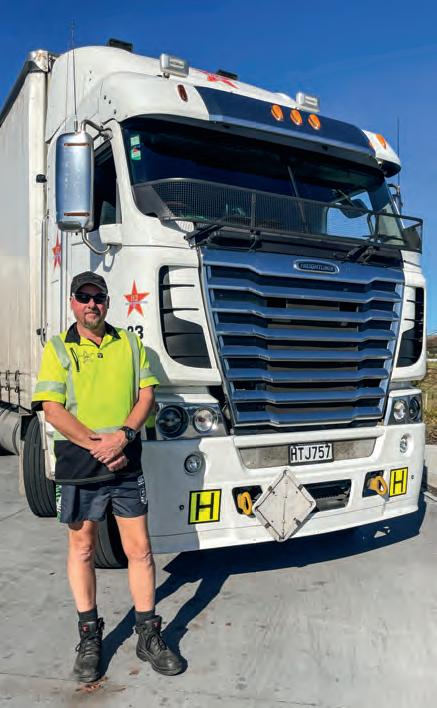
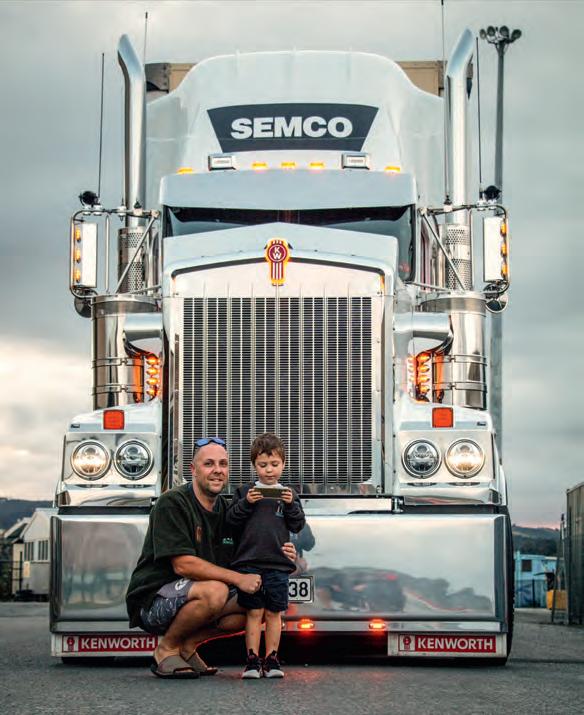
Leo van der Weerd pulled into the BP Connect Bruce Road truck stop off SH2 for his half-hour break while Gavin Myers was parked up for a coffee. Having popped into the Wild Bean to refuel, Leo was keen to have a chat.
Leo drives for H2 Orchard Contracting based out of Te Puke and was heading back to one of the local packhouses for another load of kiwifruit destined for export. “We have 30-odd trucks and service orchards in the Bay of Plenty, up to Auckland and out to Taranaki. These larger trucks are used a lot for port operations,” Leo explains.
Leo had recently changed companies and had only been on the Freightliner for about a month. “It runs a DD15, which has just been rebuilt, and an 18-speed Eaton Ultrashift. It’s done 1,400,000km, and like most trucks that have done a lot of Ks, it needs a bit of loving. A few bits and pieces need replacing, but it’s not too bad.”
While he’s been in New Zealand driving trucks since 2017, Leo says his main job was as a printer of magazines and newspapers. “When I worked in Australia, we only worked three days a week. So, I’d do a day here and there driving for a mate. I’ve had my licence since I was 18 – I’m 62 now, so a while…” he chuckles.
Having just had lunch, Gavin thought a food-related vexing question would be appropriate. Leo was given the choice of a steak and cheese pie or Maccas. “I’d rather go for the pie, mate. I don’t like cardboard,” Leo replies. “I try to eat healthy, but when you’re starting at 5am and you’re in a rush to grab something to eat, a decent pie and coffee to keep you going is usually what it is. I’d usually have sandwiches and a healthy drink, but I’m entitled to one piece of junk a day.
“Don’t tell my wife…” he adds with a laugh.

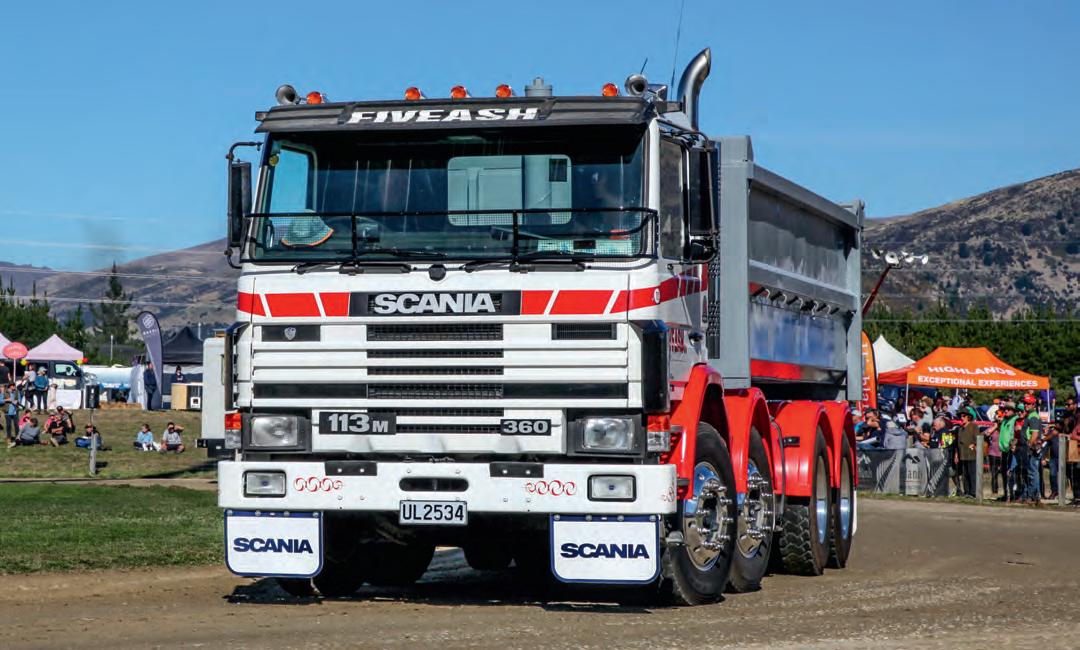
•
•
•
•
•
•
•
•
•
GCA7
•
•
•
•
GCA3
•

GCA8
Superior sidewall cut resistance. Long tread life, exceptional casing durability. Enhanced stability and riding comfort.
GCA8

•
•
•


•
•
•
Christchurch-based Fiveash Contracting’s immaculate 1996 Scania 113M proudly on display in the parade ring in 2021. She would easily still earn her


• Superior sidewall cut resistance.
The extra-deep tread pattern is specially designed for loaders.
• Long tread life, exceptional casing durability.
Excellent performance on extremely rocky surfaces, in open pits, quarries, and underground mines.
• Enhanced stability and riding comfort.




• Unique non-directional traction patterns ensure optimum traction and prolongs tread life.
GCA3
• Superior sidewall cut resistance.
• Good self-cleaning with groove stone ejector
• Applications: Articulated dumper, dozer, loader, and graders.
• This deep tread is particularly suitable for loaders and dump trucks operating in quarries or mining.
• The extra-deep tread pattern is specially designed for loaders.
Non-directional deep tread pattern designed for muddy and soft surfaces.
Excellent traction and floatation offer comfortable handling.
• Excellent performance on extremely rocky surfaces, in open pits, quarries, and underground mines.
Superior long tread life and excellent puncture resistance.
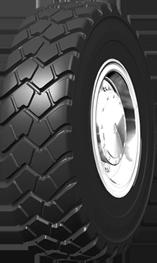
Low rolling resistance and fuel economy
GCB5
• Articulated dumpers, rigid dumpers, loaders, graders.
• With excellent traction and buoyancy performance.
• Outstanding stability and operating comfort, with large pattern plate and long service life.
GCA3
• Non-directional traction and standard tread depth pattern design.
• Applications: Articulated dumper, dozer, loader, and graders.
• Excellent performance supported with heat resistant compounds.
• Non-directional traction and standard tread depth pattern design.
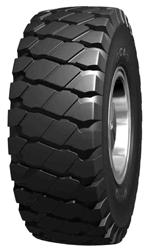
• Primarily designed for mining, off the road, and muddy surfaces.






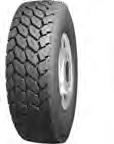
• Excellent performance supported with heat resistant compounds.
• Primarily designed for mining, off the road, and muddy surfaces.

GCA2
• Non-directional deep tread pattern designed for muddy and soft surfaces.
• Excellent traction and floatation offer comfortable handling.
• Superior long tread life and excellent puncture resistance.
• Low rolling resistance and fuel economy.




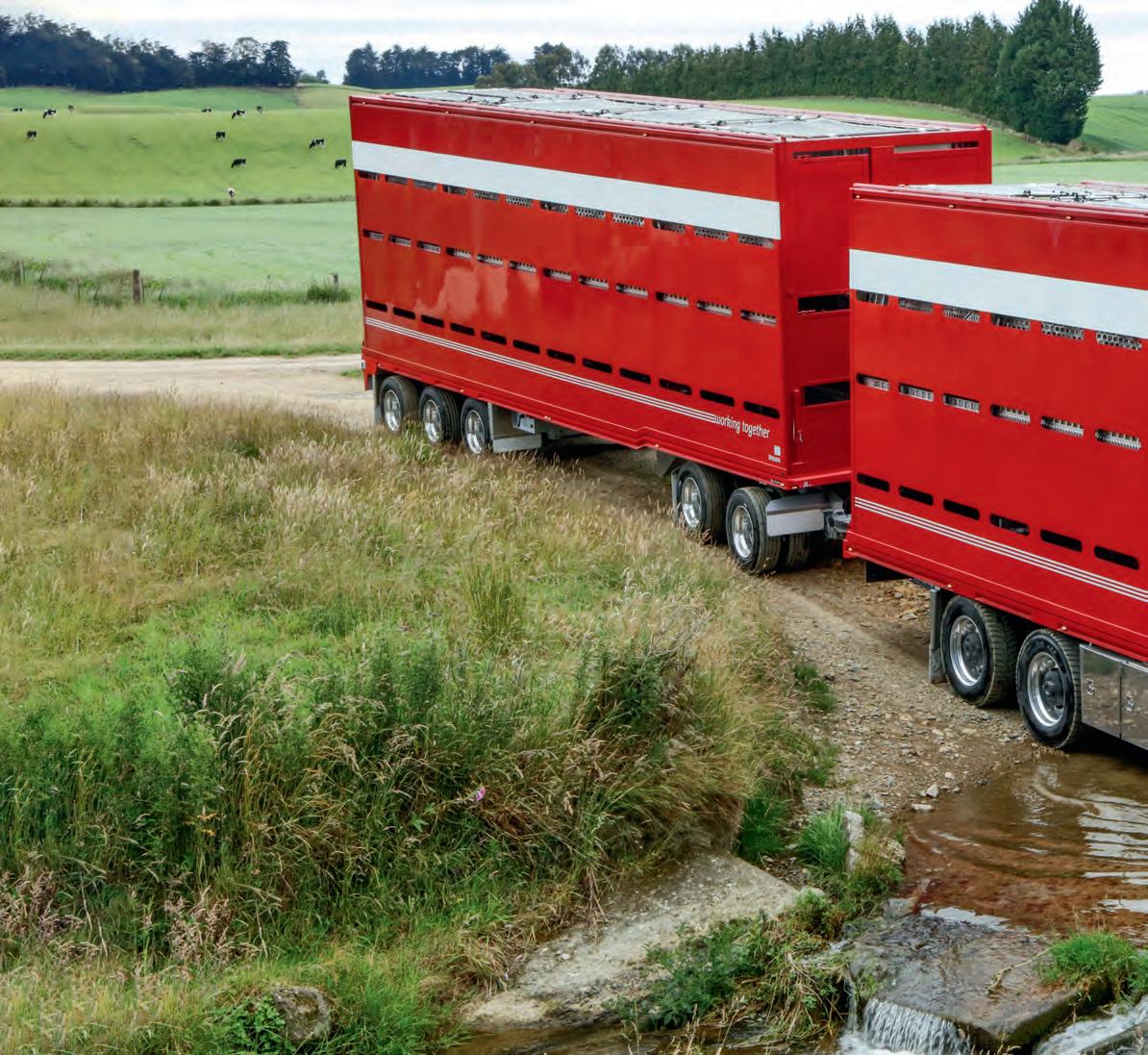
Red trucks have serviced the rural community of West Otago for close to threequarters of a century. Meet a man who has been behind the wheel of a West Otago Transportbranded truck for two-thirds of that time.
Road Transport Logistics (RTL) is an Otago-based rural transport business that encompasses four brands, Beckers Transport, Clinton Waipahi Holdings, Tuapeka Transport and West Otago Transport.
Owned by the Robertson family, the business operates 57 trucks from seven strategic locations.
The operations mantra is ‘working together to provide the best solution to the needs of their clientele’, with the utilisation of equipment being paramount. Opportunities to manage the variation in seasonal workloads
are handled by bringing in trucks from other depots to help out, ensuring customers get the best service possible.
RTL continues to use the liveries of its founding companies, enabling each community a connection with its local carrier.
West Otago Transport had its beginnings in 1956 with the amalgamation of Edievale Transport and Heriot Transport.
Errol Steel joined the company on 15 February 1979. At the time he was a self-employed agricultural contractor, mainly doing vacuum silage, when the work suddenly stopped.
He explains that the farm consultants of the era told the farmers that they didn’t need to make winter feed. “I went from having nine months’ work each year to nine weeks.”
In this era, West Otago Transport was owned by Charlie Brenssell, Ken Thompson and Jim McCabe.
Charlie and Ken arrived on Errol’s doorstep one evening, saying a sower [fertiliser spreader] was sitting in the yard for him to drive “whenever it suited him”.
Errol took up the offer and began his truck driving career behind the wheel of a Commer
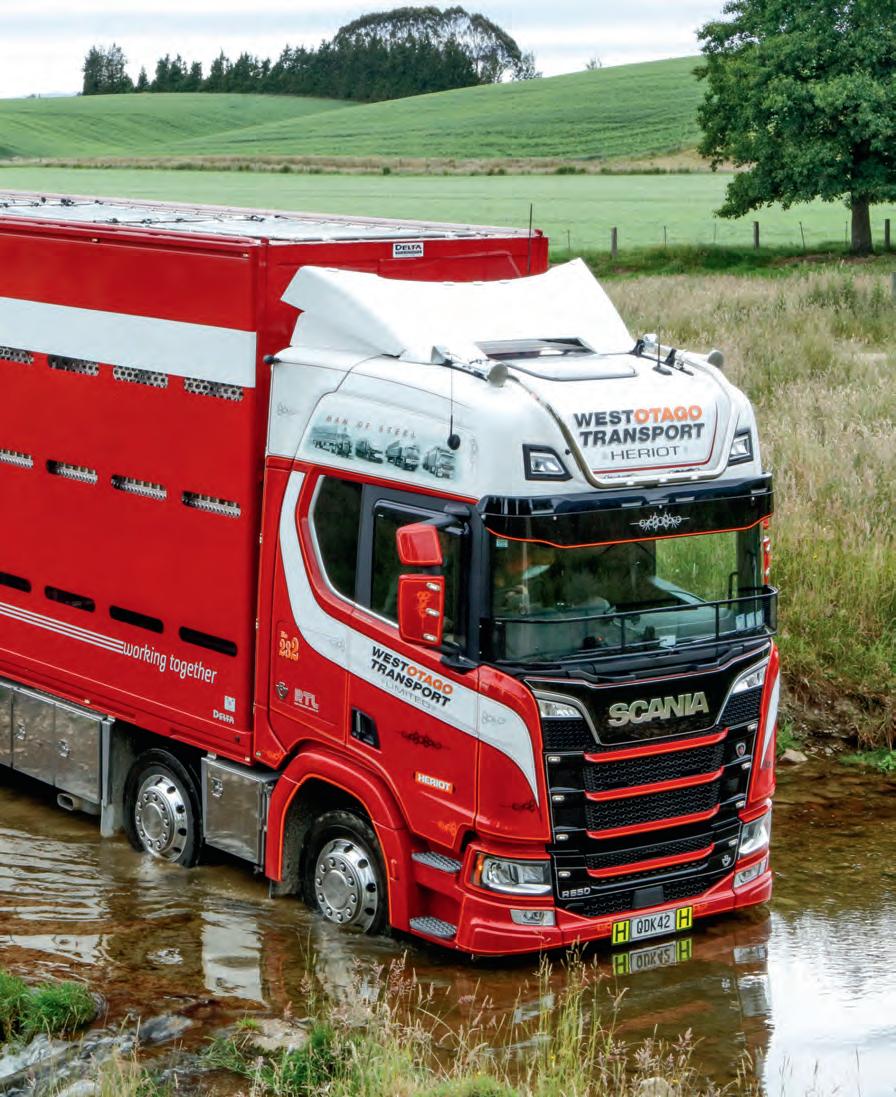
Hi-Line, spreading fertiliser on farms around the district.
His initiation to the livestock cartage trade came shortly after, behind the wheel of the company’s Bedford S Series 4x2 tractor unit and single-axle semitrailer.
Operating in the precombination stock crate era, the Bedford had a single-deck cattle box and a two-deck crawlthrough sheep crate, which were swapped depending on what was being carted.
Work in the pre-deregulation era was largely localised. Heriot was located at the end of the Tapanui branch railway, and
much of the workload involved carting from or to the local rail siding.
Cattle and sheep were brought into Heriot and loaded on the train wagons, many destined for the Burnside saleyards in Dunedin.
Errol recalls the last-ever load of sheep from the district to depart on rail. “Dale Rea walked a mob from his farm in Crookston (7km away) to Heriot and put them on the train destined for the works in Mataura. The train went to Waipahi where the wagons were supposed to have been attached to a train heading south. They instead ended up
had superseded the separate crates required for sheep and cattle.
West Otago Transport was sold to Southland Freight Haulage Ltd (FHL) in 1982 and Bernie Osborne, who was with the company at Nightcaps, moved over to manage the Heriot branch.
Errol recalls his time driving the Fuso fondly; under FHL ownership there was a variety of work, including carting aluminium between storage areas and the shipside at the Tīwai Point aluminium smelter, near Bluff.
An International T-Line was his next steed. Work was largely centred around livestock cartage. However, during the off-season, a set of Harmon bins was fitted to the decks on occasion for carting lime and fertiliser.
Southland Frozen Meat and Produce Export Company, a large meat processing company with plants located at Mataura and Makarewa (north of Invercargill) had a shareholding in FHL.
In order to keep their southern plants operating at capacity, at a certain time of year sheep were sourced from throughout Canterbury.
Bill Gutsell, livestock despatcher from the Gore branch, worked out of the Hotel Ashburton during this period, organising up to a dozen FHL trucks from various depots involved in ferrying the stock south.
in Balclutha and had to wait to be taken back south. Fortyone hours later, they arrived at Mataura.”
Errol had a short interlude from truck driving and worked on a local farm for several months before returning to West Otago.
He returned to drive what was the backbone of many provincial carrier fleets in the 1970s and early 1980s, a Mercedes-Benz 1418 4x2 truck and trailer.
A Mitsubishi Fuso FP112 succeeded the 1418. It was set up similarly to the S Bedford he drove previously, but a combination sheep/cattle crate
One of a pair of Volvo F10s purchased initially by West Otago Transport was Errol’s next truck, and he and the Volvo covered some ground bringing livestock to Southland from Canterbury.
FHL became part of the illfated Transpac venture in 1986. An enduring memory from the era for Errol was the removal of the aluminium bull bar from his Volvo. “Someone got a grinder and just cut the uprights off. Not tidy,” he says.
At the time of Transpac’s demise, the F10 was in North Canterbury and each asset stayed in the depot where they were when the receiver’s hammer fell. Included in this was
The Scania’s air-bag front suspension comes into its own when accessing some farms.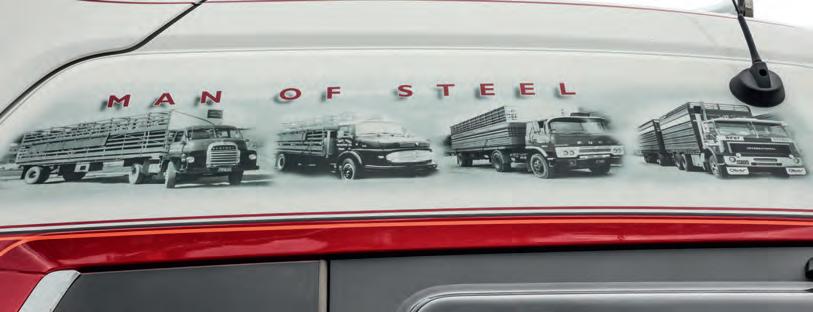
Errol’s personal gear and tools, never to be seen again.
Bernie Osborne, Jim Dynes of Dynes Transport fame, and local farmer Richard Davison combined to buy the Heriot operation and the West Otago Transport name re-emerged in December 1988.
Four-deck trailers became in vogue during the early 1990s and Highway Man was one of a pair of MAN 30.422s put to work in front of Sutton Mono trailers by West Otago.
Due to a general shift in land use, the equipment used in rural transport underwent massive changes, Errol recalls. Much of the flat land around West Otago, previously home to mainly sheep and mixed cropping properties, was being converted to dairying operations.
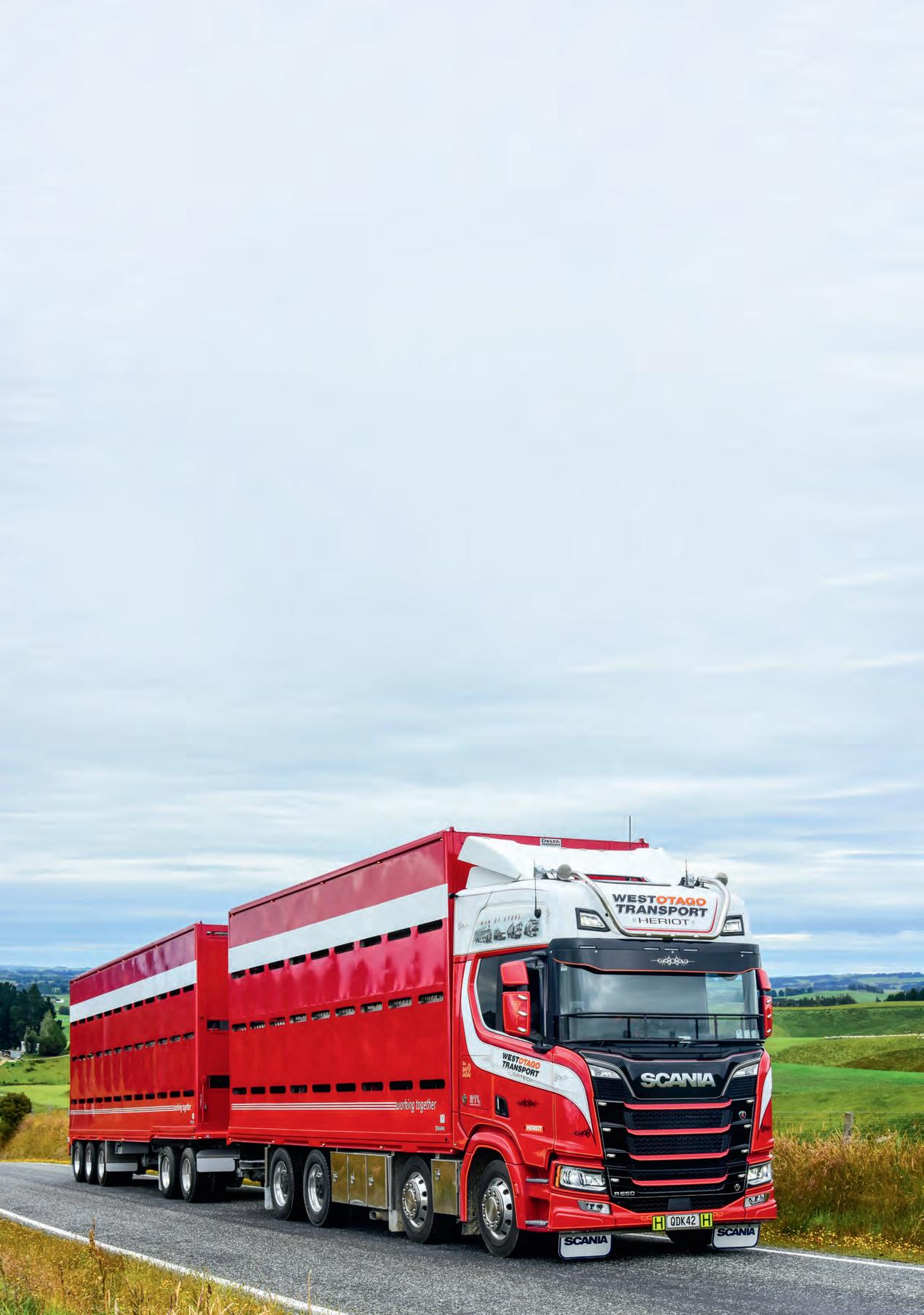
Climbing out of the Volvo and into the MAN signalled the introduction of low-profile tyres, the end of carrying spare wheels, and the change in crate construction from steel to mainly aluminium.
Errol believes advances in communication following the advent of mobile phones were another turning point for the industry. Previously, the only communication with base was by way of the radiotelephone. Errol was an early embracer of technology and purchased his own mobile phone long before they were a standard fixture.
Almost 2,000,000km were clocked up in a pair of DAFs, firstly a CF85 510 that was Errol’s first brand new truck, followed by an XF105.
With the XF coming up for
replacement, RTL operations manager Bruce Robertson explains the company wanted to mark Errol’s service with something a little different for what would potentially be his last truck.
RTL runs several Scanias in the Beckers’ livery and in groundspreading applications across the company.
It’s a brand that Bruce has a soft spot for, having spent time behind the wheel of one during his driving career.
“Scania is quite a variation from our usual replacement policy at West Otago; we just wanted this one to be a bit special,” says Bruce.
“There’s nothing wrong with any of the other product we run here. We just wanted this truck to have some useful safety
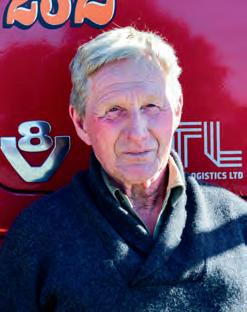
technology, and both comfort and chassis height were also considerations.”
A Scania R650 fitted all these requirements. The ability to spec a truck with an air-bag front suspension was seen as a good move. Being able to raise the front end clear of obstacles when accessing rural properties was also seen as advantageous.
RTL is very much a family business. Bruce and wife, Shona, have operated the company in partnership for many years, with Shona fulfilling the role of chief executive officer.
The next generation of Robertsons, daughter Sydney and son Tait, came up with a stripe design that fitted with the rest of the West Otago fleet, but particularly suited the Scania’s rounded cab lines.
The ‘Man Of Steel’ pictorial tribute on the Scania’s cab. Right: Errol Steel, 75 years young and still carting livestock.


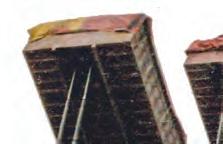

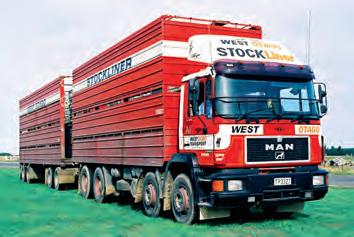

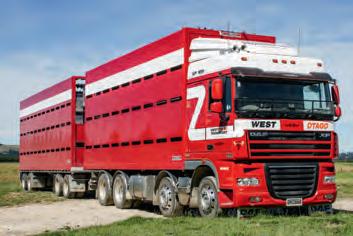
MD Engineering built the fiveaxle trailer towed by the Scania. RTL predominately runs MD gear on livestock and the company is very complimentary of the product Michael Jelley and his team produce.
Likewise, the operation has a long relationship with Blair Cochrane at Delta Stock Crates in Tīmaru. “Delta have always been good to us; they’ve provided good service,” Bruce says.
RTL is very proactive in pursuing new technology or features that make the drivers’ work easier.
Springs have been fitted to all the second-deck left-side sheep floors to assist with lifting them up during the unloading process. Both crates are full fourdeckers; the truck is 7.6m (25ft) long, and the trailer measures 10.7m (35ft) in length.
RTL has found that this combination suits the operation well, both in terms of the pen size for the animals and the capacity for loading store stock. Andrew Geddes of Tīmaru
Signs & Graphix worked with Bruce to create a little pictorial tribute on the side of the Scania’s roof, featuring pictures of some trucks Errol had driven.
It carries the name Man of Steel, a neat descriptor Errol has become known by in the industry.
At 75 years of age, Errol reckons he still has a bit of work left in him. In his words, he can’t retire yet because “Bruce keeps finding me another job to do”.
A good-looking, well-set-up truck operated by a progressive business and driven by a man with a comparable level of commitment to serving the rural community, make the Road Transport Logistics Scania R650 a deserving winner of New Zealand Trucking’s Top Truck award for June 2024.
The final word comes from Bruce Robertson, who says, “It is quite humbling to have someone with you for so many years. His long driving career and service to the company is very much appreciated by us all.”
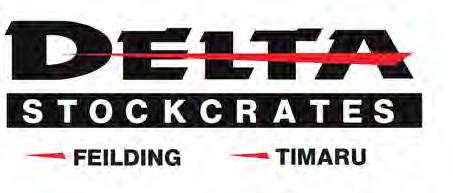
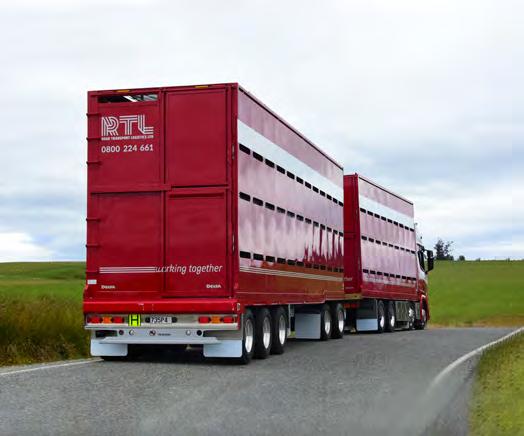 1) Errol’s first livestock truck, an S Bedford. 2) Mercedes-Benz 1418. 3) Fuso FP and single-axle semi. 4) West Otago Transport reborn, post-Transpac. The International T Line and Volvo F10 were both driven by Errol. 5) MAN 30.422 and Sutton two-deck/four-deck trailer. 6) DAF CF85 510. 7) DAF XF105 510.
1) Errol’s first livestock truck, an S Bedford. 2) Mercedes-Benz 1418. 3) Fuso FP and single-axle semi. 4) West Otago Transport reborn, post-Transpac. The International T Line and Volvo F10 were both driven by Errol. 5) MAN 30.422 and Sutton two-deck/four-deck trailer. 6) DAF CF85 510. 7) DAF XF105 510.


OPERATOR: Hog Haulage, Taupo
ENGINE: Cummins X-15 15L 459kW (615hp) 2779Nm (2050lb/ft)
TRANSMISSION: Eaton Roadranger
RTLO22918B and 18-speed manual
REAR AXLES: Meritor MT21-165GP with full cross locks
3 x Kenworth K200 6x4 tractors –2.8m Aerodyne sleeper cabs
REAR SUSPENSION: Kenworth Airglide
460 air suspension
BRAKES: Drum. ABS, EBS
SAFETY: ABS, EBS
BODY/TRAILER: Various combinations
FEATURES/EXTRAS: Kentweld bumpers, classic grille bars, TV, painted drop visors,
MAN TGM 26.320 6x4 rigid – day cab
OPERATOR: Streamline Environmental & Drainage, Hamilton
ENGINE: MAN D0836M Euro-5 240kW (320hp)
1250Nm (922lb/ft)
TRANSMISSION: ZF nine-speed manual
REAR AXLES: MAN hypoid
REAR SUSPENSION: Parabolic springs throughout BRAKES: Disc. ABS
SAFETY: ABS
BODY/TRAILER: Waste/vac body fitted by Dietmar Kaiser of Liechtenstein
FEATURES/EXTRAS: Sun visor, stone guard
PAINT: Factory
OPERATION: Waste water and drainage servicing throughout the Waikato and Auckland districts
SALES: Mitch James
Chris Stanley custom stainless steel fittings
PAINT: Factory
SIGNAGE: TCC Solutions, Favona
OPERATION: Interisland linehaul duties throughout the country
SALES: Tim Finlay
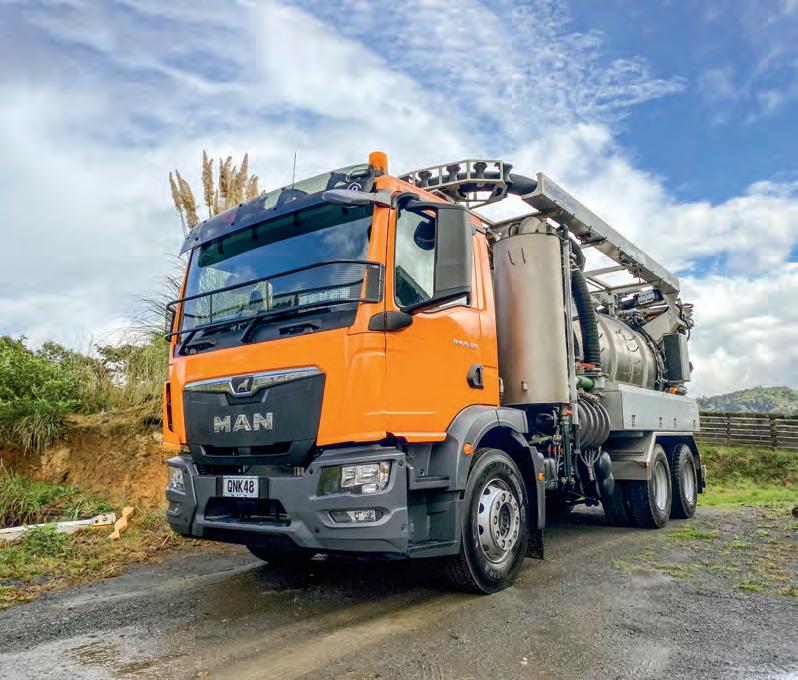
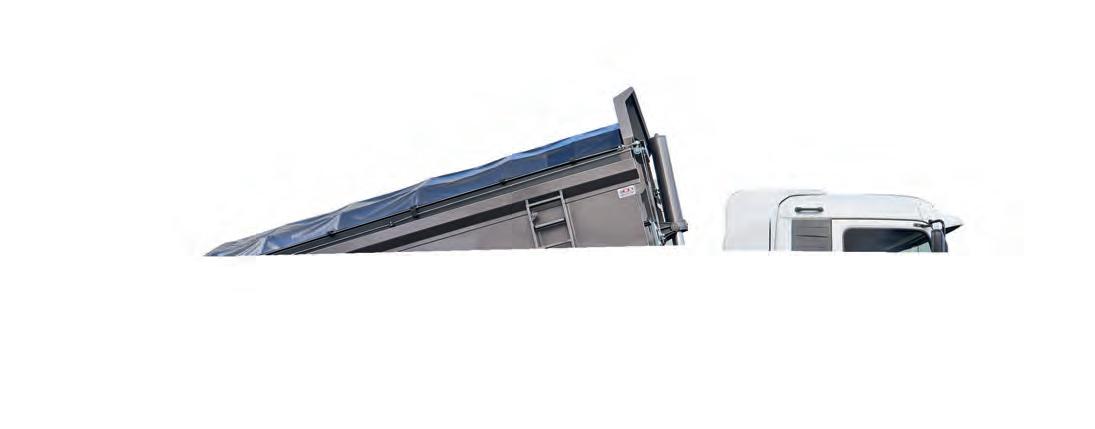
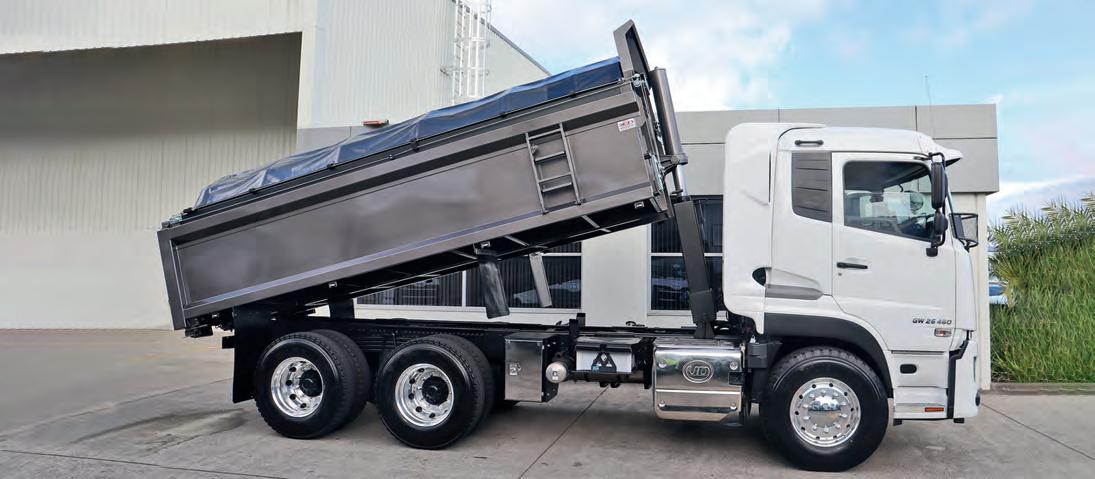
OPERATOR: JDN Construction, Kopu
ENGINE: UD GH11TD 343kW (460hp)
2250Nm (1659lb/ft)
TRANSMISSION: ESCOT-VI 12-speed AMT
REAR AXLES: Meritor hypoid with cross locks
REAR SUSPENSION: UD spring
suspension
BRAKES: Disc. ABS, EBS
stone guard, Loadsense onboard scales
PAINT: Factory
SAFETY: ABS, EBS, ESC, LDW, LCS, ACC, EBA
BODY/TRAILER: CWS steel tipper body with matching CWS four-axle tipper trailer
FEATURES/EXTRAS: Alcoa alloy rims throughout, Airplex side skirts sun visor and
Volvo FM540 6x4 tractor – sleeper
OPERATOR: Main Road, Otorohanga
ENGINE: Volvo D13C 397kW (540hp) 2600Nm (1929lb/ft)
TRANSMISSION: Volvo I-Shift 12-speed AMT
REAR AXLES: Volvo RTS2370B
REAR SUSPENSION: Volvo eight-bag air suspension
BRAKES: Disc. ABS EBS
SAFETY: LCS, LKA, DAS, ACC, EBA
FEATURES/EXTRAS: Fridge, heated seats, factory bull bar, stone guard, tool lockers
PAINT: Factory
SIGNAGE: Truck Signs, Mt Maunganui
OPERATION: General freight duties throughout the North Island
DRIVER: Daniel Mateni
SALES: Mark Ellerington
OPERATION: Deliveries of fertiliser to the local Thames Valley farms, as well as quarry rock and aggregate through to the BOP
DRIVER: Davy Jones and Tim Berendsen
SALES: Nigel McFadyen
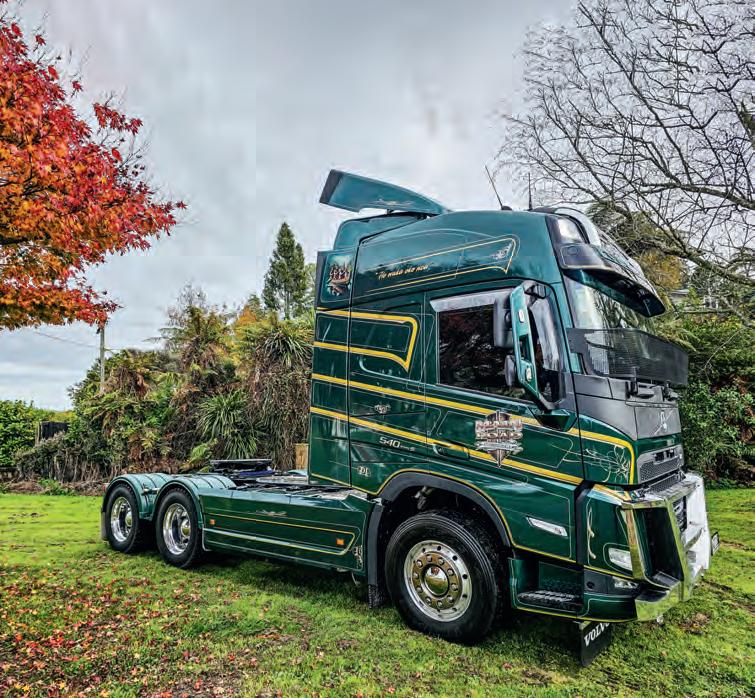

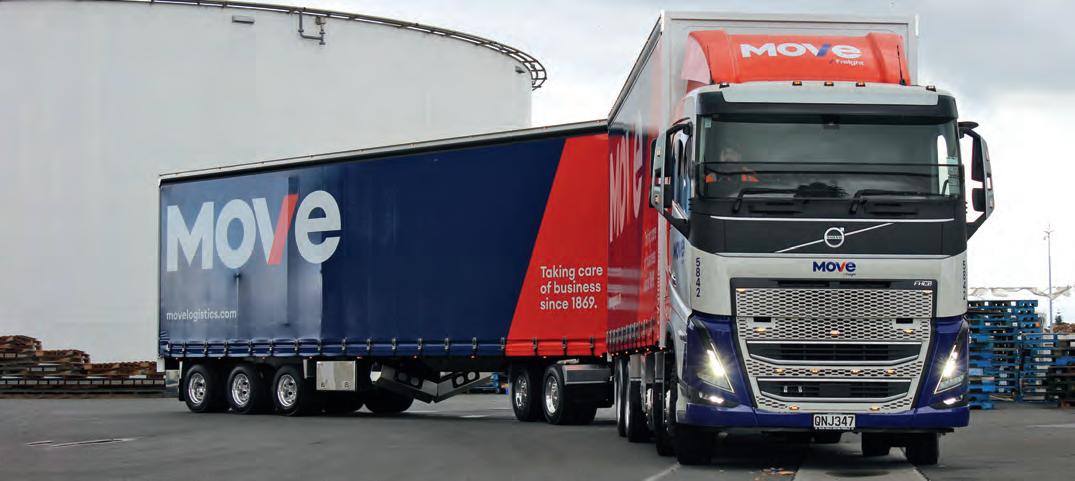
OPERATOR: Punjabi Drivers, Tauranga
ENGINE: Volvo D16 448kW (600hp) 2800Nm (2065lb/ft)
TRANSMISSION: Volvo I-Shift 12-speed
AMT
REAR AXLES: Volvo RTS2370B suspension
BRAKES: Disc. ABS EBS
SAFETY: LCS, LKA, DAS, ACC, EBA
BODY/TRAILER: Koromiko curtain-sider body and matching five-axle trailer
FEATURES/EXTRAS: Fridge, heated
PAINT: Haddock Spray Painters, Whakatane
SIGNAGE: Marty’s High Performance Signs, Mt Maunganui
OPERATION: General freight duties
DRIVER: Lovejeet Singh
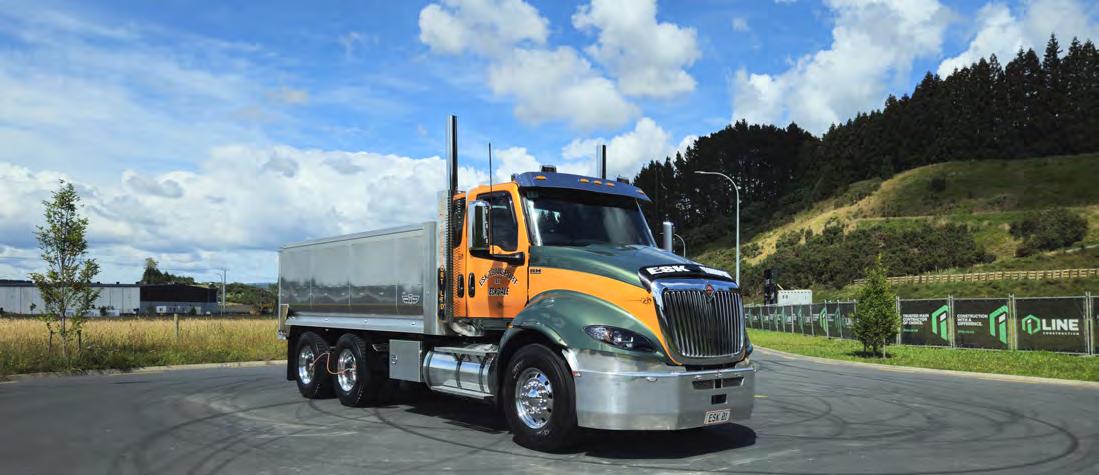
OPERATOR: Esk Transport, Eskdale
ENGINE: Cummins X-15 15L 459kW (615hp) 2779Nm (2050lb/ft)
TRANSMISSION: Eaton Roadranger
RTLO22918B and 18-speed manual
REAR AXLES: Meritor RT46-160GP
REAR SUSPENSION: International IROS
BRAKES: Drum. ABS
SAFETY: ABS
BODY/TRAILER: Transport & General Transport Trailers tipper body
FEATURES/EXTRAS: Ali Arc polished front bumper, stainless-steel visor, Premium-Plus interior trim, twin exhaust
stacks, CTI, chrome alloy wheels
PAINT: Factory
OPERATION: Bulk aggregate movements throughout Hawke’s Bay
DRIVER: Peter Harwood
SALES: Hugh Green

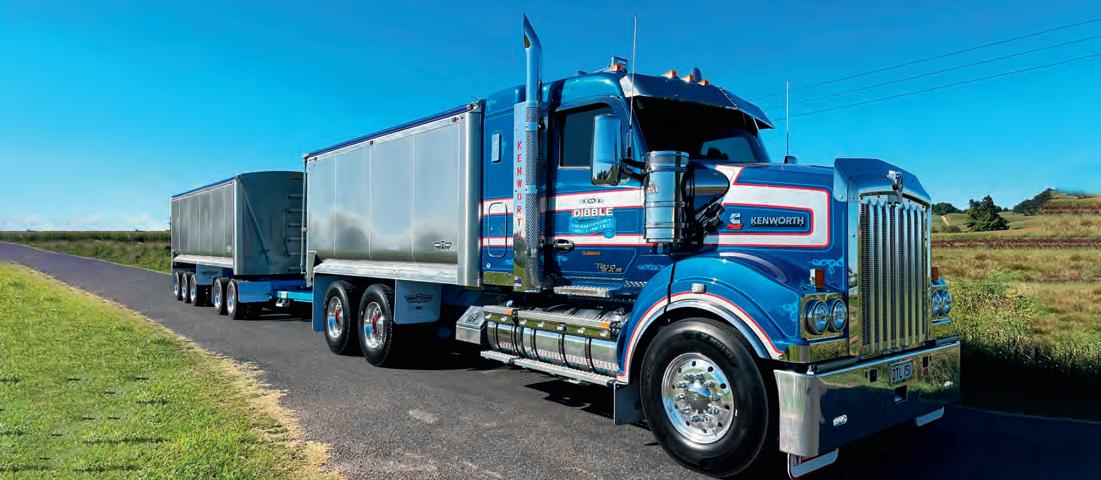
OPERATOR: Dibble Transport (1997), Te Awamutu
ENGINE: Cummins X-15 15L 459kW (615hp) 2779Nm (2050lb/ft)
TRANSMISSION: Eaton
Roadranger RTLO20918B and 18-speed manual
Kenworth T610SAR 6x4 rigid – 760mm Integral sleeper cab
REAR AXLES: Meritor MT46160 with full cross locks
REAR SUSPENSION:
Kenworth Airglide 460 air suspension
BRAKES: Drum. ABS, EBS
SAFETY: ABS, EBS
BODY/TRAILER: Transport &
OPERATOR: Loader Transport, Hawke’s Bay
ENGINE: Scania DC16 16L Euro-6 574kW (770hp) 3700Nm (2729lb/ft)
TRANSMISSION: Scania Opticruise GRSO926R 12-speed
AMT with 4100D retarder
REAR AXLES: Scania RB735 hub reduction
REAR SUSPENSION: Scania air suspension (front springs)
BRAKES: Disc. ABS, EBS
SAFETY: ABS, EBS, AEB, ACC
BODY/TRAILER: Tractor unit setup by Hogan Contracting of Putaruru
FEATURES/EXTRAS: Scania scales, fridge, coffee machine, microwave, V8 leather trim, overnight A/C unit, CTI, Alcoa Dura-Bright alloy rims all around
PAINT: Fleet Image
SIGNAGE: Caulfield Signs and Graphics, Rotorua
OPERATION: Machinery and heavy haul throughout the wider Hawke’s Bay
DRIVER: Richard Sykes
SALES: Callan Short
General Transport Trailers tipper body and matching five-axle trailer
FEATURES/EXTRAS: Alcoa Dura-Bright alloy wheels, 42L incab fridge, stainless-steel drop visor, bug deflector, 7in factory GPS with full gauge pack, twin
6in exhaust stacks
PAINT: Factory
OPERATION: Bulk commodities throughout central North Island
DRIVER: Stephen Collins
SALES: Adam McIntosh

AB – Air Bag
ABS – Antilock Braking System
ACC – Adaptive Cruise Control
ABA – Active Brake Assist
AEB – Autonomous/Active Emergency Braking
AEBS – Advanced Emergency Braking System
ALA – Active Lane Assist
ASR – Anti Slip Regulation / Auto Slip Regulation
ATC – Automatic Traction Control
BAS – Brake Assistant System
BB – Brake Blending CAB – Curtain Air Bag
DA – Driver Alert
DAS – Driver Assistant Support
DM – Driver Monitoring
DS – Driver Support
DTC – Drag Torque Control
EBA - Emergency Brake Assist
EBS – Electronic Braking System
EBSS – Electronic Braking Safety System
ESC – Electronic Stability Control ESP – Electronically Stability Programme
– Forward Collision Avoidance FCW – Forward Collision Warning
– Front Under-run Protection
HH – Hill hold
– Hill Start Assist
- International Ride
Suspension
– Lane Change Support
– Lane Departure Warning LG – Lane Guard LKA – Lane Keep Assist
PCS – Pre Collision System
PD – Pedestrian Detection
RB – Reversing Buzzer
RM – Rocking Mode
RW – Reverse Warning
SAB – Side Air Bag
SC – Speed Control
SD – Side Detection
SGA – Side Guard Assist
TEBS – Traffic Eye Braking System
TECC – Traffic Eye Cruise Control
TPM – Tyre Pressure Monitoring
VSC – Vehicle Stability Control
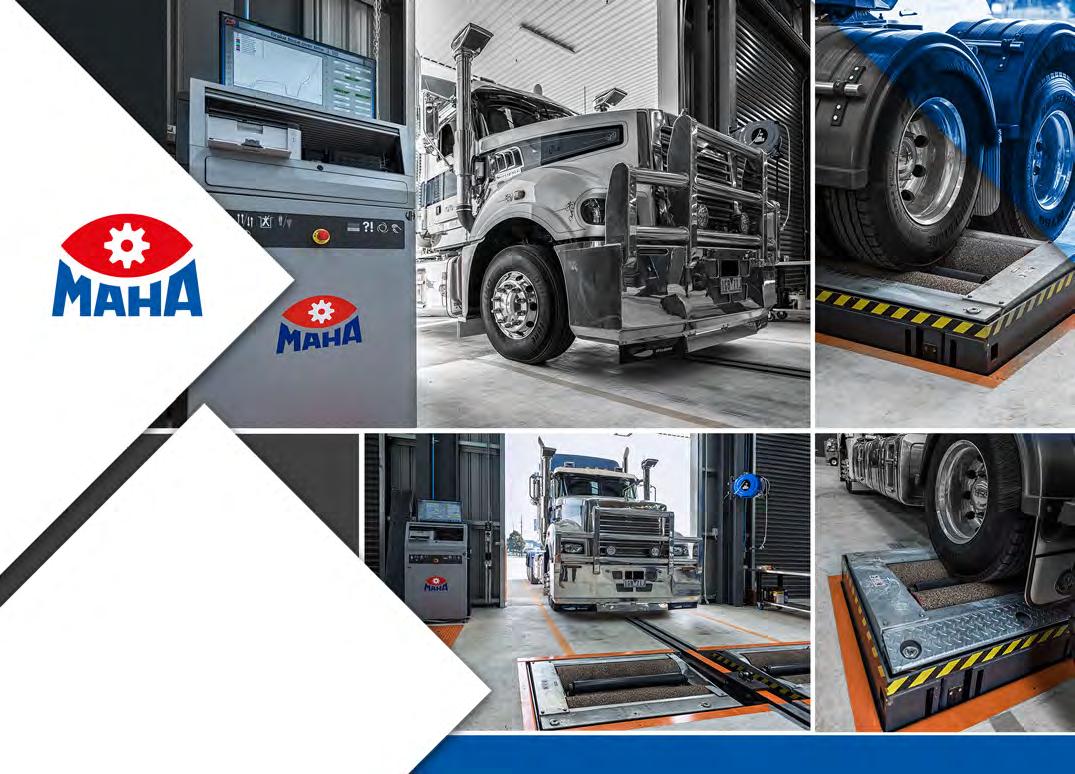
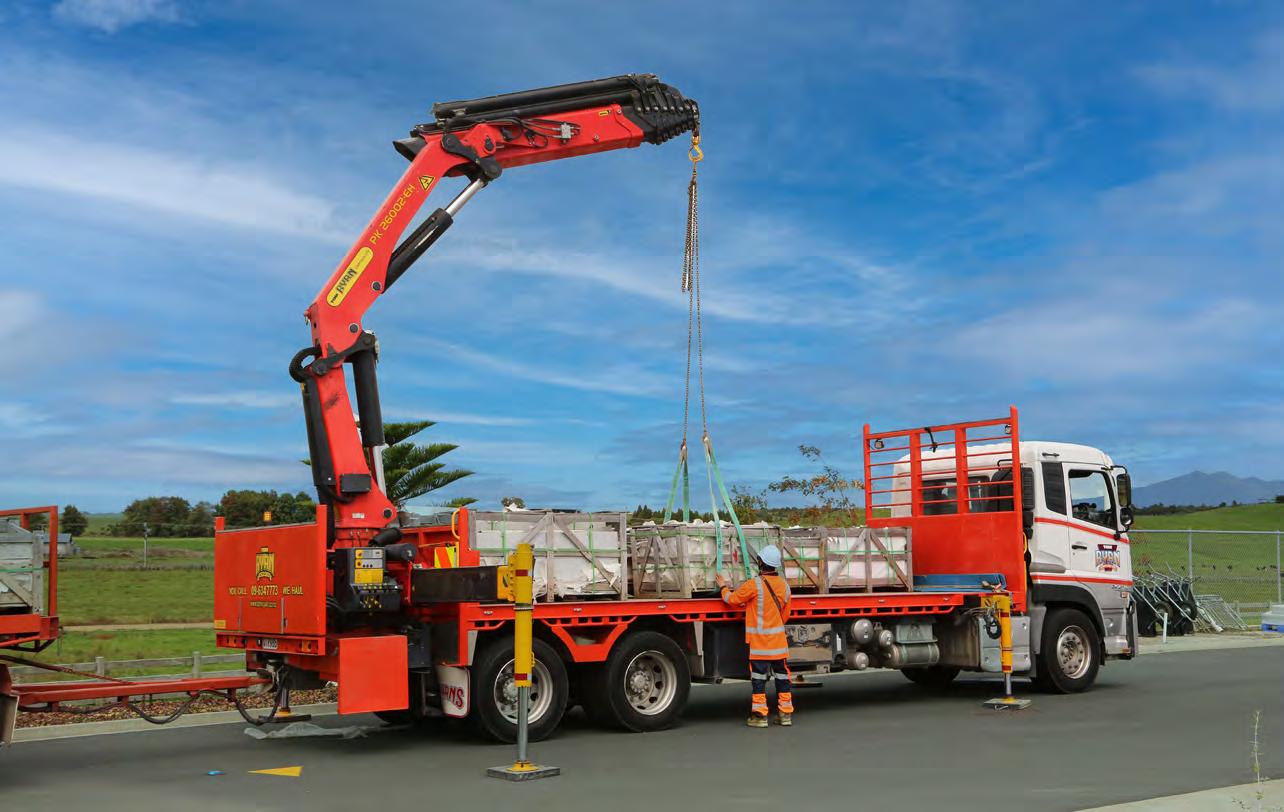



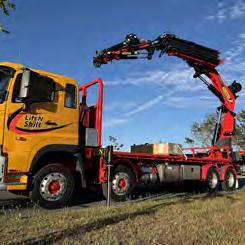
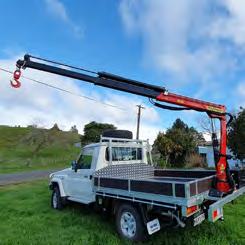
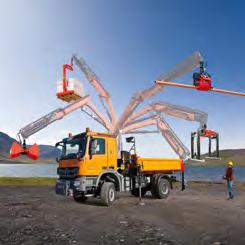
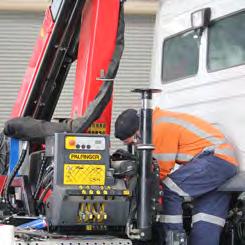
New Zealand has a rich heritage of body and trailer building, and we’re proud to showcase some recent examples of Kiwi craftsmanship every month. To feature on these pages, send a photo, features and the manufacturer’s name to carl@nztrucking.co.nz.
Looking for a versatile build for its new UD Quon, HEB
Construction got chatting with the team at TES.
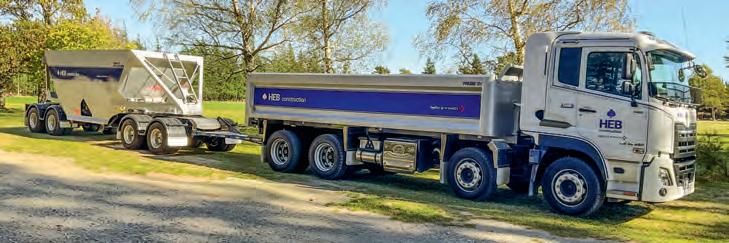
Step one was a hardwearing Hardox tipping bin, complete with Edbro FOB hoist plumbed with live-drive, as well as a two-way tail door.
Step two was to pair the UD with a four-axle bottom dumper trailer. SAF Intradisc axles are paired with Wabco EBS. Hella LED lighting completes the package.
A new six-axle HPMV curtain-sided B-train capable of 36 pallets was the order of the day for 4D Freight, so a talk to the team at Roadmaster in Rotorua had this sharp build heading into production.
Featuring an 8350mm A-unit and 10,350mm B-unit running 19.5in ROR axle sets on air suspension makes for a well-balanced drive, and with plenty of storage, it certainly makes working with the trailers a breeze.
FEATURES: Aluminium chequerplate chassis infills, SAF Intradisc axle sets, Hella LED lighting. Transport Engineering Southland
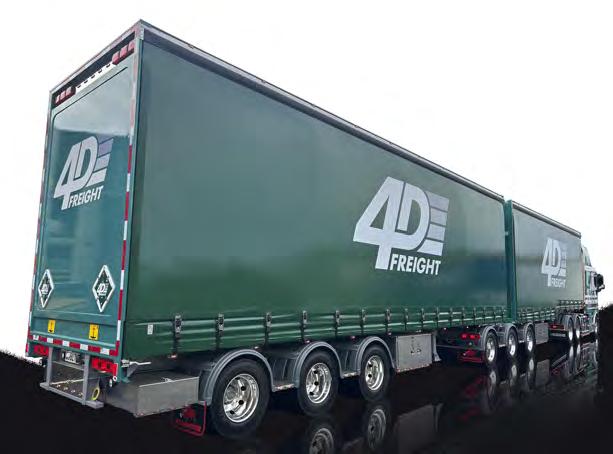
FEATURES: Custom dunnage box with stainless steel hatches, custom tool lockers, custom stainless steel bumpers and light bars, Hella LED lighting. Roadmaster, Rotorua
Since 1953
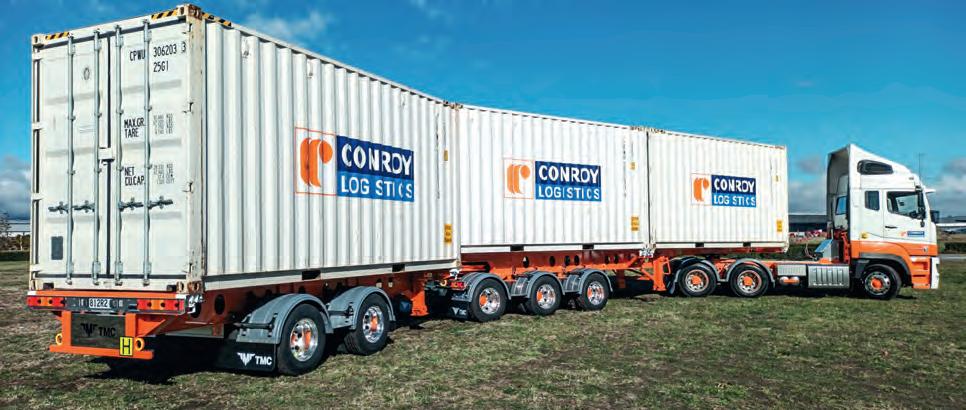
Conroy Removals New Zealand has recently taken delivery of this crisp new TMC skeletal B-train, to complement its linehaul container operations. The combination has been designed with efficiency
FEATURES: 19.5in ROR axle sets on air suspension, Hella LED lighting.
TMC Trailers, Christchurch
in mind. With the lead trailer set for either two 20ft containers, or one 40ft, and the rear trailer handling a single twenty footer. Road user charges for the entire B-train come in at just 10.8 cents per kilometre.

FEATURES: 19.5in SAF Intradisc axle sets, custom stainless-steel dock bar infill, custom full-width dunnage box, custom tool lockers. Roadmaster, Rotorua

The premier name in the world of truck and trailer wheels
Delivering the great professional look of a wheel in combination with significant weight saving benefits and the strength of a quality forged aluminium wheel makes ALCOA Wheels stand above the rest.
The need for a specialist nine-axle HPMV by the team at Dave Hoskin Carriers had them calling in the services of Roadmaster. The requirement was a combo to handle and contain wet product. The solution – a full wet-spec combination with 20mm upstands to all deck surfaces, as well as plumbing that leads to twin underbelly tanks on the truck and trailer.

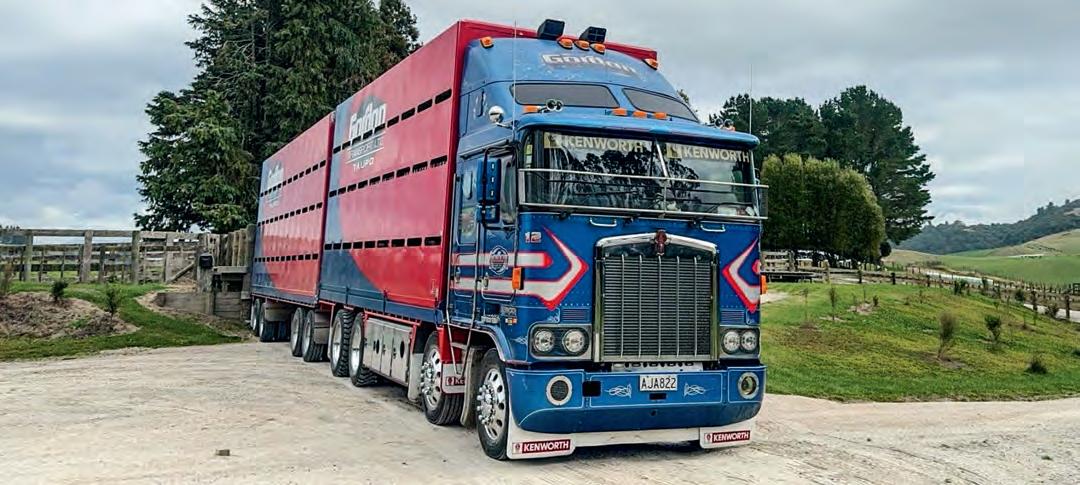
Our first new inductee into the Bridgestone Million Mile Club this month is this extremely tidy 2001 Kenworth K104 stock unit. Originally specced and built for David Pope Cartage Contractors of Greytown, the combination was a striking sight, especially with its white dedicated twodeck cattle boxes, set against the blue of the big Aerodyne cab.
David explains how the truck was ordered through Tom Kerr. “Both myself and Graham Suisted, who was getting the truck to drive, were taken by Tom across to Melbourne to see it come off the assembly line at Bayswater. That was great to experience. We specced it with a Cat, as I had had a good run with the Cats in the Fodens, as well as an old Leader, so in went the C15.”
Graham put the first 640,000km on the clock, running cattle to the works at Hawera or Hastings. “The unit was set up by Trevor Jackson and the team in Pahiatua, with Nationwide boxes. The combination handled like it was sitting on rails. The trailer was built with super-single axles; this gave us extra
New to David Pope Transport in 2001, the

chassis width, so we were able to fit a 1300mm turntable which really helped the stability.”
The truck, still sporting a coat of blue paint and Gordon Transport livery, now resides within the Midlands Rural Transport fleet near Taupo. In the care of Midlands, the K104 has had quite a makeover. A full chassis-up restoration and repaint of the truck was recently completed, with the opportunity being taken to replace and repair worn parts during that process. A fresh C15 with Brake Saver has also been fitted, giving it a new lease of life as well as adding to its capabilities.
When we talked to Gordon’s driver Brianna Bradshaw about her trusty steed,

she was quick to say how privileged she feels to be the current custodian of the K104.
“Yeah, it is a pretty special truck all right; it’s an absolute dream. That’s the reality of it, because I won’t ever get another one like it. They are an endof-an-era truck, and it’s an absolute privilege to have this one to drive. I am making the most of every day I have behind the wheel of it.”
We could not agree more, they really are a cool truck to drive, and once they are gone, they are gone – so enjoying every minute you get behind the wheel of it is definitely the right attitude. Let’s all keep our fingers crossed it’s around for another couple of million kilometres.
Our second new member of the Bridgestone Million Mile Club is this crisp 2000 Freightliner Argosy from the SCS Transport fleet of Christchurch. Affectionately known as Sassy Cat, its name is a clear indication as to what colour the cast iron block is painted under the floorboards.
SCS Transport owner Scott Duff gives us the rundown on the Argosy’s history.
“My sister Shelley originally purchased the Argosy new in 2000, and a few months later we formed SCS Transport together. In fact, it was one of the first three Argosys to hit the road here in New Zealand. We originally specced the truck with a C12 Caterpillar, so it had the low floor in it. Roadmaster did the build, and it was running a four-axle trailer, set out for 32 pallets.
“Unfortunately, in 2006 the unit got tipped over with about 1,000,000km on the clock, and a near-new C12 between the rails. This wrote off the unit. I purchased it back off the insurance company and ordered a new high-tunnel cab out of the United States.
“We did this so it would be compatible with a C15, and eventually we fitted a C15 into it. That went well, but
the C15 eventually gave out. I had a C16 sitting around at the time, so we dropped that into it, as well as fitting a set of heavier 46,000lb diffs and a 22918 Roadranger.
“The C16 is running a C15 ECU, so just sitting at 550hp, but there’s definitely plenty of torque. We have also had Roadmaster stretch the trailer and add a fifth axle.
“So, yeah, it is now a genuine 36-pallet
combination. It is a real shame that Freightliner stopped making the Argosy.
“They are a simple truck to work on, with all the right components – easy to get parts for. Yeah, she’s been pretty awesome for us, averaging around 150,000km per year; she has around 3,500,000km on the clock now. A good workhorse; she’s still doing the job for us.”
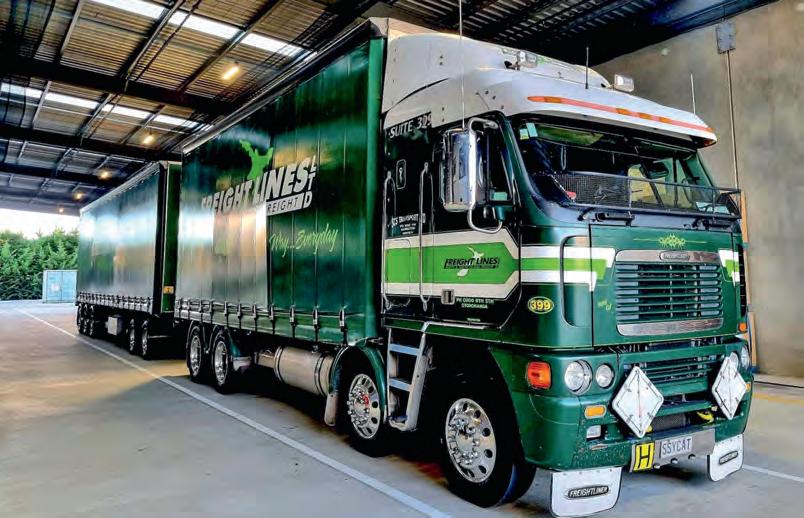
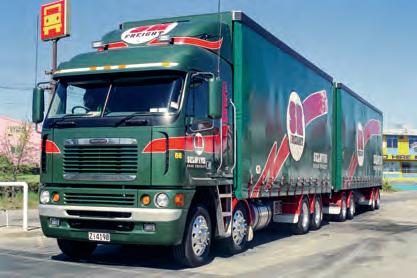
Bridgestone and New Zealand Trucking Media want to recognise trucks that have achieved this milestone in the act of carrying the nation on their backs. Each month, up to eight trucks will be selected, and will feature in the magazine, as well as on our social media.
Sassy Cat in its early days, initially contracted to Selwyn’s Road Freight on linehaul operations. Photo: Ben Uncles.
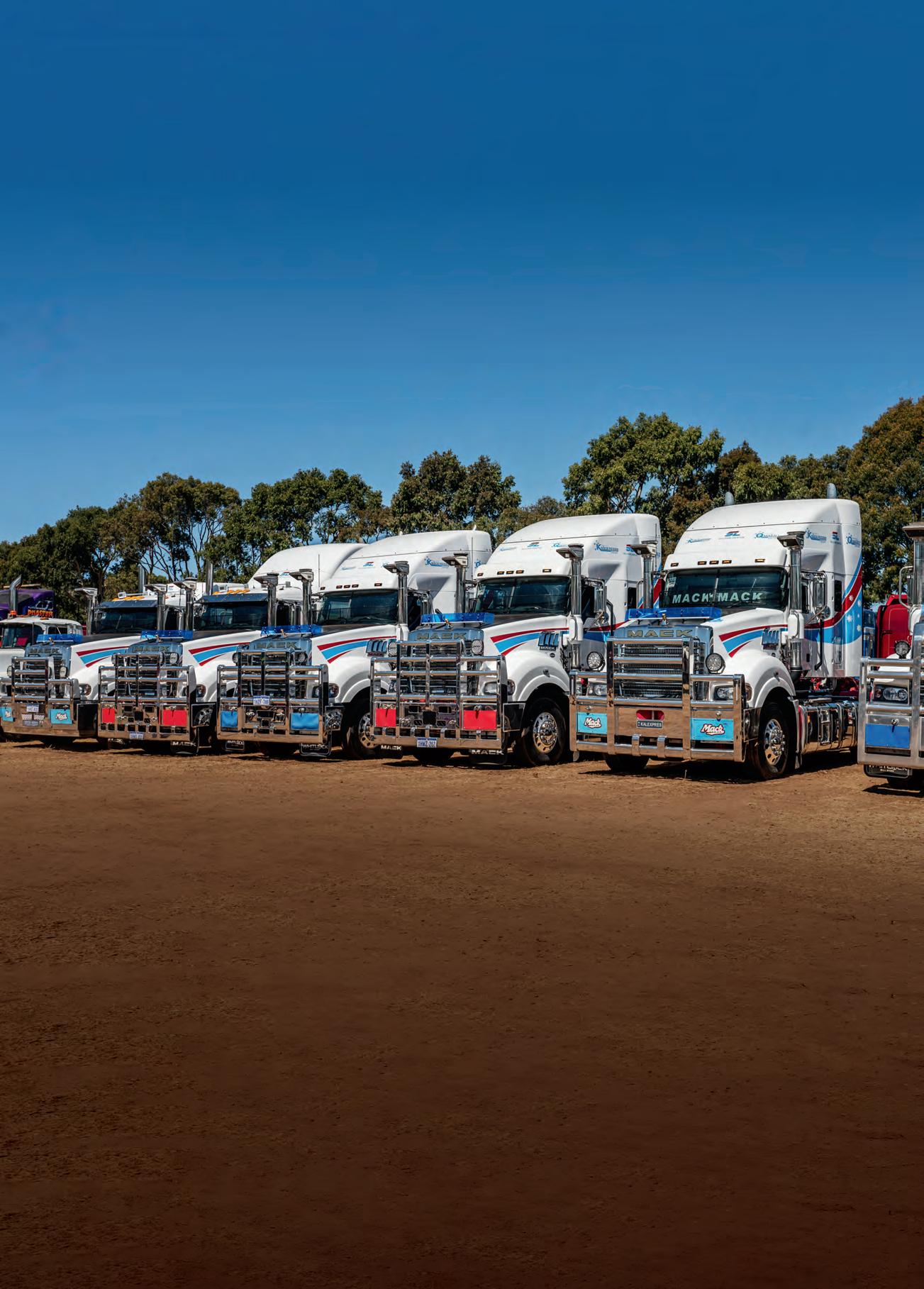
More than 350 trucks registered for the Perth Mack Muster and Truck Show, possibly the biggest Mack muster in Australia, with more turning up on the day in Byford, Western Australia. Some were already there as early as the Thursday before the weekend event in late March; Mack Alley was already half-populated with some of the heavyweights of the West Australia heavy haulage scene. The last V8 built by Mack had rolled in from Kalgoorlie to take pride of place. The Filthy Princess is an absolute legend, and being the very last in her line, she marked a change in direction for Mack. The
unmistakable sound of a Mack V8 simply can’t be replicated.
Friday saw more of the big iron roll in – more of the heavyspecced gear from the north of WA – hardworking highway trucks, bush and farm trucks, and of course, the history-makers. It was hard to decide what to look at. The judges had an unenviable task.
As we walked around checking them out, the only thing I could think was I’d be happy to have any of them in my shed. A sweet red B61 caught my eye. It was so original, it looked like it might have never turned a wheel … I was assured it had worked out in the bush and on a farm for many years.
From hardworking highway trucks to history-makers, this year’s Perth Mack Muster and Truck Show, possibly the biggest Mack muster in Australia, was a showcase for just about everything Mack.
Friday night was the Harry Perkins fundraiser, which hosted more than 300 supporters, sponsors and special guests. A few drinks and a fine meal are always welcome, and it does tend to loosen the purse strings a little, that’s for sure. Twenty-three lots were offered, and all went to raise funds for much-needed research. A Drake Doolans F700 model replica from Doolans’ private collection went under the hammer for $3000, and several others for similar money. When it came to the big-ticket items, I was surprised by some of the numbers: $80,000 for a one-off Mack-inspired Harley and over $90,000 for a slick-looking NTS
trailer. It did go slightly under what was hoped, considering a dolly donated for the last muster brought a surprise $75,000.
“The trailer was built to the northwest spec, so it’s a bit heavier than normal lightweight trailers,” NTS owner and director Nick Bailey said. He was delighted to be supporting the event again since every cent goes to the Harry Perkins Institute for Medical Research. “It’s about fundraising for an important cause and giving back to the community. Nearly everybody is affected by cancer one way or another, so that’s why we get behind it.”
Sunday, 24 March, was a cracker of a day, with the water
cart circulating to keep the dust at bay and plenty of cool drinks and ice cream being consumed around the paddock. The transition to ‘Truck Show’ has changed the feel a little, but as they say, “It doesn’t matter what they are or where they come from, big and small, we love them all.” That’s what it’s all about.
There are some seriously good-looking trucks in the west – big-spec trucks doing the big jobs. Tri-drive trucks rated over 200 tonne GVM were present and looking good. Campbells Transport, a company I’m proud to say I spent a bit of time with behind the wheel, was well represented with a very tidy

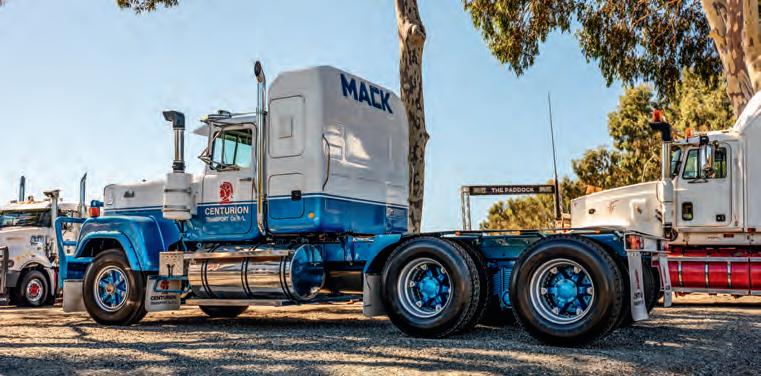

 The last V8 truck built by Mack.
The last V8 truck built by Mack.
tri-drive Kenworth T909 with triple side tippers behind it. An awesome bit of gear.
Outback Truckers stars Steve Grahame, Glenn ‘Yogi’ Kendall, and Paul ‘Sludge’ Andrews were there to meet visitors. Mack Alley saw long queues of admirers eager to meet the guys to say g’day, get hats signed and see their trucks in person.
The 2024 Mack Muster and Truck Show exceeded expectations. It’s now cemented its status as a must-attend on the calendar. The dedication of individuals like Matt Lawrence and the entire organising team made the event a resounding success, in terms of organisation and charitable contributions. With over $250,000 raised for the Harry Perkins Institute, it wasn’t just a show; it was a celebration of community, compassion and the enduring legacy of our trucking industry.
It was a hell of a show, one of the best I’ve been to, well organised and just a lot of fun.

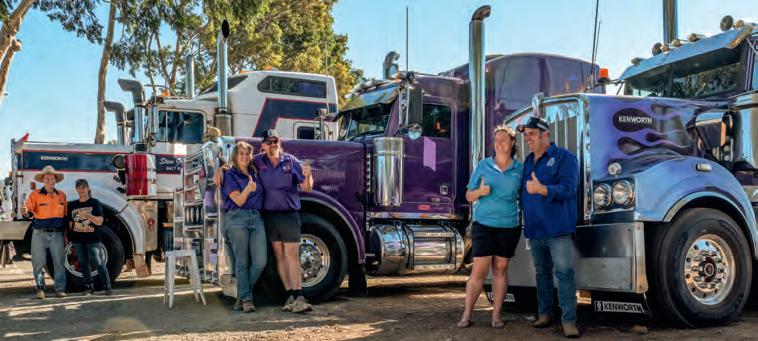

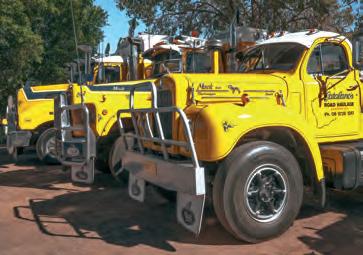
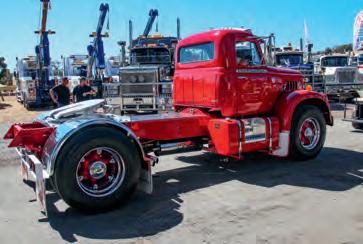
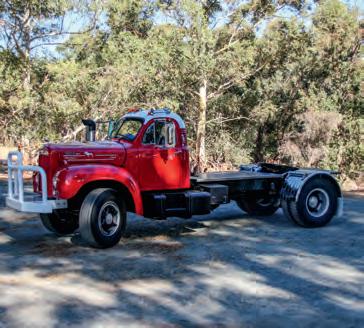



 It might no longer be exclusively Mack, but that’s not necessarily bad.
Mack Alley.
The crowds lined up to meet Steve, Sludge and Yogi.
The B-model, a Mack of a different time.
Owner-driver Greg Stampalia’s Diamond T.
It might no longer be exclusively Mack, but that’s not necessarily bad.
Mack Alley.
The crowds lined up to meet Steve, Sludge and Yogi.
The B-model, a Mack of a different time.
Owner-driver Greg Stampalia’s Diamond T.

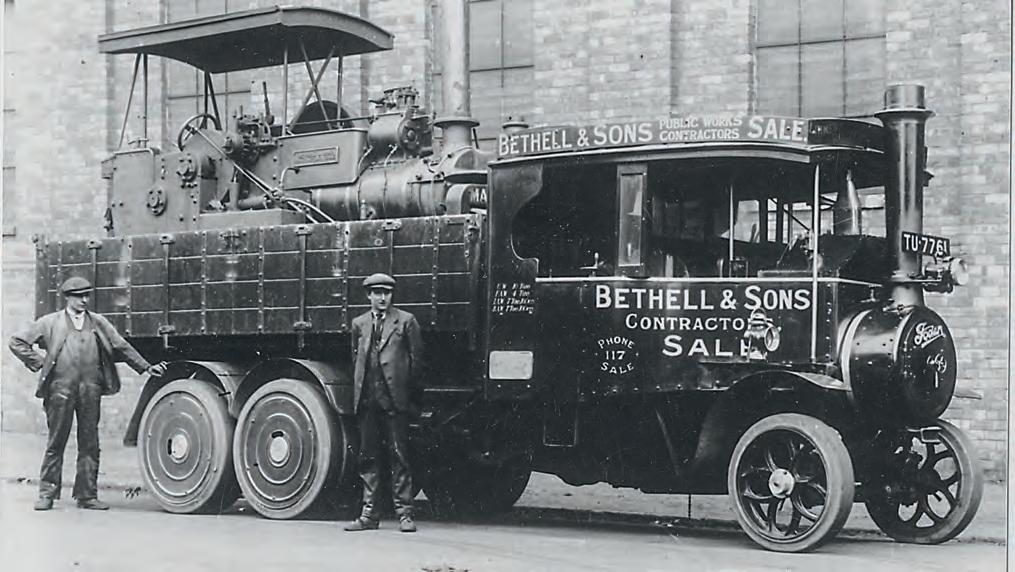
For more than 110 years, British Foden was well known for hauling heavy loads reliably around the British Empire, on the European continent, and in some other overseas markets.
British Foden founder Edwin Foden was born in 1841 in Sandbach, Cheshire, at a time when steam traction became increasingly important, especially in the field of agricultural machines.
In 1870, Foden gained control over the mechanisation company Hancock. Ten years later, Foden expanded to build steam-powered road locomotives, and 16 years later, the
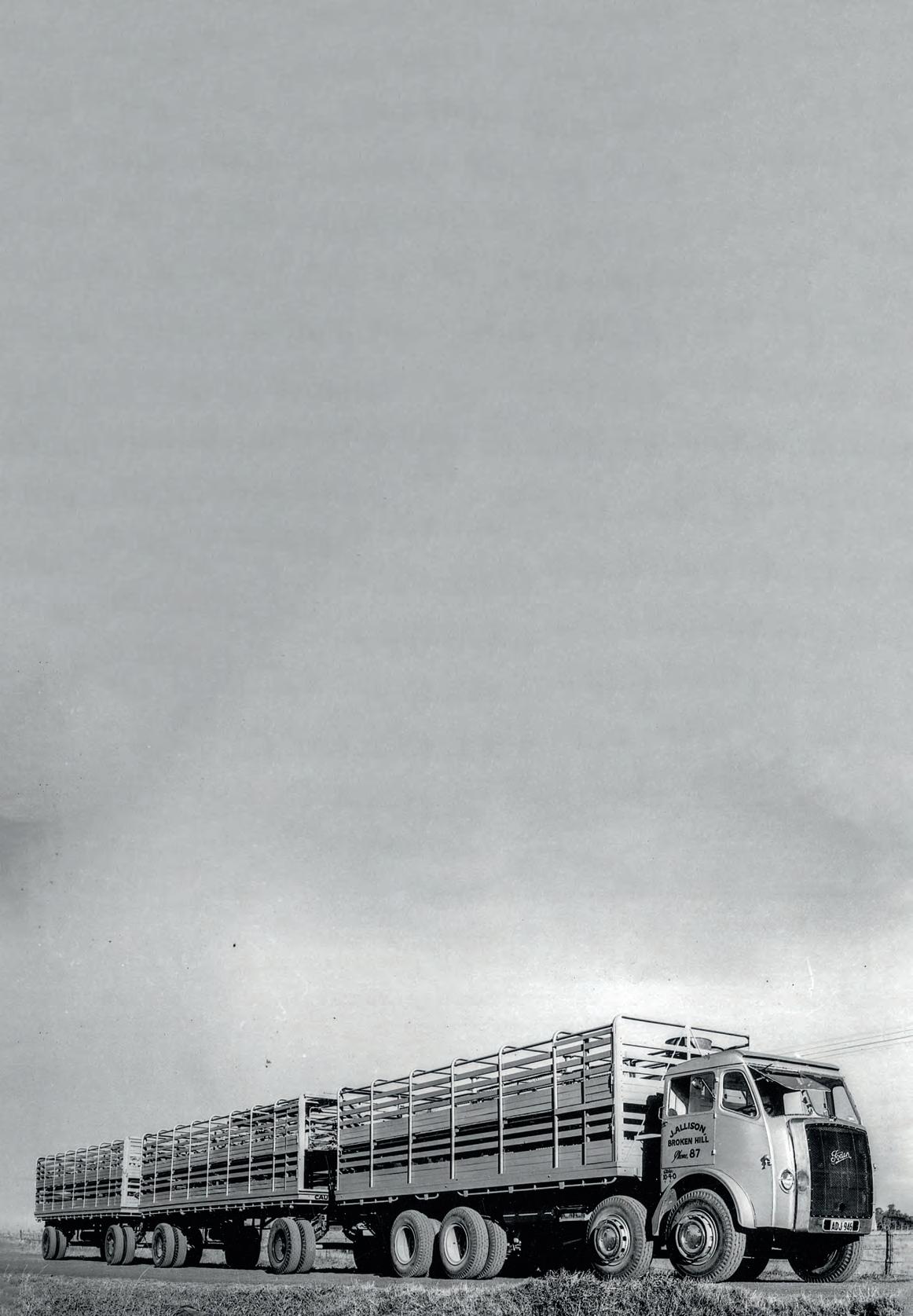
first steam truck. The first Overtype model, with a horizontal engine, appeared in 1901. At the time, the company was considered among the best manufacturers of steampowered tractors and trucks.
Edwin Foden died in 1911. Although steam-powered vehicles were constantly improved after World War I, it was clear that combustion engines were the future. In
Story by Niels Jansen Photos: Jansen collection This 12-ton Foden steam wagon was hard at work in the 1920s.1929, Foden introduced its first diesel truck, developed in association with well-known engine manufacturer Gardner. During the 1930s, new models appeared for weights up to 15 ton. The DG range at the time also included the peculiar Chinese Six and four-axle twinsteer rigids.
During World War II, a prototype with a two-stroke diesel engine was built. But the Gardner 6LW remained the preferred power unit. Two years after the war, Foden built the first heavy dump truck. It was based on the DG model and had 6x4 drive and super single tyres. The rock body was also constructed by Foden. It was the beginning of a complete range of heavy dumpers, some also equipped with one-man cabs. The trucks had a load capacity of 15 ton, and became popular in export markets.
After the war, many hauliers on the continent were forced to run ex-army equipment. But in 1950, new Fodens started to appear on European roads, albeit in limited quantities. In The Netherlands, however, the sturdy British offerings from Sandbach made quite large inroads into the truck market. Sales went so well that, in 1952, Foden decided to start an assembly operation there under the name of Fodenway. In those days, the building industry needed a lot of stones to erect new houses. The legendary Foden FG6 and FG8 rigid trucks with drawbar trailers were just the thing local hauliers needed.
Compared with other European countries, the Dutch had very liberal maximum weight regulations. In the 1950s, and in fact still today, truck combinations of up to 50- and 60-ton GCW are allowed. The only problem in the 1950s was that the Fodens, with their 150hp (111kW) Gardner diesels,
were not really up to operating at such high weights.
At about the same time, the British trucks became popular overseas – notably in Australia and New Zealand, but also in South Africa, Argentina, India and the Middle East. Chassis often received a locally assembled steel or fibreglass cab to cater for the different transport requirements in overseas markets. However, in the home market, starting from the 1970s, various fully assembled cab options made from steel, fibreglass (GRP), or a combination of both became available. There were also steel sleeper cabs fabricated by Motor Panels. A similar structure was also fitted to other British and foreign trucks, such as, for example, ERF, Guy and Scammell, plus Dutch FTF.
In the late 1970s and 1980s, Foden offered S10 tilt cabs made of a steel frame with GRP panels and aluminium parts. When Foden came under the wings of American company Paccar in 1980, the fibreglass S10 cab was still used. Then, in 1987, the 4000 Series forwardcontrol truck with updated S106 cab was launched and was well received by operators. Unfortunately, exports had almost come to a halt, except for New Zealand, South Africa, and Switzerland, of all places.
In 1991, the well-known haulage operator Friderici bought 32 4000 Series trucks and some more in 1993-94. The American driveline and lightweight construction were the main reasons to invest in the British product. At the time, Switzerland only permitted a 28-ton gross combination weight on domestic roads.
The Foden Alpha, with its DAF-derived steel cab, debuted in 1998 but never made it to the continent. That was a pity as this new forward-control
1) A thirsty FG6/15 eight-wheeler of 1954. 2) Two smart FG6 brick trucks with Dutch and British coach-built cabs, 1957. 3) A 1965 model 4AE6/30 ‘doubles’ rig in New Zealand. 4) Circa 1967, this impressive Gardnerpowered 6AX06 model with fibreglass S21 cab ran in Western Australia.
5) A 1971 Foden 4AC6 with a locally fabricated cab in South Africa.
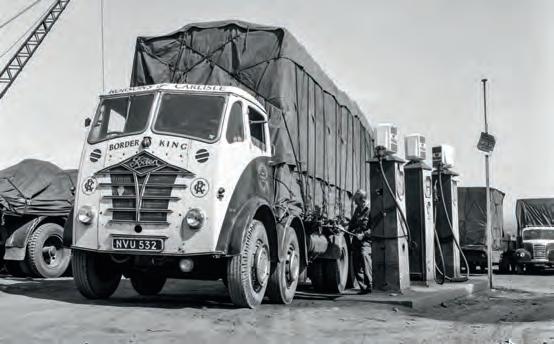
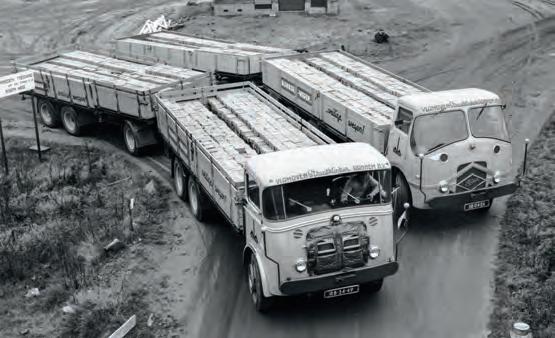
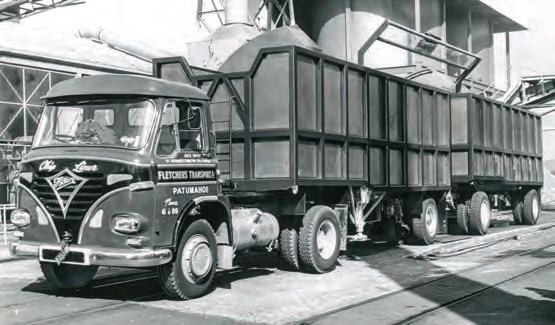
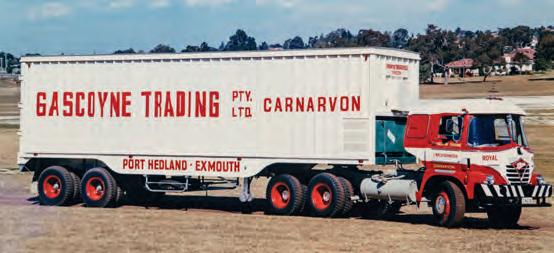
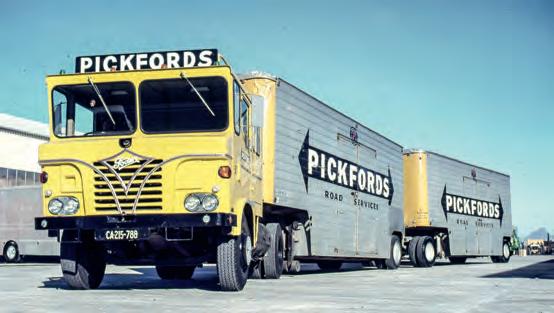
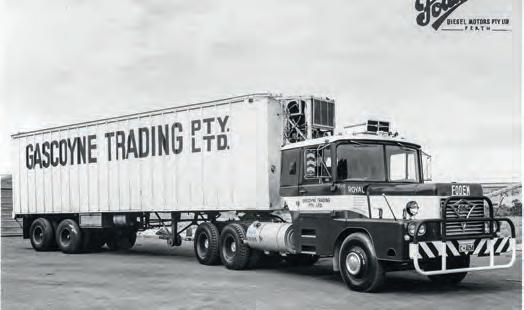
range – built at the former Leyland plant – really looked the part, especially in highroof sleeper-cab form. Thanks to the influence of the United States owner, sales flourished in technical fields. Aluminium components were fitted more often, as were Caterpillar diesel engines and Eaton Twin Splitter transmissions.
Like the 4000-Series, the Alpha was available in 4x2, 6x4 and 8x4 chassis configurations. Although the 4000 was still popular in quite a few overseas markets, the new Alpha range only made it in some quantity to New Zealand, perhaps because Kiwi haulage operators had built up a long and solid relationship with the British manufacturer. Sales of traction engines and goods vehicles Down Under began well before World War
II, but when Fodenway Motors was set up in 1952, imports to New Zealand really expanded. The 1960s and 1970s were the heyday of Foden sales here and in Australia.
Unfortunately, when the British manufacturer ran into financial problems, exports to many parts of the world almost stopped. But in the 1980s, thanks to a new importer and new models like the 4000 Series, and later, the Alpha, sales to New Zealand customers increased again. Unfortunately, all this activity, at home and abroad, was once more not enough for Foden to survive.
To the disappointment of many Foden users and fans, the American owner decided in 2005 to permanently withdraw the old British name from the market.
1) Foden Importer Diesel Motors built two of these impressive 6AC6 conventionals in 1972. 2) A good-looking Foden AC29/75 operating in Malta. 3) A Cummins NTCE290-powered AC Fleetmaster. 4) In the 1990s, Swiss Friderici ran an entire fleet of Cat-powered Fodens with S10 Mark 4 sleeper cabs. 5) New Zealand has always been a good market for Foden. This 4455 model cattle truck was spotted in 2008. 6) In the 1930s, Fodens were exported to markets worldwide. 7) Nice leaflet from 1958 about the new eight-wheelers. 8) This Paccar ad from 2005 shows the Alpha 6x4 tractor with a DAF-derived steel cab.
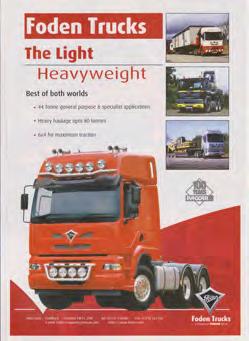
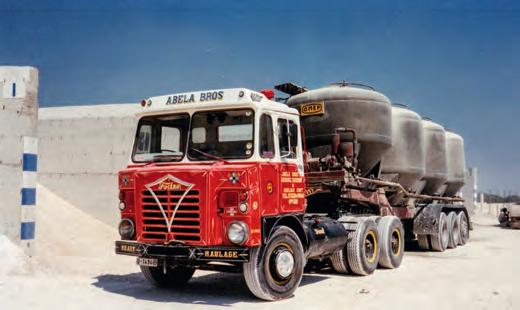
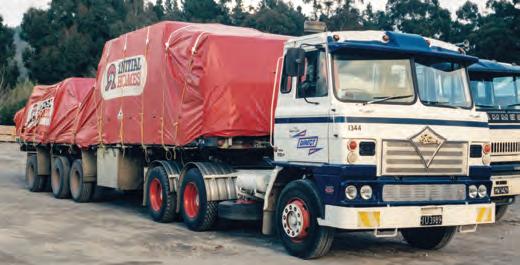
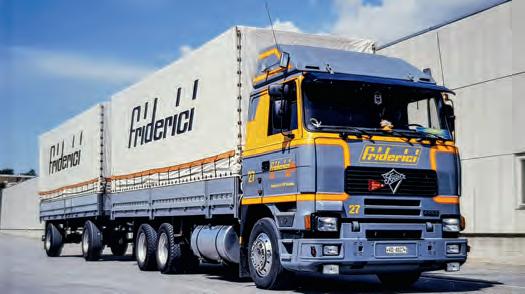
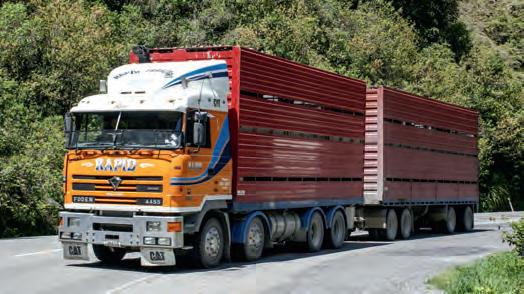
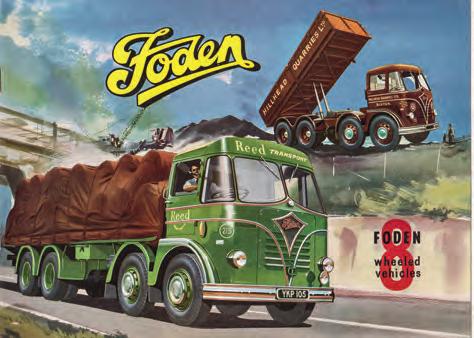

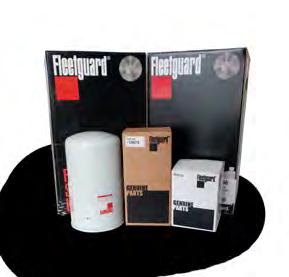




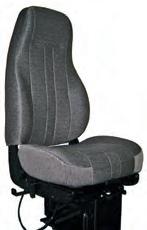
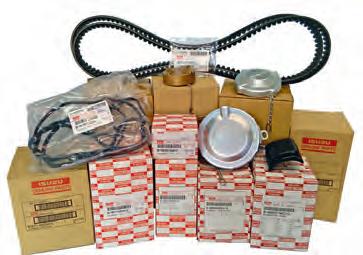
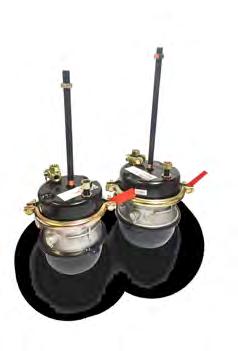

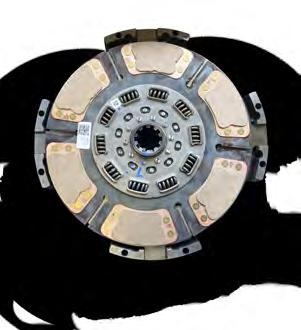





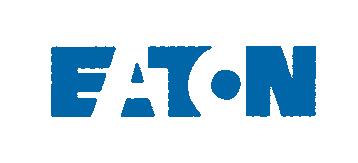







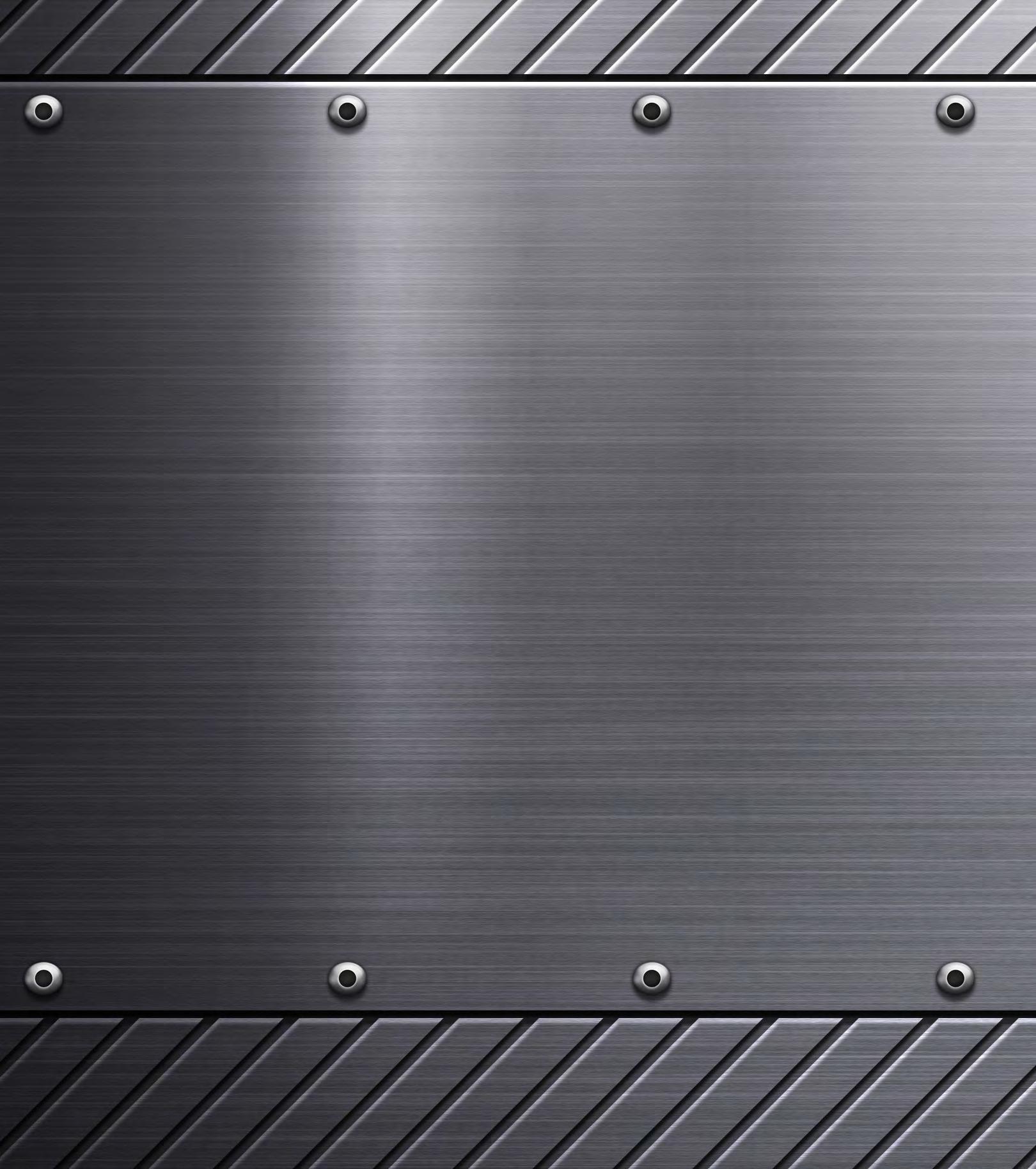


Arriving at the yard of JR Transport on Loggers Lane in Squamish, BC, approximately halfway between Vancouver and Whistler, you are immediately greeted with memories of the past. Proudly standing
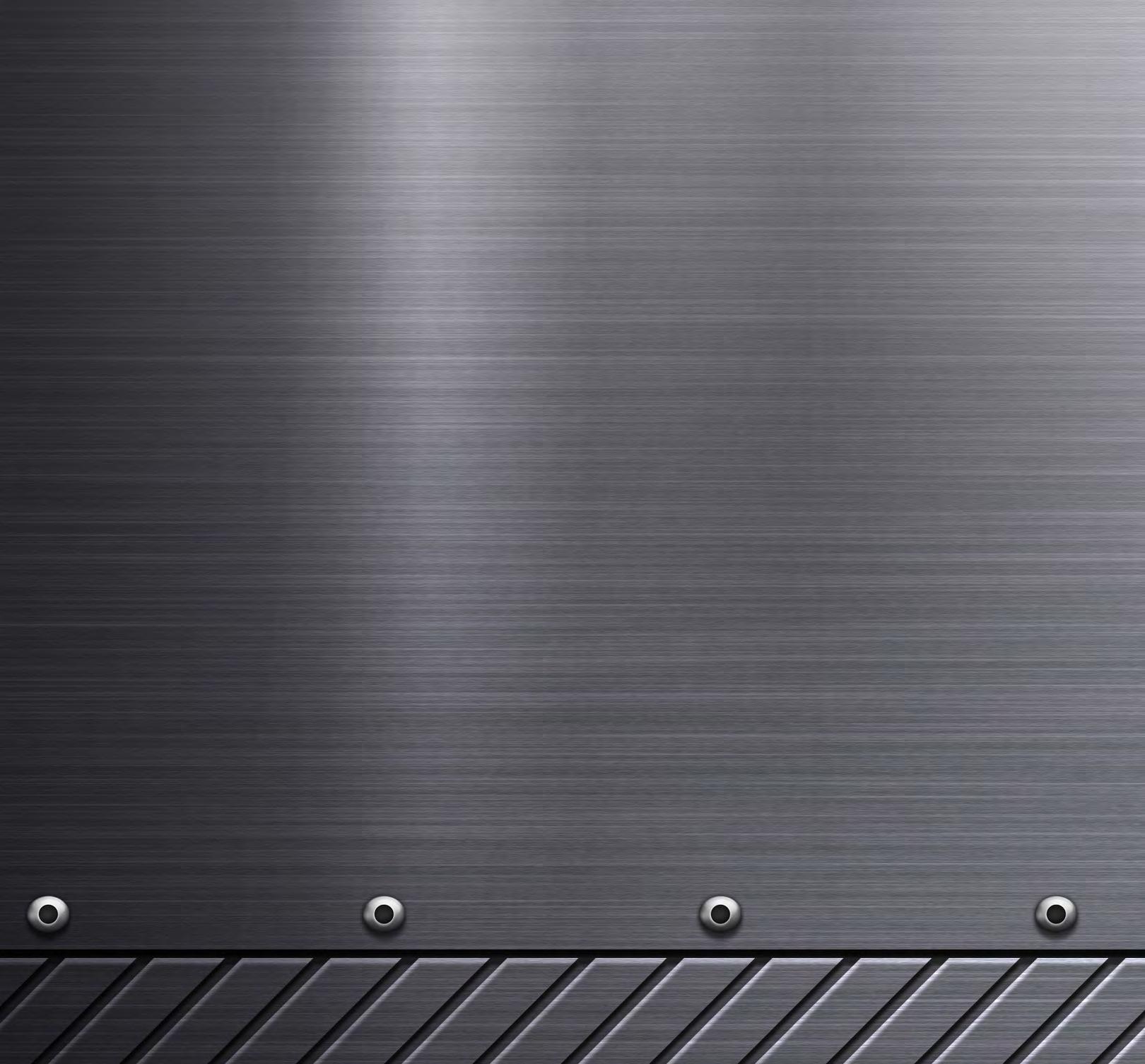 Photos by Izaak Kirkbeck
Photos by Izaak Kirkbeck
at the gate is an ex-army 6x6 GMC logger conversion sitting alongside a typical 1970s logging-spec LW Canadian Kenworth. The pair truly set the scene as well as the tone, vividly demonstrating what makes this company tick, especially given the changes
Mention the Sea to Sky Highway and those who know immediately think Vancouver, Whistler, and snow. But wind the clock back 50 years and logging ruled supreme. We meet a transport operator in the middle of Squamish, British Columbia, who proudly stands on that tradition.
to the local demographics and colossal increase in tourism brought about by the arrival of ski resorts and their related industries.
We meet Darren Doak, owner of JR Transport, prepping his 2024 T800 Kenworth for a run up to a skid
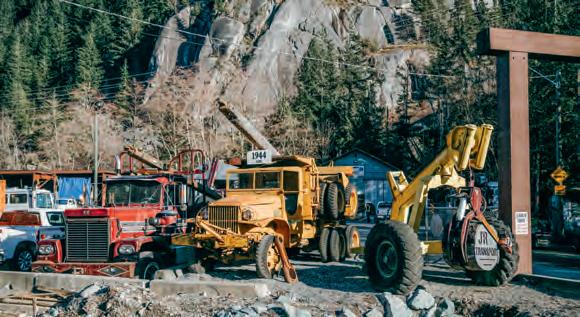
near Whistler to collect a load of ‘soft’ (Cedar) wood. Darren has a long history in Squamish, moving there in 1967 at the age of one with his family when his dad landed a job working at the local sawmill.
“I went to school here up to grade 12, then I moved
 Bottom left: Fond memories from the company’s past parked at the front gate.
Bottom left: Fond memories from the company’s past parked at the front gate.



Darren Doak: looking towards the future with a keen eye on tradition.
to Vancouver to attend BCIT and study. I wanted to be a machinist, but after 10 months, I returned to Squamish and moved back into home,” he says.
“It’s a bit of a funny story how I started with JR Transport. I had an old hot rod, and one night I was working on the car getting ready to head out to a local spot, Brohm Lake, with some friends. Dad came home and said to me, ‘Jack Rempel [a family friend and owner of JR Transport] wants to know if you could go to his shop tonight and give him a hand doing a clutch job on one of his logging trucks’. I said ‘No, sorry Dad, I don’t think so, I’m washing the car, I’ve got girls lined up and we’re going to the lake’. With that, my dad turned to go inside and said, ‘Hey Darren, when you get home from the lake, pack up your stuff, you are moving out. No job – no live here, you aren’t at school anymore’.’
“So that night in June 1986 I started working for Jack at JR Transport as a mechanic’s helper,” Darren says with a laugh. “Since then, I have never had any other job; this has been my one and only job since I got out of high school. In 1995 I had the opportunity



1) Tri-drive trucks and tridem trailers were game-changers when it came to improved stability, on and off the highway. 2) The venerable Cummins X-15, ‘pushing 605 at 2050’. 3) A quick whip around with the trusty Husky to ensure the load is compliant for the road. 1 2 3
to purchase the business from Jack. He was very helpful at that time by loaning me what I was not able to finance, and staying involved. He mentored me and helped me change from worker to company owner. But I am not
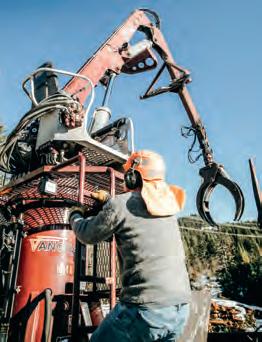
the sort of business owner who sits in an office and gives out directions. I much prefer to be behind the wheel with a load of logs, working with the clients face to face.”
The JR Transport fleet currently has five Kenworths – four of the rugged North American T800 model and one W900. “Yeah, in the past the fleet has reached 12 trucks, but it starts getting out of hand and also means a lot more time


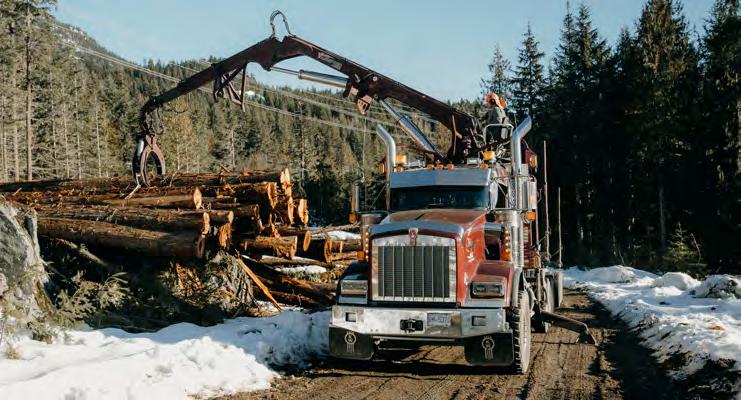
Adding selfloading capabilities to the fleet has opened the door to many opportunities that would not have been possible in the past. They have also assisted with the recovery of failed early EGR trucks in -50°C conditions.

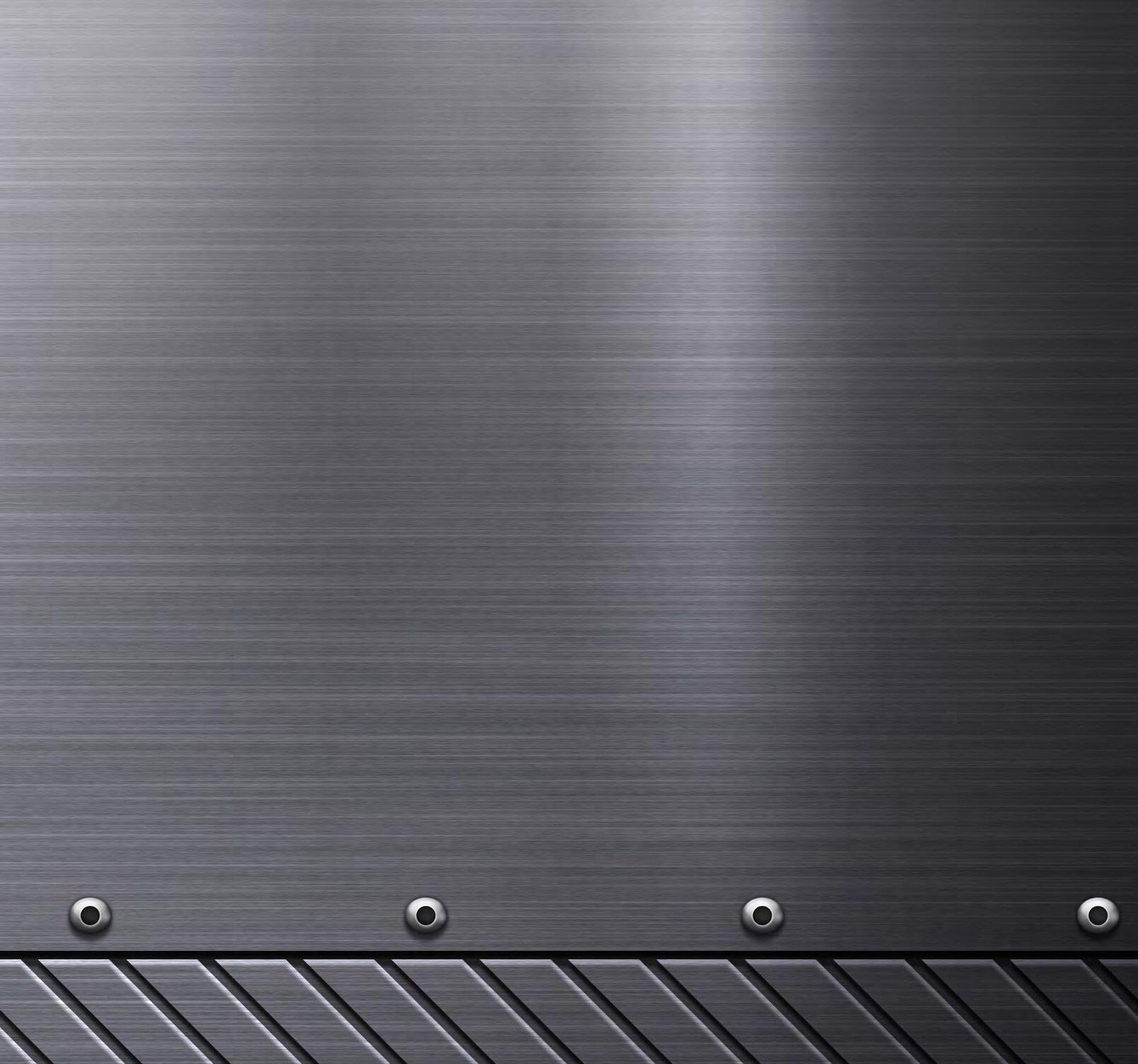
in the office for me. We’ve had Peterbilts and Western Stars in the past, but all my guys are Kenworth boys, and we have a great relationship with the local dealer.
“The T800 is the best fit for us, but one of my drivers really wanted a W9, so I let him go pick his own. We lose a few kilos on the front axle, but the truck looks cool, and we’re happy to lose a few kilogrammes of payload for a tonne of cool.
“The safety of the trucks has improved immensely over the years. Back in the day, we would see someone’s truck upside down in the bush probably once a month. But now, with research, things change. The first change was moving from an 8ft (2440mm) ‘stance’ (track) to 8ft 6in (2590mm). Then tri-drives came along, and tridem trailers. It was a gamechanger; the footprint of the truck
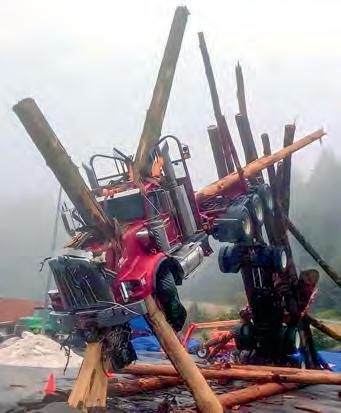
is now way better on the ground, adding a load of stability. It’s a big effort to tip over a modern tri-drive truck these days. You really have to work at it hard now,” Darren says, laughing.
“Squamish has changed a lot over the years, it is not the small community that we grew up in. When I was a kid, it seemed like there were as many logging trucks in the town as there were cars getting about; the logging industry was thriving.”
Darren says not a lot of tourists came to the area because access was not good and what’s now the Sea to Sky Highway was back then known as the Killer Highway. The 2010 Winter Olympics changed that, and rebuilding the highway opened the area to tourism.
“There has been a decline in the logging industry for some time. We are one of only three logging
A sideline for JR Transport has been the supply of trucks to the film industry. Here, an older T800 was purchased for the filming of a scene in the movie Superman: Man
companies left in Squamish now. But we have found opportunities as well through all this. We hauled gravel for a bit and have also supplied trucks and machinery to the film and TV industry, but we come back to logging as it really is our thing.
“Fitting the self-loaders has also opened up more opportunities for us. We are able to do jobs that some other companies can’t, but we are also travelling further now for our logs. It is the business that we know, and it is the job that I have been in since I left school. So, yeah, we are comfortable continuing doing what we do well.”
There is no question about it, the classic iron at the front gate is most definitely more than just garden art. It represents the mantra of JR Transport, where the memories from the past help form strong pathways towards the future.

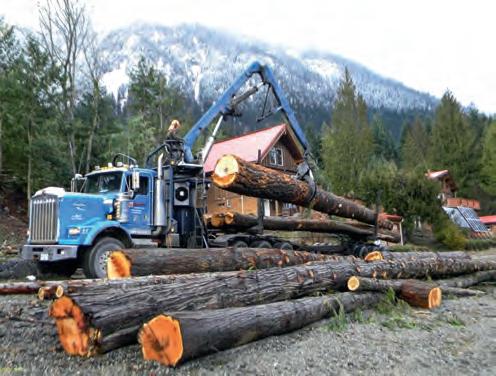
No assistance required ... fleet No.35 at the coalface selfcollecting another load of sticks.
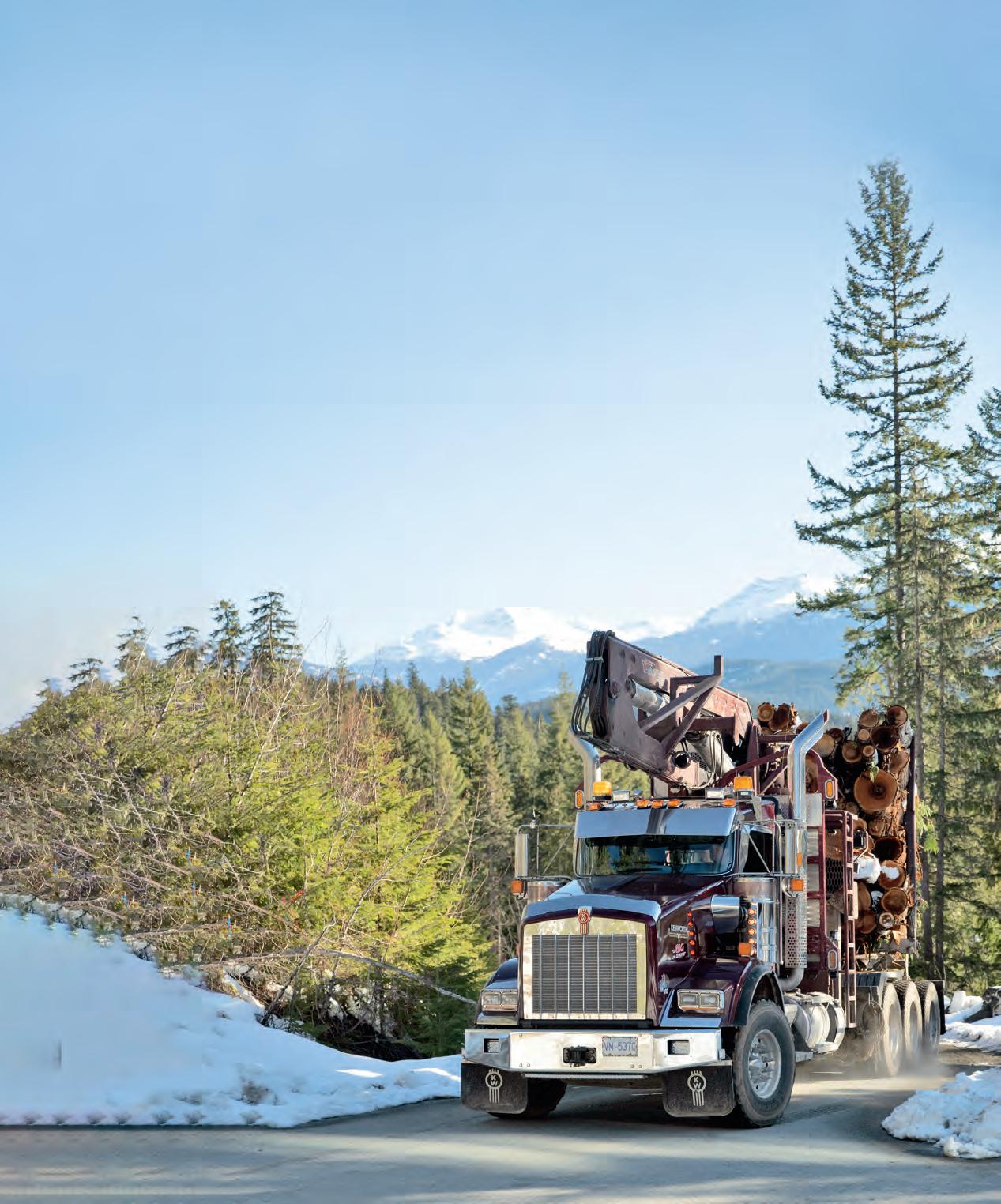
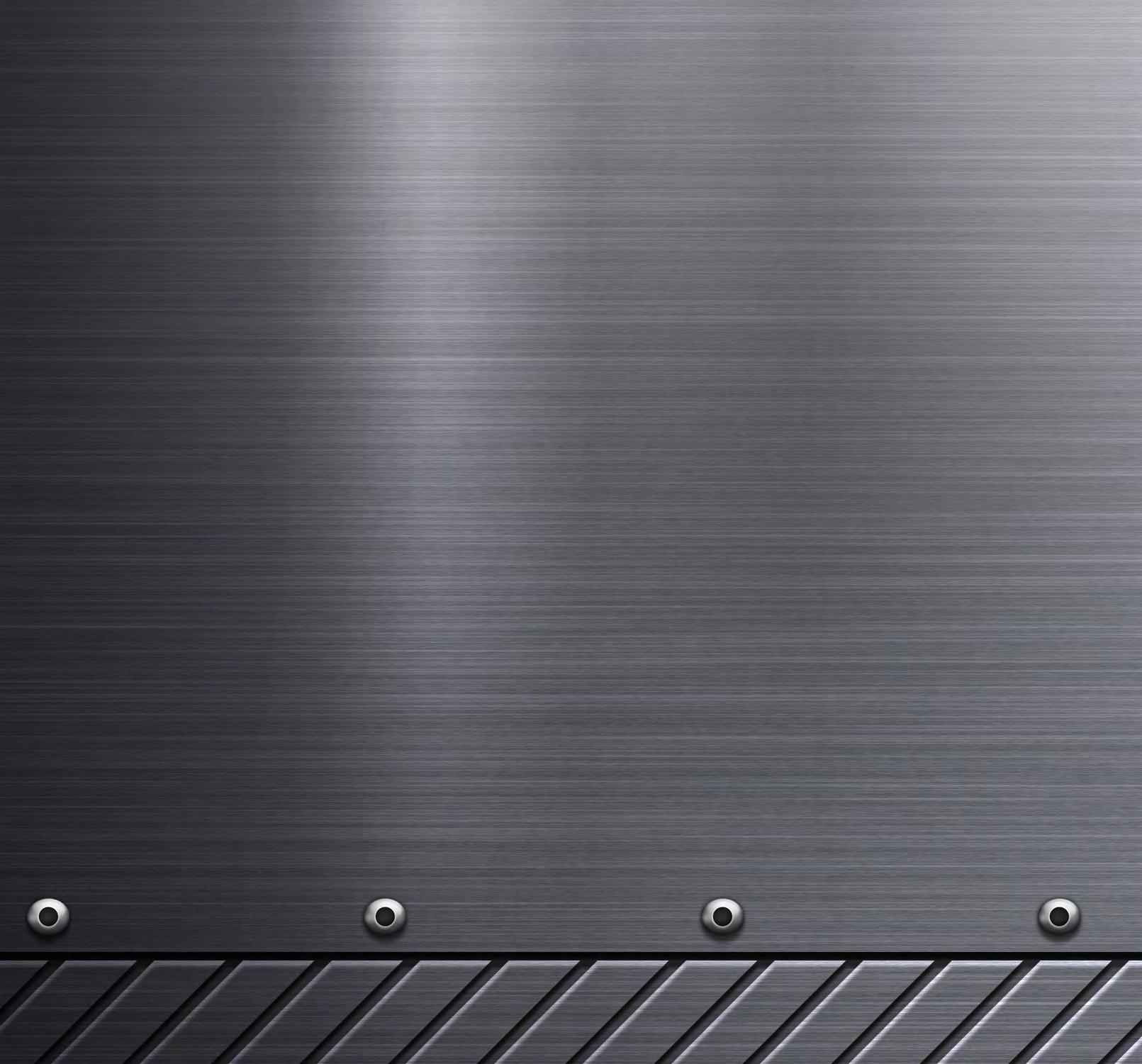
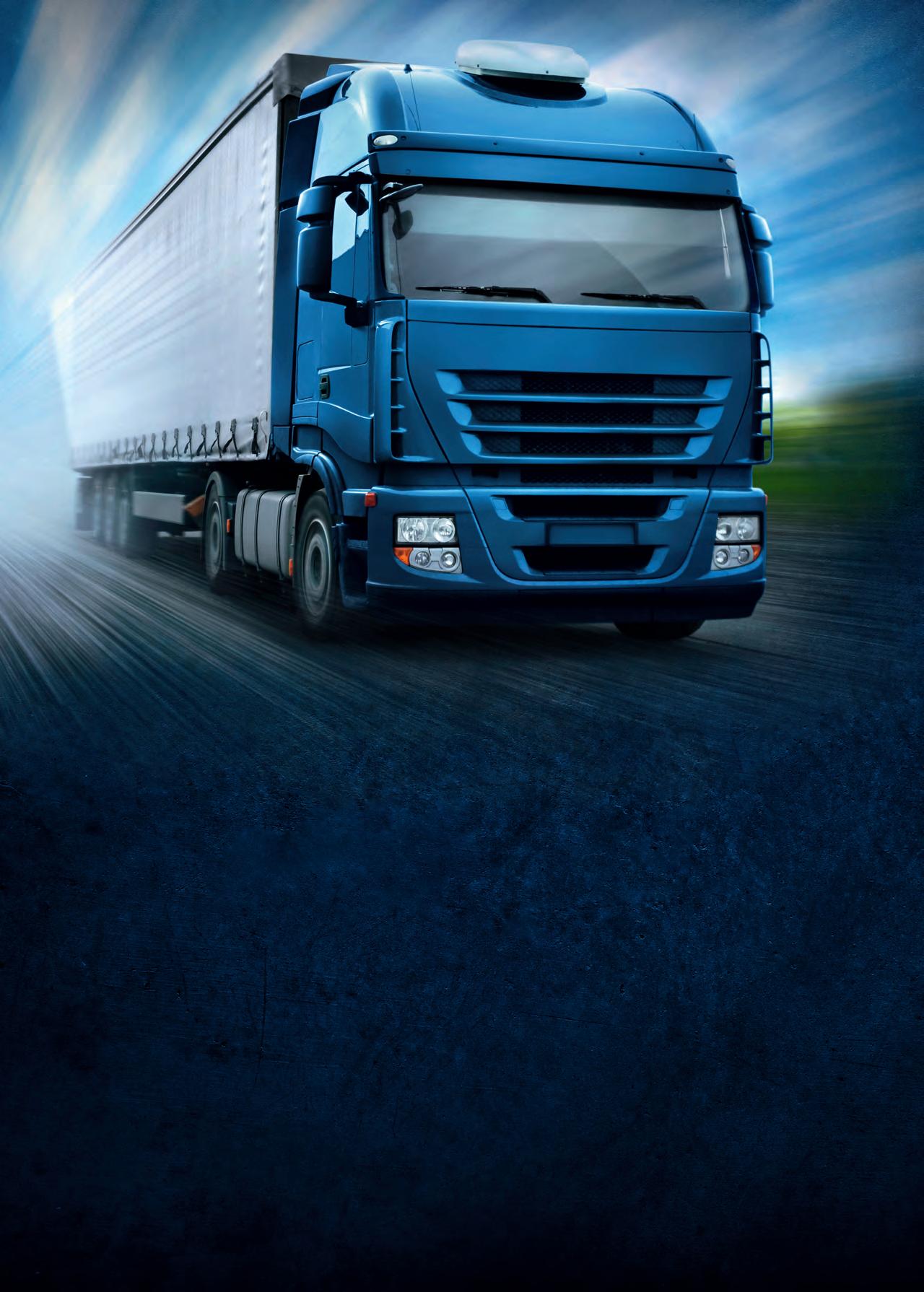
 Darren and the T800 kicking up the dust as they exit the bush with a load of wood.
Darren and the T800 kicking up the dust as they exit the bush with a load of wood.

VARTA ProMotive AGM is designed to optimally support drivers and their trucks during their time on the road. Since the demand for nonstop transportation services requires trucks to be on the road every day, drivers spend more time in the cabin than ever before. The Varta A1 AGM truck battery leads with high vibration resistance, excellent charge acceptance, extended cycle life and increased depth of charge, allowing fleets to equip drivers’ cabins with hoteling functions without draining the battery, avoid downtime and maximise productivity.

It all starts with
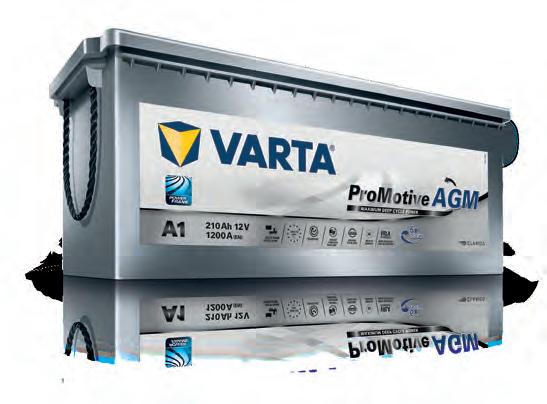
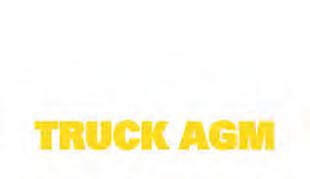


Visit our portal to find your local supplier. www.varta-automotive.com/en-nz


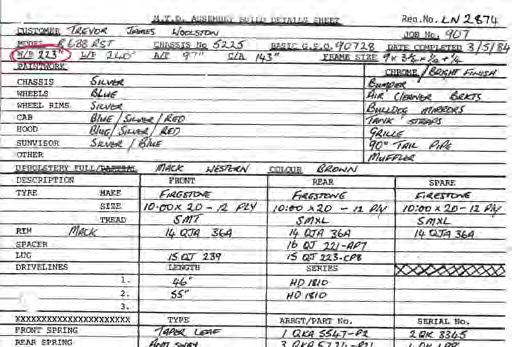
This month, we are assembling the chassis for Torquing Bulldog. At first it may seem straightforward, however, there is a minor twist that requires rectifying.
The chassis from the kitset is a good representation of your typical Mack R-model tractor unit, but this is where we hit a hurdle. Torquing Bulldog was a rigid bulk tipper, with longer frame rails to suit this application. Our task now is to match this chassis frame length in our build, and ensure the finished dimensions match the real truck as closely as possible.
The process of lengthening a chassis can be addressed in many ways. There is adding a piece of donor chassis to the rear of the existing frame and then repositioning the crossmembers. This is possibly less invasive than cutting the existing frame rails and stitching in a piece between the cut faces, but it can be a little more time consuming. The way we are going to approach
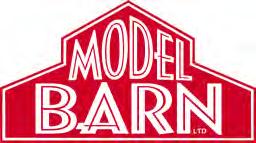
this task is straightforward, with the finished result also adding strength and rigidity to our build, keeping in mind it will have to support a bulk tipper body once completed.
First, follow step eight of the instructions, gluing together 204 and 39 to parts 40 and 45. This step is important because you are laying out the backbone of the truck, and it is critical that care is applied to the assembly to ensure the chassis is straight and true to form. Once you are happy the frame is aligned, set it down to dry thoroughly, adding weight on top of the chassis to hold it in place as the glue sets if required. At this point, do not glue parts 46 to 51 in place; we will fit these later once the chassis has been stretched.
Next, jump to steps 9 and 10,

and add the front suspension and steering axle. Once again we select only the parts we need to get the front steering axle locked in place – parts 52, 53, 66, 71 and 72. The reason for this basic installation of the front steering axle with no accessories is to give us a solid reference point to measure our overall wheelbase from. Allow the front axle assembly to dry thoroughly before starting the chassis lengthening stage.
The most important piece of information we need to lengthen the chassis is the as-built wheelbase of the real truck. The wheelbase is the measurement taken from the centre of the front steering axle back to the centre point of the suspension between the two drive axles. On an early Mack this is easy to locate as the Camelback style suspension of the time has an obvious centre pivot point. For us, there was a slight issue: Torquing Bulldog is no longer available to measure. However, we were extremely
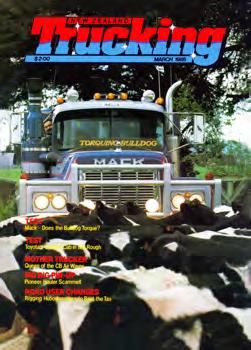
fortunate to be given a copy of the original Torquing Bulldog build sheets from 1994. They contained all the information we could wish for and more, and at the very top of the sheets was the magic number – an overall wheelbase of 223in. With this measurement we can do some mathematics and calculate the 1/25th scale version of 223in, which equates to 566.42cm. So, 566.42 divided by 25 equals 22.6cm, or 226mm – the 1/25th scale wheelbase for our model. Laying the chassis out on
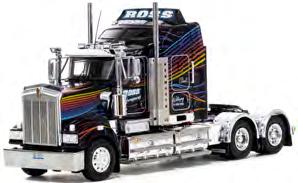
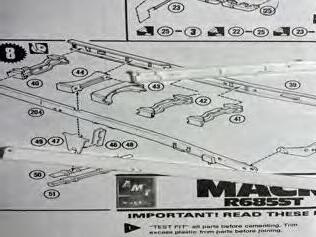
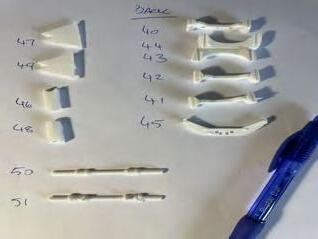
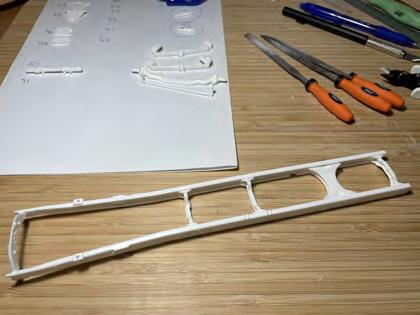

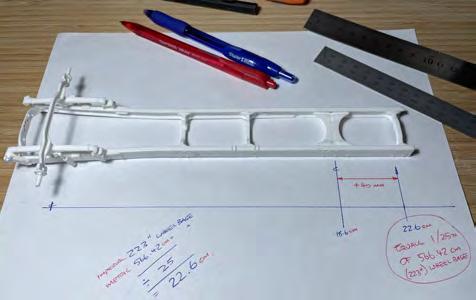
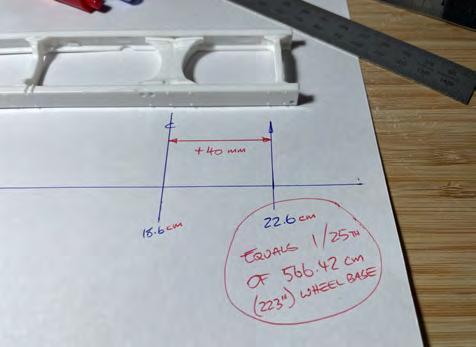
Armed with the magic measurement of 223in from the original build sheet, we can calculate in millimetres the exact measurement of the chassis splice required to take our build from tractor unit to rigid bulk tipper.
a piece of paper, we can now mark the centre of the front axle. Then looking to the rear of the chassis, parts 43 and 44 form the main crossmember, and it is the seam where these two parts connect that reflects the centre pivot point of the Camelback suspension. The
current wheelbase measurement between these points is 186mm. With a little more maths, the length we need to add to the chassis to achieve an exact representation of Torquing Bulldog at 1/25th scale is 40mm. We can now start the process of splicing in the 40mm. Using
Laying out the required parts allows us to clean and prep them free of moulding lines and production flash, before assembly.
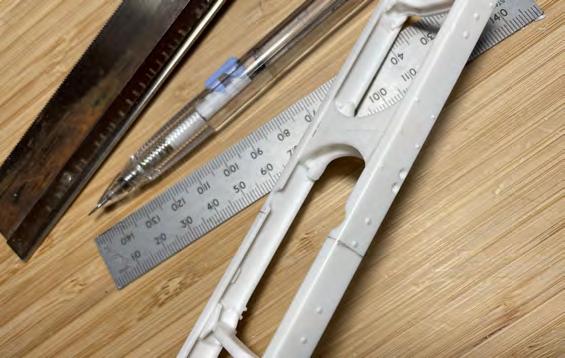
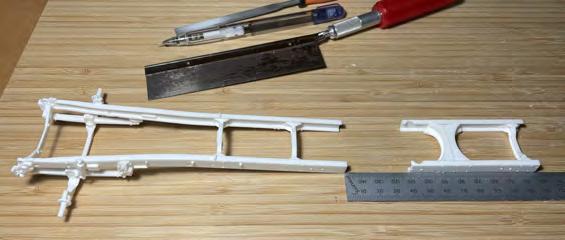
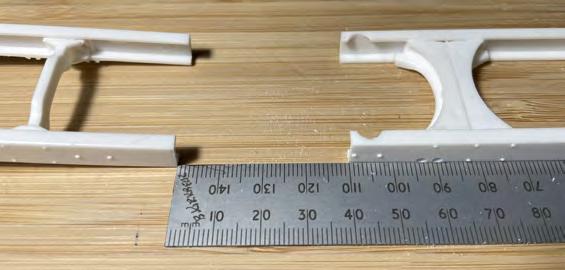
Mark in pencil the proposed cut line; allow 15mm of chassis in front of the main chassis crossmember (made up of parts 43 and 44); this will give you plenty of surface contact on the inside face of the chassis to glue the splice to. Use a wide blade razor saw and take your time to achieve a clean, straight cut.
our razor saw we want to first accurately cut the chassis in two. The best place to make this cut is 15mm in front of the main crossmember. By cutting here we have plenty of rail to apply the glue to, and bond the chassis to the splice, making a strong bond point between the two. Now cut
two pieces of Evergreen #169 2mm x 6.3mm rectangle strip at 70mm long; this gives us the two required splices we are after, affording the 40mm of length we are looking to add plus 15mm each end to glue into the chassis rails.
Clean all cut edges to ensure
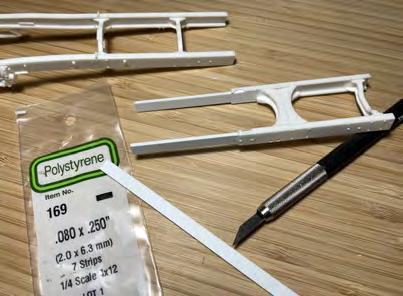
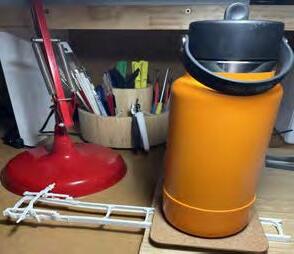
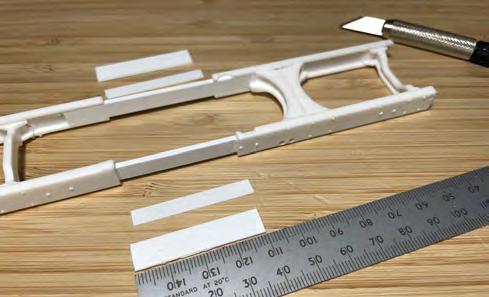


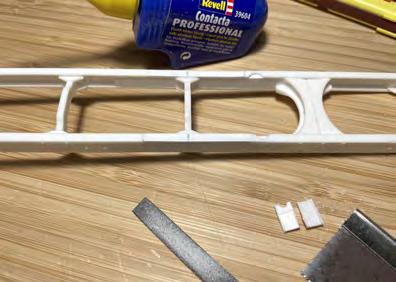
Now the chassis is extended to the required length for our build, add an extra crossmember into the chassis to strengthen that section of the frame. Form one out of Evergreen styrene plastic, or find a donor in the spare parts box. Locate the extra crossmember halfway between the two existing crossmembers.
Cutting pieces of Evergreen #169 rectangle section to 70mm in length forms the splices we need to lengthen the chassis. Glue the splices into place between the front and rear sections of the chassis frame and apply a firm weight to the top of the chassis as it sets to ensure a true and correct-to-form result. Once thoroughly dry, cut Evergreen 1.5mm sheet styrene plastic into strips that cover the splices, and match the form of the existing chassis rails. If required, use Tamiya putty to fill any gaps or cracks in the joins.
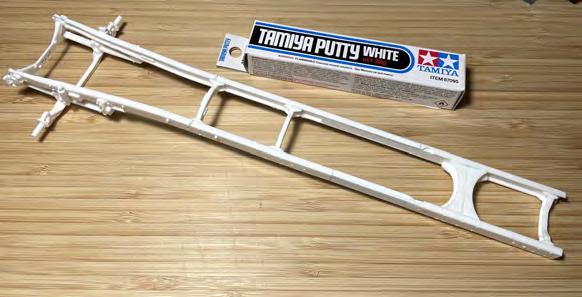
a tight fit, then apply glue to the contact surfaces and join the chassis and splices together. Accuracy is required here to set the chassis out flat on the work bench and ensure it is straight and true to form. Time spent here making sure this is spot on will save many headaches further down the track. With it sitting in place, apply weight if required as it dries thoroughly. Let it set at least overnight so it is well and truly locked in place. Chassis bonded together at the new length, we can add sheet styrene plastic to pad out the splice and match the gauge of the existing chassis rails. Cutt strips out of Evergreen 1.5mm sheet styrene plastic, shape to fit and glue in place. When the glue has cured thoroughly, use a fine file and fine sandpaper to blend the finished surfaces so they form a seamless joint. If you find
there are small gaps, use Tamiya putty to fill these before you apply paint finishes later in the build.
With the frame stretched, an extra chassis crossmember is needed. You can either form one from scratch out of styrene plastic, or by hunting through the trusty box of spare parts you may find a candidate modifiable to suit. Glue this into place halfway between the two existing crossmembers, approximately at the 50mm mark.
At this point you can stand back and admire your handiwork. As I alluded to, there is more than one way to skin this cat, but given the fact we will have a bit of weight sitting on this build, adding the splices definitely adds much-needed strength and rigidity to our build. Next month we will add the diffs and chassis accessories.
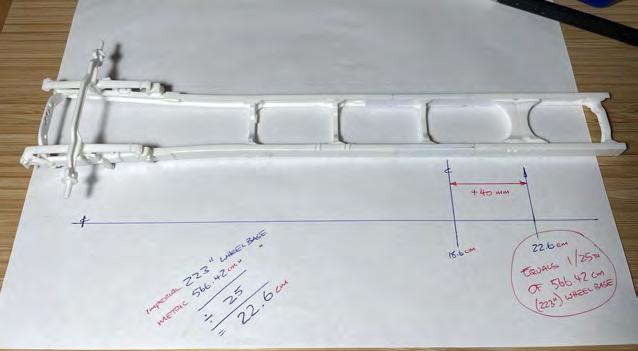
The completed chassis, now representing a 1/25th scale version of Torquing Bulldog’s 223in wheelbase.


We’re incredibly proud to be voted #1 in safety in NZ Trucking magazine 2023 national trucking survey.
From stronger cabs, to smart emergency brakes, to side-detection alerts, our focus is always on the best possible protection for our drivers and fellow road users.



Winter is well and truly here! I live by the ocean and the sea is getting rough, making the local gravel road muddy. The roadworks teams are busy out here tidying up our rugged road. They’re bringing rocks out to build up the banks to stop the road from washing away in heavy rain, and the graders are levelling out the road and filling in all the potholes. So,
ANSWER BELOW JOKE OF THE MONTH
WHAT OFTEN FALLS IN WINTER BUT NEVER GETS HURT?
hopefully, we won’t get stuck out here in the bad weather! Do you live somewhere in the middle of nowhere like I do? Tell us about it. We would love to hear your stories.
Unfortunately, we’ve received no entries for the Find the Little Truckers’ Club Logo competition in the May 2024 issue! If we don’t get any entries in time for the next issue, we’ll let you
know where it was hiding. Don’t forget, if you would like to see yourself here in Little Truckers’ Club, all you need to do is e-mail your stories, jokes, photos and/or drawings to me at rochelle@nztrucking.co.nz with a short paragraph telling us about them, along with your name and age. We love seeing them all!
The Little Truckers’ Club logo is hidden somewhere in this issue. Find it, and you may win a prize. Email rochelle@nztrucking.co.nz with your name, age and where you found the logo.
Seven-year-old Harlem Siffleet sent us this photo of him locating our club logo in the April issue. Cheers!


Did you read about the opening of New Zealand’s first hydrogen refueling network on page 100? See how many differences you can find in these pictures of Mercedes-Benz’s new electric eActros 300 and hydrogen fuel cell Gen H2 Truck. Can you find all 10?
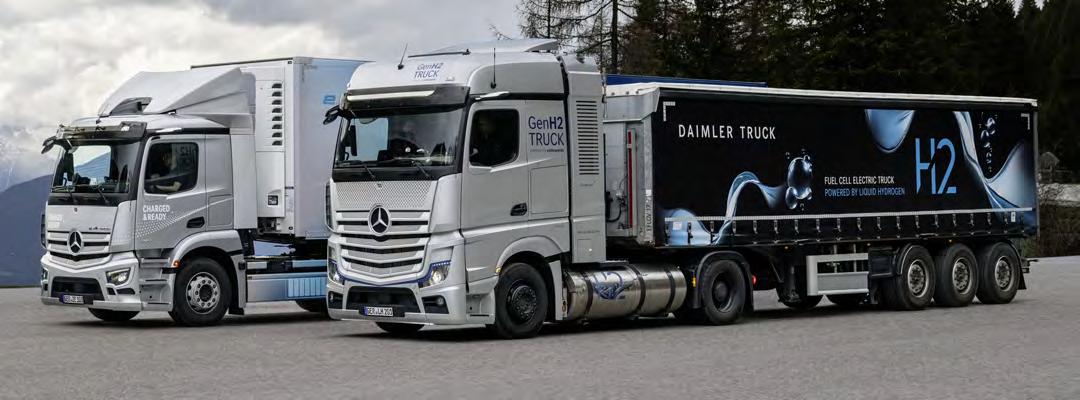
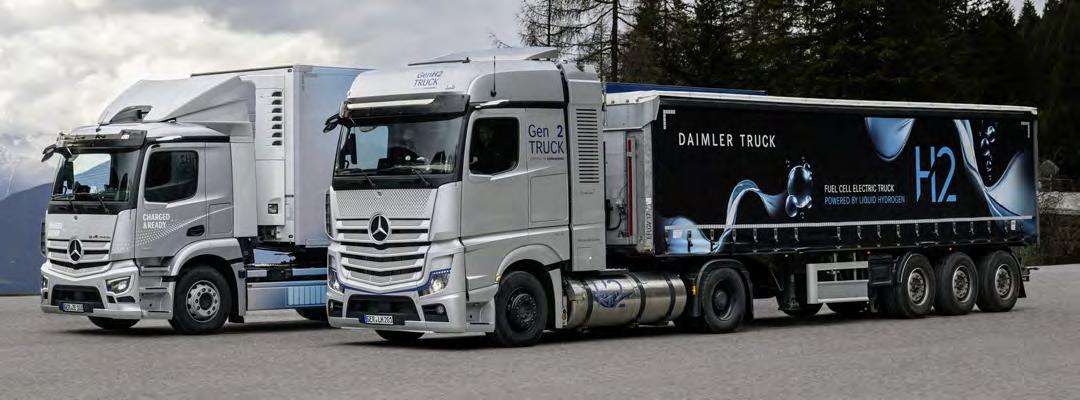
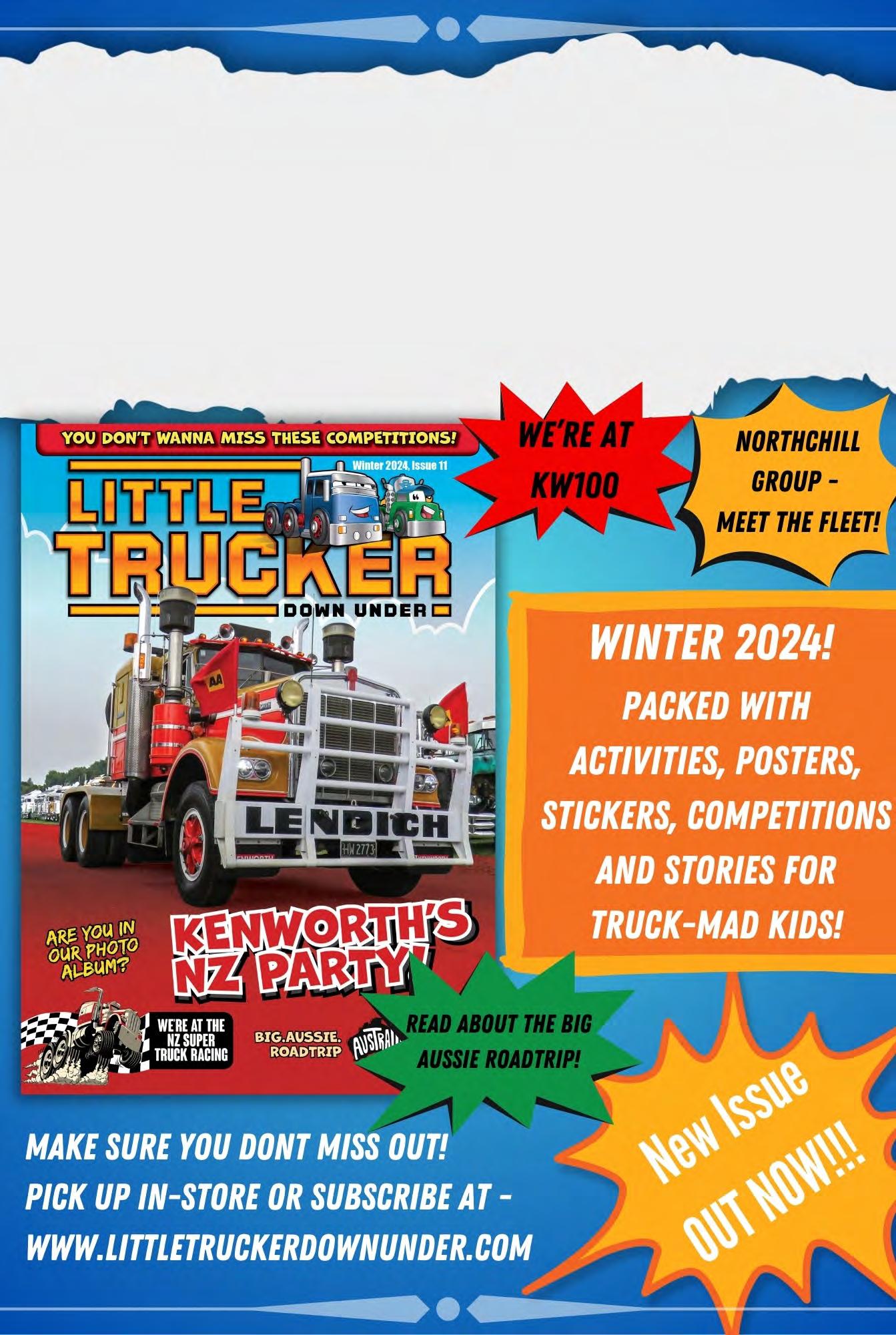


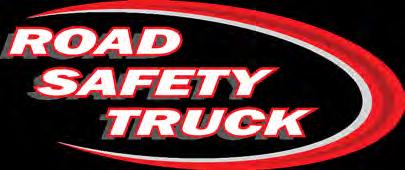
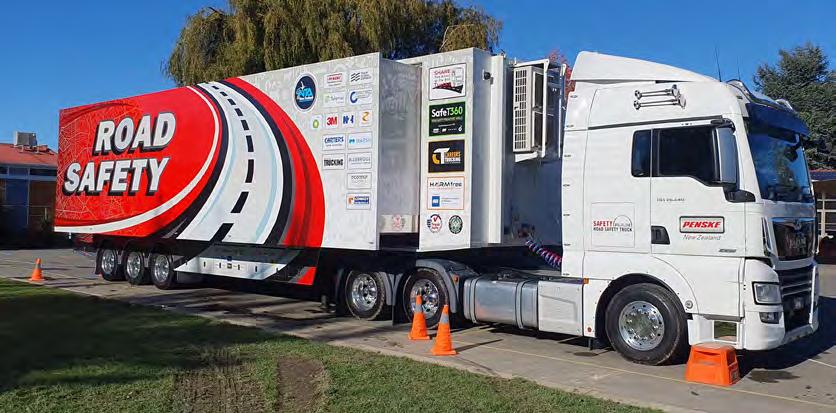

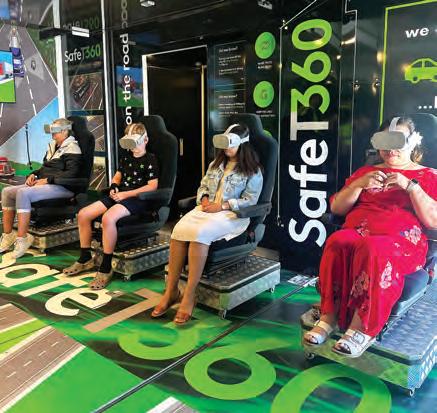














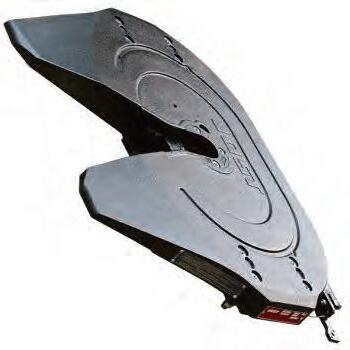
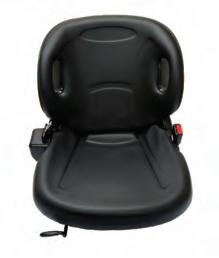


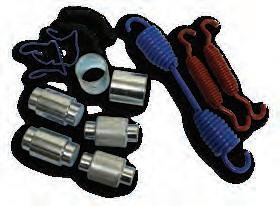

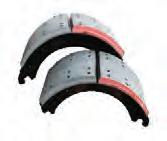



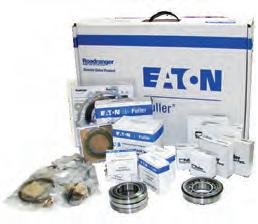

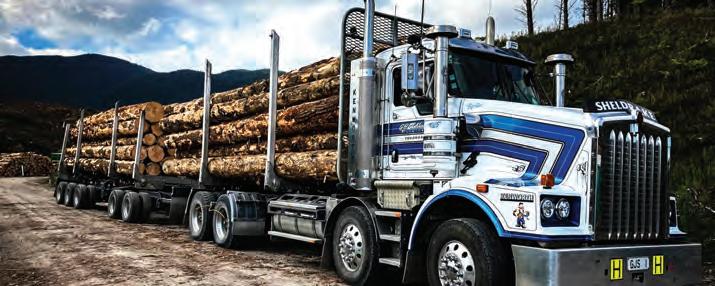




Show organisers
Please send your event details, at least eight weeks in advance, to: editor@nztrucking.co.nz for a free listing on this page.
McDonough Contracting Gore Truck Show
1 June 2024
Transport Repairs yard, Falconer Road
Contact: goretruckshow@gmail.com
Facebook – Gore Truck Show
Southland Hug a Rig
10 August 2024
Southern Field Days site, Waimumu
Contact: hugarigsouthland@gmail.com, Facebook – Hugarig
Special Rigs for Special Kids
25 August 2024
Edgar Centre, Portsmouth Drive, Dunedin
Contact: specialrigs.org.nz, Facebook – Special Rigs for Special Kids
All scheduled events may be subject to change, depending on weather conditions, etc. Please check websites for updates before setting out.
Alexandra Blossom Festival 42nd Annual Truck Parade
28 September 2024
Centennial Avenue, Alexandra Contact: info@blossom.nz, blossom.co.nz/events/boothslogistics-parade-trucks
2024 South Island Long Lap
14-26 October 2024
Redwood Hotel, Christchurch
Contact: Donna Hardie, 0274518585 siclassictrucks@gmail.com
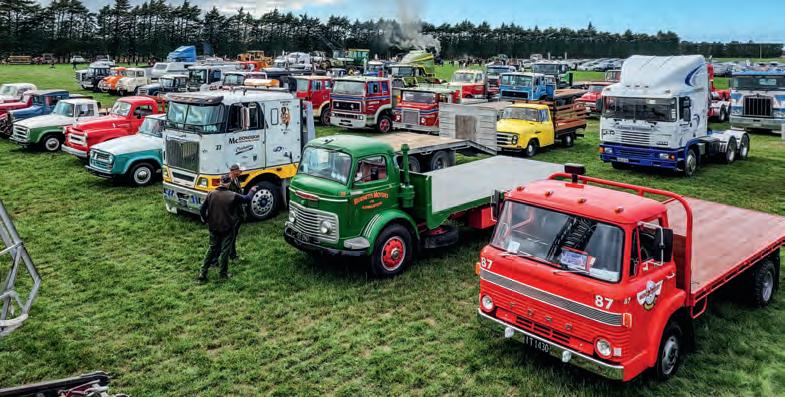



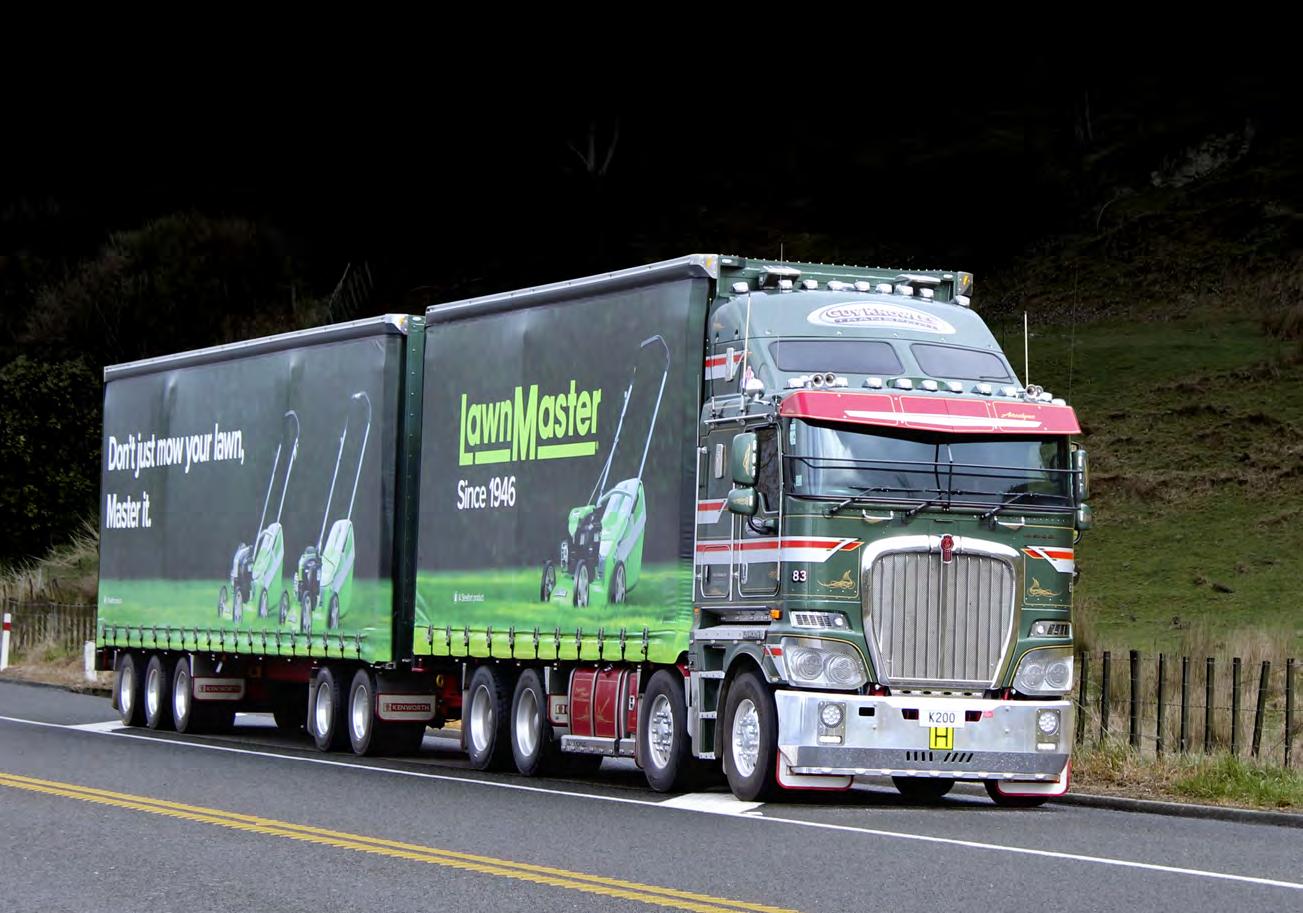
620hp 18 speed manual
Complete with 2016 12.1 metre Fruehauf 5 axle curtainsider –38 pallet unit BPW axles, disc brakes, 19.5 DuraBright alloys right throughout. 50 tonne rated and 23 metre permitted, 930,000kms. Available Now



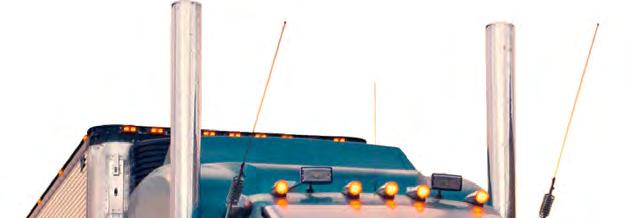



New Zealand Trucking reveals how the economy is travelling via key metrics from the road transport industry.
This information is compiled by Russell Walsh from information provided by the NZ Transport Agency statistical analysis team and through the Open Data Portal.
The data used in this information reflects any amendments to the data previously reported.
This summary includes data from two heavy-truck classes and one heavy-trailer class.
A goods vehicle is a motor vehicle that:
(a) is constructed primarily for the carriage of goods; and (b) either:
(i) has at least four wheels; or (ii) has three wheels and a gross vehicle mass exceeding one tonne.
Note: Vehicle classes are not the same as RUC vehicle types or driver licence classes.

Vehicle class Description
NB
(medium- goods vehicle)
NC
(heavy-goods vehicle)
TD (heavy trailer)
A table of all vehicle classes is in Table A of the Land Transport Rule Vehicle Dimensions and Mass 2016 Rule 41001/2016 https://www.nzta.govt.nz/assets/ resources/rules/docs/vehicledimensions-and-mass-2016-asat-1-October-2019.pdf
A goods vehicle that has a gross vehicle mass exceeding 3.5 tonnes but not exceeding 12 tonnes.
A goods vehicle that has a gross vehicle mass exceeding 12 tonnes.
A trailer that has a gross vehicle mass exceeding 10 tonnes.
First registration of NB, NC and TD class vehicles year on year, to date

First registration of TD class heavy trailers for April, year on year by major manufacturer
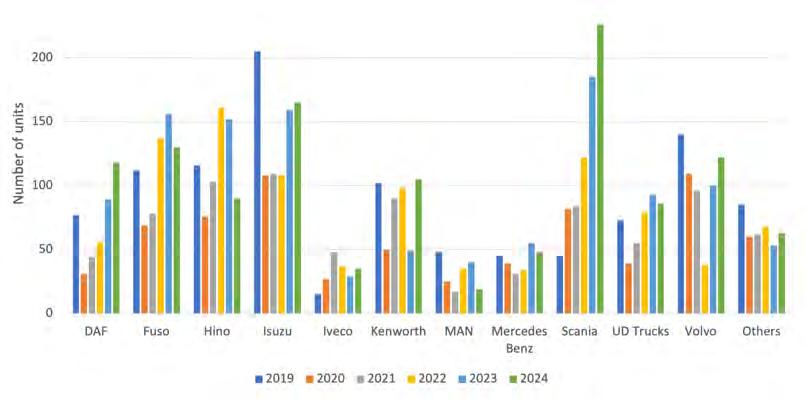
First registration of NB and NC class vehicles for April, by major manufacturer

First registration of NB, NC and TD class vehicles for April, year on year
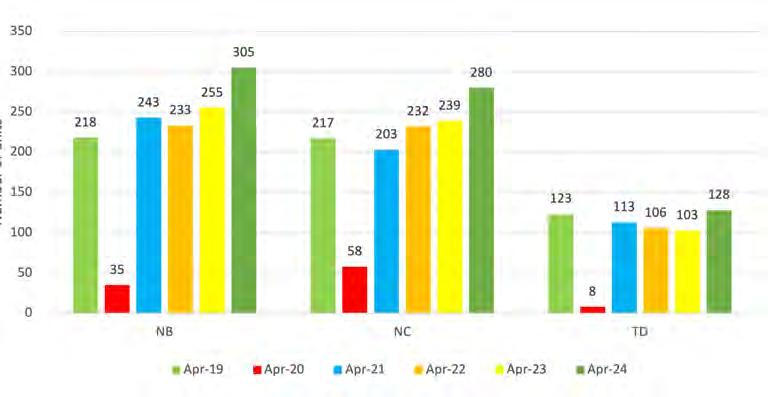
First registration of NC class vehicles year to date 2019 –2024, by major manufacturer

First registration of TD class heavy trailers year to date 2019 –2024, by major manufacturer
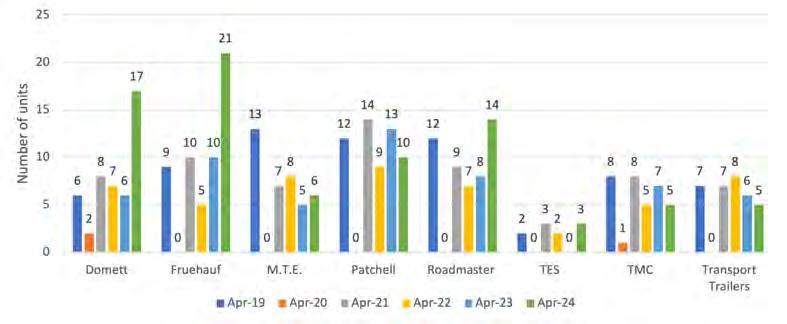
Unfortunately, for the first time in more than four years, the New Zealand Transport Agency has been unable to supply us with the monthly RUC data in time for our print deadline. So, to tide us over, Russell Walsh has compiled an interesting snapshot of the new vehicle market from a couple of different perspectives.
The data used to present this information was supplied by the New Zealand Transport Agency.
Each month, we publish the number of new class NB medium-goods vehicles, class NC heavy-goods vehicles, and class TD heavy trailers, that are first registered in New Zealand. We also publish yearto-date numbers. Along with the number of units registered, the information also provides
details of who is supplying what to the market.
The following chart adds to this information and provides details of the number of units
New Zealand Fleet
of each class in the total New Zealand fleet, as recorded on the Motor Vehicle Register as of 31 December for each year listed.
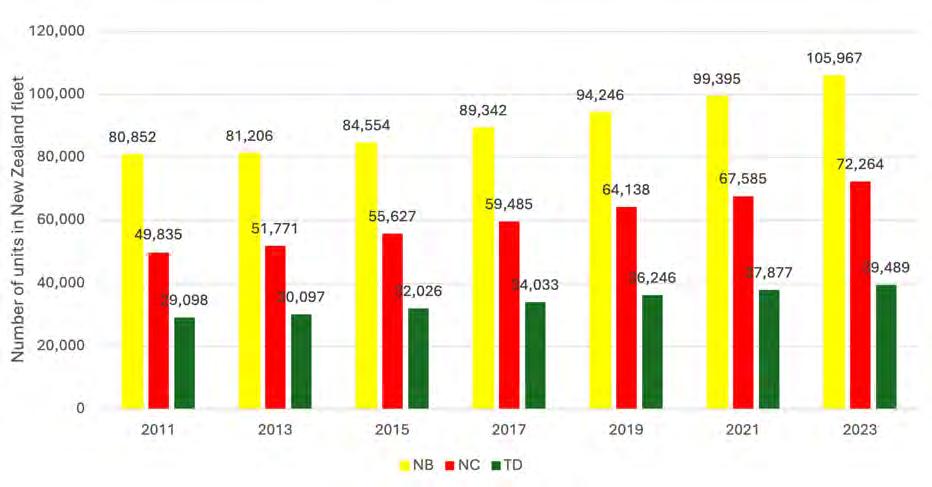
Note: A number of the vehicles counted will be registered but not actually in service.
The trend across all classes has been upwards since 2011 and, apart from natural growth, there will be many reasons for this, including:
(31% increase since 2011)
The increase in online shopping, traffic congestion and difficulty in accessibility for delivery has seen an increase in the need for larger vans and smaller trucks. Difficulty in getting experienced truck drivers for larger vehicles has resulted in
greater use of delivery vehicles that can be driven on a class 1 driver licence.
(45% increase since 2011)
Although it is difficult to prove from the data received, the introduction of HPMV and 50MAX, or lower-bound vehicles as they were originally called, has seen many operators take advantage of the increased efficiency these vehicles can bring.
(36% increase since 2011)
This increase is most likely linked to the increase in class NC as operators seek to leverage the efficiencies 50MAX units offer.
A Goods Service Licence (GSL) is required if you operate one or more motor vehicles that are used to deliver or carry goods, whether the goods are moved for hire or reward or not, and the motor vehicle used to transport
them has a gross vehicle mass of 6000kg or more.
GSLs are not issued to a particular vehicle but to the person notified as being in control of the business. Goods are defined in the Land Transport Act 1998 as “all kinds of movable personal property; and includes articles sent by post, and animals”.
The New Zealand Transport Agency can suspend or revoke a GSL if the holder fails to meet the conditions required to hold a licence. This includes failure to
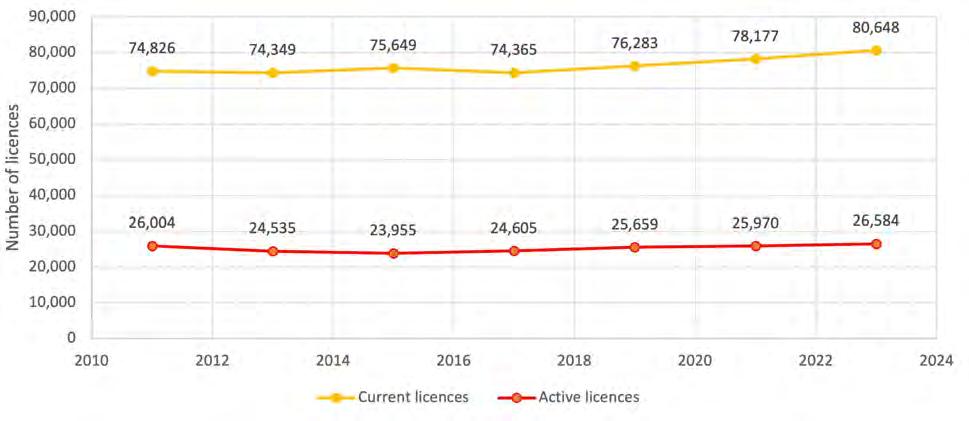
meet the fit and proper person criteria (refer to Subpart 4A of the Land Transport Act).
A current GSL is one that is issued to a person but for
which there is no recent activity recorded against it, for example, a Certificate of Inspection. An active licence has recent activity recorded against it.
As this chart shows the number of active GSLs has been quite steady since 2010 despite the number of goods vehicles increasing during this period,
while the number of current licences has increased. This could be because a number of GSL holders are no longer active but have not surrendered their GSL.
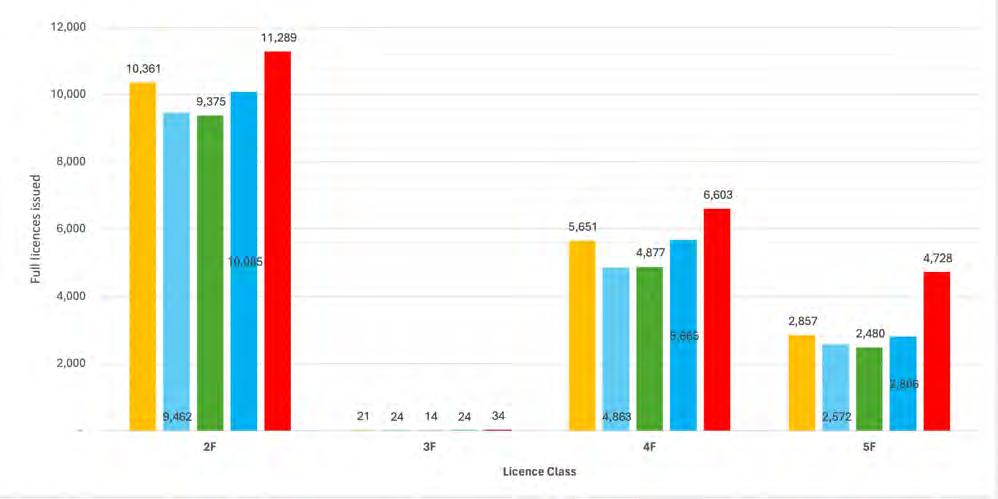
The number of people issued with a heavy-vehicle driver licence, class 2, 3, 4 or 5, continues to hold the steady path we have seen in recent years.
As expected, class 2 has the most people issued with their licence followed by class 4 and then class 5. Class 3 continues on its non-performing path as it has since the current driver licensing system was introduced in 1999. Why the licensing
system continues with this class is a mystery.
Classes 2 and 4 licences are not confined to road transport, as people who wish to drive buses may also require one of these licences. Therefore, the number of new licence holders in these classes is not a fair estimate of the number of people entering the road transport industry, whereas class 5 is largely confined to road transport drivers.
Classes 2 and 4 are also prerequisite licences for those
wishing to progress to a class 5.
The data shows that despite the cost, more and more licence seekers are seeking to go down the approved course path than undertake a Full Licence Test (FLT) through an approved licence testing agency. For the past five years, 2019 to 2023, on average, 10.2% of licences issued for class 2 were for people completing a FLT with 14.6% for class 4 and 20.1% for class 5. Nobody completed a FLT for a class 3 licence.
The increase in class 5 licences
obtained through an FLT could be partly due to an increase in the number of overseas licence conversions, as it is understood that some overseas licence applicants are issued with a full licence but with conditions.
The information depicted in the above chart was provided by the New Zealand Transport Agency from an Official Information Act request and was considered accurate at the time the data was provided.

Maximize your productivity and streamline operations with Dhollandia Tail Lifts. Engineered for reliability and performance, our tail lifts offer seamless loading and unloading for vehicles of all sizes. Whether you're in logistics, transportation, or delivery services, trust Dhollandia for safe, efficient, and durable solutions.







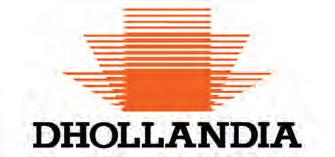
Send your truck to a Southpac Trucks workshop, and MAHA workshop equipment will likely be used to get it back on the road in top condition. Southpac and MAHA have been associated for 10 years, and we spoke to three branches that use the equipment daily.
MAHA RGA Wireless column lifts have become a staple in many workshops nationwide, and it’s easy to understand why when talking with the crew from Southpac Trucks.
“It’s great equipment; we’d be lost without it. They’re the first things that go on a vehicle when we need to get underneath it,” says Andrew Potter, service manager at Southpac Wiri.
“Two of the sets are 10 years old; the other two are just a year old. We bought the two new sets based on the run we had with the first lot,” says Potter.
To manage the volume of trucks the workshop services, Southpac Wiri operates four sets of four, or 16 posts. Flexibility is a big plus, as MAHA columns can be used and adjusted as required, in groups or as a single. Or, with four columns, it’s possible to select two sets of two columns or four sets of one column and use them accordingly on their own channel.
Hannes Van Wyk, service manager at Southpac Trucks Rotorua, agrees that the flexibility in being able to independently control the posts makes work quicker and more efficient.
“It makes life so much easier for the technicians. Say we need to access the transmission, it makes it a breeze to drop a second steer and remove the transmission if they can’t access it from the top. We can lift the truck, drop the axle and roll it back.”
All columns – single or grouped – allow for millimetre control for finite lifting or

lowering. The new MAHA columns have a generous 380mm tine length and lift height of 1750mm.
Over at Southpac Trucks Hamilton, the workshop has operated four posts since inception in 2017.
“They’re still going strong,” says service manager Rob Wilson, adding that wireless control is the most significant advantage to the RGA column lifts.
“I’m an old fella and I can remember when hoists were witchcraft – remotes with cords on them and cables that got torn off … So I’m a big fan of the wireless technology,” he says.
The battery-operated wireless RGA columns have been designed to give approximately 20 full-lift cycles at a 7.5tonne lift per column, or approximately 35 full-lift cycles at a 3.5-tonne lift per column.
Wilson says the batteries easily last a week.

“They get recharged every Friday night, regardless of how much use they’ve had. If they’re charged regularly, they run week to week.”
Each column has a built-in battery charger that uses standard 230V single-phase power.
Further enhancing flexibility, all new MAHA RGA ‘wireless’ columns are available with new ‘adjustable carriages’, that offer a tyre-diameter adjustment range of 550mm to 1500mm.
“We are extremely grateful and quite proud to work directly with such an amazing business that is Southpac Trucks,” says Mick Lauster, managing director, MAHA Australia, New Zealand and Pacific Islands.
“Our success in Australia and New Zealand rests on the employees’ shoulders. The team we have put together over the past five years is extremely professional and experienced and truly makes our business great.”
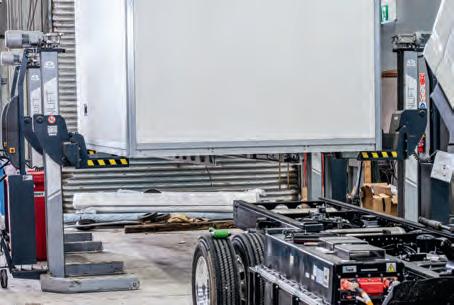
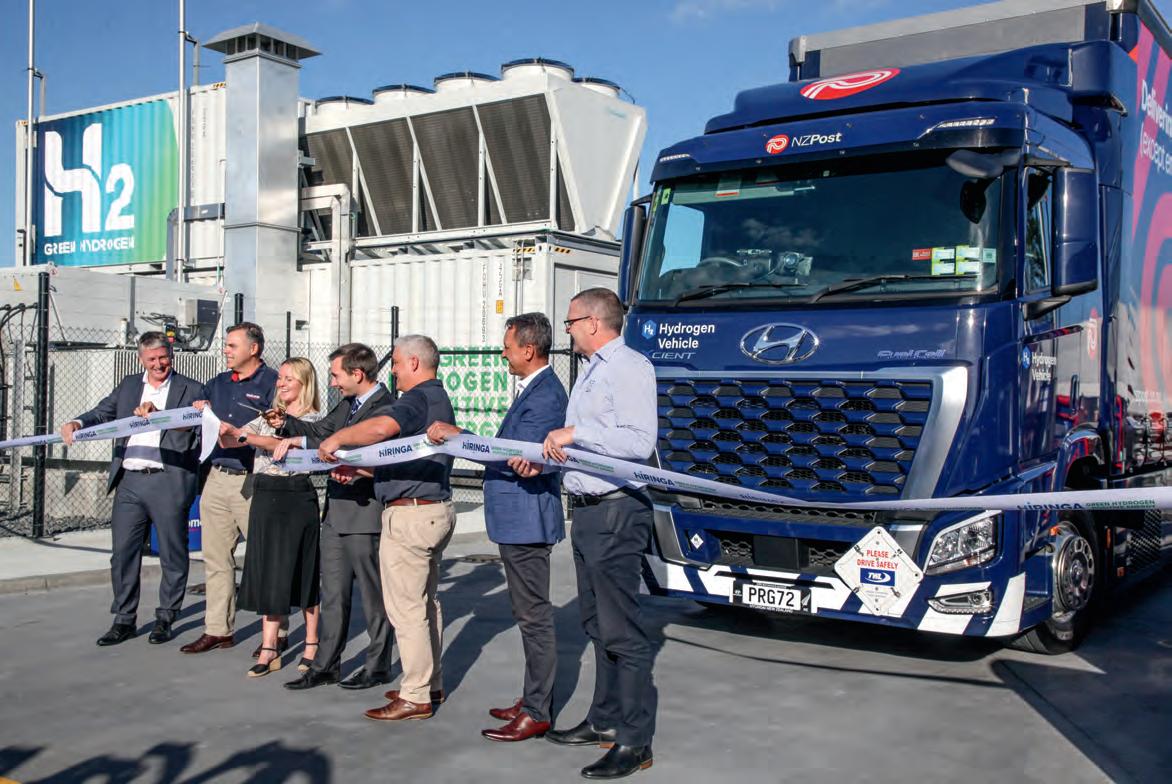
New Plymouth-based green hydrogen company Hiringa Energy has launched Australasia’s first hydrogen refuelling network, opening the taps to another alternative energy option for heavy transport and beyond.
New Zealand Trucking has been following Hiringa’s journey since the company got into its stride about four years ago. It had big plans for an alternative, green-hydrogenpowered future for heavy transport in New Zealand. Through strategic partnerships with Waitomo Group and TR Group, it would construct a network of hydrogen filling stations and offer forward-thinking operators hydrogen fuel-cell vehicles.
In April, the first phase of that refuelling network went online with the official opening of the first phase of three fuelling stations in Wiri (South Auckland), Te Rapa (Hamilton) and Palmerston North. The fourth station will be located at a new site as part of upcoming roading infrastructure developments along SH29 in Tauriko, Tauranga.
A subsidiary of Hiringa Energy, Hiringa Refuelling New Zealand is focused on deploying a nationwide high-capacity,
open-access hydrogen refuelling network to service heavy road transport. In time, further stations will be rolled out at key locations on both islands, and Hiringa says the first four HRNZ stations will service 95% of heavy freight across the North Island.
While it may seem like a long time coming, it’s in fact taken around seven years to reach this point. “We’ve started a whole industry,” says Andrew Clennett, Hiringa CEO, acknowledging the hard work by all involved and adding that the chicken-oregg conundrum of whether the vehicles or infrastructure should come first has now been answered.
The company says the heavy transport sector makes up 4% of the vehicles on the road but produces 25% of New Zealand’s transport emissions.
“It’s crucial we rise above the debate of ‘is it this or is it that?’ or what the silver bullet is. We need all the tools in the tool kit,
including things we haven’t even thought of. You don’t play golf with one golf club,” says Andrew.
“As a first-of-its-kind across Australasia and one of the first networks set up globally to service heavy transport, the initiative addresses this major challenge by providing operators with the infrastructure they need to switch to zero-emission transport in an efficient, scalable and commercially viable manner.
“This network allows the heavy transport industry to adopt the technology to start shifting the dial. We don’t know trucks. TR Group knows trucks, and without Brendon [King] and Andrew [Carpenter], we wouldn’t have a chance. We will build the supply as the demand is brought on. Independent analysis suggests parity with diesel can be reached by the end of this decade if we drive the scale. The investments we make now will unlock productivity gains well into the millions,” he says.
The hydrogen is produced, stored and dispensed onsite. Heavy transport vehicles such as trucks and buses will be able to refuel with green hydrogen in 10 to 20 minutes. The system can refuel multiple heavy vehicles (30-50kg tanks) back to back
Minister of Transport Simeon Brown officially launches the network, surrounded by key partners from Hiringa, Waitomo and TR Group.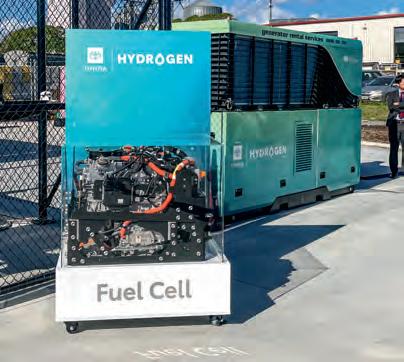

was used to demonstrate the refuelling process. In about a year of commercial operation, the truck has completed more than 70,000km, eliminating the need for an estimated 29,700L of diesel and 80 tonnes of carbon dioxide emissions.
at a flow rate of 60g/sec. It is designed for future upgrades, including doubling daily capacity and high flow rates of 120g/sec.
The hydrogen is stored in a multipleelement gas container (MEGC), designed to safely hold up to 730kg of hydrogen gas at up to 350bar. This equates to two days of hydrogen production, enough to fill about 20 trucks. The containers hold 18 vessels in six groups (called banks) of three. Each individual vessel is made of a plastic liner with fibreglass wrap (type IV) and has a volume of 1700L, holding 41kg of hydrogen at 350bar. The vessels are corrosion-resistant, and each bank is protected by a thermally activated pressure-relief device. Each station has one MECG onsite and one mobile unit to transfer capacity.
Technically, hydrogen is an energy carrier (like electricity) and not an energy source. It is produced at the HRNZ sites through electrolysis (passing electricity through water to separate the hydrogen and oxygen molecules). As this process makes use of renewable energy sources like solar or wind power, it is termed ‘green hydrogen’. The onsite electrolyser has a capacity of 440kg per day.
The only by-product is pure oxygen, released into the atmosphere. Electrolysis requires a surprisingly small amount of water compared with other existing industrial and agricultural processes. Technology is being developed to create hydrogen from seawater to ensure hydrogen production at very large scale will not compromise access to fresh water for other uses.
Once produced, the hydrogen is then compressed and stored onsite, ready to be
(See More About Hydrogen below to learn how the hydrogen is produced.)
“What we’ve done here isn’t just a demonstration – we’re not talking about one station but four, not kilogrammes but tonnes, not kilowatts but megawatts. To make an impact, we had to think big and that takes an entirely different engineering and technological strategy. We’ve thought about redundancy, backups and fail-safes – this network is about commerciality. It’s a go-big or go-home moment,” says Dan Kahn, co-founder and CTO.
“Waitomo believes in a just transition and that’s why we’ve joined the journey and invested in this network. We’ve long said hydrocarbons would fund the transition, and we can see that in this multi-use site,” says
Simon Parham, CEO Waitomo Group.
“It’s about maintaining a viable operation while investing in a sustainable future. That’s why this network isn’t just infrastructure; it’s a gateway to a hydrogen fleet. One hydrogen truck equals a hydrogen reduction equal to up to 150 EVs. This is where the decarbonisation prize exists.”
As for the trucks, they are expected to arrive later in 2024. Brendan King, general manager of TR Group, says that when it comes to climate change, taking a leading position is important.
“There are currently 20 Hyzon trucks in Melbourne headed for our market. We couldn’t commit to these trucks without the likes of Hiringa and the customers who are committed to this cause.”
dispensed. To create the power it needs, a fuel-cell electric vehicle (FCEV) essentially reverses the electrolysis process (and, as such, its only emission is water vapour). The onboard fuel cell combines the hydrogen with atmospheric oxygen in a chemical reaction to release energy in the form of electricity, which is stored in the vehicle’s battery packs and powers its electric motor.
As an alternative to battery electric vehicles (BEVs), hydrogen fuel cells provide longer distances, faster refuelling times, and should therefore be better suited to heavyduty vehicles and long-haul transport.
In addition to transport, Hiringa aims to accelerate the adoption of green hydrogen applications across multiple sectors, including aviation, construction, rail, marine, materials handling, off-highway and remoteuse stationary power. Hiringa has a strategic alliance agreement with Air New Zealand,

Hydrogen is produced and stored onsite, and kept well away from users on the forecourt.
along with being a partner in the Hydrogen Consortium, to pioneer New Zealand’s commercial deployment of green-hydrogenpowered aircraft.
The launch event was silently powered by a hydrogen fuel-cell generator to demonstrate this particular use case.
Left: The Toyota hydrogen fuel-cell generator that powered the launch event. Right: New Zealand Post’s Hyundai XCIENT Fuel Cell truckThe quality of transmission fluid is critical when operating heavy vehicles, especially in extreme driving conditions such as heavy loads, steep terrain, continuous operation and frequent starts and stops.
Whether on the field, road or site, a vehicle’s drivetrain must withstand heat and friction to avoid premature wear and failure. Heavy vehicles such as trucks benefit from the protection of high-performance transmission fluids.
Transmission fluid cools and lubricates, ensuring the smooth performance of the vehicle. It also helps transport operators keep their fleet running while avoiding costly downtime and repairs.
Gulf Western’s SYN-TS HD is a technically advanced, next-generation fluid for on-highway Allison transmissions, offering enhanced protection and extended drain intervals.
SYN-TS HD is a fully synthetic formulation with long service life and transmission reliability, as well as anti-wear performance beyond the reference fluid. It has excellent clutch friction durability, ensuring consistent shifts across all operating conditions, and superb thermal and oxidative stability, offering enhanced transmission cleanliness and reliability.
• One of only 33 Allison TES-668 approved products globally and backed by a full Allison warranty, as well as a Gulf Western Oils warranty.
• Much longer drain interval. Severe application, Syn-TS 60k, Syn-TS HD 240k.
• Much more shear and stable formulation. Syn-TS HD maintains its viscosity/film thickness much better throughout the drain interval, offering maximum protection.
• Anti-shudder performance and durability are more than 10 times better than the reference oil, which outperforms Syn-TSstyle multi-vehicle ATFs.
• Backwards-compatible with formal TES 295-approved products (eg, Castrol Transynd).

Approved against the latest Allison TES 668 specification and backwards-compatible with earlier on-highway transmission fluids, including Allison TES 295, Gulf Western’s SYN-TS HD offers extended drain capabilities while maintaining enhanced equipment reliability, offering enhanced protection and extended drain intervals of up to 240,000km.
Founded in 1915, Allison is the largest global manufacturer of fully automatic transmissions for medium- and heavy-duty commercial vehicles, including on-highway trucks and buses. Gulf Western specifically designed SYN-TS HD for Allison Transmissions, and the oil was formally approved for TES 668 specification. It is also backed by an Allison factory warranty.
Allison transmissions’ key focus areas include on-highway trucks (distribution, refuse, construction, fire and emergency), buses (school, transit and coach) and motorhomes, and Gulf Western’s SYN-TS HD has been approved for use in these applications.
For more information on SYN-TS HD and the Gulf Western Oils range, contact your local NAPA Auto Parts rep or call 0800 800 073.
















VALID 1ST JUNE - 31ST JULY 2024






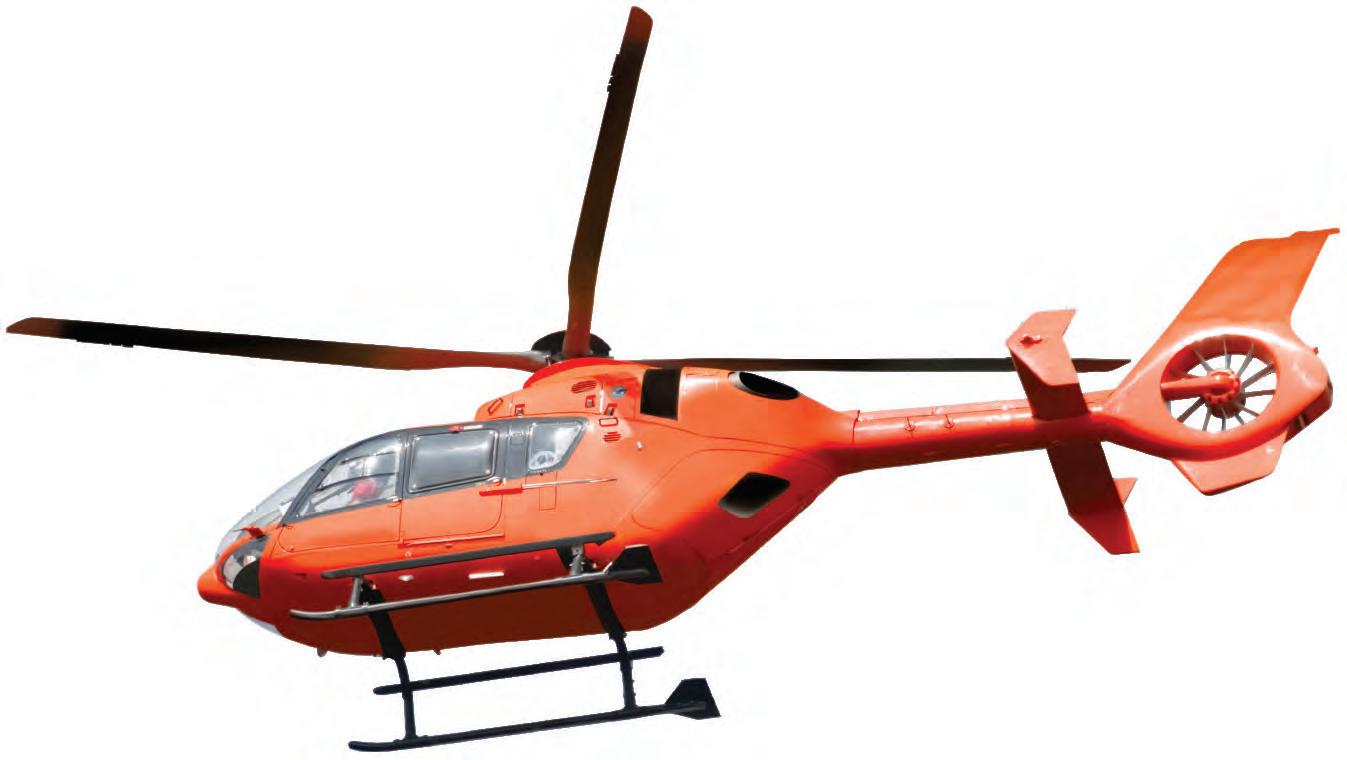
SPEND $100* ON PARTICIPATING BRANDS TO GAIN ONE ENTRY INTO THE DRAW.



WIN A DOUBLE PASS TO THE ULTIMATE SEMA 2025 EXPERIENCE.




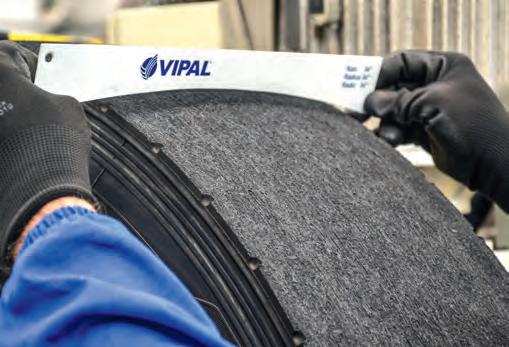
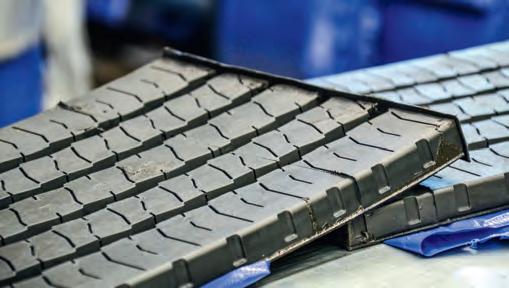
Retreading tyres offers operators many benefits.
Many things can influence the lifespan of a tyre, including smart driving habits and regular vehicle maintenance. However, as with any vehicle part, wear and tear eventually take a toll, and your tyres may no longer be fit for use.
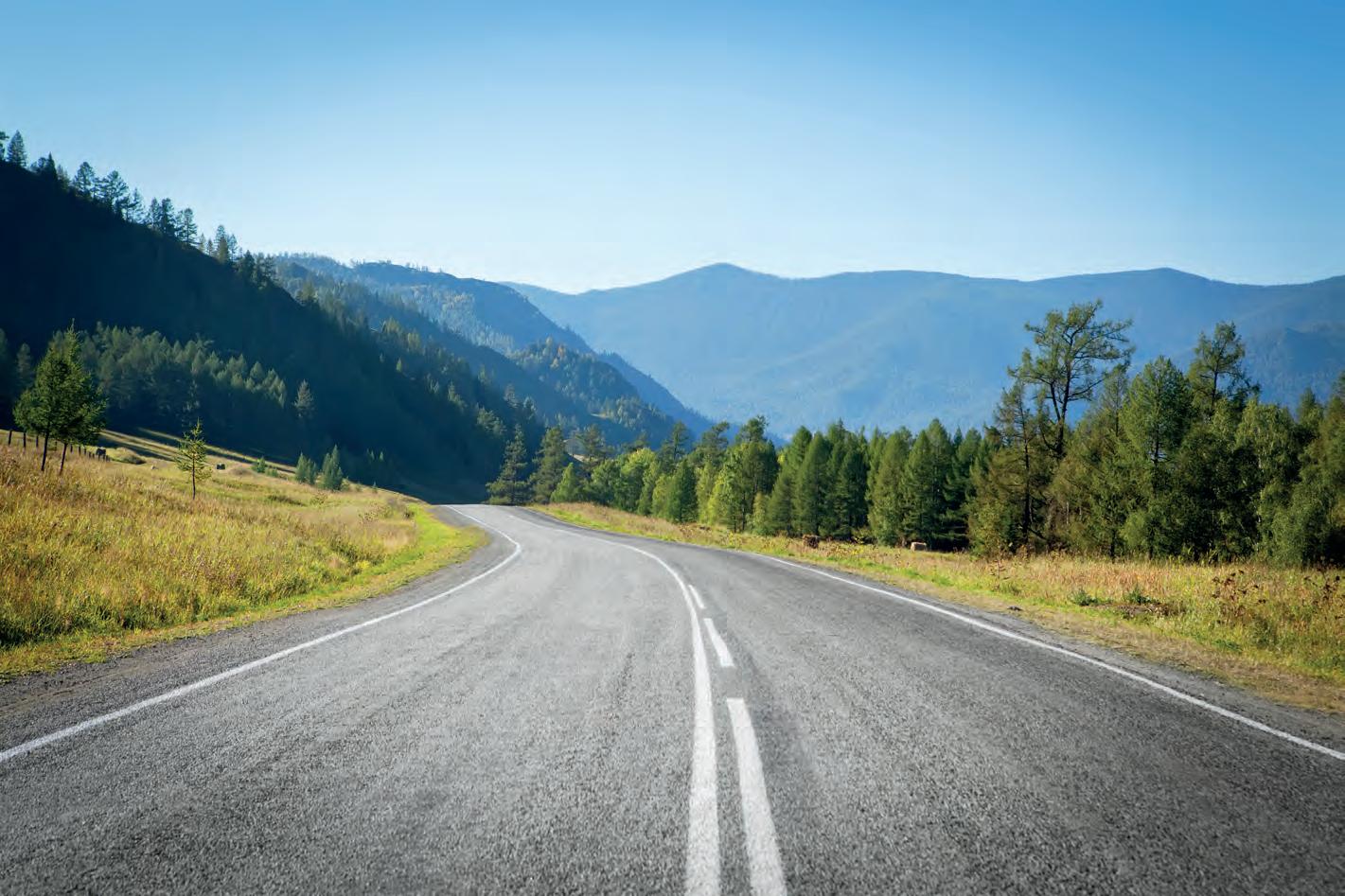



While many transport operators simply replace their tyres and dispose of the old ones, retreading tyres instead can offer a range of benefits that can directly enhance your operations, improving the bottom line and overall efficiency.
Retreading a tyre, instead of disposing of it prematurely, returns it to service as if it were new, with the same performance and safety.
In fact, manufacturers of new tyres design them specifically to uphold extra tyre life, based on the prediction they will undergo retreading in the future.
Retreading is much more than transforming used tyres into
Most aircraft companies around the world use retreaded tyres, including commercial and military aircraft.
The average life of the retreaded tyres is approximately 250 flights or 25 days.

reusable ones. The materials used for retreading tyres are scientifically developed to withstand the work and the conditions the tyre was designed for, making it 100% safe.
The retreading process involves cleaning, inspecting, buffing, skiving and repairing
the tyre, followed by reinspection and cementing the tyre. It is then built and cured, followed by a final inspection.
By extending the life of the tyre, the premature disposal of the casing is avoided, promoting sustainable practice and saving natural resources and energy.
Ron Wood was a prolific truck painter in the 70s and 80s when Macks, Kenworths, and Volvos were all assembled at Palmerston North. He amassed a collection of truck photographs, now long lost, which his family would love help in recovering.

Benefits of retreading your tyres:
• Retreading extends tyre life, which benefits the environment
• a retreaded tyre is as safe as a new one
• the per formance is equal or higher than a new tyre.
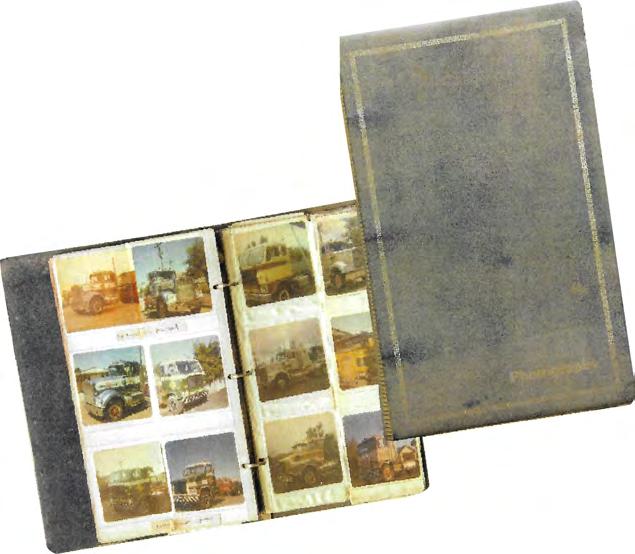
collection of albums to a visitor looking for some pictures of his own trucks. Unfortunately – and quite possibly without ill intent, they were never returned.
We would LOVE to get these back – or even just borrow them, just so that we can scan the pictures. If anyone has seen these or know where they might be, we would be forever grateful.
The Albums were actually pretty rough (as were the photographs!) –cheap, plastic seventies ring binders in bright colours like blue and orange …and covered in over-spray from the paint shop. One surviving example can be seen above.
If you can help, please contact: Greg Wood 021765 768 or email


Blake Noble reminds operators why they need to be prudent and firm in the leadership of their businesses.
As I sit here composing this column, a pop-up headline has flashed up and caught my attention, relaying the sad news of the liquidation of a well-known Christchurch-headquartered fleet. This is tragic for those linked to that business and for the wider industry. But if I’m honest with myself, I’m surprised that there haven’t been a few more of those same liquidation headlines, given how tough things are out there and the undeniable challenges to make ends meet.
Numbers bandied about by operations regarding potential volume decreases range anywhere from 5-25%-plus; these are definitely material numbers in any of our businesses. Headlines abound in aligned sectors, and the output reductions are seen and felt. In Marlborough, the recent grape harvest was well down on previous seasons, a boon for some overstocked marketers, but not so flash if your livelihood relies on the transport there. Meat processors have similarly occupied media column inches for the pain being felt, resulting in some challenging financial performances and again culminating in material reductions in the transport task at hand – fewer animals from the farm for livestock operators to take to the works, less finished product from the works to the cold store and, ultimately, less to the supermarket or port.
A recent article from the United Statesbased Freightwaves media outlet reported road-freight carriers there had sustained reduced volumes post-Covid for two years. Given that most New Zealand-based carriers only reported seeing a real decline in volumes in the back half of Q2 last year, does this mean we still have another 12 months of turbulence ahead of us? The current levels of heightened inflation and the consequent decision by the Reserve Bank to keep the OCR at an equally elevated level certainly don’t point to an easing of those pressures any time soon.
I don’t paint this picture to be a doom merchant, but rather as a prompt to remind us about the need to be prudent and firm in the leadership of our operations, particularly regarding affording credit to our customers.
I was recently exposed to an operation with many customers/debtors sitting at 90-plus days in arrears, some of the balances being rather significant. While the carrier owner thought they were doing the right thing in supporting their customers, they were creating cashflow issues for their company. Worse though, they’re likely providing the means for an insolvent
…they’re likely providing the means for an insolvent business to keep trading ‘recklessly’, and potentially making the ‘bang’ even bigger when things do pop, let alone the likely domino effect triggered as a result.

business to keep trading ‘recklessly’, and potentially making the ‘bang’ even bigger when things do pop, let alone the likely domino effect triggered as a result.
Right, so enough of the doom and gloom. I reference the above because everyone wants to be trading comfortably, and revealing some of the above may lead to some operators taking a serious look at how they’re doing things, muscling up an ounce or two of courage, and changing the shape of their operation and adapting to the current conditions.
Potential short-term pain in doing so? Yep, more than likely. But at least they’ll have some semblance of control by making some of those tough decisions – and no, not the ones that revolve around cutting a magical percentage off their current rates and hoping like hell that’ll buy them the volume they’re chasing.
At the end of the day, all company directors sign up for a clear set of obligations regarding the solvent trading nature of their business, generally summed up as “the ability to meet their obligations as, and when, they fall due”.
Ensure you don’t end up as the meat in the sandwich and allow that solvency rubber band to stretch beyond its intended length; it might really hurt when it snaps!



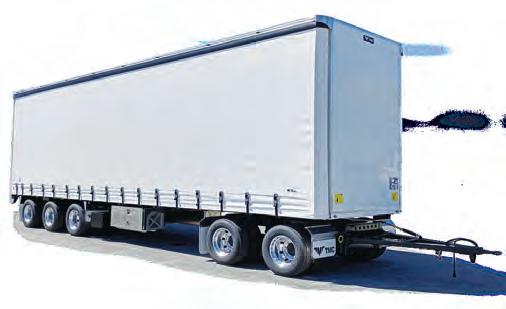

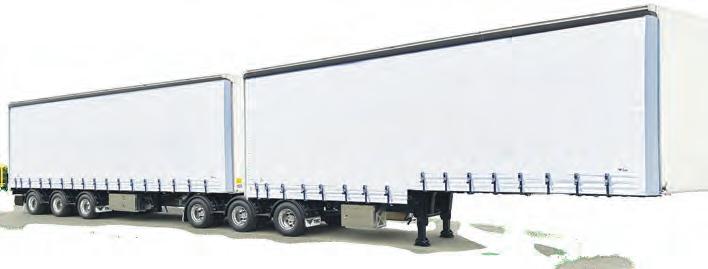



Health and fitness guru Laura Hulley shares fun ways to get active without having to sign up for a gym membership.
Having worked in a gym for almost a decade, I am a massive advocate of the environment and its endless benefits. Everyone has a different back story and reason for stepping into a gym, and they experience different benefits and payoffs.
On the other hand, I understand not everyone thrives in a gym environment and that it can be quite daunting to walk through those doors, let alone workout in front of strangers. Also, if you travel for work, it may be a challenge to form a routine around the gym unless you are a member of a chain and can access a franchise in different locations. So here are some fun and different ways to get active without a gym membership.
Joining a sports team comes with its commitments, but social teams are usually fairly flexible and easy-going on training nights and game days. For example, with most rugby teams, you can attend one training a week, or even just game day (if you’re lucky) and you can have a run around on the field with your mates. Sports teams are also ideal for meeting new people and filling your social cup. Often, when you’re out on the field or court, you don’t realise you are doing a workout as you’re part of a team and focused on the game and doing your best for your teammates.
The options are endless for finding a hobby that gets you up and active. If you enjoy water sports, give kayaking, stand-up paddle boarding, rowing or swimming a go. Given that we are heading into winter, you may not be keen to hit the water on a frosty morning, so an indoor heated swimming pool might be a good option if you’re a water bug. If you prefer to be on land, cycling is a great way to stay fit and is a good
low-impact option if you’re carrying any injuries. If you don’t have a bike or don’t live somewhere that lends itself to cycling, you could always get a cheap stationary bike, park it up in your garage and clock up the kilometres from the comfort of your home. Walking or running are the cheapest and most accessible active hobbies. If you find running too difficult or jarring, walking is a great option, and something you can do anywhere after a day on the road. Once again, if you don’t want to venture outdoors, you can pick up a cheap treadmill and pop it in your garage, hiding from the elements while you work up a sweat.
This may sound like a stretch, but believe it or not, it all really adds up. Weight loss and calorie burning don’t just come from exercising; they come from NEAT (nonexercise activity thermogenesis).
In layman’s terms, this is all the energy we expend from day-to-day activities. Things like gardening, mowing the lawns, vacuuming, housework, renovation/DIY projects – these productive activities around the home also help us to stay fit, burn calories and lose weight. We can tick off our jobs list and get a workout – two birds, one stone!
The beauty of group fitness classes is that you can pick and choose when you go, and there isn’t the financial commitment that there is with a gym membership. There are now group fitness classes to suit all ages, interests and fitness levels, from boot camps to pilates, martial arts, aerial, boxing and everything in between.
Most clubs offering group fitness training allow you to join classes sporadically or regularly – meaning you can come and go as you please and work around your work and
life commitments. For example, one week you could go to boxing on a Monday night; the next week you could go to boot camp on a Wednesday night and just pay as you go.
At the end of the day, you need to find a style of exercise you enjoy because if you like what you’re doing and it doesn’t feel like a chore, you are more likely to stick to it. It’s important to give different types of active hobbies, classes and workouts a go before you write them off – you might surprise yourself and enjoy something you were sure that you wouldn’t.
Right now, I have a seven-month-old, so going to the gym is not really an option for me as I can’t take him with me. So, I purchased a boxing bag and do short boxing workouts in my garage while he is sleeping. We also go out for daily walks as he enjoys being outside and it’s important for me to get a break from the house and some fresh air. Before I had a child, I would be at the gym six days a week and loved it. But as situations change, we must pivot and adapt and do what works around our schedule and life commitments.
As truckers, you often work long and unpredictable hours, so you need to find hobbies and exercise routines that are flexible and can mould around your changeable lifestyle.
Laura Hulley Personal trainer



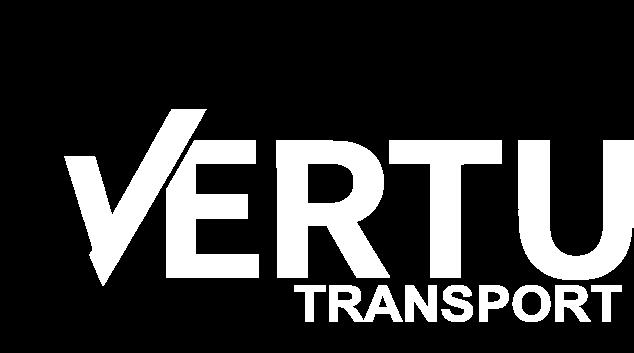

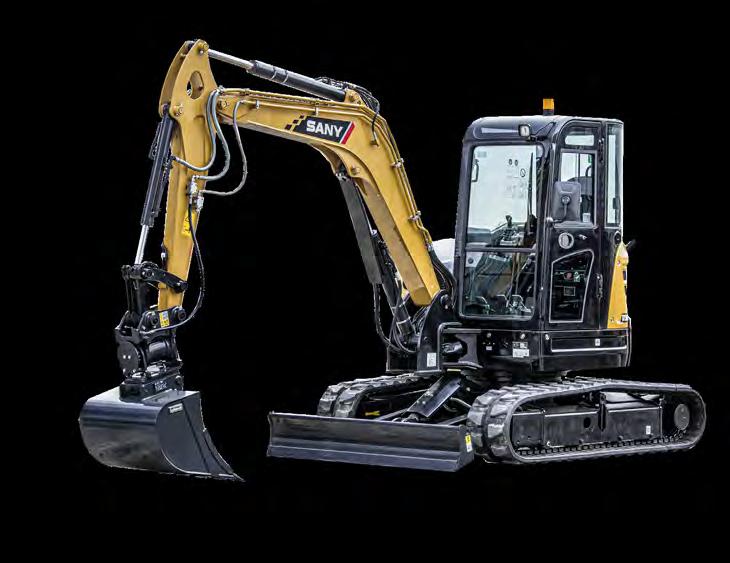




Kaye Byrne discusses the importance of onsite traffic management.
We have all been stuck in roadworks at one time or another, but does traffic management sometimes confuse you? Are the gaps between the cones big enough for a vehicle to weave in and out? Are the arrows pointing in conflicting directions, or are the road signs and cones out, but there is no sign of activity? The risk of vehicle incidents increases when the traffic management plan presents itself in a confusing manner for road users and for road workers.
Your workplace can be equally confusing and prone to risk, especially if the site is new. Workplace traffic management has three aspects: the site, vehicles or machines, and people. Improving safety at the worksite means reviewing the site’s layout, the purpose and how it is used.
Is the site systematically designed? Is the speed limit clearly visible? You may have to consider speed changes or other measures to slow down traffic. Are traffic areas separated so that equipment such as forklifts can be segregated from the trucks?
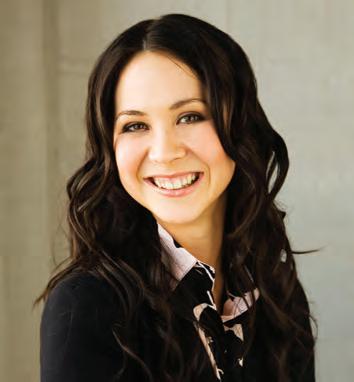
Is the workers’ parking area outside the operating area? Can visitors easily identify the parking area and is it far from any onsite activity? A one-way traffic flow system is always a great way to predict traffic flow and requires little or no turning. Are walkways clearly marked? Marking them with lines works well, as does using objects such as cones and planter boxes.
Think about your vehicles or machines. Are they fit for purpose? Are the machines visible, and do they have lights, beepers, colour, etc? Can the workflow be configured to reduce interactions between vehicles, machines and people? People need to be aware of the traffic flow. For example, are they likely to come into the pathway of a forklift or truck? They must understand the safe places to stand when loading and unloading is taking place. Staff must be aware of their surroundings and what is expected of them. This is achieved by conducting inductions with all staff, contractors and visitors.
Creating and documenting a traffic management plan is a wise choice. Management needs to be involved as well as employees. This enables a comprehensive review of the traffic management plan, leading to a better plan and greater compliance.
Check it periodically to ensure it’s up to date and functional. Any change in work may require a change in the plan. Planning for traffic on your worksite is an easy and effective step towards keeping people safe.

Kaye Byrne is a health and safety consultant who works for Safewise, a health and safety consultancy organisation. Kaye has been in the health and safety field in one way or another for the past 10 years, most recently as a consultant. Kaye has experience working with many different industries and people. She holds a New Zealand Diploma in Workplace Health and Safety Management (level 6) and is a member of the New Zealand Institute of Safety Management.


If you have been arrested or charged with an offence, it helps to be familiar with the New Zealand Bill of Rights Act 1990, which sets out several important legal rights and protections. This month, I will be summarising some of these sections. If you understand how the law works, you can minimise some of the negative consequences of arrest and prosecution. Some of my clients keep a small card in their wallet with my telephone number and bullet points to remind themselves about these rights. This means they can be prepared in the event of any encounters with the police.
If the police ask you for your name, date of birth and address, you must provide them. If you have given them your correct details and you are not under arrest, you can walk away and say nothing. Sometimes you will be handcuffed, and it will be obvious. But if you’re unsure whether you have been arrested, just ask. If someone else you know has been arrested, call a lawyer.
If you have seen someone committing a crime, you can report it to the police and make a statement. If you do so, you may be called as a witness to give evidence in Court if the alleged offender pleads not guilty. It is helpful to write down everything as soon as possible after any incident because you don’t know how long it will be before the matter goes to Court. This applies equally to anyone charged with an offence because your memory will fade with time.
If you have been arrested, you must accompany the police, even if you haven’t done anything wrong. If you struggle, you can be charged with obstructing a constable or resisting arrest. If you run away after you’ve been arrested, this is an offence, and you can be charged with escaping custody. Don’t even consider this as an option because it will only land you in more hot water. Just remember that the matter can be sorted out with the assistance of a lawyer when you go to Court.
Ask why you have been arrested because the police must tell you. If they want to ask you questions about what has happened, do not say anything until you have spoken to a lawyer. This is very important. If you don’t know any lawyers, the government pays for lawyers to be available to contact by telephone 24 hours a day, seven days a week. The police can give you this list of lawyers and you must be allowed to speak to them without delay and in private. Be persistent about asking to speak to a lawyer and keep asking until you are allowed to make the call.
Protect yourself by always having the contact number of a lawyer with you. Taking legal advice before you speak to the police could make all the difference. For example, if you have a defence, it is often advisable to disclose it at the earliest available

opportunity. However, whether your explanation provides you with a defence rather than being simply a mitigating circumstance can be a fine line, particularly for someone without any legal training. If you do make a statement without consulting a lawyer and it prejudices your position, the damage may be irreversible.
You do not have to answer any questions or make a statement. It is a serious offence to give a false statement. You can be charged with giving a false statement or perverting the course of justice, so the decision to communicate with the police must be carefully considered.
Don’t be fooled into thinking there is such a thing as an off-the-record conversation when you speak to the police. No matter how friendly they are, remember that they can use any comment you make as evidence against you when you go to court. This includes informal chat in the police car on the way to the police station. So don’t get into a conversation with them at all, even if they aren’t holding a pen and paper while you’re speaking.
If at any stage you are unsure about what you have to do or don’t have to do, ask the police what your rights are because they have to tell you.
Next month, I will discuss more about your rights once you have been charged and need to prepare a defence. If your rights are breached, there are some remedies you can pursue. These depend on the nature of the breach, and I will outline some of these options.
Please note that this article is not a substitute for legal advice, and if you have a particular matter to be addressed, you should consult with a lawyer. Danielle Beston is a barrister who specialises in transport law, and she can be contacted on (09) 985 5609 or 021 326 642.

Contacts:


More big climate stuff in the oceans … In part one, which explored sea-level rise and heat storage, I promised a dive into freezing, acidic oceans. Ready? Let’s go!
‘Ocean acidification’ is increasing acidity due to carbon dioxide from the air dissolving into the sea. This CO2 restricts marine organisms from accessing the carbon and calcium needed for growth.
Sixteen years ago, after puzzling problems, Oregon’s huge Whiskey Creek Shellfish Hatchery experienced catastrophe. “One morning, we came in, and everything was dead, all of it,” reported production manager Alan Barton. “It was our worst day but also our best day.”
Why? Because they realised the problems weren’t due to disease or contaminated feed, but ocean water. Researchers found the critical issue was extra dissolved CO2, which was impeding day-old larvae from building shells with nutrients from their eggs, compromising their lifelong development.
Stats NZ reports a huge 30% increase in ocean acidity, which is undermining “the building blocks for the skeletons and shells of many marine organisms” that form the basis of marine food chains.
So next time we launch our tinny and bait up our hooks, let’s give a thought to the CO2 from our exhausts putting kai moana, and much more, at risk, to the extent that the McDiarmid Institute ranked ocean acidification as “the most serious humanbased threat to New Zealand’s marine habitat”. It’s quite something when oceans also deal with pollution, sedimentation, overheating, habitat loss, and more.
Now for a huge, alarming, but littlediscussed ocean phenomenon – the disturbance of the majestic deep ocean circulation system. It takes a little unpacking.
Deep in the oceans is an astonishing current primarily driven by, wait for it, saltiness (salinity). It’s so huge, its flow is


many “sverdrups” (1Sv = 1,000,000m3 per second, about 300 Waikato Rivers, or five Amazons.)
Nicknamed “the global conveyor”, this system cycles over centuries, absorbing heat and CO2 from the air, distributing oxygen and nutrients worldwide, and shaping global climate.
A significant driver is ‘deep water formation’, when water freezing into polar sea ice leaves its salt behind in the unfrozen water, which is then dense enough to sink, propelling this amazing system.
Now the bad news: global warming is causing a vast flow of fresh meltwater into polar oceans and a huge reduction in sea ice formation, so salination is rapidly declining.
Yale Environment 360 tells us scientists conducting “agenda setting” modelling predict the Southern Ocean will experience a whopping 42% reduction of deep water formation by 2050, and “it looks headed towards collapse this century”.
That’s massive, threatening widespread climate upheaval on steroids. Take the Gulf Stream, the pale blue current running from the Caribbean up past northwest Europe and saving Britain, Germany and so on from winters like Siberia and Canada. Imagine if that shut down …
Mind-boggling consequences like that should encourage us to ask, “Do I really need to do this?” whenever we fire up a diesel or
petrol engine.
The bulk of the oceans may be out of sight, but it definitely shouldn’t be out of mind.
(A small but significant formatting error crept past the editing process of last month’s Clear the Air. We printed that a zettajoule is “1021 joules”, when in fact it is 1021 joules ... an astronomical difference! That’s 1,000,000,000,000,000,000,000 joules, or about 280,000,000,000,000kWh! – Ed.)

Lindsay Wood, MNZM, is founding director of climate strategy company Resilienz Ltd, and in 2024 was made a Member of the New Zealand Order of Merit for services to climate awareness and environmental sustainability. Lindsay is active in policy arenas, develops tools to support decarbonisation, and speaks, writes and broadcasts widely on climate issues.
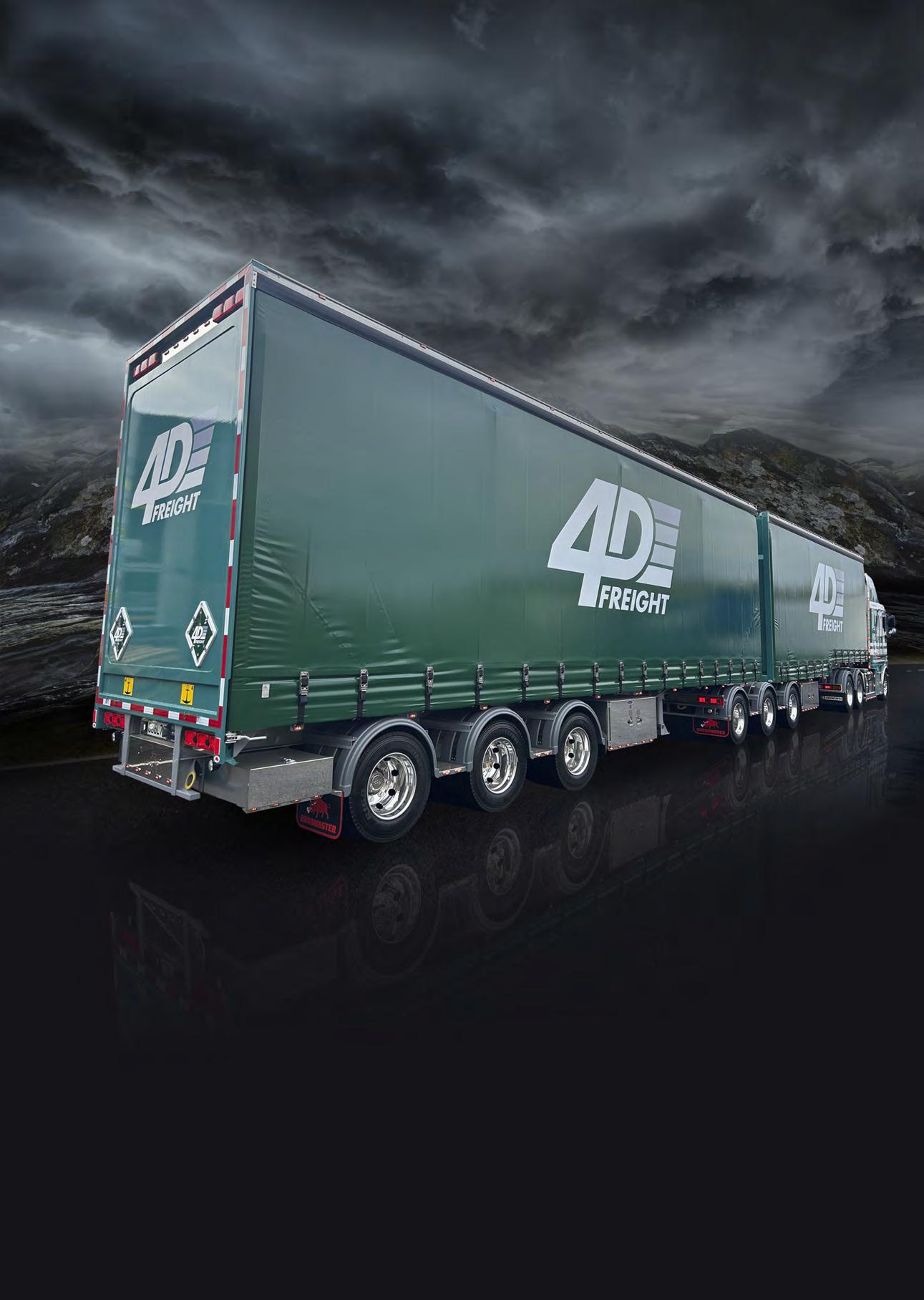

6-AXLE HPMV 23M 36 PALLET GLIDEMASTER DRY FREIGHT B-TRAIN
8.350MM FRONT UNIT & 10.350MM REAR UNIT
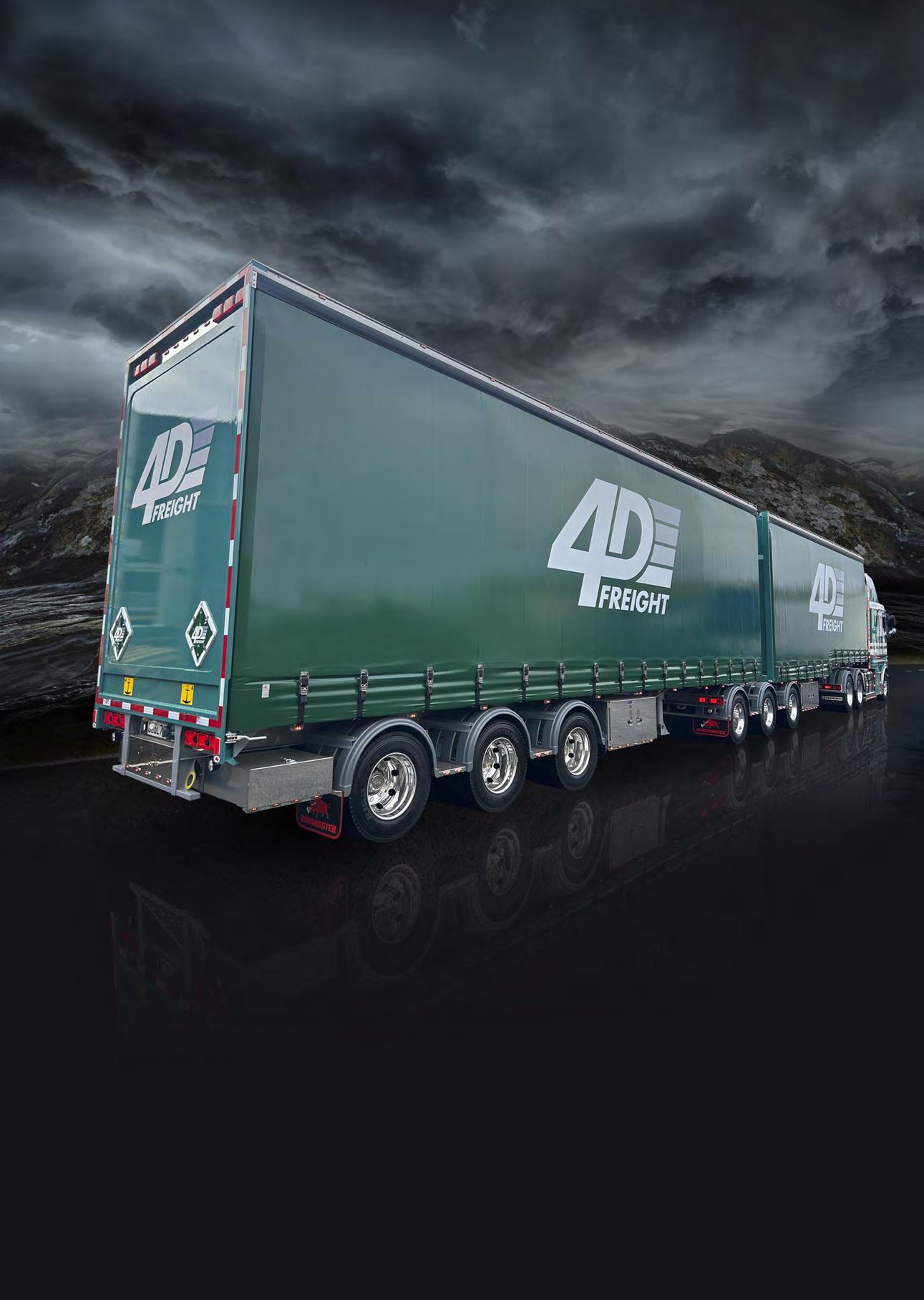

Customised FOr:

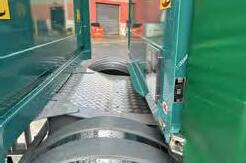
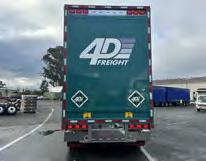

FEATURES:
• Custom stainless steel bumpers
• Stainless steel inlays set in guards
• Custom stainless steel light bar inlays
• Custom stainless steel cart dock infill
• Custom alloy chequer plate chassis covers
• Custom DG signs
• Multiple ferry tie down points
• Hella LED lighting package
• Custom rear mounted dunnage box
• Black Roadmaster mud flaps
A

NZ Trucking Association can be contacted on 0800 338 338 or info@nztruckingassn.co.nz
Carol McGeady general manager
The TMC Trailers Trucking Industry Show is gearing up for its grand return to the Canterbury Agriculture Park on 8 March 2025. This biennial event promises an experience for trucking enthusiasts, industry leaders and families alike.
A cornerstone event of the trucking calendar, the TMC Trailers Trucking Industry Show celebrates drivers’ professionalism while bridging connections with the public. The event offers companies the opportunity to showcase innovation, display what’s new and connect with customers.
The first show was held in 2014 and has since grown to become an event not to be missed. Despite the challenges posed by the current economic climate, the importance of staying connected is paramount. The TMC Trailers Trucking Industry Show is a vital industry initiative, encouraging generations to aspire to work in the ever-evolving trucking world.
Exciting improvements have been made to the 2025 event, including a revamped floor plan designed to enhance better traffic flow. Additionally, families can look forward to an expanded, free kids’ zone brimming with entertainment and educational activities for all ages. It will be a great place to hang out with the family.
Among the highlights of the show are the inspiring Show and Shine trucks, standing proud as the event’s stars. The awards ceremony will honour excellence in various categories, followed by a networking evening for attendees to connect and unwind.
Adding to the excitement, TR Group will host a Trucking Relay competition, first held in 2018 and a huge hit for spectators. A
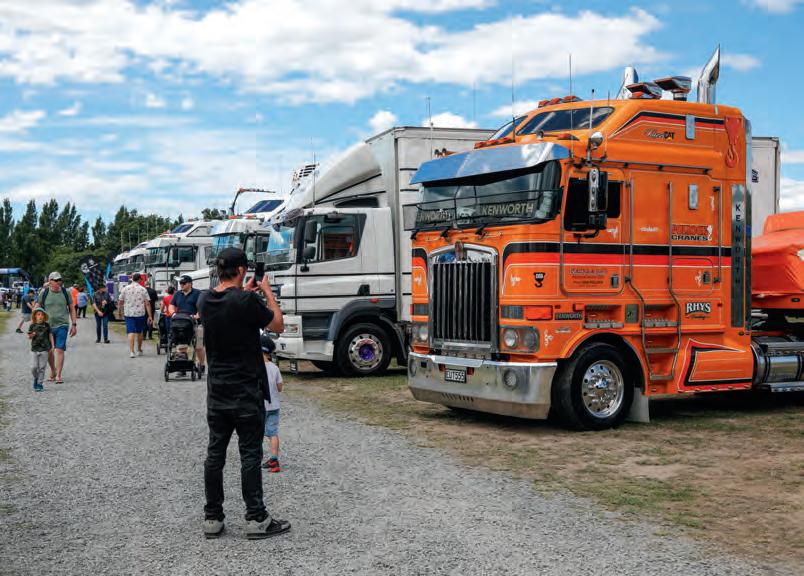
grandstand will be erected so friends and colleagues can cheer on their teams. Drivers can enter after forming a team of three and compete for incredible prizes on the day. Stay tuned for more details.
Enthusiasts of classic trucks will be delighted by the expanded Classic Truck area, showcasing beautifully restored vehicles that pay homage to the industry’s heritage and craftsmanship.
The TMC Trailers Trucking Industry Show has long been referred to as the industry’s premier event, and its return in 2025 is eagerly anticipated. From cutting-edge technologies to the latest fleet innovations, attendees can expect a comprehensive showcase of everything the industry offers.
Plan your trip to Christchurch and mark
your calendars for 8 March 2025, when the Canterbury Agriculture Park will transform into a hub of excitement and innovation for the TMC Trailers Trucking Industry Show.
For more information about exhibiting or sponsoring the event, please contact us at info@trucking.nz.
The New Zealand Trucking Association has organised the event since 2014. We welcome our naming sponsor, TMC Trailers. TMC Trailers is a leading provider of high-quality trailers and transport solutions in New Zealand. With a commitment to innovation, reliability and customer satisfaction, TMC Trailers has established itself as a trusted name and has been a proud supporter of the TMC Trailers Trucking Industry Show since 2014.
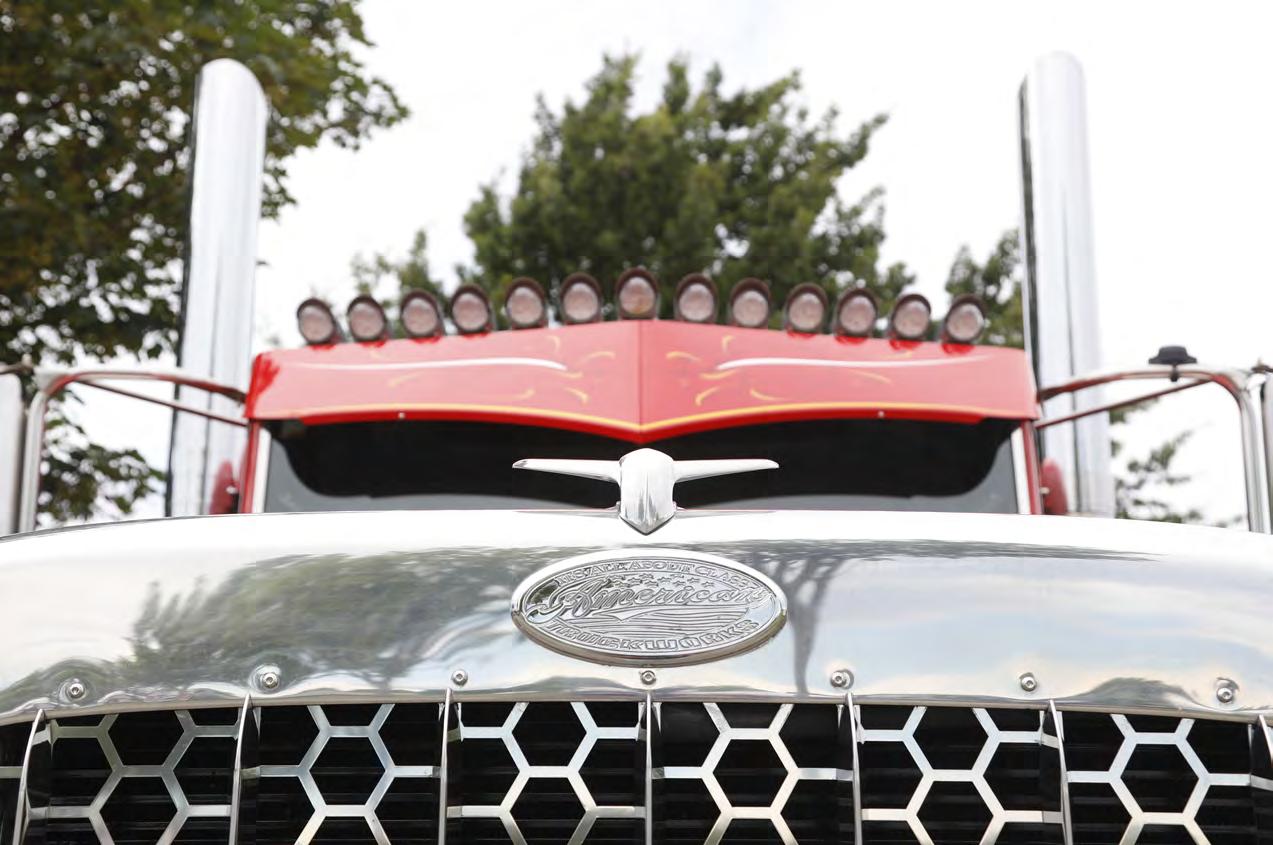

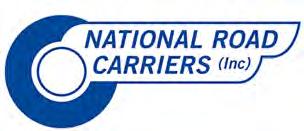
National Road Carriers Association can be contacted on 0800 686 777 or enquiries@natroad.co.nz
Justin Tighe-Umbers CEO
Justin Tighe-Umbers, chief executive at NRC, outlines the association’s strategy to tackle the changes facing the industry.
I’m not sure Bob Dylan was envisioning AI, smart phones and electric vehicles when he sang The Times They Are A-Changin’. But changing they are, and at the fastest rate in history.
Industry associations must not only keep up with this pace of change but also be ahead of the curve so they can help their members prepare for what’s coming. So, what is our strategy for keeping National Road Carriers and our members match-fit for tomorrow?
I’m a big believer in looking in the mirror first before trying to change anyone else. We’ve taken the same approach at NRC. We are looking at how we can improve ourselves to help our members. Getting NRC match-fit before we run onto the field is key and we are making great progress.
Underpinning the NRC strategy is our business transformation. We can’t prepare the industry for change without the right people, processes and plans. So we have been lifting every rock in the business, ensuring the way we work and our tools and support systems all support our team to do their best.
We are upgrading our relationship management system (a bit like a CRM). The shine has gone off, and it is just not keeping
up with what we need to do to deliver value. Later this year, members will notice a fresher website and comms, and our team of commercial transport specialists will have a much richer dataset of your information. This means we can zero in on ensuring you are getting all the benefits available to you.
We are also investing in our member service experience and team training. You can expect to hear from one of our friendly team, calling to make sure you are getting the most from our great services. Think of it as a bit of a COF on your NRC membership –without the queue.
Working on ourselves is all very well, but what are we doing for members?
We are busy growing our stakeholder relationships with government and industry partners, which makes our advocacy more effective.
Our strategy has a simple objective: driving for industry settings that enhance road-freight-sector productivity, efficiency and safety. In such a high-change environment, this means being disciplined and clear about the work we are doing with the government. For NRC, it means that every contact relates back to one of the following three main issues:
1. Workforce – settings that enable rapid growth of the labour force and keep workers and the public safe, from school leavers to overseas workers, from driver licensing to transport operator licensing.
2. Just Transition – enabling an affordable pathway for emissions reductions in the transport sector that maximises existing
assets and recognises carbon reductions through diesel efficiency as well as renewable diesel, electricity, hydrogen and hybrid technologies.
3. Infrastructure – maintaining the roads we have while building the roads we need for productivity and resilience.
Within that, we are also working with the government to co-deliver initiatives aimed at improving safety and developing underlying data that delivers insights on the freight task at the national level.
Over the year, we will report on our progress and discuss in more detail the work and initiatives we are undertaking to deliver improvements for the sector.
Our service strategy is two pronged:
1) Working with our commercial partners so members receive the best possible value for fuel, insurance, phones, tyres and other purchases.
2) Enhancing our suppor t services such as cost models and customisable cost indexes, and access to advice so they continually evolve to meet member needs.
The fruit of our strategy is already paying off. We are seeing our member base grow as the word spreads about the value we deliver. Pleasingly, much of this is from word of mouth.
We’re focused on getting it done for our members … with less hui and more do-ey.
‘A little less conversation, a little more action’ springs to mind – perhaps Elvis is more appropriate than Bob Dylan!



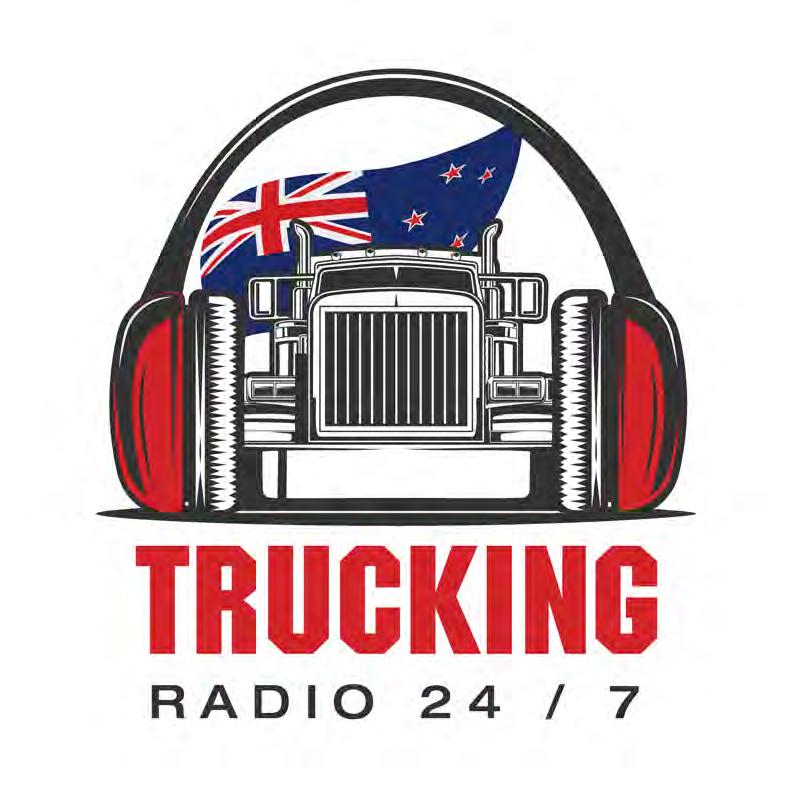
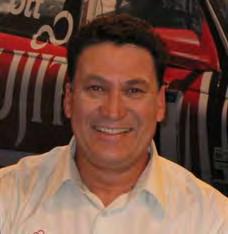
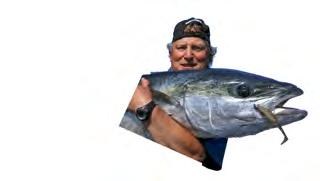

NZ’s first transport-dedicated radio with music, roading information transport news, interviews and more.
Everything you need to keep you going on the road. Trucking industry news and interviews | Roading Reports with Kiwi Truck Tyres | UDC Business of Trucking with Cameron Bagrie | Sport with Clint Brown | The Brolube and AC Filter Fishing Report with Mark Kitteridge | Clean Co Truck Wash Weather Report | News on the hour | And the best classic rock and country music!





With you on the road 24/7

Transporting New Zealand can be contacted on (04) 472 3877 or info@transporting.nz
Dom Kalasih interim chief executive
New Zealand’s current economic downturn was predicted, but that doesn’t make things any easier for those living through it.
At Transporting New Zealand’s conference in Lower Hutt last year, independent economist Cameron Bagrie told the industry it was in for a tough time, with inflation, a recession and vast uncertainty.
Bagrie, who founded ANZ’s Truckometer Index, which measures the economy based on the amount of road freight being carried, said, “Doing business is going to get fun again.”
His version of fun was measuring yourself against your competition and seeing who would do well when times got harder. No, it’s not my version of fun either – it’s rather like the Chinese curse, “May you live in interesting times.” Most businesses would choose dull and predictable over interesting and volatile.
Almost exactly one year later, Bagrie has been proved right. Just how hard is the economic impact hitting businesses? To give an indication, we heard that there were some vacancies at a port. Usually, there would be about 10 to 15 applications for a job. The latest advertisements were getting 150 to 200 responses.
In another blow, a major transport company recently went into liquidation with absolutely no warning.
One of our Wellington members says she and the businesses she associates with are now in “survive to 25” mode.
At a recent business breakfast, a finance company manager said several big customers had asked to go interest-only on some loans.
The downturn is not just limited to the transport sector. Hospitality and retail are suffering, and even breweries are closing down.
It will be interesting to see what moves the government announces in this year’s Budget, which would have been announced by the time you read this. At a business breakfast recently, Finance Minister Nicola Willis promised the Budget would chart “a sensible middle course” and deliver “a stronger, more productive economy”.
Times are hard, operators are under extreme pressure, and anything that can be done to reduce the pressure and risks they face would be appreciated. Road transport industry representatives recently met with Waka Kotahi NZTA and the Ministry of Transport for a policy workshop. We hope this is the start of delivering some of those productivity benefits.
The need for productivity gains is one reason we are calling for Roads of National Significance (RoNS) to be put at the centre of the Fast-Track Approvals Bill.
The legislation is controversial; however, it’s critical that we build essential new infrastructure. The atrocious condition of parts of our roading network results from decades of underinvestment.
RoNS needs to be immediately referred to the fast-track’s expert panel for assessment.
Last month, Transporting New Zealand joined with Infrastructure New Zealand in backing the call for critical infrastructure investment in Northland. The same holds
true for other regions. All these roading improvements are needed as a bare minimum.
Without fast-tracking, the RoNS programme risks being mired in lengthy consenting delays and impractical consent conditions, demonstrated by the East West Link and Mt Messenger Bypass projects. The RoNS programme will strengthen regional connections, improve road safety outcomes and ensure our roading network is resilient in the face of increasingly severe weather.
Let’s get things underway.
Meanwhile, the one industry that’s not letting up is the enforcement sector. Here are two recent examples of companies being pinged for things that weren’t really their fault.
One was a carrier who had a $280 job transporting some deer. Some of them were missing ear tags so the company has been fined $1200.
Technically, that is legal, but is it right? As far as we know, the farmer didn’t cop the fine, but they were the missing link in the supply chain.
In the other case we’re looking into, drivers are being warned they may be disqualified from driving in a transport service and have their heavy vehicle driver licences revoked for up to 10 years if they commit further traffic offences in any type of vehicle, including personal vehicles.
So, in effect, our members’ businesses could be impacted by something their employees are doing in their own time and in their own vehicles. On the face of it, its seems unfair and unreasonable to Transporting New Zealand, so watch this space.
So we must get smarter and more productive and ensure our members are treated fairly and justly.
We’re here to help in any way we can.

NZ Trucking is New Zealand’s leading magazine for both the industry and the enthusiast, featuring the latest heavy truck and light commercial road tests, product news, and trucking personalities.
You will also get access to NZ Trucking Magazine on ISSUU. You will be emailed a login when the next issue is available.
Pricing for subscriptions include postage and GST. Postage included.
ph 0800 878 256 or visit NZtrucking.co.nz/subscriptions
Phone: 0800 878 256 or visit: NZTrucking.co.nz/Shop


OUR TOP TRUCK – Modern drover – Big blue Merc is a star

There has been a lot of media interest in the public service job cuts. While I sympathise with those affected, we should not forget it has happened before – think back to the Roger Douglas and Richard Prebble slash-and-burn of the 1980s. One of the issues I have experienced over the years in the public service is that it is relatively easy to build a business case for more staff, and once these staff are in place, little, if any, review takes place to ensure that the roles are delivering what they were intended to.
Getting extra staff positions is even easier with a sympathetic government. Often the same thing happens with what, on paper, looks like a good initiative. Money is allocated and staff employed. But while the projects may look good, in the real world they fail to deliver on what was intended, and they become little more than a soak-pit for taxpayer money. Eventually this becomes obvious, and the initiative is abandoned. Inevitably, people lose their jobs.
The cannier public servants involved recognise the failure early on, and by the time it becomes obvious, they have moved onto other things. This writer has had personal experience of this.
When you look at some of the numbers published about the potential for jobs that could be lost, some are vacancies that will not now be filled. There also appears to be lot of people putting their hands up for voluntary redundancy, which suggests that there are quite a few dissatisfied people within the public service, and they are more than happy to get a pay-out to leave.

The obvious thing would be to look at what these people are doing and ask how much they have contributed to the efficiencey of the department or agency, and how much they have contributed to the economy
Let us hope that those wielding the razor at the moment apply the same process to their ‘management’ staff. Often, it is this area that develops the cases for more staff as they, too, can benefit from increasing their salary band.
Over the past six years, the number of public servants is reported to have increased by approximately 34%. Surely, then, the obvious thing would be to look at what these people are doing and ask how much they have contributed to the efficiency of the department or agency and how much they have contributed to the economy of New Zealand. If either of these cannot be readily quantified, why are these positions still there?
The honeymoon period for the coalition government is over. The taxpayers are starting to have enough of been told about what is proposed, we are all looking to see some meaningful action, such as lower grocery prices and shovels in the ground. This is what the government will be judged on, not just on promises.
The Accidental Trucker
On 1 March, it was interesting to read that KiwiRail reported a $407 million loss for the six months ended 31 December 2023, compared with a $65 million loss the year earlier. The 2024 loss is partially blamed on rail freight volumes down 15%, mainly due to reduced container movements.
It is not clear yet if this reduction has also impacted our industry or if it signals a modal shift – operators involved in container movement will no doubt have the answer to this. With all the signs pointing towards a shrinking New Zealand economy, it could be a combination of both as customers seek to lever the optimum all-round service for transporting their freight.
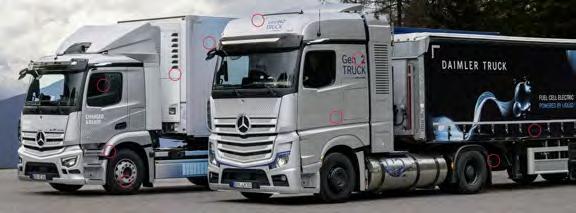







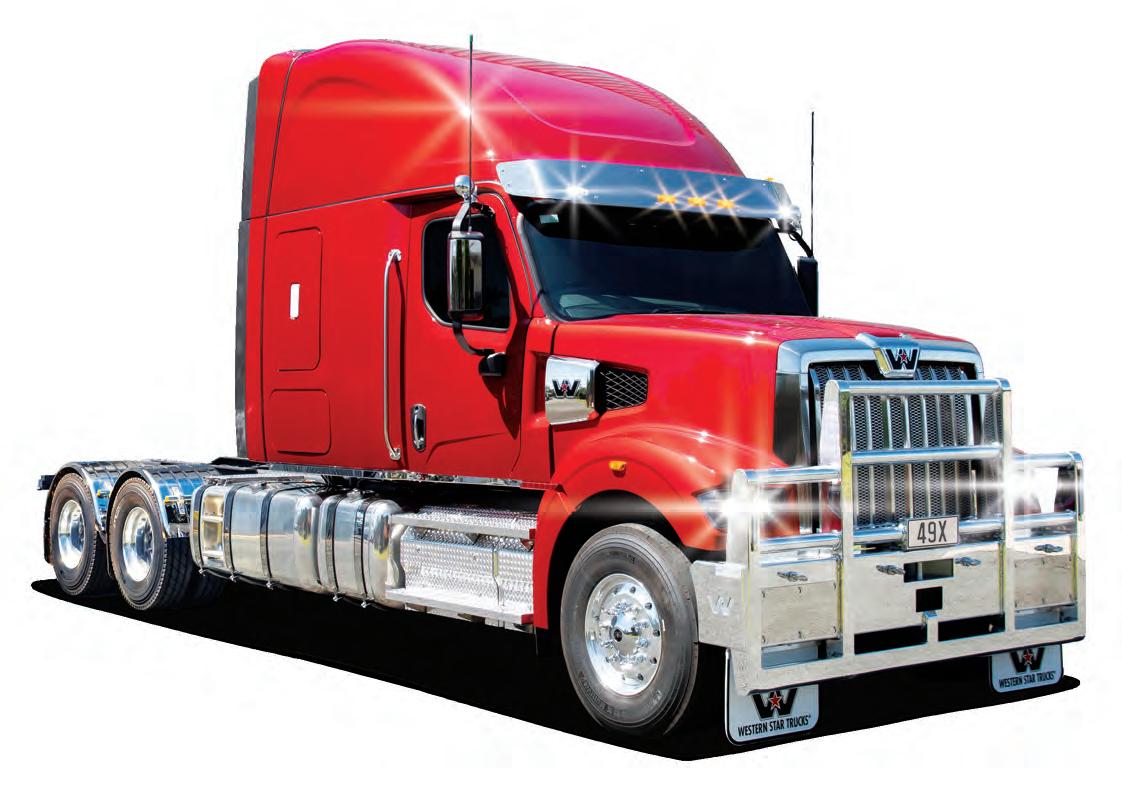
scania.co.nz

